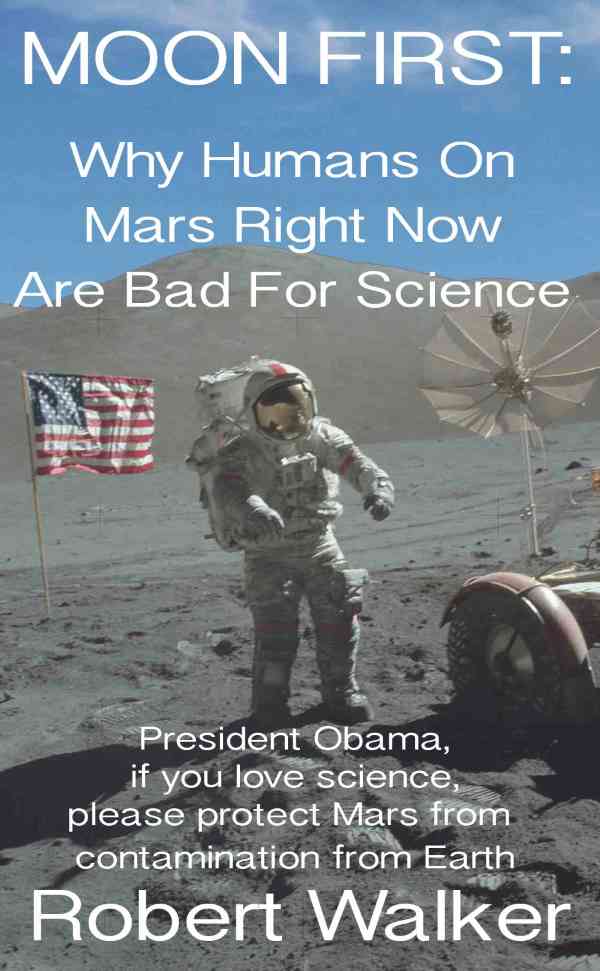
MOON FIRST
Why Humans on Mars Right Now
Are Bad for ScienceIncludes: Astronaut gardener on the Moon
Copyright © Robert Walker
(UK). All rights reserved.

(See high resolution version of this cover picture)
The cover picture shows Astronaut Eugene Cernan walking towards the Lunar Roving Vehicle during an EVA for Apollo 17, the last mission to land on the Moon - with the black sky replaced by a blue one, and no other changes at all. For the motivation for doing this, see the section below: What if the Moon had blue skies.
Thanks to Nathan Ryweck of Gelato Media for converting my book cover draft into a professional design.
First published: October 2016. You can also get this on kindle. For my other kindle booklets, see my author page on Amazon.com. You might be especially interested in my related books:
You don't need a kindle device to read these books. Amazon has developed kindle reading apps, These run as a separate application, and lets you use any computer (iOS, Android, Mac or PC) in the same way as the kindle device, with the book set out in the same way, turning pages in the same way etc. You can get them here: Free Kindle App.
You can also buy the book on kindle as a way of showing your support and appreciation. Every sale boosts its ranking in the kindle bookstore temporarily. For instance, two or three sales are enough to put it on the first or second page of kindle best sellers for Mars, for a few days.
You can also support my work as a science blogger and writer of these books via Patreon.
The main sections in this book are
I wrote this book after the then President of the US, Obama, in an op-ed, said that he wants to send humans to Mars, because he loves science. Great!. But hardly anyone stops to ask the question: "What would humans landing on Mars do to the science they so love?" The question is especially acute in the case of a crash landing, which is a likely scenario in a landing on Mars, the toughest place to land on in the inner solar system. "What happens to our trillions of microbes if a human occupied ship crashes on Mars?"
Could we find life on Mars, present day life, based on different principles from Earth life? That would surely lead to some of the most significant discoveries in biology of the twenty first century. What would a human crash do to the scientific potential of the planet?
There are three top priority places in our solar system to protect from Earth microbes: Mars, Europa and Enceladus. Why rush humans with our trillions of microbes, as quickly as possible to the one place inside of Jupiter's orbit most vulnerable to Earth life?
And - is this the right time to attempt a colonization anyway? When Shackleton succeeded in overwintering in Antarctica after his ship sunk, he didn't say "Oh great, we have managed to survive here huddled under boats, hunting seals, so we must colonize Antarctica".
In the New World, there were plants to eat, crops could grow, and temperatures were equitable. It had human inhabitants already and you could breathe the air and drink the water. It's hard to beat that. We have never colonized anywhere like the Moon or Mars, far more inhospitable than Antarctica. Even the summit of a mountain four times taller than Mount Everest would be far more habitable than either of them.
Are there other ways forward? Ways that let us explore Mars thoroughly and search for life there, experiment with space settlement and colonization, and protect the science value of Mars? What about exploring Mars from orbit, operating robots on the surface? That's the preferred way forward of scientists who care about planetary protection of Mars. How effective is it? Perhaps it is a more direct and immersive way of exploring Mars than with astronauts on the surface. Do we need astronauts to drill? What about robotic moles? What if we make these orbital missions and missions to its two moons and telerobotic exploration of Mars our long term goal for humans to Mars? What if we leave any decisions about whether to land humans on the surface to a later date?
Also - we have the Moon, right on our doorstep. With the new discoveries of the peaks of almost eternal light at its poles, the radar data suggesting vast caverns over 100 km long, and ice detected at the lunar poles - how does the Moon now compare with Mars? This is the usual focus for Moon first books such as The Value of the Moon, Moonrush, and The Moon: Resources, Future Development and Settlement, and I go into this in some detail as well.
You might be surprised at how well the Moon stands up against Mars in the comparisons. The two week long lunar night is far less of a drawback than you might think due to interesting discoveries about plants kept in darkness for two weeks at a time and modern efficient LED lights, while the peaks of almost eternal light may give a way to build early bases with abundant solar power available nearly all the time.
If you love science, as President Obama does, then do read this book and find out more about the case for exploring the Moon first and protecting Mars from Earth life for now, and make up your own mind.
This kindle booklet brings together material from my recent articles on Science20:
along with material from my longer kindle book Case for Moon First.
Originally published on my Science20 blog here: President Obama, Why Humans On Mars Right Now Are Bad For Science
President Obama has just taken the unusual step of publishing an Op-Ed article for CNN "America will take the giant leap to Mars". It promotes his vision for humans on the Mars surface in the 2030s. The video at the head of the article highlights his love of science. But what would humans landing or crashing on Mars do to the science he so loves? Unlike a robotic lander, a human occupied spacecraft can't be sterilized of its trillions of Earth microbes, and a crash of a human crewed spacecraft on the surface would end planetary protection for Mars. It's easy to find life if you bring it yourself, but what an anticlimax that would be to all our years of exploring the planet! Here is another video with clips to show his love of science.

(click to watch on YouTube)

President Obama presenting John Glenn with the medal of freedom. He was the first American astronaut to orbit in space.
I never thought of planetary protection for human missions to Mars myself, until a few years back. So, I can understand from my own experience how it is possible to simultaneously agree that we need it for robots, to be keen on science, and yet at the same time, to forget about it as soon as humans are mentioned. Robots can be sterilized. Humans have trillions of microbes on our skin, in our gut etc, and sadly, we can't be sterilized of them. Nor can we replace them all with microbes unable to survive on Mars. Any attempt to remove all our microbes would kill us.
We may be on the point of making the next major discovery in biology. What we discover there could be so major that historians of the future mark out three significant points in biology
Of course we have no idea what those discoveries will be. We have found many possible habitats for life on Mars, but we have not yet been able to send any spacecraft up close to look at them. Indeed Curiosity may be not far from some of those. If they are indeed possible habitats, it's not sufficiently well sterilized to look at them close up, and at best, it may be able to observe them from a distance of several kilometers.

Curiosity at a drill site called Okoruso on the lower slopes of Mount Sharp
(Note, like most images from Mars, it is colour adjusted - to human eyes the sky is more of a butterscotch than pink in colour, this image uses the raw images. Stitched together from the MAHLI images here)
It is just a few kilometers away from some dark streaks that might possibly be marks created by salty brines that flow just below the surface. See the red spots on this image in a Nature article of possible Recurring Slope Lineae (RSLs) near to Curiosity's projected path up Mount Sharp. Are they indeed RSLs, and are they habitable to Earth microbes if they are?
Frustratingly, the only photographs we have of confirmed RSLs are from an orbiter that approaches Mars closely during the local afternoon. That's the worst time of day to try to detect these seeps of salty brine which probably flow in the early morning. Still, through ingenious detective work, scientists got the answer at last, or are pretty sure anyway, see Why Are Hydrated Salts A Slam Dunk Case For Flowing Water On Mars? And What Next? The big questions about them now are: "Are these seeps are inhabitable?", and if so, "Is there any life there?".
We don't know if the streaks on Mount Sharp are RSLs. If they are, and if they are habitable, Curiosity is not sufficiently sterilized to approach one of these sites to find out more. Hopefully it will be able to take photographs from a distance of several kilometers, which may help. See NASA weights use of rover to age potential Mars water sites. Also hear Dr. Ashwin Vasavada talking about them on David Livingston's the SpaceShow.
Discoveries of this sort are what I've called a "super positive outcome". There is no risk to humans from introducing Earth life to Mars, so it's not covered by the precautionary principle. But there is a risk of losing something wonderful and precious.
The exobiologists, who hope to fly in situ life detection instruments to Mars some day, design them to be as flexible as possible, to detect not just familiar forms of life. As an example, Chris McKay with his "lego principle" suggests a general way of looking for life not depending on any assumptions that it resembles Earth life. See his What Is Life—and How Do We Search for It in Other Worlds?
What we discover there could include any of:
It might seem hard to get excited about microbes - but think of them as microbe ETs, and perhaps you may see them in a different light. As minute emissaries from another biological cosmos, tiny beings with a potentially totally different biochemistry.

This next video shows how DNA makes protein. Notice how complex the process is.

It happens in exactly the same way in every cell of every single Earth creature. Imagine what it would be like to find a cell that does it differently?
I've heard it said that the interior of a cell is so complex, with its million different chemicals, and elaborate structures and processes, that to researchers studying how cells work, it seems as complex as an entire ecosystem. So, what about using actual ecosystems as an analogy here?
Imagine that you have been brought up in the African savannah - with its grasses and trees, elephants and antelopes. You've never seen a marsh or a forest, or a beach. All your life you've lived in a hut in the African Savannah, never traveled more than a few miles from your hut, and that's the only thing you've ever known.
Then one day someone takes you to the sea shore, with its fish, shellfish, seaweeds, and sea anemones, and perhaps they take you on a dive to see a coral reef.
A Blue Starfish (Linckia laevigata) resting on hard Acropora coral. Lighthouse, Ribbon Reefs, Great Barrier Reef. Photo by Richard Ling
The interior of a cell of XNA based life could be as different from the interior of a cell of DNA based life as the African Savannah is different from a coral reef. And imagine the new perspectives we might get if we can study it.
The search for life is the main motive for all the missions to Mars to date. Look at how excitedly NASA reports yet another discovery of possible past or present water on Mars. And what a huge anticlimax it would be to get there, find life, it's headline news in all the papers, and then follows the anticlimactic announcement that it was just life that was brought there by the human explorers themselves! Then would follow speculation and questions about whether there was any native Mars life there before the Earth microbes got there, maybe never answered definitively. Or we find evidence that there was some native life that went extinct in the very decade that humans landed there, an ecosystem of many Mars microbes interacting, now gone. Or we find some present day indigenous life, but it is already getting overwhelmed by microbes from Earth, and there follows a rush to try to find it in the many different potential habitats on Mars before it goes extinct.
I think the example of an early form of life is the easiest to use here to show how vulnerable native Mars life could be, potentially. It could be some form of life that was been made extinct on Earth billions of years ago, RNA world life say. It might not last for long after more modern life from Earth gets to Mars.
For more about this see my article Will We Meet ET Microbes On Mars? Why We Should Care Deeply About Them - Like Tigers
So now, what happens if Elon Musk sends 100 colonists to Mars and then the spacecraft crashes? Out of thirteen attempted landings on Mars (now including Schiaperelli) only seven have succeeded, two soft landed but with no significant data returned, and four have crashed.
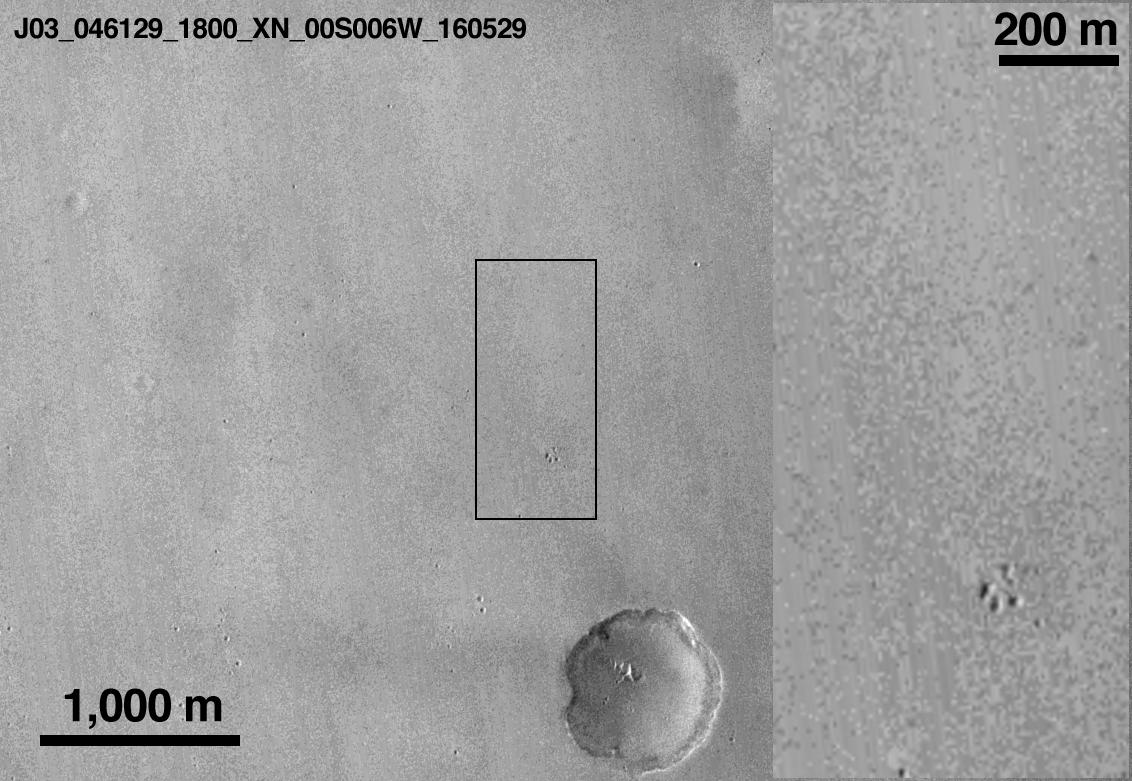
Schiaperelli crash site on Mars. The lower white dot is thought to be the parachute and the upper dark dot, the crash site for the lander itself. Mars is the toughest place to land in the inner solar system.
Out of thirteen landers that have attempted to land on the surface of Mars itself, only seven have been successful, with one partial success Mars 3. There have been four crashesSuccesses: Viking 1 and 2, Pathfinder, Phoenix, Spirit, Opportunity, Curiosity.
Crashes: Mars 2, Mars Polar Lander, Deep Space 2 (same mission as MPL but separate landing) and Schiaperelli
Soft landing but no data or hardly any data , Beagle 2 and Mars 3Since the focus here is on the risk of a crash on the surface, I ignore missions that never got to Mars.
Even NASA has had crashes on Mars with its Mars Polar Lander and Deep Space 2 in 1999, which entered the Mars atmosphere independently and both crashed for different reasons. Since then, they have had a string of successes, with Phoenix, Spirit, Opportunity and Curiosity.
However, impressive though that is, you can get a string of four successes easily even if the chance was only 50/50 of success each time. The chance of four successes in a row is then 1 in 16, or a 6.25% chance. This could mean that NASA is better at landing on Mars than ESA. But the statistical significance is not quite 2 sigma, not nearly good enough for scientific validation that they are statistically better than ESA and Russia. ESA did everything right, including a radar to measure the distance to the ground. The ESA has many deep space successes: Mars Express, Rosetta, the Philae Lander was a partial success and was attempting something never done before, Ulysses, the Huygens Titan probe, Venus Express.
With Curiosity's seven minutes of terror, the mission controllers really didn't know if it would land safely or not. Even Curiosity 2020 is not guaranteed to land successfully. We might have other reasons to suppose it has a good chance of success, but just based on the statistics, the chance of a successful landing could easily be 50/50 or lower. So similarly, if you got four successful missions using the same system as is needed for humans to Mars in a row, which would count as an excellent record for unmanned missions, it would not give much assurance that your chance of success for the next landing is better than 50 / 50. You'd need other reasons for your confidence if you thought a crash was unlikely.
Following a precedent set by Carl Sagan, planetary protection discussions are often based on the idea that the risk of contamination should be less than 1 in 10,000 per mission (ideally of course the risk should be zero but we don't have that capability at present).
Elon Musk himself warns that there is a high risk of death for the first colonists to go to Mars. With his supersonic retropropulsion proposal, his rockets have to streak across the landscape, so close to the surface that they can't land on mountainous areas on Mars. (Robert Manning talks about supersonic retropropulsion and challenges associated with landing large payloads on Mars here). For more about why it is so hard to land there safely, see my Why do Spacecraft crash on Mars?
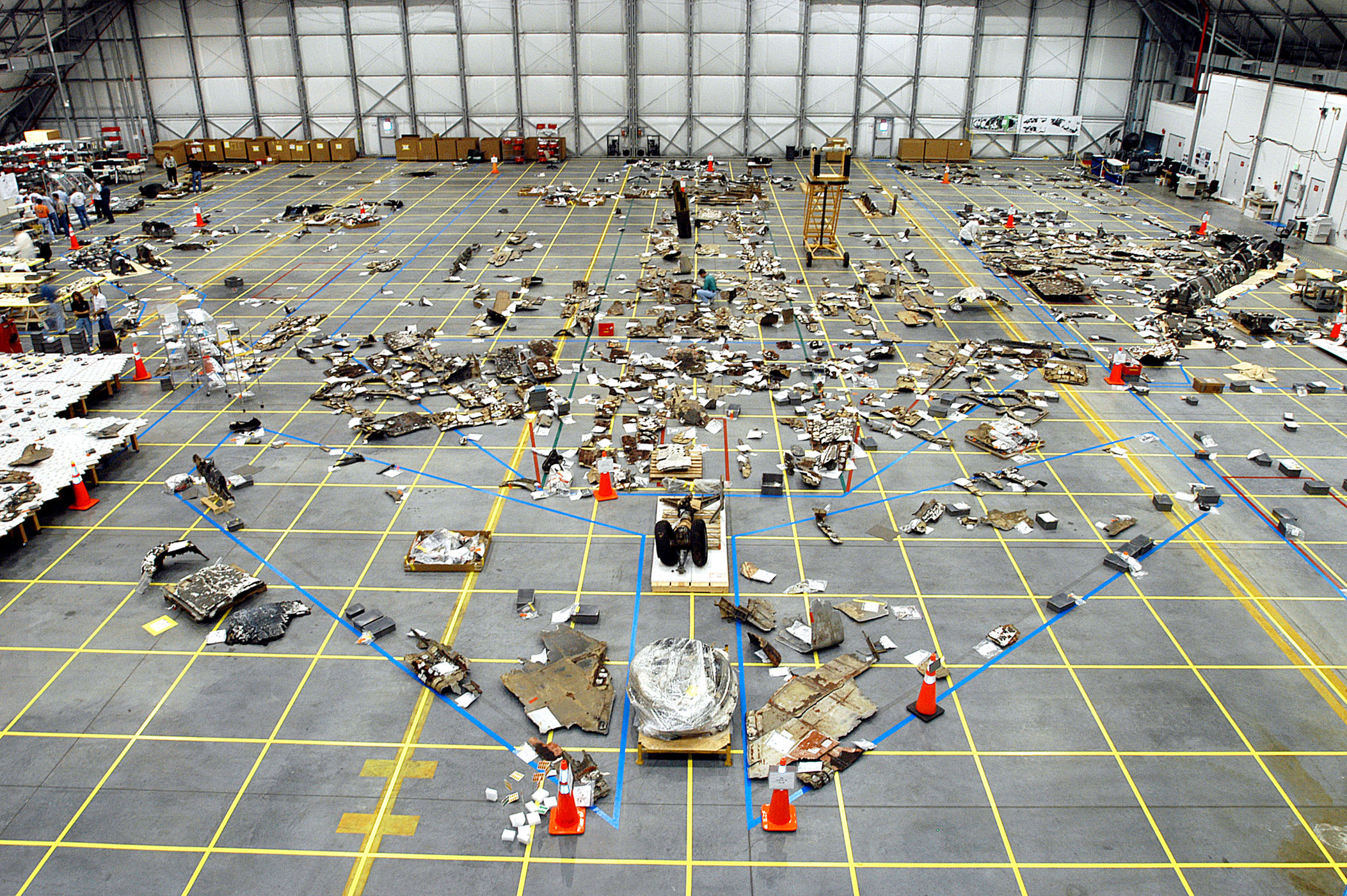
Debris from Columbia - broken into tiny pieces by the crash.
What if this happens on Mars, with the debris spread over the surface? What happens when the global dust storms strike, and particles of dust, small debris and organic materials from the crash get carried throughout Mars?
Microbes would certainly survive such a crash. Indeed hundreds of worms, much more fragile than hardy microbes, survived the Columbia crash.
One of the Caenorhabditis elegans worms, size of a pin head, which survived the Columbia disaster in an experiment held in six canisters, each containing eight petri dishes.
For more about this see my Why Do Spacecraft Like ESA's Schiaperelli Crash On Mars So Easily?
This surely would be the end of any chance of protecting Mars from Earth life. It is something we can never reverse, once there are hardy spores of Earth life in their countless billions scattered in the dust storms on Mars.
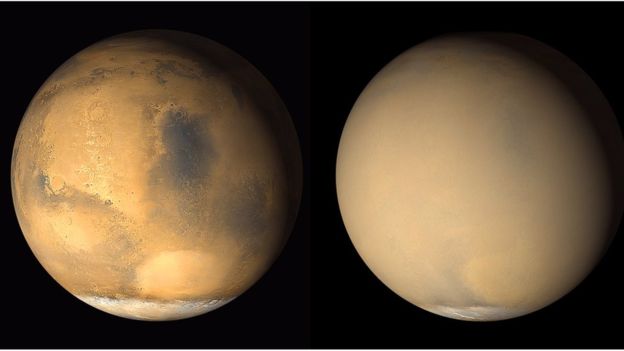
Dust storm on Mars shown in right hand image. After a crash of a human occupied spaceship on Mars, numerous hardy microbe spores would be scattered in the dust storm season, every two Earth years. The effects would be irreversible, and we would have to say that it is no longer possible to protect Mars from Earth microbes.
After that, any experiment that finds present day life on Mars would have to start with the assumption that it might be Earth life introduced as a result of the crash.
NASA's planetary protection office agrees, but say that their job is to work out if the planet can be protected in the case of a successful human landing. So, they don't consider crashes of human occupied ships in their assessments. That is for NASA to look at, at a later stage. Also, they no longer aim for reversible biological exploration of Mars in the case of a human landing.
In their list of knowledge gaps for human extraterrestrial missions, they cover such things as leaks of microbes from spacesuits in EVA, transport of microbes in the dust storms. But there is no mention at all of the effects of a crash of a human occupied spaceship anywhere in the list. They have to assume a 100% success rate for humans landing on Mars as without that assumption they would not be able to recommend any measures that could protect Mars from Earth life, even temporarily.
Their approach is that we will have a small precious window to find out as much as we can about Mars before humans introduce Earth life there by landing on the surface. Emily Lakdawalla, planetary geologist who often reports for the Planetary Society, expresses a similar sentiment in this article
"NASA recognizes that the potential for contamination is a problem, so there is a Planetary Protection Office that is specifically charged with overseeing how missions avoid contaminating Mars with Earth biota. There are two main approaches. One approach is to sterilize the heck out of anything that will actually be touching Mars. That's why Curiosity's wheels were specially wrapped throughout its final assembly, and why it was such a scandal that the drill bits were handled after sterilization. The other approach is to avoid landing in any location where you might encounter -- or accidentally create, should you crash -- a present-day habitable environment where Earth microbes could thrive. For instance, current rules prohibit NASA from targeting a mission containing a hot radioisotope thermoelectric generator (such as Mars 2020) anywhere near a place where a failed landing might place that generator close enough to subsurface ice that the heat of the decaying plutonium could melt it.
"But all bets are off once you send humans to Mars. There is absolutely no way to make a human clean of microbes. We are filthy with microbes, thousands and thousands of different species. We continuously shed them through every pore, every orifice, with every exhalation, and from every surface. True, almost all of our microscopic friends would fail to thrive in the radiation-baked, intensely cold and arid Martian environment. But life is incredibly tenacious. Sooner or later, humans will get to Mars; even if they die in the attempt, some of their microbial passengers will survive even the worst crash. Once we've put humans on the surface, alive or dead, it becomes much, much harder to identify native Martian life.
"This is one of many reasons I'm glad that The Planetary Society is advocating an orbit-first approach to human exploration. If we keep our filthy meatbag bodies in space and tele-operate sterile robots on the surface, we'll avoid irreversible contamination of Mars -- and obfuscation of the answer to the question of whether we're alone in the solar system -- for a little while longer. Maybe just long enough for robots to taste Martian water or discover Martian life."
Cassie Conley has also said she thinks Elon Musks' ideas have planetary protection issues, in an interview just before his big announcement here: Cassie Conley. Going to Mars Could Mess Up the Hunt for Alien Life
There are no detailed guidelines yet for humans to Mars. These would be made by the international COSPAR committee which meets every two years, and all of their discussions to date have ended without any firm recommendations, saying that more information is needed.
I think however that the idea to exploit a brief window of opportunity of a few years before the first human landings or colonization attempts is just not good enough. We simply shouldn't risk destroying such a precious opportunity to make scientific discoveries, on the basis of ignorance.
Here is a quote from When Biospheres Collide
"One of the most reliable ways to reduce the risk of forward contamination during visits to extraterrestrial bodies is to make those visits only with robotic spacecraft. Sending a person to Mars would be, for some observers, more exciting. .... But in the view of much of the space science community, robotic missions are the way to accomplish the maximum amount of scientific inquiry since valuable fuel and shipboard power do not have to be expended ... to keep a human crew alive and healthy. And very important to planetary protection goals, robotic craft can be thoroughly sterilized, while humans cannot. Such a difference can be critical in protecting sensitive targets, such as the special regions of Mars, from forward contamination.
"Perhaps a change in the public's perspective as to just what today's robotic missions really are would be helpful in deciding what types of missions are important to implement. .... The spacecraft instruments, in other words, are becoming more like collective sense organs for humankind. Thus, according to Johnson, when NASA conducts it's so-called robotic missions, people all around the world are really "all standing on the bridge of Starship Enterprise". The question must thus be asked, when, if ever, is it necessary for the good of humankind to send people rather than increasingly sophisticated robots to explore other worlds"
For all we know at present, we might have to travel light years to other star systems to find another planet like Mars to study in its original state without Earth microbes, if we can find one at all. Look at all the mistakes we have made in the past - extinct dodos and passenger pigeons, introducing rabbits to Australia in order to make settlers "feel at home", also introducing feral cats, rats, and making many species extinct, through ignorance of the consequences of our actions. Right now species in the Amazon rainforest are becoming extinct before we know what we have lost.

Martha, last of the passenger pigeons, which once formed huge flocks, and with a population of three to five billion, may have been the most numerous birds on the Earth before they became extinct. Their accidental extinction was one of mankind's many mistakes, and drew attention to the possibility of making even a numerous species extinct.
We haven't got any experience of introducing life to other planets, and so don't have object lessons like this to warn us of what might happen. Science fiction movies like Star Trek may give the impression that we can land humans on any planet in the galaxy, and the microbes they bring with them will have no consequences on the local ecology. However, these are the product of script writers' imaginations, by writers who themselves have no experience of what would actually happen in that situation, and are not predictions of what would happen in practice.
We have made many mistakes already on Earth. Introducing Earth microbes to Mars could easily turn out to be one of our worst ones ever.
I think we need a positive version of the precautionary principle, something like this (I'm no lawyer, I've just taken the phrasing of the Wingspread conference on the precautionary principle, 1998 and changed harmful to "superpositive" and made other similar changes):
"We believe that human activities have potential to lead to discoveries of such positive value, "superpositive outcomes" that new principles for conducting human activities are necessary to ensure that this potential is not destroyed.
"While we realize that the future can't be predicted, people must proceed more carefully than has been the case in recent history. Corporations, government entities, organizations, communities, scientists and other individuals must adopt a precautionary approach to all human endeavors.
"Therefore, it is necessary to implement the Precautionary Principle for superpositive outcomes: When an activity may lead to a superpositive outcome, precautionary measures should be taken to keep this possibility open even if some cause and effect relationships are not fully established scientifically.
"In this context the proponent of an activity, rather than the public, should bear the burden of proof.
"The process of applying the Precautionary Principle must be open, informed and democratic and must include potentially affected parties. It must also involve an examination of the full range of alternatives, including no action."
This could also be applied to other superpositive outcomes such as potential for new medicines and knowledge from tropical jungles. We have no idea what knowledge has already been lost through deforestation and extinction of species that scientists have never had an opportunity to study.
However, I think it applies in an especially overwhelming way to this potential of discovery of novel lifeforms on other planets.
So in this case, for Mars, we do not know what the chance is of a superpositive outcome, such as discovery of a novel exobiology. It is possible that Mars is so unique that we would have to travel to a planet around another star to make the same or similar discoveries there. Indeed, there might also be nothing like it for tens or hundreds of light years in all directions (e.g. if the discovery is related to unique conditions that prevailed in the nebula that gave birth to our solar system).
There is no way to prove that this is the case, of course. But we shouldn't just proceed on a basis of not knowing what the risks are.
Advocates of colonization of Mars project a sense of urgency, that we have to send humans to Mars as quickly as possible to protect our species. Of course their impatience is understandable, as this is something that they have hoped for, for decades. But there is no urgency to send humans there. We are amongst the least endangered of all higher animals on Earth. We could survive events that made the dinosaurs extinct with our mammalian physiology, our omnivore capability to survive on a diverse range of foodstuffs, and the simplest of technology such as ability to make clothes, and boats, to use simple tools, and to cultivate plants, farm animals and fish. We can take our time, and it's not a race to see who gets there first. I'll go into this in detail in Wait, Let's Not Rush To Be Multiplanetary Or Interstellar
The opinion of experts on whether there are habitats for life on Mars and whether there is present day indigenous life there spans the entire range from 0% to 100%. Views on the possibility of present day life on or near the surface.
I argue that it shouldn't be up to astrobiologists to prove that introduced Earth microbes will impact on Mars based just on what we know so far at the time of a human landing attempt. That is obviously impossible to do when we haven't yet sent a rover to examine any of the possible habitats on the ground, and especially if the lions share of funding is used to establish humans on the Mars surface rather than to explore the planet in a biologically reversible way first.
Zubrin has argued that because of meteorite transfer, life on Mars is so similar to Earth life that introducing Earth microbes will have no effect on it. Alberto Fairén and Dirk Schulze-Makuch also suggested that we no longer need to protect Mars, using Zubrin's meteorite transfer argument essentially, in "The Over Protection of Mars". This was rebutted in a follow up article "Appropriate Protection of Mars", in Nature by the current and previous planetary protection officers Catherine Conley and John Rummel. The two papers are summarized in The Overprotection of Mars? published in NASA's online astrobiology magazine,
If Mars and Earth were as similar as this at a microbial level, it would be so remarkable that I think most astrobiologists would want to study the situation on Mars to find out how this happened, before confusing it by introducing more Earth life. The most recent time that Earth microbes could get to Mars is perhaps at the time of the impact that formed the Chicxulub crater, 66 million years ago, and a more likely time for it to happen is in the early solar system, over three billion years ago, soon after formation of the Moon. Also, most Earth lifeforms, including lichens, and many microbes able to survive on Mars, would not be able to make the journey. How likely is it that both planets have the same microbes, after millions, or even billions of years of separate evolution in such different conditions as Earth and Mars, and with only some of the species shared via meteorite impacts, if any? I cover this later in How a human spaceship could bring microbes to Mars - Zubrin's arguments examined
If we have a precautionary principle for super positive outcomes, it is then up to Zubrin and Dirk Schulze-Makuch et al to prove this hypothesis, and not up to the astrobiologists who think we should protect Mars to disprove it. To establish either view is clearly impossible when we haven't yet had an opportunity to do the most basic of preliminary biological surveys of Mars.
So it is a similar situation to the precautionary principle, but in a positive sense. And just as for the precautionary principle, we have to consider the full range of alternatives, including no action, which in this case means that we should consider not sending humans to the Mars surface.
Instead of sending humans as rapidly as possible to Mars, the place in the inner solar system most vulnerable to our microbes, let's send humans back to the Moon.The Moon is the safest place to explore, for its own sake, as a gateway to our solar system. We can have lifeboats there, fueled and with provisions for the crew for two days, ready to take everyone back to Earth in an emergency.

Coast Guard Lifeboat practicing in the big surf just outside and south of the Morro Bay harbor mouth, California. Photo © 2012 “Mike” Michael L. Baird
We can equip a habitat on the Moon with lifeboats for the entire crew, supplied with provisions for two days, to get back to Earth in an emergency.
For a typical Hohmann transfer orbit, the crew are on their own, even one hour after their spaceship sets off for Mars. It won't have enough delta v to reverse course and return to Earth at that point, and there is no other way to get the crew back quickly with present day technology either. They would have to come back via Mars.
This makes the Moon far far safer than Mars for a human crew in the near future.
For that reason, though I'd dearly love to see humans orbit Mars, I think the time isn't right for it yet. We need to do multi-year explorations closer to home before we know that we have the technology and that it's reliable. The ISS is not at this stage of readiness because it is designed for LEO rather than interplanetary missions and it needs to be replenished every few months. The ISS has also had issues with its life support system in the past, which were not serious mainly because it was easy to resupply it from Earth with emergency oxygen.
Getting the mass there is not the main problem; keeping the crew alive is. Nowadays we can keep humans alive in submarines for years on end, if necessary, only resurfacing to take on food, but they are nuclear reactor powered and work by pumping seawater on board and turning it to fresh water and oxygen.
We need a similar level of reliability to get to Mars, but it has to be tested in space, not on Earth, in several shakeout cruises. Unlike nuclear submarines, there won't be any option for the crew to surface in an emergency. They are committed to the vacuum of space surrounding them for two years or more (or 500 days for the shorter round trip via Venus after Mars).
This I think is just not something we can do safely at our present stage of technology. It is probably within reach in a decade or two, but we aren't there quite yet. We have to proceed more slowly. And the Moon is the obvious target here.
Imagine if the early Antarctic explorers had been content to just set foot on the continent and then said "Been there, done that, let's find somewhere else to explore". That's what it is like to go to the Moon in the 1960s through to the 1970s, and then never go back again.
The Moon is both far more resource rich, and far more interesting than anyone realized just a decade ago, with ice at the poles, possibly large quantities of precious metals like platinum from iron meteorite impacts, possibly vast caves below the surface, so large that you can fit the city of Philadelphia inside with plenty of room to spare, and many mysteries to solve. It must have meteorite fragments from the inner solar system, from Earth, Venus, Mars, but unaltered by any geological processes, just sitting there buried in the ice at the poles for billions of years. There is much there that is unknown and to discover, and impossible or hard to detect from orbit (for more about this see science surprises).
Yet, Mars looks so much more habitable than the Moon in the photographs which are digitally enhanced to increase the amount of blue, and to brighten them, to make it easier for geologists to identify the rocks. These press photos are often so transformed the skies are blue rather than the natural grayish brown. I think this is part of the reason why so many people are keen to go there, that it looks so Earth-like in the press photos.
This is a colour enhanced Mars image as you would see it in most press photos - enhanced for the purposes of geologists:
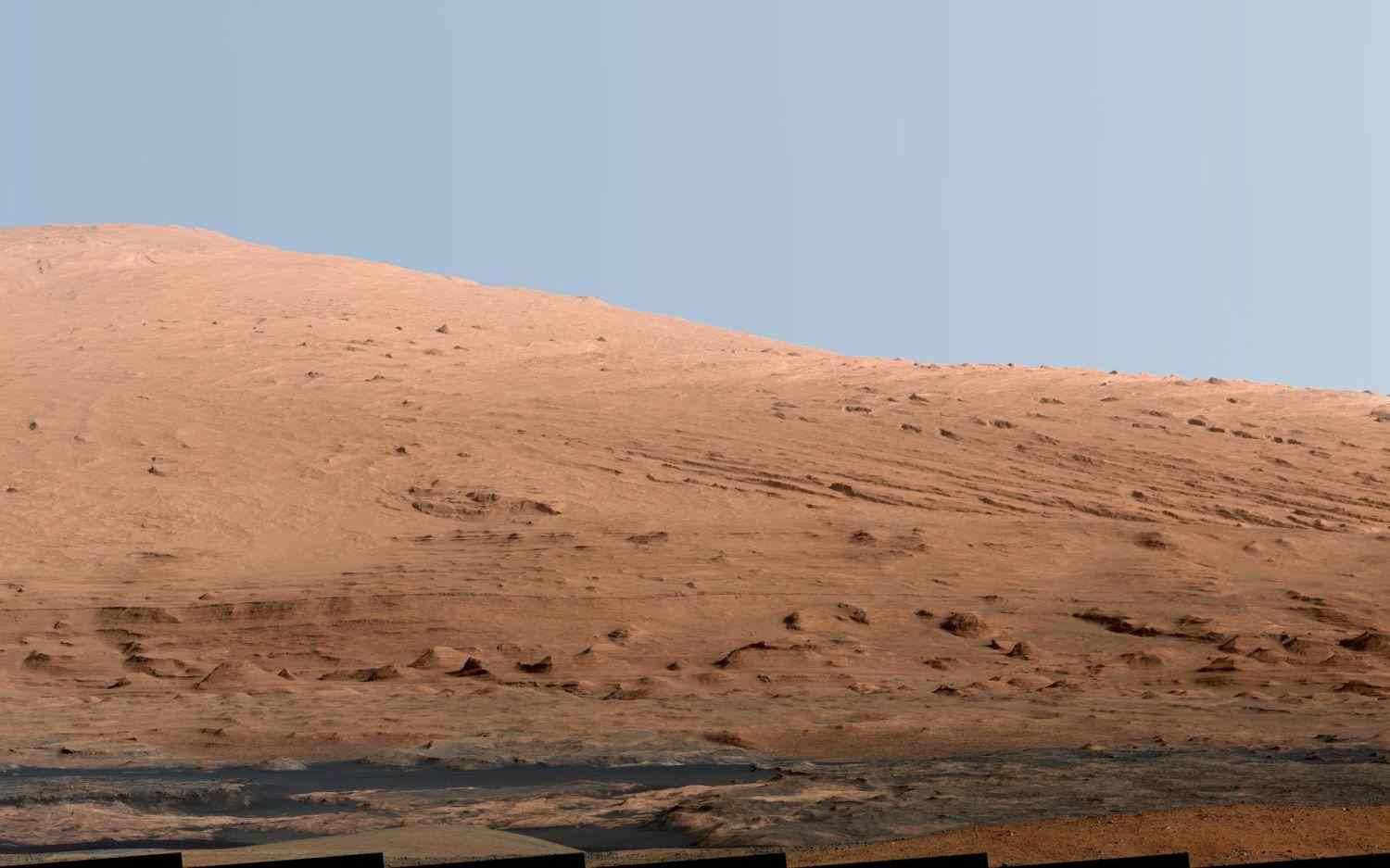
This is what Mars would look like to a typical smartphone camera. It's the raw image from Curiosity (these photos are of Mount Sharp):
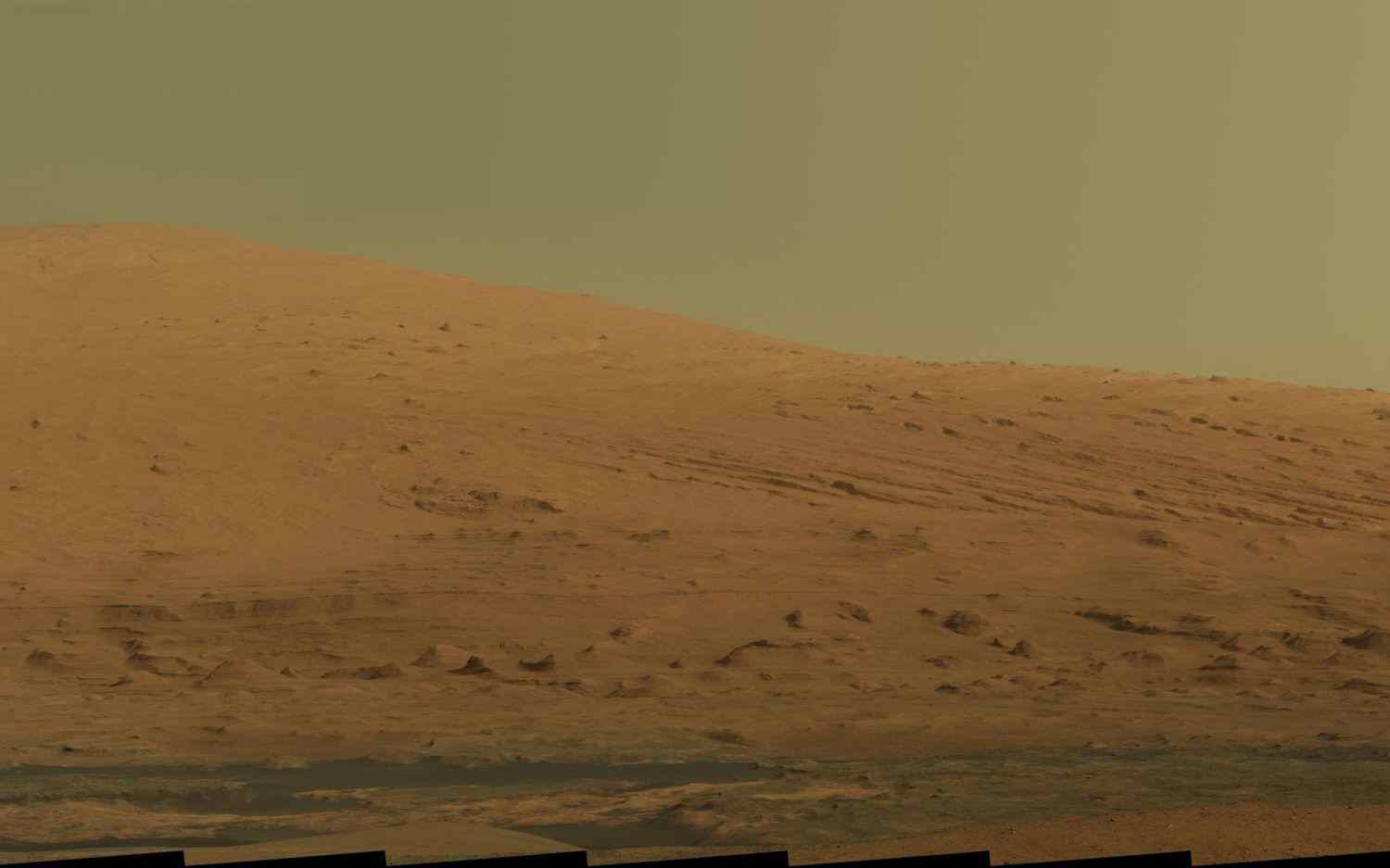
Photos from here
Sometimes the sky in press photos of the Mars surface is more of a salmon, peach or pink colour:
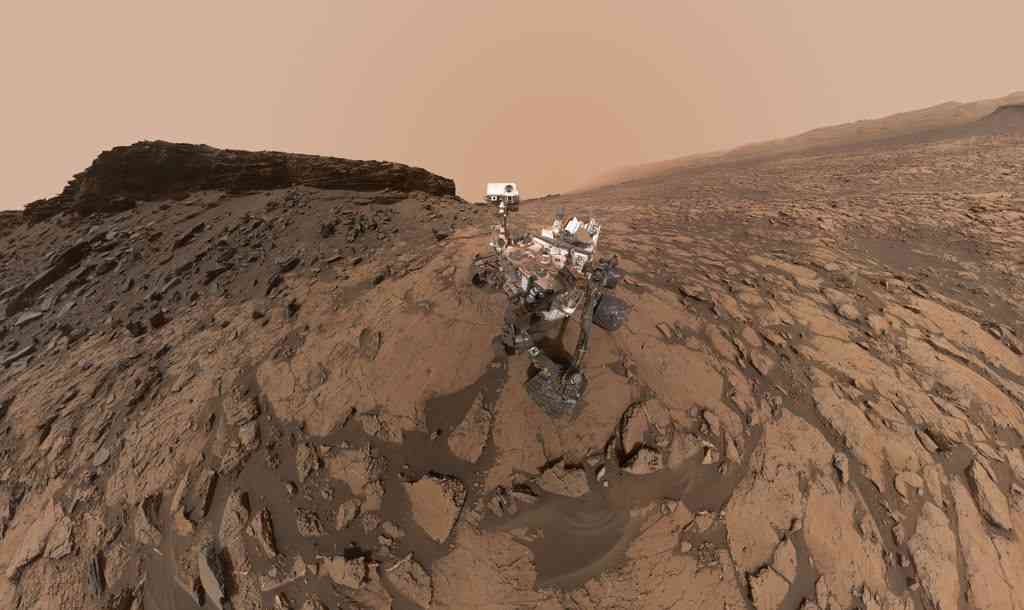
This also is colour adjusted. You can tell because the brightest colours on Curiosity are pure white, so it has to be white balanced.
This is one of the raw images used to make it
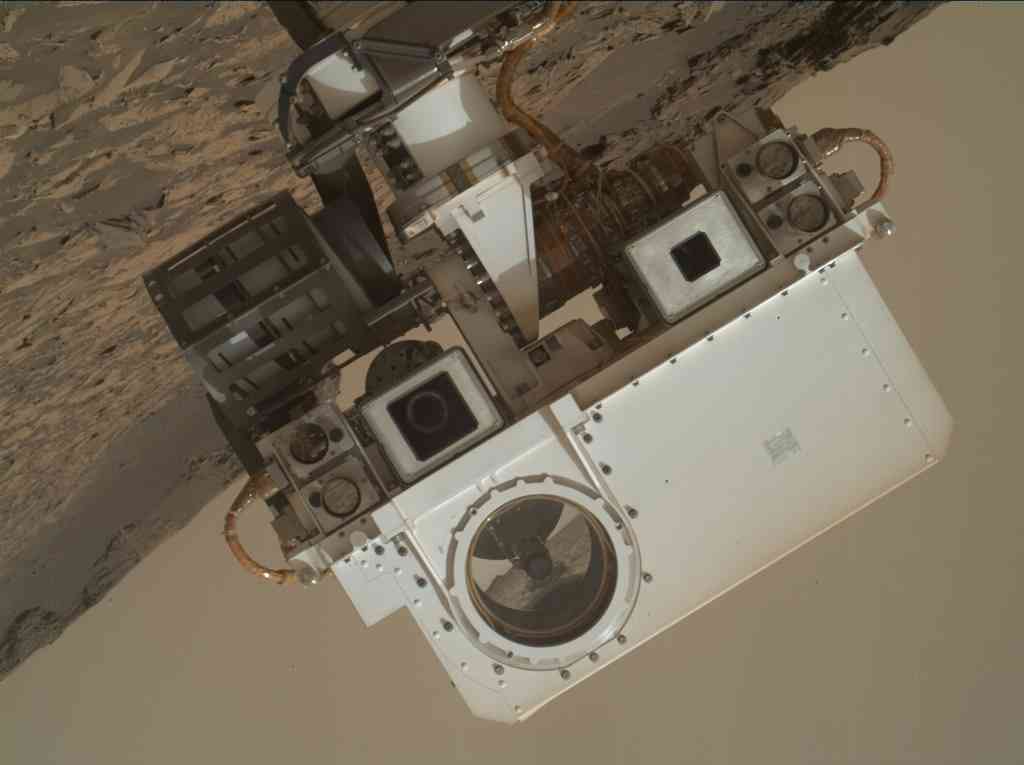
More raw images used to make the image here - taken with the MAHLI camera at the end of the robotic arm.
This is a recent non colour adjusted image of Mars
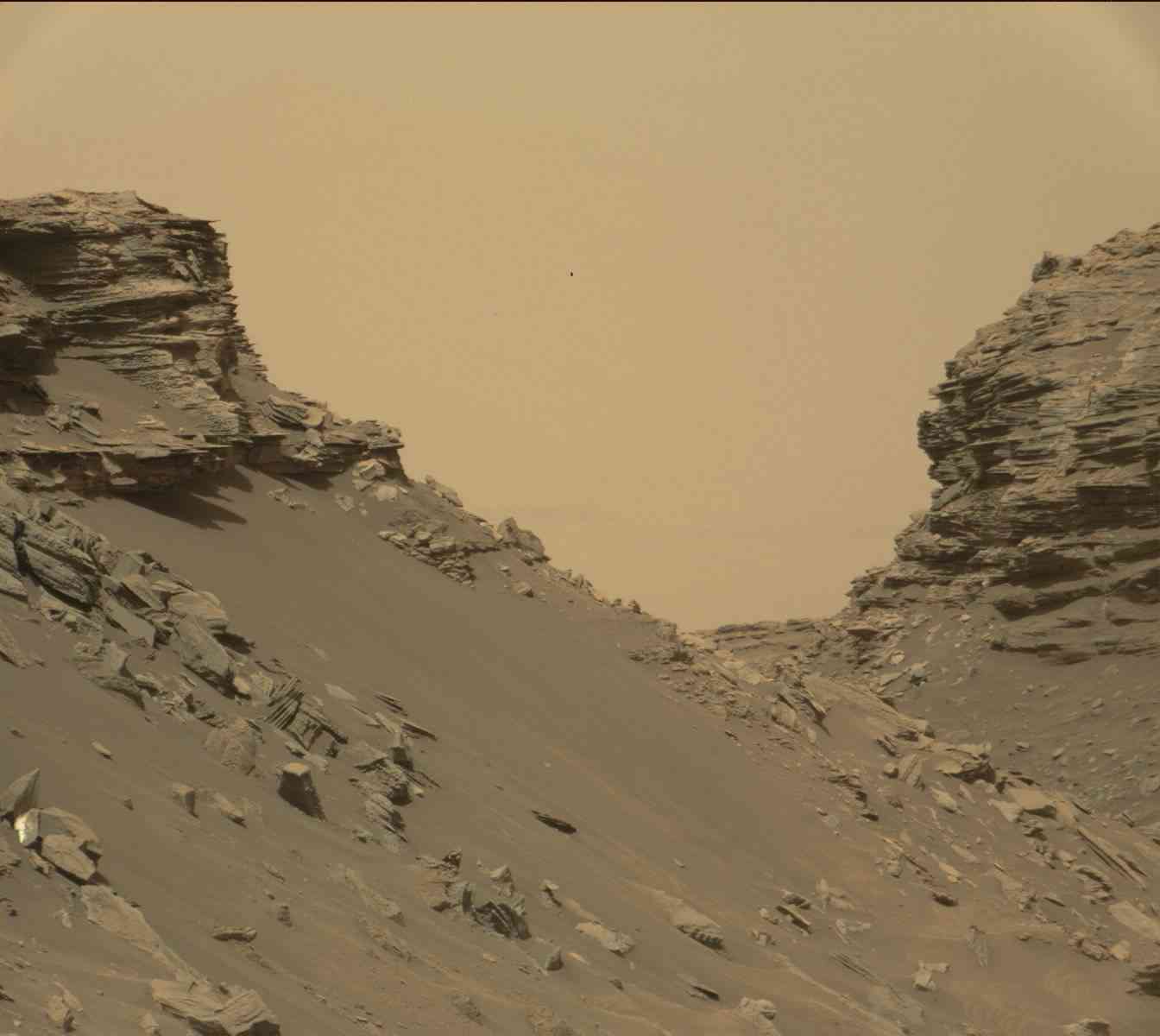
As you see the natural sky colour is much more of a brown than a red. It's often described as "butterscotch".
I found, when writing Case for Moon First, that the Moon often beats Mars for in situ resources and habitability comparisons.
So, I wondered, what if we gave the Moon photos blue skies too, like many of the Mars press photos? It's easy to do because the surface is already lit up just as it would be for a sunny day on Earth. We don't need to do anything else, just colour the sky blue instead of black, and it looks Earth-like already. I was amazed at what a difference such a simple change makes to the feel of the scene. You can read it as if illuminated on a sunny day, which is indeed what it was like for the Apollo astronauts.
Original here Apollo 17 at Shorty Crater - blue sky from here
Astronaut Eugene Cernan walks toward the Lunar Roving Vehicle during an EVA for Apollo 17, the last mission to land on the Moon - with the black sky replaced by a blue sky.
For more examples, see my article: What If The Moon Had Blue Skies? One Small Change To Apollo Photos
These photos are not meant as a suggestion that we terraform the Moon though Gregory Benford and Geoffrey Landis have looked at that possibility too (see the section on terraforming and paraterraforming).
I think the Moon would be a more interesting landscape to human eyes. It's much brighter - which tends to make us feel cheerful. By contrast, the sunlight on Mars at its brightest is half the illumination of Earth, and it's a dull brown in colour with the Mars dust suspended in the air filtering out the blue. Mars never has blue skies except around the sun at sunrise and sunset. Also there is little variation in colour in the landscape to human eyes. It's mainly dull grayish browns, with no blue and none of the bright glints catching the sunlight we have on Earth. I think that any Mars colonists would have a tendency towards depression just because of the rather gloomy sky and dull coloured landscape.
Once we can go to Mars, then we should explore it from orbit. This has no planetary protection issues if done well, and is an exciting mission for the crew. Using telepresence, they can also experience the surface more clearly, with digitally enhanced vision, even blue skies as they explore if they wish.
NASA's planetary protection officer Cassie Conley has talked about the advantages of exploring Mars from orbit first for purposes of planetary protection (see her appearance on David Livingston's the SpaceShow), and she makes strong statements about Elon Musk's rapid colonization plans for Mars as well, in an interview just before his big announcement here: Cassie Conley. Going to Mars Could Mess Up the Hunt for Alien Life
I take this a bit further than this. I don't think we should just delay the landing with orbital missions first, and aim for as much scientific exploration as possible before Mars becomes irreversibly contaminated after a human landing. I think that we should hold off from sending humans to the surface at all, until we have done an adequate exploration first. Then we can make our future decisions based on knowledge rather than conjecture. Our decision can be based on whatever we discover as we explore rather than our present guesses about what we might discover in the future.
As both of them say, and others also, we can do safe exploration of Mars from Earth. We can also explore with humans in Mars orbit, as soon as we have sorted out the safety issues for interplanetary missions without lifeboats to return to Earth in days.
We can explore Mars with robots on the surface controlled from Earth, as we have done so far, and broadband communications would speed up the pace of exploration in this way.
However we can explore Mars much more quickly, with humans in the loop. And you'd use an exciting and spectacular orbit for early stages of telerobotic exploration of Mars, following the HERRO plans. It comes in close to the poles of Mars, swings around over the sunny side in the equatorial regions and then out again close to the other pole, until Mars dwindles into a small distant planet - and does this twice every day. (Technically, it's a sun synchronous Molniya orbit).
Imagine the view! From space Mars looks quite home-like with its icecaps, deserts, even the occasional misty cloud, and the telerobotics will let you experience the Martian surface more directly than you could with spacecraft. You will be able to actually touch and see things on the surface without the spacesuit in your way and with enhanced vision, with blue sky also if you like. It's like being in the ISS, but orbiting another planet.
12th April 2011: International Space Station astronaut Cady Coleman takes pictures of the Earth from inside the cupola viewing window.- I've "photoshopped" in Hubble's photograph of Mars from 2003 to give an impression of the view of an astronaut exploring Mars from orbit.
This is a video I did which simulates the orbit they would use - in a program called Orbiter. I used their standard futuristic spacecraft as that was the easiest way to do it. Apart from that, it is the same as the orbit suggested for HERRO.
It would be a spectacular orbit and a tremendously interesting and exciting mission to explore Mars this way. The study for HERRO found that a single mission to explore Mars by telepresence from orbit would achieve more science return than three missions by the same number of crew to the surface - which of course would cost vastly more. Here is a powerpoint presentation from the HERRO team, with details of the comparison.
Then, you'd also have broadband streaming from Mars, in wide-field 3D binocular vision. It's amazing what a difference this makes, as I found out when I recently tried out the HT Vive 3D recreation of Apollo 11. We'd have similar 3D virtual reality experience of the Mars surface.
Also, it would actually be a much clearer vision than you'd have from the surface in spacesuits, digitally enhanced to make it easier to distinguish colours (without white balancing the Mars surface is an almost uniform reddish grayish brown to human eyes)|.
Here is the hololens vision, which though it's not telepresence, I think gives a good idea of what it might be like for those operating rovers on Mars in real time from orbit, some time in the future with this vision.
See Scientists Can Virtually Wander Around Mars for Miles with HoloLens
It's safer too, and comfortable and easy on the crew. No need to suit up. No risk from solar storms - at worst you have to go to a storm shelter in your spaceship, not rush back to your habitat as fast as you can to get out of the storm in time. No risk of falling over and damaging your spacesuit. And when you need to take a break, have your lunch, or whatever, you can just doff the VR set, and then come back, don it again and take it up again where you left off. Indeed you can leave the robot doing some task while you have your lunch or sleep.
Or more likely, you'd control many robots, a bit like the game of civilization. Most of them would be traveling, drilling, conducting experiments etc autonomously, and controlled by teams of researchers back on Earth. The crew in orbit would then step in to take over for any experiments or explorations that can benefit from real time telepresence.
It would be far faster. Curiosity has traveled 15.639 km as of writing this, and traveled 168.45 meters on its drive number 239 which I think is the furthest it's traveled in a day, Lunakhod 2 traveled more than a kilometer a day during it's third lunar day. That's with 1970s technology. A modern rover with modern technology, autonomous collision avoidance etc, could travel many kilometers an hour controlled from orbit, and do thousands of kilometers a year if needed.
Astronauts in orbit could do delicate experiments too requiring fine control. Many modern surgical operations are done via telerobotics with the surgeon in the same room as the patient for safety reasons. However experimentally an operation, the Lindbergh operation, was done on a patient in France by a surgeon in the US with French doctors at hand in case of anything going wrong and it went just fine. There are many other examples of telerobotic surgery over distances of hundreds of kilometers or more since then. We can definitely do delicate experiments on Mars by telerobotics.
There are many other robots we can send to Mars also. They can fly, bounce, go into small caves, go into places we could never explore in person. Any of these could also be controlled via telerobotics from orbit. For more on this see my See my Soaring, Buzzing, Floating, Hopping, Crawling And Inflatable Mars Rovers - Suggestions For UAE Mars Lander.
We don't have to halt or slow down on human exploration to keep Mars protected from Earth microbes. Far from it; we can go somewhere closer to home, and more practical in the near term, the Moon. It's an exciting place to explore, and within our abilities, yet risky. It will stretch our current space capabilities nearly to the limit. We've been to the Moon for short periods only so far, in the early morning of the lunar day. It's far more challenging to stay there for weeks and months on end, safely.
Growing crops in space is likely to be a key to dealing with the high cost of resupply to missions in space, as a way to provide both food, and oxygen for the crew. The Moon has many resources we can use in situ to stay there for longer periods of time, and it's actually quite good for lunar gardening, at least as off world places go. Some of the sites on the Moon may well be the easiest places of all to build a habitable base in the inner solar system.
The peaks of eternal light at the poles have sunlight 24/7 nearly all the year round. They are also only a short distance from what seem to be vast resources of volatiles like water, ammonia, and carbon dioxide.
Then at lower latitudes, the probably vast caves provide radiation protection, protection against micrometeorites, a constant thermal environment actually slightly warmer than the poles, and it turns out that the two weeks long lunar night is something you can work with as a gardener. Many plants can withstand 14 days of darkness with less than 50% reduction in crops if you reduce the temperatures to 2.5 - 3 degrees centigrade. And for plants that do need illumination during the night, the amount of power per colonist is much less than you'd think. With modern techniques and LED lights you only need around 500 kWh per colonist to illuminate all the crops for an entire lunar night. This is an amount well within capabilities of fuel cells, hydrogen storage and advanced forms of batteries etc.
We need to explore the Moon first, probably robotically, before setting up a human base there. Robots are the easiest way to find the best location, and to prepare the habitats for humans. That will also give us practical experience in operating remote robots from Earth much closer and easier to control than the ones on Mars. That may help with Mars exploration too, once we have humans in orbit there, or broadband communications from Earth.
For details, see my An astronaut gardener on the Moon - summits of sunlight and vast lunar caves in low gravity below, which some sites have linked to as "The Complete Guide to Lunar Gardening" :).
For the resource comparison with Mars, see See The Moon is resource rich and to find out about the science interest of the Moon, see Moon science surprises.
And longer term, let's try not to pin all our hopes for human exploration and perhaps colonization on Mars. The solar system is vast with many other places that may turn out to be far better for us, once we understand it better. These include the resources in the near Earth asteroids and the asteroid belt, see my Asteroid Resources Could Create Space Habs For Trillions; Land Area Of A Thousand Earths.
Indeed, if we could use the low impact, closed system, and efficient conveyer based agriculture suggested for space habitats, much of Earth itself is ripe for colonization, including its deserts and the oceans. With that technology, we could feed the entire world from only 2.5% of the Sahara desert. Also our oceans are four times the surface area of the land, in effect giving us four new "ocean world" planets. If we use space habitat technology for the seas as well, we could feed the population of those four extra "ocean world" planets, with four times the population of Earth, from only 0.5% of the Pacific ocean. We are talking here about minimal impact sea steading, in tethered floating sea cities.
These would be floating habitats that rely on just sea water, the air, and minimal imports from the rest of Earth, with no impact on sea life as they wouldn't need to fish and the land area is too small to shade out significant amounts of light if carefully situated. They would be constructed for far less cost than their equivalent in the vacuum of space, and would be far easier to maintain. There's no need to launch everything into orbit to set it up, no need for radiation shielding, and no need to purge the air of the noxious gases that build up inside any human occupied habitat (just open windows). Also there is no need to hold in the air against tons per square meter of outwards pressure, or to wear a spacesuit whenever you go outside. It's far easier to do seasteading than any form of space colonization. For more details, and the calculations, see my An astronaut gardener on the Moon - summits of sunlight and vast lunar caves in low gravity again.
In space, we can set up bases and supply stations in places like the moons of Mars or in orbit around Mars, in the Venus clouds, on Jupiter's moon Callisto, on Mercury, which has ice at its poles, and even further afield in the Saturn system or beyond.
All that is possible with no planetary protection issues for most of the places. Venus clouds and Callisto would need preliminary assessment to make sure there are no issues, but are likely to be okay based on the knowledge so far. There are many places in the solar system that we can visit in person, as explorers who love science and see the scientific value of space exploration as paramount. The places we can't explore in person directly in this way can be explored from orbit by telepresence until we have a better idea of what we are dealing with. There will be no shortage of adventures and new horizons in this future.
Some of you may wonder what the fuss is about as you may have heard that the chance of life on or near the Mars surface is remote. After all, that was what most experts thought until the Phoenix lander in 2008. They thought that life on Mars was possible, but only deep down, for instance in geothermal hot spots isolated from the surface, or in a very deep liquid water layer (the hydrosphere) kilometers down below the frozen surface (the cryosphere).
But the situation has changed a lot since then. So here is an update on what has changed in the last eight years.
Experts still agree that the surface is in a near vacuum and that fresh water exposed to the surface will evaporate rapidly and can't persist in present day Mars conditions. But they have found many ways that various forms of salty water and even trapped fresh water can survive on or near the surface.
This new approach started with the observation of what may be salty droplets that formed on the legs of the Phoenix lander in 2008, gradually grew, sometimes merged, and then fell off. They have also done many Mars simulation experiments and found microbes and lichens that can make use of the 100% humidity of the thin Mars atmosphere at night, with no access to liquid water in any form. In another development, various features were found in the Mars orbiter images that changed as the seasons progressed and were impossible to model using either winds or dry ice processes.
The warm seasonal flows, or "recurrent slope lineae" are just one of many proposed types of habitat for life on the Mars surface. I covered the literature in my detailed survey article Are There Habitats For Life On Mars? - Salty Seeps, Clear Ice Greenhouses, Ice Fumaroles, Dune Bioreactors
There's an almost bewildering variety of suggestions for habitats on Mars for life now. The main surface or near surface ones are (these links take you to the online version of the booklet)
Most of those habitats are either above the permafrost layer or at most a few centimeters below it (the permafrost layer is typically 2 cms below the surface of the Mars regolith or less).
They are all almost impossible to detect from orbit, as they are covered by a few mms of the regolith, or lie beneath layers of ice, and most are also very small in physical extent. The only way we know to explore most of them and in many cases the only way to know for sure even if they exist, is with surface exploration missions, with landers or rovers.
That should be no surprise, because Mars is so cold and dry. It was probably as habitable as Earth originally, but after it lost most of its water, ice and atmosphere, the most habitable places now are like the Atacama desert and the dry valleys in Antarctica. They are cold, and dry, and any life is likely to be so slow growing and sparse that it has no noticeable effect on the atmosphere. Yet, if life did once get established on Mars, it may still be there.
It's rather like the future for Earth itself, which may became as uninhabitable as Mars, hundreds of millions of years in the future (unless some civilization either moves the Earth or shades it from the sun with vast thin film shades). It's likely to get too hot rather than too cold in our case. If so, the chances are that some small remnants of the formerly abundant life would survive long after most other species have gone extinct.
As Nilton Renno said, about his discovery of the possibility of droplets of water on salt ice interfaces on Mars,a droplet of water is like a swimming pool for a bacteria. Relicts of formerly abundant life would be no less interesting for being sparse and hard to detect. For more about this, see my article Why Mars Surface Life May Leave No Traces In Its Atmosphere: Our Rovers May Need To Go Up Close To See It
I think one of the most striking of these suggested habitats for planetary protection, though less well known, are the "flow like features" in Richardson crater near the south pole, as these suggest the possibility of fresh liquid water on Mars trapped below ice. The conclusions of Möhlmann's model are clear - if Mars does have clear blue ice as in Antarctica, then it should also have layers of pure fresh water trapped 10 - 20 cms below the surface, in conditions with surface temperatures as low as -56 C.
If so this may explain seasonal features found in Richardson crater. See my Does Ice Act As Greenhouse On Mars - Fresh Liquid Water Habitats In Spring 10-20 Cms Below Polar Ice?
Then the methane plumes, if they are signs of life, surely must indicate abundant life in more habitable conditions, deep down, with some communication with the surface to let the gas escape. That would suggest of course that they could potentially be vulnerable to contamination by Earth microbes from the surface in the opposite direction. The plumes could also be caused by the inorganic process of serpentization. They may also be due the release of methane clathrates formed on early Mars by either organic or inorganic processes.
There's a wide variety of views on the topic of whether any of these potential habitats are in fact habitable by Earth life. If they exist, they may also be either too salty or too cold for life. Also some of the habitats that work in Mars simulation chambers and theoretical models of the surface may just not exist on Mars, as they depend on conditions we can't know about.
As an example, the fresh water model for the flow like features in Richardson crater depends on clear ice like the blue ice of Antarctica to act as a greenhouse to warm the ice to melting point half a meter below the surface. If similar semitransparent ice exists on Mars, the models show that there will be trapped layers of liquid water in the ice at certain times of the year, but we just don't know if Mars ice forms in transparent layers like that or not.
If these habitats do exist, again we have no idea whether they are inhabited by any form of indigenous life.
Views on this range from almost impossible to very likely, see Views on the possibility of present day life on or near the surface, and for the idea that some of these may be inhabitable but uninhabited, see Uninhabited habitats.
If these habitats do exist and are habitable, there are many Earth microbes which have been shown to be able to survive in Mars simulation conditions, and so could potentially survive there, contaminate them and make it difficult or impossible to study them to find out what was there originally.
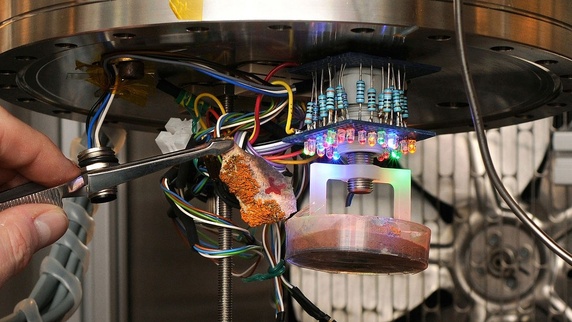
Researchers at DLR (German equivalent of NASA) testing lichens in Mars simulation experiments. They showed that some Earth life (lichens and strains of chrooccocidiopsis, a green algae) can survive Mars surface conditions and photosynthesize and metabolize, slowly, in absence of any water at all. They could make use of the humidity of the Mars atmosphere.
Though the absolute humidity is low, the relative humidity at night reaches 100% because of the large day / night swings in atmospheric pressure and temperature.
Here is a list of some of them, for the cites see my Candidate lifeforms for Mars in my Places on Mars to Look for Microbes, Lichens, ...:
Most of these candidates, apart from the lichens, are single cell microbes (or microbial films). The closest Mars analogue habitats on Earth such as the hyper arid core of the Atacama desert are inhabited by microbes, with no multicellular life. So even if multicellular life evolved on Mars, it seems that most life on Mars is likely to be microbial.
The astrobiologists have invented many ingenious instruments we can use to search for life on Mars. We don't need to send humans there. We haven't sent a single life detection instrument to Mars since the Viking landers in the 1970s. Many of these tests are exquisitely sensitive, some can detect a single molecule in a sample, or just a few cells.
The main approaches are
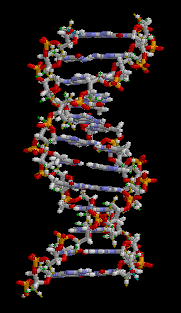

Many of these instruments are small, just a few cms in size, and requiring less than a watt of power, "labs on a chip" some of them already tested and space hardened. Yet none have flown yet. One of them, the Life Marker Chip, polyclonal antibodies experiment was originally included in the payload for ExoMars (more about it here) but was descoped. Before that, Urey was going to fly on ExoMars until NASA pulled out of the partnership.
MOMA will fly on ExoMars, with its ability to detect chiral compounds. Both ExoMars and Curiosity will be capable of Raman spectroscopy. But most of these instruments are not yet included in any mission payloads so we will need to wait a while before we get any results from them.
And, no, we don't need humans to drill. Indeed humans in spacesuits are clumsy at that as we found out with Apollo, and they can't use water as a lubricant. ExoMars will be able to drill down two meters, and the Insight lander was going to drill three to five meters.
The main technology used, the robotic self hammering mole, has potential to drill much deeper than either of those, and certainly to the ten meters depth needed to find organics not degraded by cosmic radiation and solar storms. These moles may eventually drill for tens and hundreds of meters, even for kilometers in Mars conditions at ten to twenty meters a day. Honeybee robotics say that a related technology, their inchworm mole will be capable of drilling up to tens of kilometers through soil, ice and rock without need for a tether and then return to the surface.
For more on this: Will NASA's Sample Return Answer Mars Life Questions? Need For Comparison With In Situ Search
Usually Moon first books, such as The Value of the Moon, Moonrush, and The Moon: Resources, Future Development and Settlement argue that it has material resources that could be exported to LEO, or to Earth, that it has more potential than Mars for commerce, or tourism, that it has volatiles and other resources which can be used in situ to support humans there, and that it is a far safer destination for humans than Mars in the near term.
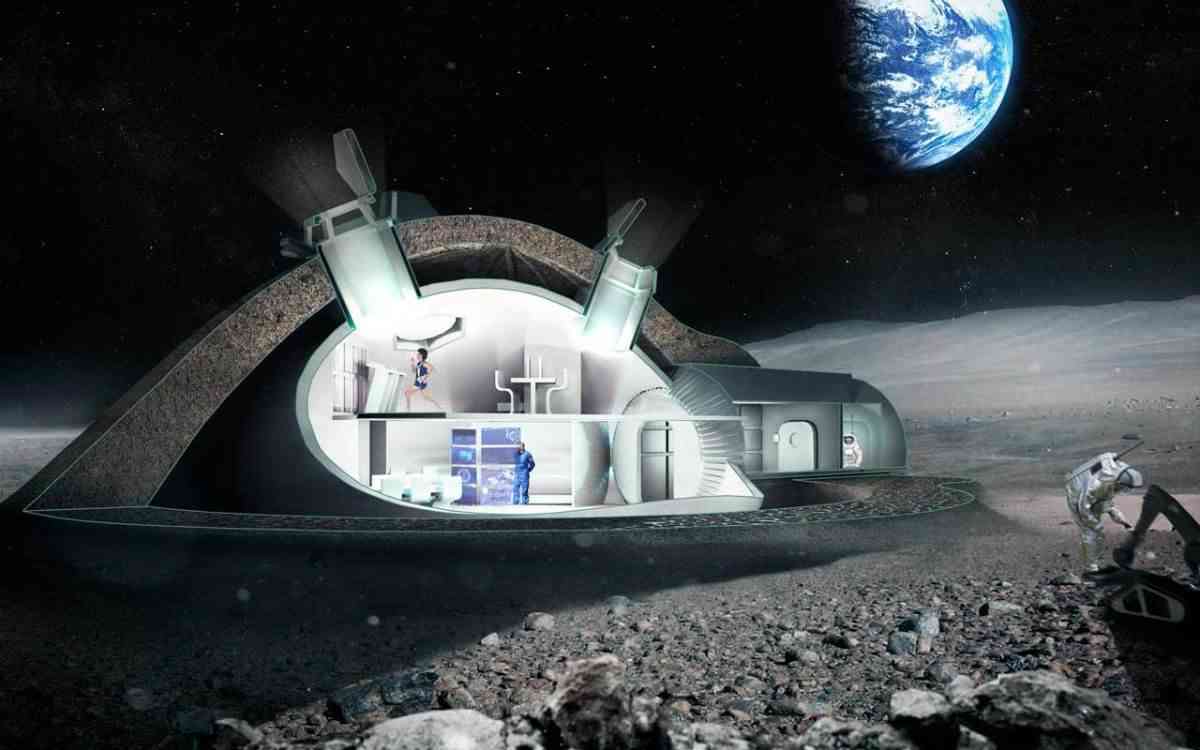
Inside look at one of the ideas for the ESA moon village, using 3D printing on the Moon for the radiation shielding. Image credit Foster + Partners / ESA. The ESA's new director, Professor Johann-Dietrich Woerner is keen on taking us back to the Moon first, and has an exciting vision for a lunar village on the Moon as a multinational venture; a village resulting from co-operation of many nations, rather like the ISS, involving astronauts, Russian cosmonauts, maybe even Chinese taikonauts, and private space as well.
Moon firsters also highlight the science value of the Moon and the many mysteries about it still to be solved. This book covers all those things, but it has an extra message about Mars as well, especially addressed to all of you who love science, such as President Obama. The Moon is part of a larger scale vision about how to explore our solar system in a scientifically responsible way.
This book's strongest message is that if we rush humans to the Mars surface as fast as possible, it is going to get in the way of exobiology - the search for biology based on different principles from Earth life. This search is one of our main science objectives for Mars, and has the potential to lead to the most significant discoveries in biology of the twenty first century. If you love science, you won't want to destroy this chance by rushing to land humans there as fast as possible.
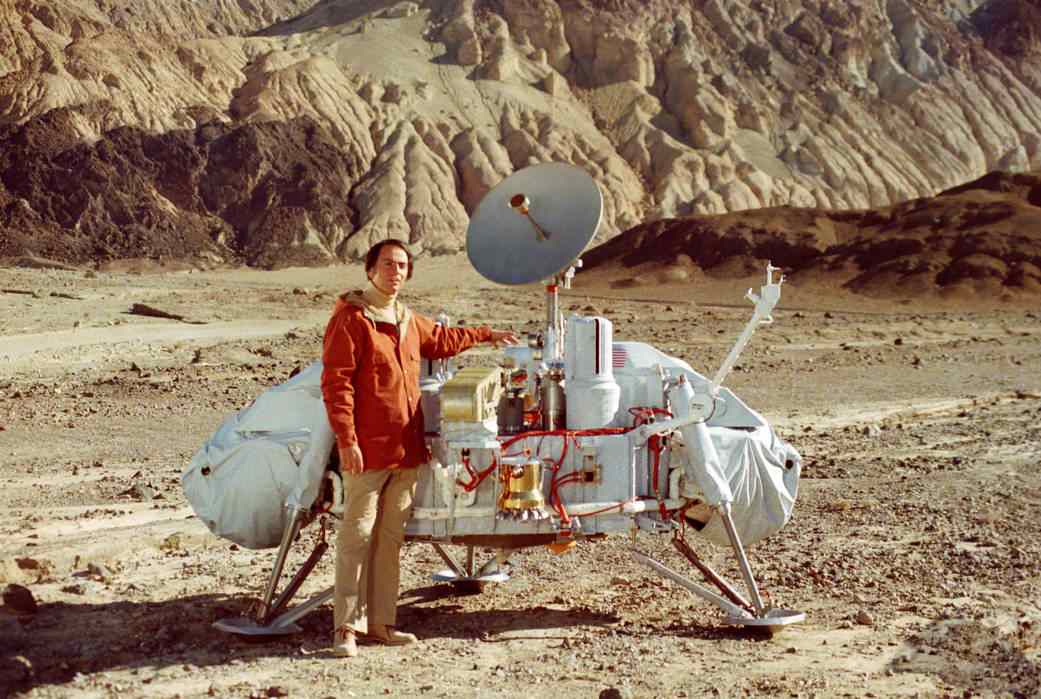
Carl Sagan with a model of the Viking lander, so far the only biological expedition to other planets in our solar system. The two Viking landers in the 1970s were the first and also the last spacecraft to search for extant life directly on Mars. All our rovers and orbiters since then have searched indirectly for conditions habitable for life and in a limited way for organics and trace gases. These could be caused by life, or by inorganic processes (for instance, the organics discovered by Curiosity most likely came from meteorites). Our biological exploration of Mars needs to resume, but we have to do it with sterile rovers or we risk making the anticlimactic discovery of life that we brought ourselves.
It's not us that are the problem, but the microbes that accompany us, trillions of them, in thousands of species, some of which may be able to survive on Mars. Sadly, it would kill us to attempt to remove them from our bodies.
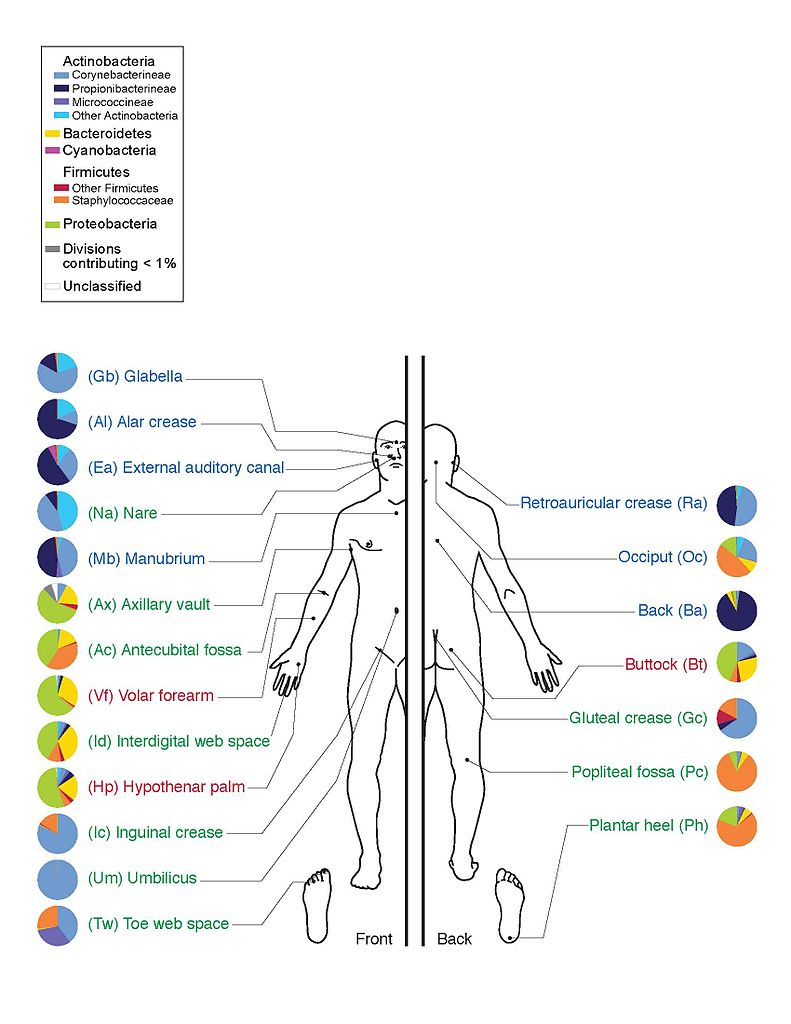
Shows the distributions of different types of microbes in the human microbiota. We also have internal populations of microbes in our guts, on our tongues, sinuses, lungs etc. They are smaller than our body cells but more numerous. An adult male of 70 kg contains about 30 trillion human cells and 39 trillion microbial cells, with thousands of species present on every human being. These populations are also diverse, so your friend might well have a different population of microbes from you. For instance, in a survey of microbes in human belly buttons, examining DNA fragments to search for a core microbiome, they didn't find any DNA fragments present in all the individuals. It's not possible to sterilize a human of all these microbes.
Extremophiles are often capable of living in ordinary environments as well, As an example, take chroococcidiopsis, an ancient photosynthetic algae, and probably one of the ones that brought oxygen to Earth originally. Over these billions of years it's developed a wide range of capabilities. It's a radioresistant polyextremophile (able to withstand high levels of ionizing radiation). It is found in locations as diverse as tropical waters of Sri Lanka, Antarctic ice and dry Antarctic rocks, fresh water, hot spring,s hypersaline water, and conditions of only 60% humidity and no water at all in the Atacama desert in salt pillars. It is one of the top candidates for a microbe able to withstand the Mars surface environment in simulation experiments.
Sadly, extremophiles capable of living on Mars can be found anywhere including on and in the human body (example, Serratia liquefaciens "found in human skin, hair and lungs, as well as in fish, aquatic systems, plant leaves and roots" is one of the best candidates for surviving in reduced pressure at 7 millibars).
Many microbes are able to survive our best attempts to sterilize spacecraft clean rooms (example Tersicoccus phoenicis, a new species and genus found in two separate clean rooms). So they would certainly be present in human occupied spacecraft.
The problem with introducing Earth life to Mars after a human landing or crash is that it is irreversible. There is no way to remove the long lived hardy microbial spores from the planet once scattered in the global dust storms. If any of them encounter habitats they can reproduce in, this would be an irreversible change to Mars for us, for our descendants, and for all future civilizations in our solar system.
New discoveries over the last eight years suggest that such habitats may well exist on Mars, bringing these concerns into sharp relief. (See Present day habitability of Mars and ways to detect present day life there below). If later on, we find that we've made a huge mistake by bringing these microbes to Mars, there will be nothing we can do about it.
This argument has less force for those who think pure science is of only secondary importance compared to colonization by humans. If that describes you, I suggest that you give some thought to the many discoveries in medicine, agriculture, and indeed even in materials science and other areas of industry, that depend on deep knowledge of biology. How might those be impacted (in a positive way) if we understood biology better than we do now, and have examples of life based on different principles from terrestrial life? Perhaps that may help you to relate to the motivation for this book.
There is the safety issue as well. Traveling even to Mars orbit (which has no planetary protection issues if done carefully) may be a step too far. It is like setting out on a two year voyage with no lifeboats, in an ocean so dangerous that you can't survive for more than a minute or two of immersion in the sea without a lifeboat.
Going to the Moon is like setting out on a voyage in equally dangerous seas, but with lifeboats able to get your entire crew back to safety within two days in an emergency. It's going to stretch our capabilities almost to the limit to stay on the Moon through the day night cycle of an entire lunar month. We don't need the extra challenges of an interplanetary mission yet. Apollo 13 could circle around the Moon after its oxygen tank explosion, and return to Earth in a few days. A crew on a Mars expedition which encounters a problem just as it leaves Earth would have to last for around two years before they can come back to Earth in a similar fashion via Mars. (Reduced to 500 days if they can do an extra Venus flyby on the way back)
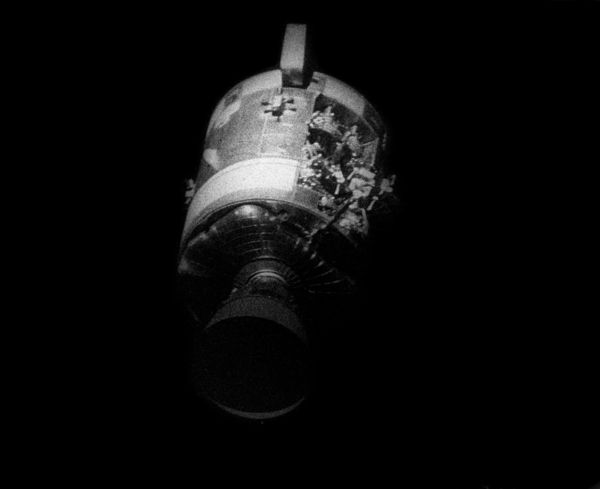
Damage to the Apollo 13's service module, 56 hours into the mission. One of the oxygen tanks exploded, due to a combination of a flawed design and human error.
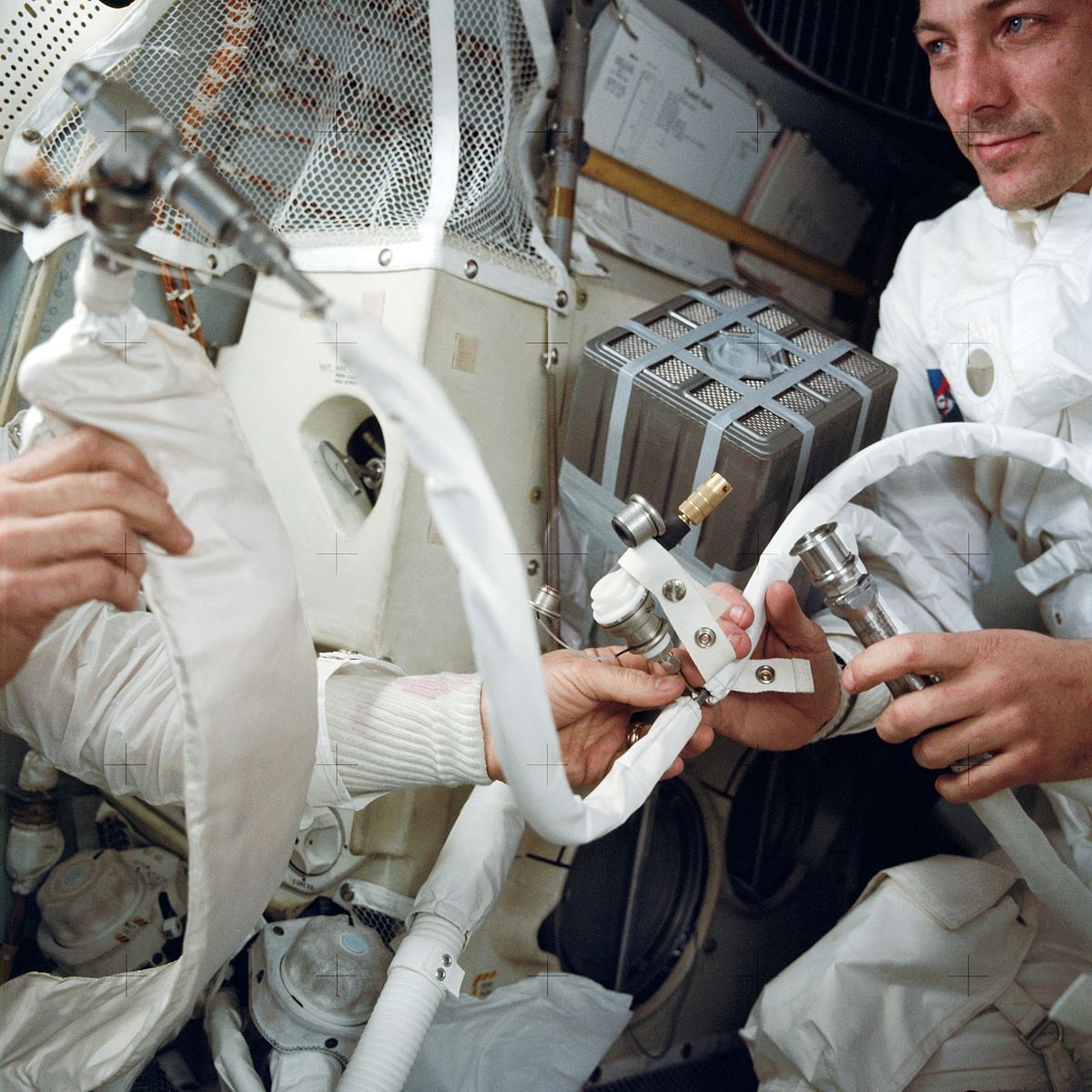
Jack Swigert (right) showing the apparatus the crew of Apollo 13 got together, with instructions from Earth. They had to fit a "square peg into a round hole", to connect the cube shaped command module lithium hydroxide canisters to the cylindrical lunar module sockets in order to scrub the air of CO2. It was a fine display of MacGyver style improvisation even using duct tape to complete the job.
Oxygen was not a problem as the lunar module had plenty, enough to repressurize it after each EVA. But carbon dioxide poisoning was a real risk and they needed to use the command module canisters to scrub the air, or they'd have passed out. In this way they were able to use the lunar and command module systems together as a "lifeboat" to survive the journey around the Moon and back to Earth.
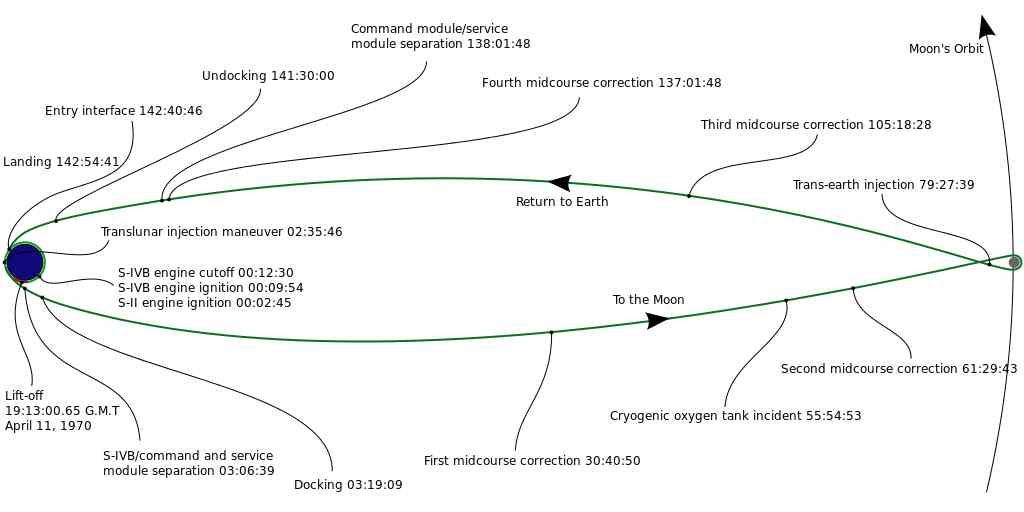
This shows the path taken by Apollo 13. Although the accident happened only fifty six hours into their flight, the safest way to get back was via the Moon, and they got back three and a half days after the accident.
If an Apollo 13 style accident happened to a human occupied spacecraft on the way to Mars, even if it happened just after the crew left Earth, they would not have enough delta v rocket power to get back to Earth. Rather, like Apollo 13, they would have to go all the way to Mars and back before they could be rescued. However this time it would be a multi-year journey to get back.
For this reason spacecraft systems for multi-year journeys must be supremely reliable and tested. I don't think we are likely to reach that level of confidence until we have had several such missions closer to Earth, on the Moon or in the Earth Moon system (for instance, exploring the far side of the Moon remotely from the L2 position). They need to be missions able to function without resupply of essential supplies from Earth, which would also be necessary to reduce costs. The ISS doesn't count, because it is designed for LEO rather than for multi-year interplanetary missions, and has to be resupplied every few months from Earth.
The Moon is far safer, as all the crew can be supplied with lifeboats with provisions sufficient to get them back to Earth safely within two days. It's still a major challenge that will stretch our capabilities almost to the limit. The later Apollo missions made it seem almost easy, but it was far from it.
Let's start with the Moon for both safety and planetary protection reasons. It's turned out to be far more interesting than previously expected, with many science surprises and surely many more to come. It's also resource rich, indeed in one comparison after another, you may be surprised to find out that it comes out better than Mars for in situ resources.
Then longer term, let's stay in orbit around Mars for now, visit Callisto, the clouds of Venus in airships and floating habitats, Mercury, the asteroids - and further afield. But if you land humans on Mars, that has a potential for an irreversible impact on discoveries in exobiology not just for us, but for all future civilizations on our planet and in our solar system. If you love science, you may well agree that we just must not do this until we have a better understanding of the possible impacts of our actions. It's what I've called a "superpositive outcome".
Also, protection of our beautiful Earth, so hospitable to humans, should be a top priority. I know this will be controversial with many saying we have to go multiplanetary to survive. But we face no immediate natural threats of human extinction. A creature as versatile and adaptable as us with minimal technology could survive any of the natural disasters Earth has been through for billions of years, see 90% of species extinct converts to zero probability of humans extinct. As for the possibilities of making ourselves extinct by our own actions, those could as easily be a consequence of a rush to colonize as averted by them, so what matters is not so much whether we colonize as how we do it. If we have protecting and cherishing Earth as our top priority, I think that will lead to a healthier approach to space settlement. I cover this in the section: Wait, Let's Not Rush To Be Multiplanetary Or Interstellar
I hope this book will stimulate discussion of these ideas.
The Moon is hardly explored by humans. So far we've only explored locations close to its equator, on the near side. Also we've only ever visited it in early morning of the lunar day - the safest time for humans to be there. The longest visit was for three days and only one party (Apollo 17) had a geologist on board. Every EVA there was dangerous, and we haven't been back there since the 1970s. Since then, we have only shuttled back and forth between Earth and LEO for several decades.
To take the next step, to last out on the surface of the Moon for an entire lunar month, through the heat of the two weeks long lunar day and the darkness and cold of the lunar night, is a bit like overwintering in Antarctica for the first explorers, after they proved that they can land on the continent and walk around for a day or two there. Expeditions to the lunar poles don't have this issue as they have sunlight nearly 24/7 but they have many other challenges of their own. The Moon is not at all well known on the surface at present and we can expect many surprises and difficulties to overcome.
So the Moon is a more natural starting point, I'd love to see humans to Mars orbit, and if it is done carefully, this has no planetary protection issues, as we'll see in this booklet. But we should start closer to Earth first. The secret to success for Apollo 11 was a step by step approach, starting with orbital tests around Earth, the first orbit of the Moon with Apollo 8, and so on. A similar step by step approach ending in a mission to Mars orbit would start with two year missions closer to Earth, before we try the long mission to Mars without lifeboats. We would then explore the surface from orbit via telepresence, just as we often explore the sea bed, ship wrecks, etc.
There are places on Earth we don't go to because they are unsafe, e.g. into the crater of an active volcano. We send expendable robots instead.
There are other places tourists and explorers can't visit because we would harm what's there, e.g. ancient cave paintings where just the human breath is enough to damage them, as we discovered with the Lascaux paintings. New discoveries of prehistoric cave art are immediately set off limit to all except a few scientific researcher. This happened for instance for these recently discovered 14,500 year old cave etchings in Iberia.

14,500 year old art found inside an Iberian cave. As soon as new cave art like this is discovered, the cave is made off limits to all except a few experts ,because humans can damage the paintings and etchings just by breathing inside the cave.
And though they are rare on Earth, there are places here too that we don't go to, to avoid contaminating them with microbes. We haven't sent a submarine into Lake Vostok.
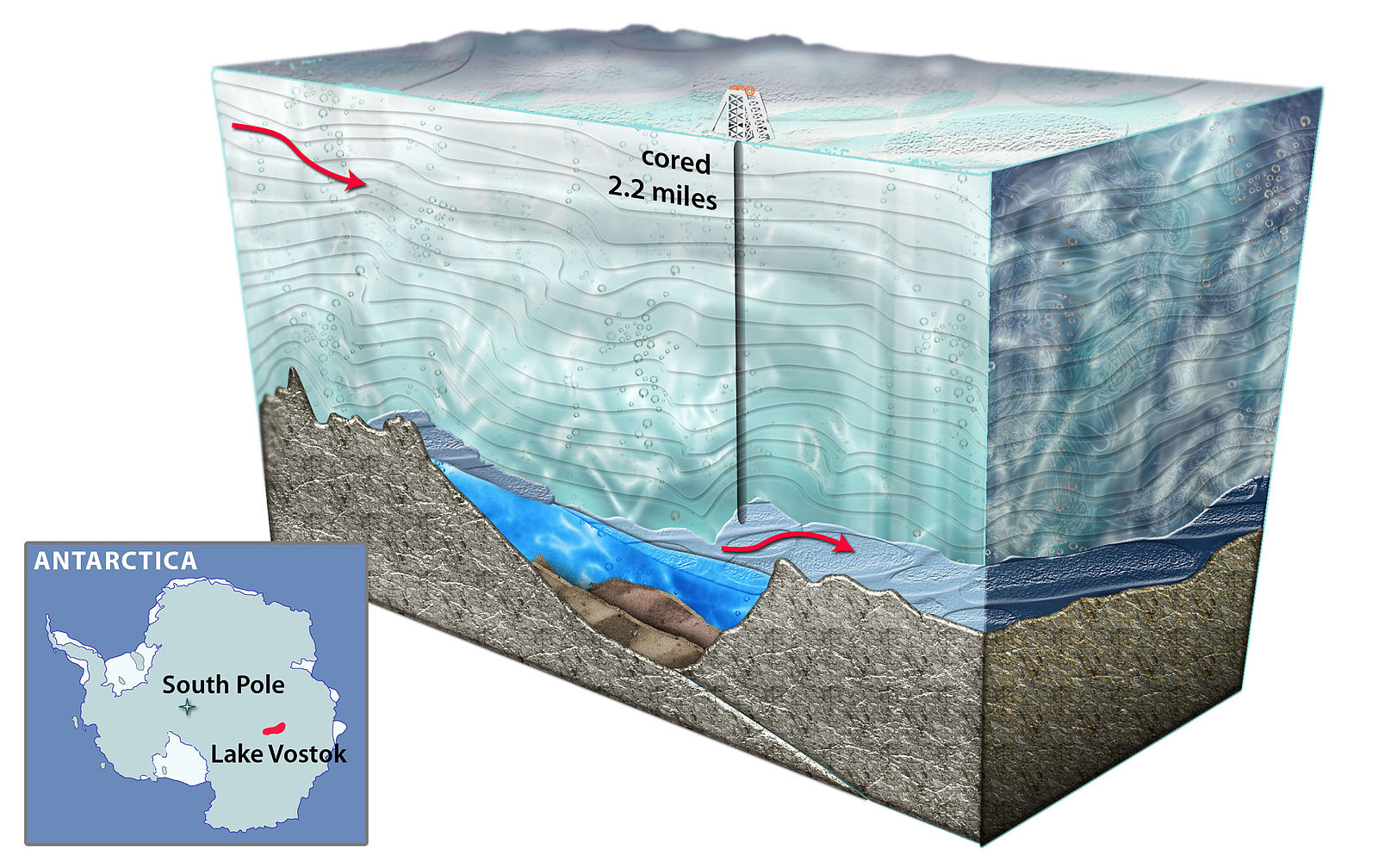
Lake Vostok in Antarctica, a deep subsurface lake isolated from the surface for perhaps 500,000 years. The Russians drilled nearly all the way through but stopped. They then used a method of drilling that made sure that the water rushed upwards from the lake with no risk of contaminating it with surface life. This is perhaps the closest we have to planetary protection on Earth.
Even robots are hard to sterilize sufficiently to explore it, so they haven't yet sent a robotic submarine into it either. They have only drilled in such a way as to cause a geyser which they sampled before it rapidly froze over, and there are questions about whether what they sampled adequately represents what is in the subsurface lake or is contaminated by surface life.
Visitors to Antarctica also have to clean their boots to avoid introducing novel microbes and microfauna and flora to the Antarctic soil. Sadly, cleaning our boots is not a sufficiently stringent measure to protect Mars from our microbes, as we will see.
I suggest in this book that just as with lake Vostok in Antarctica, and with even stronger motivation, there are places in our solar system that should be similarly off limits to humans at least until we understand them better. Mars, Europa and Enceladus are the three top places in the solar system with planetary protection issues.
Once it is safe to travel on interplanetary missions, there are many other challenges solar system wide. There are no planetary protection issues for the Moon, Callisto (probably), Mercury, Venus clouds (probably), and most asteroids and the moons of Mars. Let's focus on those first. Let's not rush humans as quickly as possible to the one place in the inner solar system where their microbes can cause most damage. On behalf of those who love science and think that new discoveries in biology have value for our future, please, let's look first before we "Leap to Mars"!
Originally published on my Science20 blog here: Does Elon Musk's Plan Violate The Outer Space Treaty - Planetary Protection For Mars After Human Crashes
This is a news story that broke recently, on the idea that Elon Musk's plans would violate the Outer Space Treaty. The articles I've read so far focus on property rights and the provisions in the OST that rule out ownership of territory. But that can be fixed with future legislation, especially since it's not really the land but the habitats that are of most value, and ownership of those is already covered in the OST . So far none of them have mentioned by far the toughest legal and practical obstacle, which is planetary protection of Mars from Earth microbes to preserve its science value for the future of mankind.
That can't be fixed by passing new laws. Elon Musk says the mission would be dangerous, with colonists risking death, especially the first ones. The biggest danger is on landing, and a crash of a human occupied ship on Mars in a Challenger type accident would strew fragments of bodies, food, water, air, and spacecraft over the planet. That would be pretty much the end of any planetary protection of Mars.
The planetary protection requirements are not just a result of decisions by fussy bureaucrats. The ones responsible are concerned astrobiologists, such as Carl Sagan and Joshua Lederberg (nobel prize winning pioneer in microbial genetics), and built up in detail over many discussions by international groups of astrobiologists and other scientists in biannual meetings of COSPAR. Nor is it a minor concern of detail. They are concerned that we could rob ourselves and future generations of discoveries in biology as fundamental as the discovery of the helical structure of DNA or the theory of evolution.
So far every space faring country has taken care to sterilize their spacecraft if necessary and abide by the provisions of the OST as interpreted by the COSPAR meetings and guidelines. Most have signed and ratified the Outer Space Treaty and even the United Arabic Emirates, who haven't ratified it yet, say that they will take care to abide by its provisions if they succeed in their plan to send a mission to Mars. It just makes sense to do so.
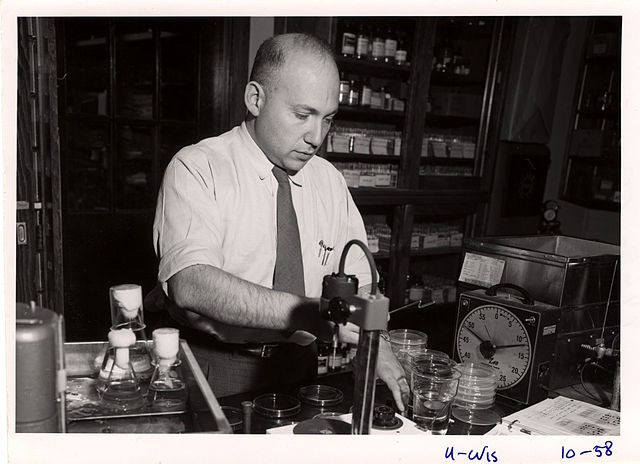
Joshua Lederberg at work in a laboratory at the University of Wisconsin 1958, nobel prize winning pioneer in microbial genetics and pioneer in the field of planetary protection along with the astrobiologist Carl Sagan. He was one of the first astrobiologists, indeed he coined the word "exobiology"
Then, Curiosity's "seven minutes of terror" wasn't just hyperbole. There was a real risk that it would crash, especially with such novel technology, with many previous examples of crashes on Mars. This is especially tricky with the Mars atmosphere too thin for a conventional parachute to work by itself - but with the gravity too much for a lunar module type landing. You need to refuel to get back to orbit again.
Elon Musk's idea is to use supersonic retropropulsion. The rocket lands on the Mars surface in reverse. It has to use the atmosphere for aerobraking, and simultaneously fires its rockets to bring it to a standstill on the surface. The atmosphere is only thick enough for this close to the surface, so it skims down to a landing within a few kilometers to the surface - so close that it can't land on mountainous areas of Mars because the air is so thin.

Artist's impression of red dragon doing supersonic retropropulsion over Mars, image SpaceX
The planetary protection office, and COSPAR have discussed human missions to Mars. There is no set out protocol yet, but in their preliminary discussions they suggest human missions confined to a particular area of the surface. They accept that this is an irreversible introduction of Earth microbes to Mars and just aim to limit and delay the impact.
However they do these planetary protection assessments of human missions to Mars based on the assumption of a successful landing on Mars. They don't consider the possibility of a crash as that's left to mission planners at a later stage. Yet, for robotic orbiters Mars is treated as a Category III mission and needs to be sterilized to levels that will make the mission safe in case the orbiter crashes on Mars!
At some point someone has to consider what the effect would be of a human crash on Mars, and once you consider that, and if you assess the planetary protection issues for it, I don't see how anyone could either say that a crash won't happen, or that a crash would be anything short of a total end of protection of the planet. It might not be the planetary protection office that do this, if they continue with this policy of assuming 100% successful landings in their assessments. But someone has to do it.
I think that an orbiter mission for humans on Mars also needs assessment for the possibility of a crash on Mars just as for robotic orbiters. There could be ways to make it safe enough so that the possibility of a crash is for practical purposes non existent.
First, I think flyby missions like Robert Zubrin's Double Athena Flyby could be made sufficiently safe for planetary protection. This is an interesting mission that does two flybys of Mars and in between orbits almost parallel with Mars for half an orbit or one Earth year. The crew are close enough to the surface of Mars for telepresence style telerobotics for of order of hours, for both flybys, and are within close range of the planet for days.
Flybys can be done accurately, we've done multiple flybys with Cassini and other spacecraft. We haven't yet had a crash during a flyby mission. You'd use trajectory biasing, so that the final stage misses Mars, and so that if something goes wrong the human occupied spacecraft also misses Mars, and then do gentle nudges to keep it on target, and months during which you can refine the orbit and make sure you are on target.
I think that an orbital insertion maneuver though could go wrong and lead to humans crashing on Mars as has already happened, with the Mars climate orbiter.
Another type of transfer though is very safe - that's ballistic capture. In this approach, the spacecraft is launched to arrive in a distant orbit around Mars, at just the right speed so that it is captured by Mars as a temporary distant extra minimoon with no need for an insertion burn. The crew then can use ion thrusters to slowly modify their orbit to get close to Earth for telepresence during part of the orbit. Ion thrusters change orbit so slowly, that there's not really any significant risk of them accidentally impacting on Mars. So it's much safer for the crew also, and I think probably has no significant planetary protection risks.
This would need to be looked at carefully, and you need to consider also whether any waste material ejected from the spacecraft could hit Mars, but it does seem you could have human missions to Mars that don't need to be sterilized to the levels needed for robotic orbiters to date, without compromising on planetary protection.
Extremophiles that also live in human habitats and found in spacecraft clean rooms can survive in the suggested habitats on Mars if they exist and many have hardy spores and other dormant states that could be carried in the global dust storms throughout Mars. Humans are not the problem, the microbes that inevitably come with them are. After that, any searches for present day life on Mars would need to have as the default hypothesis that what they find was brought to Mars on that crashed human mission, an enormous impact on scientific exploration of Mars.
It would not be "easy to distinguish" as Zubrin suggests with the analogy of anthrax, as only 100,000 of one trillion microbe species, 0.00001% have had gene sequences published. It's not at all practical to have an "inventory" of every single microbial species on the spaceship.
Also archaea swap DNA fragments very readily via horizontal gene transfer so could do that with life on Mars, if related, by an ancient mechanism that goes back billions of years. If related, even if the common ancestor came from lifeforms that seeded our solar system from another planet around another star at birth via panspermia, then the DNA could get mixed up to the extent it is hard to tell what came from Mars and what from Earth.
But most vulnerable would be some early form of life. There's the shadow biosphere hypothesis for Earth that there might be tiny RNA lifeforms here with no DNA or proteins, so having much smaller cells. None have been found, and if that was what came before modern life, it is probably extinct here, as also all other suggestions for life precursors. They may perhaps still survive on Mars. If so then modern life could make them extinct on Mars just as it did on Earth.
Or the life on Mars could, some or all of it, have followed a different direction that makes it vulnerable to Earth life. That juts needs Earth life to have a slightly more efficient metabolism, or to be slightly better at photosynthesis, say, and it could over time take over from Mars life completely. It could of course also work the other way that Mars life is slightly better than Earth life and takes over from Earth microbes in the soil water etc.
Zubrin and a few others have argued that we don't need to protect Mars because of the exchange of materials between Earth and Mars. This argument does work for samples returned from comets or asteroids because we have a natural flux of those materials anyway. But in the case of Mars, it happens rarely.
We can only contaminate Mars, and vice versa , after meteorite impacts large enough to send material all the way to the other planet, and the material takes from a century to millions of years to do the transit, in the deep cold of interplanetary space, vacuum conditions, has to withstand the shock of ejection and re-entry. The material sent into space comes from some meters under the ground in the spreading crater, and it has to be able to survive when it gets there, and find a suitable habitat.
Compare that with landing on the surface of Mars immediately from a crashed human ship and it is clear that many lifeforms could get to Mars in the ship that couldn't get there by any other way. It's also a matter of probabilities, a human mission would introduce trillions of microbes in one go, compared with a few in a few species, over millions of years. One method used to assess whether missions need planetary protection is to look at the "natural contamination standard". We get material all the time from comets or asteroids so it is not considered hazardous to Earth life to return those materials to Earth. But there is no similar natural process corresponding to a human spaceship crashing on Mars.
And in addition, the scientific experiments would look for the most sensitive of traces. Detecting life by chirality of amino acids, or by metabolic activity. Those exquisitely sensitive instruments would be useless if there is Earth life there already introduced by a human crash on Mars.
I think that an orbiter mission for humans on Mars also needs assessment for the possibility of a crash on Mars just as for robotic orbiters. There could be ways to make it safe enough so that the possibility of a crash is for practical purposes non existent.
First, I think flyby missions like Robert Zubrin's Double Athena Flyby could be made sufficiently safe for planetary protection. This is an interesting mission that does two flybys of Mars and in between orbits almost parallel with Mars for half an orbit or one Earth year. The crew are close enough to the surface of Mars for telepresence style telerobotics for of order of hours, for both flybys, and are within close range of the planet for days.
Flybys can be done accurately, we've done multiple flybys with Cassini and other spacecraft. We haven't yet had a crash during a flyby mission. You'd use trajectory biasing, so that the final stage misses Mars, and so that if something goes wrong the human occupied spacecraft also misses Mars, and then do gentle nudges to keep it on target, and months during which you can refine the orbit and make sure you are on target.
I think that an orbital insertion maneuver though could go wrong and lead to humans crashing on Mars as has already happened, with the Mars climate orbiter.
Another type of transfer though is very safe - that's ballistic capture. In this approach, the spacecraft is launched to arrive in a distant orbit around Mars, at just the right speed so that it is captured by Mars as a temporary distant extra minimoon with no need for an insertion burn. The crew then can use ion thrusters to slowly modify their orbit to get close to Earth for telepresence during part of the orbit. Ion thrusters change orbit so slowly, that there's not really any significant risk of them accidentally impacting on Mars. So it's much safer for the crew also, and I think probably has no significant planetary protection risks.
This would need to be looked at carefully, and you need to consider also whether any waste material ejected from the spacecraft could hit Mars, but it does seem you could have human missions to Mars that don't need to be sterilized to the levels needed for robotic orbiters to date, without compromising on planetary protection.
As for how long it would take to do a biological survey of Mars, Carl Sagan took a figure of 60 landers, 57 of those successful, and 30 orbiters, all devoted to biological exploration like Viking, as a starting point. So that's as good an estimate as any. The ability to explore from orbit would help hugely.
It's just a preliminary survey, there are a dozen different types of habitat to explore, and you have an area the size of Earth's land mass, so it is like landing eight rovers on each of the seven continents on Earth. You would get a first rough idea. But you wouldn't find some rare lifeform in some unexpected location.
I don't think we should say in advance what counts as a completed survey - as we would find out things as we go that would help us understand how complete it is, which we can't know in advance. But exploration from orbit by telerobotics, and sending lots of small robots to Mars would speed it up a lot. For more on this, see How many years are needed to do a biological survey of Mars?
I've actually worked for some time on an alternative vision, based on exploring the Moon first, as the gateway to the entire solar system. Not in the sense of a "pit stop" but a place of great interest in its own right and also resource rich, which happens to be just next door to us.
Amongst the main guiding principles, I wrote that:
The Moon in this vision is a gateway to the solar system, a place to develop new techniques and explore a celestial body that is proving much more interesting than expected. Along the way, we are bound to get human outposts in space, and colonization may happen also.
However, settlement in space doesn't need to be the driving force, any more than it is the driving force behind the study and exploration of Antarctica. If we try to turn Mars and other places in space into the closest possible imitations of Earth as quickly as possible, this may close off other futures, like the discovery of vulnerable early life on Mars, or better future ways to transform Mars.
Once we develop the ability to live in space for years at a time, the whole solar system will open out to us. While keeping future options open on Mars we can explore Venus, Mercury, asteroids, Jupiter's Callisto and further afield, and Mars itself via telepresence. We also have many experiments in human settlement to try closer to hand on the Moon. This can be an exciting future, with humans working together with robots for remote exploration, as our mobile sense organs and hands in the solar system and galaxy.
However it doesn't mean we can never send humans to the surface ever. For instance if we find that:
Then, after enough study to make sure we understand the situation well and the consequences of introducing Earth life to Mars, we might get to a point where we decide we know enough to say it is safe to send humans there, much as we have already done for the Moon. We haven't done a thorough study of the Moon at all. Only know it from the ground in a few locations, and rather sketchy orbital surveys too, compared with Mars. Yet astrobiologists are confident that humans on the Moon don't need to take special planetary protection measures. It is possible that at some point we know enough to make the same decision about Mars.
However we don't know enough to make such a decision quite yet, I'd say. So we should leave open for now the other options such as for instance:
There are many possible futures here. The main thing for now is to keep these options open, for as long as we don't know enough to make such decisions, which would be binding not just on us but our descendants and all future civilizations on Earth.
To follow this up further, you may be interested in the sections of my "Case for Moon First" starting with This approach doesn't mean that humans can never land on Mars ever
Also the later sections:
Here is my executive summary of the vision which I did before my most recent appearance on David Livingston's The Space Show.
Let's deal briefly with the ownership issue. I don't think it is a big deal.
The Outer Space Treaty says clearly that you own your own habitats that you construct in space, and since nowhere in space is worth living except in habitats, that deals with most of the ownership issues for space colonies.The case for ownership of minerals mined in space is far less clear. The US act mainly clarifies the US government's own domestic position - they made it illegal for anyone to sell moon rocks returned by Apollo, but have now made it clear that they will support their citizens if they try to sell materials mined from space. However they also say throughout the treaty that they will comply with all international obligations and treaties. What those will be is not known yet.
So it's not clear what the situation is there. However future law will surely somehow or other make it legal to return resources from space. There are many ideas for how to make it legal suggested by lawyers. The main sticking point here is that many say that the laws should somehow recognize that we go into space for the benefit of all humanity, as stated in the Outer Space Treaty, so the laws must be made fair for all countries, with many ideas about how that could be done. I don't think more needs to be said at this point. By the time Elon Musk or anyone else wants to set up colonies in space, I expect the legal issues will have got sorted out.
However planetary protection can't be dealt with in the same way. It's not just a legal issue. It is to do with whether or not one group of humans by sending microbes to Mars can rob the rest of humanity of the knowledge they could gain from a Mars without those microbes introduced to it. It's a conflict of freedoms we have here. The problem is that it is irreversible, and would change Mars for all future time.
Why not hold off from Mars surface for a while? Explore from orbit instead. And send humans to the Moon first, the obvious first place to test out our closed system habitats, safety systems, close to Earth. It may even have an economic case through tourism and through supply of volatiles to Low Earth Orbit, maybe even supply of precious metals to the Earth's surface eventually. And you can get back to Earth within two days in an emergency, can keep "lifeboats" attached to your habitats at all times, just as they do with the ISS, enough for all the crew to evacuate and return to Earth in an emergency, with provisions in the lifeboats sufficient to last the short two day journey back to Earth. You can also resupply with emergency equipment and provisions from Earth within two days - something that our space stations have had to do on many occasions in the past, emergency oxygen, and fixes for various equipment failures.
We may be able to get the transport costs from the Moon to LEO and back again down to almost zero by using Hoyt's cislunar transport system. This can be made with present day materials and weighs only 27 times the payload mass. It works by exploiting the position of the Moon higher in the Earth's gravitational well than LEO to power the transport of material back and forth, so long as more material is returned from the Moon to LEO than is sent there. It needs only minimal power to control the flow of the material from the surface (see Exporting materials from the Moon). It would be very hard to compete with that from Mars or almost anywhere else (though you can do similar tricks with spinning asteroids, spinning them down slowly meanwhile using the angular momentum to supply materials to Earth via a tether system).
There are many ways the Moon could be commercially viable, potentially, in the near future. I don't know if it is, but if anywhere in space can be, then the Moon seems our best bet. Dennis Wingo, Paul Spudis, David Schrunk et al and many others think it can be commercially viable.
I haven't listed exports of Helium 3 for fusion here. Although it gets a lot of publicity, it's based on technology we don't have, and some experts think we will never have. Also, Crawford calculates (page 25) that manufacturing a square meter of solar panels on the lunar surface - which you can do by melting the indigenous silicon and using the high grade lunar vacuum to form panels in situ - would create as much power through solar power in seven years as you'd get from mining the same region for Helium 3 to a depth of three meters.
So, if mining for helium 3 is viable, this suggests that beaming solar power from the Moon back to Earth or to spacecraft in LEO would also be viable and a better business case than Helium 3. It may however be a useful byproduct of other mining operations on the Moon, for cryogenics, neutron detection, and MRI scanners, and possibly for fusion in the future. For details, see Case for Moon First - Helium 3 .
Also, I don't think colonization is the way to begin. That's like the early Antarctic explorers saying:
"Okay we've found this new continent, and there is nothing living here except penguins and seals, let's colonize Antarctica"
Space is so hostile for us and so dangerous and such a hard place to live, that it's far more inhospitable than Antarctica. Nowhere in space is nearly as suitable for colonization as Antarctica or the coldest driest deserts on Earth. You can breathe the air anywhere on Earth for starters, and it is hard to beat that.
I think the way ahead that's most likely to succeed is not colonization, but rather, settlement with industry, tourism, explorers, scientific bases like the ones in Antarctica. Take Antarctica as the model but with addition of permitted commercial exploitation of the resources which you can't do in Antarctica. Also the ESA idea of a lunar village is a good one - space is so much more dangerous than Antarctica, where at the least you can take breathable air for granted wherever you go. So I think we need the different space agencies to work together to start with, to have the habitats close together in one village rather than scattered over the surface, so that they can support each other, use common equipment and do this as an international venture. And see where that leads us.
Mars is not even needed long term if you have a vision of millions of people in space. The Moon has enough volatiles probably for a city of a million, enough water so each of those million people could have all the water in an entire lane of an Olympic swimming pool, maybe more. Huge caves that in the low Lunar gravity may be as large inside as an O'Neil colony, able to house millions of people in a single cave, so large that the city of Philadelphia could fit easily within the cave. We have radar data suggesting these caves exist, and can only find out for sure on the ground.
Then longer term, the asteroid belt alone has enough materials to build habitats for a trillion people, total land area a thousand times that of Earth. Here I'm not talking about hollowed out asteroids or covering asteroids and dwarf planets with a shell, but using asteroid materials to make new habitats in space. The mass requirements and the technology requirements are just about identical to those for Mars, except for the regolith shielding - which you need on Mars as well, using bulldozers - in space colonies you'd use them too with mass drivers. But space colonies have the advantage you can set up any gravitational level inside, through spinning the habitat, any amount of illumination using mirrors, and can position them anywhere you like in the solar system too. You'd start off making them using materials from the Moon and from asteroids that do close flybys of Earth with low delta v needed for capture of the materials in the Earth Moon system - simultaneously eliminating the risk of them ever hitting Earth by mining them away to nothing, and making a habitat that is within easy reach of Earth, perhaps located in cislunar space.
Mars is not the only place to go to. As well as the Moon and the asteroid belt there's Callisto as well, outermost of the large moons of Jupiter, and the only one of them outside its lethal radiation belts, is within two years journey of Earth via type II Hohmann transfer. It's an icy body, and preliminary study suggests that though there is a global ocean below the surface, it is completely insulated from the surface. This needs to be checked with robotic missions first, but it probably has no planetary protection issues. Venus cloud colonies also have a lot to recommend them, surprisingly, with protection from the acid using teflon and other plastics far easier than protection that has to hold in atmosphere against a vacuum with outwards pressure of tons per square meter. There are advocates for Mercury colonization too.
Our imaginations can soar indeed with ideas like that. I was so glad that Elon Musk chose to include these wider visions and not just focus on Mars. His technology can be of great benefit for human and robotic exploration of the entire solar system. But let's leave the places of most interest to the search for life - Mars, Europa, Enceladus and perhaps Ceres and Vesta - for exploration via robots and telerobotics for now, and leave consideration of whether to send humans to the surface of these places to a later date once we know enough to make a properly informed decision.
Originally published by me online as: An Astronaut Gardener On The Moon - Summits Of Sunlight And Vast Lunar Caves In Low Gravity
You may have heard that the Moon is hopeless for gardening and for growing crops, and that Mars is the "go to" place for a prospective astronaut gardener. But is it? As it turns out, the Moon has some advantages over Mars, especially if you can plant your garden in a habitat or greenhouse on its summits of sunlight at the poles. Yes, it is rather chilly there, at -30° C (-22 °F), but there is no weather, good or bad, and the vacuum of space is a good insulator (like a thermos flask).
The temperature at the poles is steady, varying by only 10 °C (18 °F) up or down. That's warm enough to keep a well insulated habitat or greenhouse at a comfortable temperature of 20° C (68 °F) year round with sunlight piped in from solar collectors. And it's sunny at the poles, 24/7, year round, except during solar eclipses, and for a few days of the year when the sun dips below the horizon. This is a frame from a charming Russian movie about the Moon made in 1965, before humans landed there.

Looking out on the lunar surface from inside a Moon city, in a frame from the 1965 Russian film Luna
And here is a section of the movie itself with the peaches a few seconds in:
You can also watch The full movie, in restored colour, with machine translation subtitles for part of it.
The ESA now wants to go back to the Moon in collaboration with Russia and many other international partners, and build a base at one of the summits of sunlight - the "peaks of (almost) eternal light".

The modern ESA moon village idea.
Lunar gardening could make a major difference on the Moon, reduce the amount of food they need to import, and generate their oxygen too. You might think that Mars is far better for gardening than the Moon. We are surely going to do our best shot at gardening on the Moon whatever, but it may be encouraging to compare it with Mars. Actually the Moon isn't that bad a place for gardening as deep space locations go. It may be better than Mars in many ways.
The main thing Mars has going for it is its day just short of 24 hours 40 minutes, similar to Earth, while the Moon's night is two weeks long. However, Mars's dust storms can block out 99% of the sunlight for weeks on end, leading to occasional periods of darkness as long as the lunar night, or longer. Here is a photo showing progression of a dust storm as seen by Opportunity.
In the middle of this dust storm, less than 1% of the light that reaches the top of the Mars atmosphere made its way to the ground where Opportunity photographed it.
These storms often continue for weeks on end, and the dust storm season happens every two Earth years. In dust storms like this, artificial light is needed to grow plants, much as it is during the lunar night.
Mars is also further from the sun, with only half the levels of sunlight Earth receives. Its nights get so cold, below -78.5 °C (-109.3 °F), that its atmosphere starts to freeze out as dry ice for two hundred days of the year, even in the Martian "tropics", and it has a vacuum so hard that ice sublimes straight into gas, rather like dry ice does on Earth, without turning into water first.
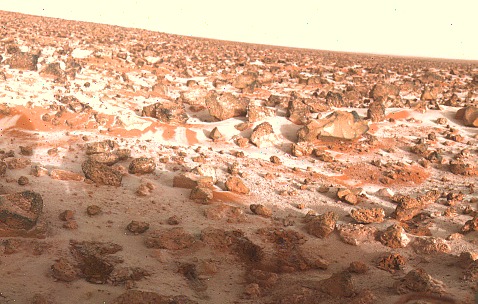
Frosts on Mars - this photograph from Viking 2 is mildly enhanced to bring out the colour of the frost. These often form at night when the air gets so cold that even in the Martian "tropics", carbon dioxide freezes out as dry ice for 200 days of the 687 day long Mars year, carrying water with it as ice. In the day time on Mars the temperatures can get well above zero at times, so there are large day to night swings in temperature which would make it harder to maintain a steady temperature inside a greenhouse.
You might think that the thin carbon dioxide atmosphere of Mars is an advantage, but plants only need trace amounts in the atmosphere (we have less than 0.04%). A habitat will have only a few kilograms of carbon dioxide total in its atmosphere. Actually, if an astronaut gardener can grow enough crops to eat, the people eating the crops exhale enough carbon dioxide for the next generation of crops. While if they don't grow all their own food, the carbon dioxide builds up and needs to be scrubbed. So carbon dioxide is not likely to be much of an asset for greenhouse construction. It's far more likely to be a problem gas to scrub from the atmosphere of a space habitat, and indeed that's been the situation in all the spacecraft and space stations built to date.
Also the atmospheric pressure from the thin Mars atmosphere makes almost no difference to greenhouse construction. Even if your greenhouse is pressurized to the minimum pressure usually suggested for greenhouses in space, of 10% of Earth's atmosphere, so that you can go into it without the moisture lining your lungs boiling, the Mars atmospheric pressure doesn't help much. It still has to withstand nearly a ton of outwards pressure per square meter on the walls of the greenhouse, not much different from the situation on the Moon.
So, greenhouses on both Mars or the Moon are likely to be dome shaped to hold in the immense outwards pressure of the atmosphere inside. For more on this, with the calculations, see Greenhouse construction - comparison of the Moon and Mars in Case for Moon First
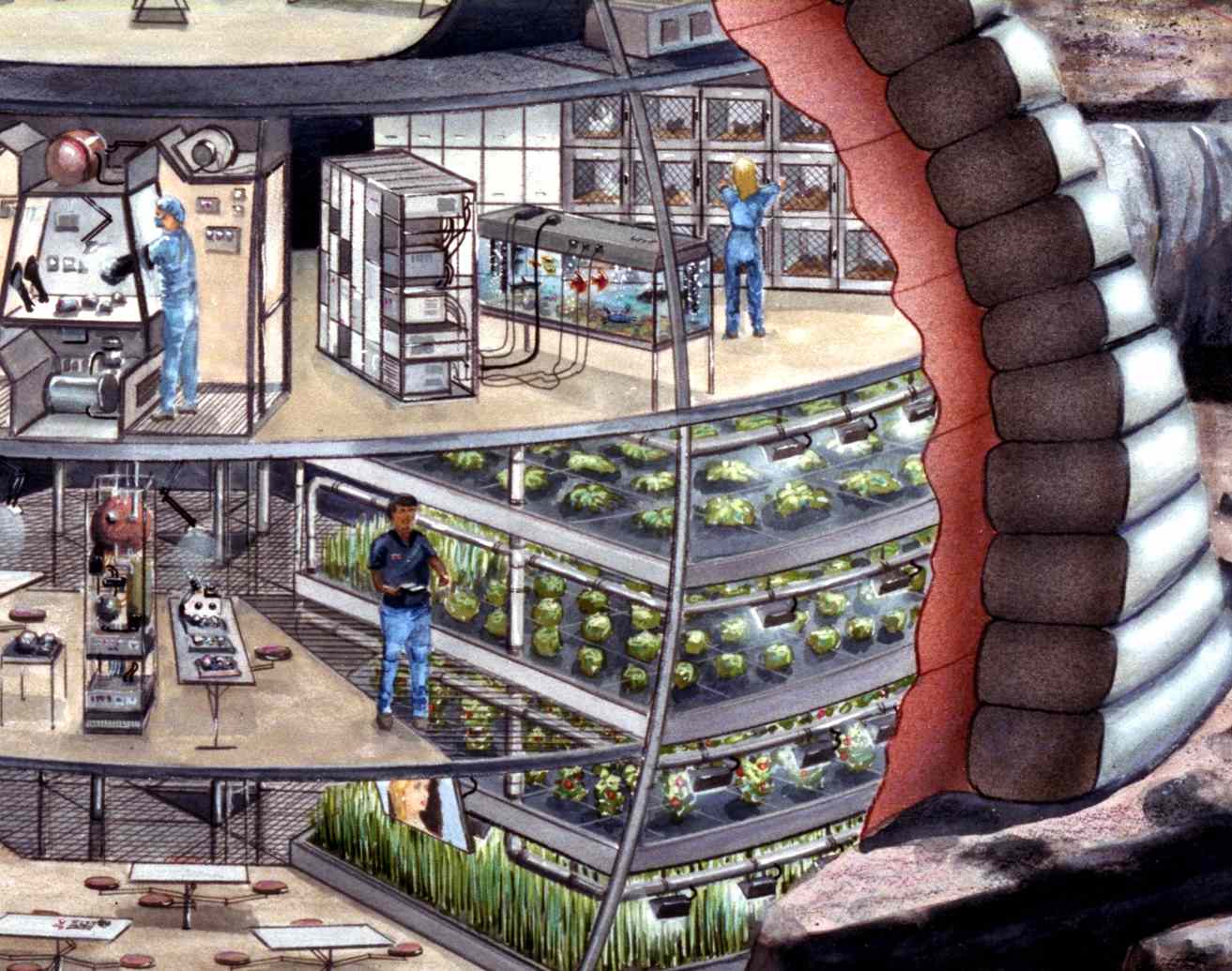
Detail of lunar colony showing a greenhouse inside a base. Detail from image from NASA, 1989. This was for the Lunar Oasis proposal for a ten year program to establish a self sufficient science outpost on the Moon to act as a test bed for space settlements.
If you build a greenhouse on the Moon or on Mars it has to withstand getting on for a ton per square meter of outwards pressure even at a tenth of an atmosphere. It might be easiest to just put it inside your habitat as shown here. It could be illuminated with efficient modern LED lights which require little by way of electricity and don't have problems of excess heat to get rid of. You could also pipe the light from the sun into the habitat using optical fibres connected to solar collectors
The Moon is a major challenge for gardeners too, it's no paradise. I'm not saying it is going to be easy there. It has no atmosphere at all, and apart from the polar regions, it has huge swings of temperature, and those two week long nights. But perhaps it can be made into a place to grow food more readily than Mars, especially if you can set up your garden in a habitat or greenhouse on the sunlit summits of the peaks of almost eternal sunlight at its poles.
The lunar caves also work out well compared to Mars, as we'll see. They have a constant temperature, actually a little warmer than the sunlit summits, at -20° C. Again, at those temperatures, it would be easy to warm up a lunar cave habitat or greenhouse enough for plants, if it is well insulated, as it would be. The night time darkness is the main problem with the caves, but as it turns out, its two weeks long night is not nearly as problematic for plants as you might think. That's the result of some rather surprising experiments with wheat, beet etc done by the Russians, and advances in LED technology.
We now know that the moon has water ice and other volatiles at the poles,. so there may well be plenty of water there for gardening. It is in darkness, and so can't be photographed from orbit, and the two main ways of detecting it from orbit (radar and reduced levels of neutron emissions) come up with different answers. We don't know for sure where it came from either (though comet impacts might be a good guess). But some think it is up to two meters thick layers of ice, and if so it may be easy to extract, with possibly hundreds of millions of tons, or a billion tons of them enough water for everyone in a city of a million to have the equivalent of an Olympic swimming lane filled with water.
The Moon is very different from Earth with its month long "day". But it has another difference which makes all the difference to the polar regions . Unlike Earth and Mars which have an axial tilt of over twenty degrees, the Moon has a tilt of only a bit over 1 degree ( 1.5424°). It's remarkable that the Moon's axis is so vertical.
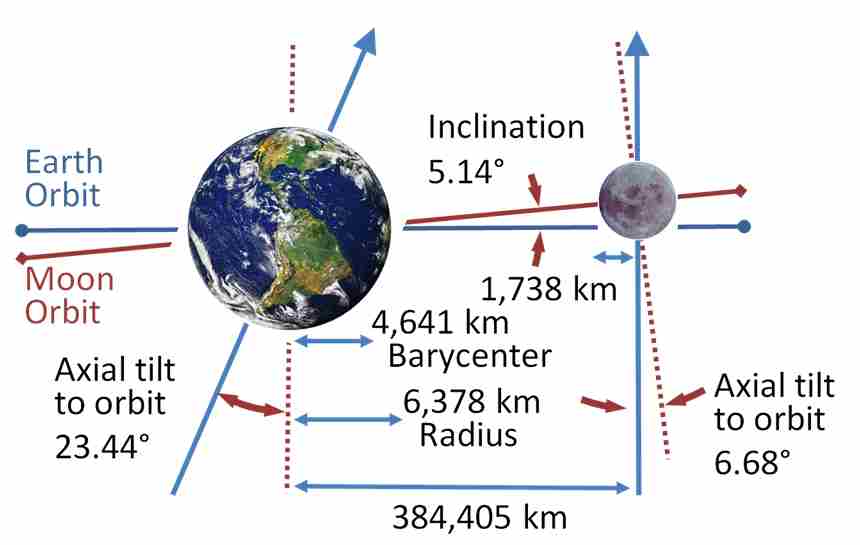
Diagram from NASA. With the Moon's orbit tilted by 5.14°, Earth tilted by 23.4°, yet the Moon's axis is pretty much vertical, only tilted by 1.5424° to the ecliptic (the apparent path of the sun through the sky). This remarkable coincidence is the reason the Moon's poles are so habitable.
Earth has seasons because of its axial tilt of around 23.4° at present (varies slightly by around one degree or so between 22° 2′ 33″ and 24° 30′ 16″ with a period of 41.040 years).
As a result, the Moon has no seasons, and you get points at the poles in almost constant sunlight, the peaks of eternal night. Habitats in those sunny spots can be kept warm just using solar collectors. Right next to them are permanently shaded craters that haven't seen sunlight for billions of years. There's indirect evidence that they may trap millions of tons of water, ammonia and carbon dioxide, possibly the results of comet impacts on the Moon.
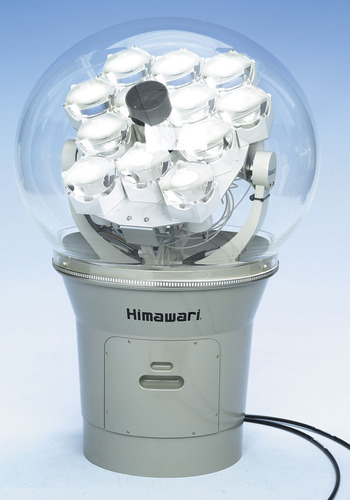
Hamiwari sun tracking solar collector - the light is collected, focused and sent through fiber optics to the interior of the spacecraft or habitat, where it can be used as a light source for algae or growing crops, or to help keep it warm. For details of how this would work for spacecraft, see page 319 of Peter Eckart's book: Spacecraft Life Support and Biospherics.
Solar collectors like this could be used to pipe sunlight into a polar base, or into cave habitats or greenhouses
See peaks of (almost) eternal light in the online NASA astrobiology magazine).
When you are at the lunar poles, it's like a perpetual Arctic or Antarctic equinox, with the sun skimming the horizon, seeming to circle around you once every 28 days. This makes it easy to mount solar photovoltaic panels and solar collectors, to follow the sun and get maximum solar power. They just need to be mounted vertically, and turned slowly once a month.
Even though the "peaks of (almost) eternal light" experience nearly continuous sunlight, they do go dark during eclipses. Also depending on the local topography, they have periods of darkness of several days at a time.
One way to deal with this is to raise the fibre optics solar collectors and solar photovoltaic panels on towers.
This idea goes back at least to 1990. If the Moon was a perfect sphere, then you would be able to achieve sunlight 24/7 (except during eclipses) with a tower 622 meters high.
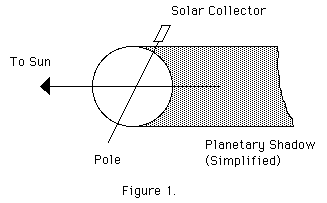
Figure 1 from Arnold Reinhold's paper
See the section Description of idea in this paper A Solar Powered Station at a Lunar Pole by Arnold Reinhold. That's a major construction project but it would be easier to build on the Moon.
However the Moon isn't perfectly spherical of course, and the peaks of (almost) eternal light are quite high already. So your tower wouldn't need to be as tall as that. As it turns out, you can make quite a difference with a tower only 10 or 20 meters high.

This figure shows the difference it makes to put the solar collectors or solar panels on a pole 10 meters high and then 20 meters high, to raise them above nearby obstacles, from this paper.
With the best location in this paper, near the South pole (see page 1077), a mast 10 meters high increased the average solar visibility from 92.66 to 95.83, and reduces the number of days of darkness in the year from 26 down to 15. So it can make quite a difference.
Another approach is to find points close to each other such that one is in daylight when the other is in darkness. You can then route power from one to the other via a power line, or you can transmit the power using microwaves or lasers. One example here, page 9 two points 12 km apart, together have sunlight 97% of the year. Another example here, points A and B 10 km apart on page 562, figure 6b - B is illuminated for 82% of the year but when you combine it with A, then the result is illuminated 94% of the year.
This is another example
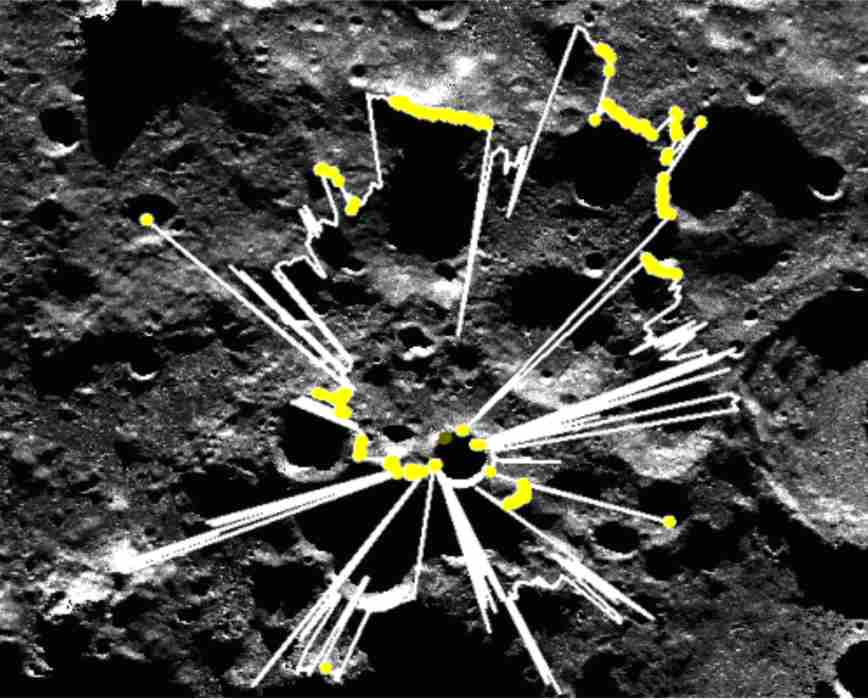
The white lines here show the local horizon as seen from this site in the South pole area on the Shackleton rim, and the yellow regions show the parts of the horizon that block the sun (less than 50% illuminated) on the worst day of the year. (Figure 11, page 16, explanation on page 6 of this paper). As you can see, many of the features that block the light are close to the site itself. Based on the analysis in the paper, this site needs a fast recharge power supply for a maximum of 62 hours or about two and a half days. With a coarser plot, the result was 156 hours, which shows how much a difference the local terrain makes. The results need to be validated against more independent images.
This is work in progress, as results are sensitive to details of the local topography, and the field is changing a lot with new high resolution data. We could do with even better elevation mapping of the poles.
So, the actual figures here might change as we learn more, but the basic idea is clear, that solar collectors on quite a short mast of 10 meters can often significantly reduce the length of the longest period of darkness and that it can also be reduced by using several collectors a few kilometers apart and transmitting power from one to the other.
I haven't found any papers about this yet, so will just describe the issues. If you know of good citations do say. So, the thing is that shadows on the Moon are so very dark, that it's hard to see any features in them. Apollo 11 had to land during a narrow time window of sixteen hours every 29.5 days, so that they could see the lunar features during the descent flight path to the Moon. They could only land when the sun was at an elevation of between 5° to 14°. Too high and the sun would be directly behind them so that they couldn't make out any shadows at all, the landscape would be "washed out". Too low and most of the landscape would be shadowed.
The sun angle at the poles would be far lower, from 0° to around 1.5°, which would probably make it hard to impossible to do an Apollo style visual landing. Most of the landscape would be hidden by the long shadows of boulders, at ground level. We don't need to worry so much about the landing with modern technology and detailed 3D maps of the Moon, but the long shadows have other problems.
It will be hard to just walk around outside the base without artificial light. Although you would be walking in full sunlight, most of the ground at your feet would be in pitch darkness. There'd be some scattered light from the brighter pats of the landscape, but the bright landscape will also stop your eyes from dark adapting, so you won't see much in the darkness. So I think you will need bright lights to shine into the shadows to walk anywhere around the base. I don't see this as much of an issue, but it is something to think about.
Another problem is that if you park a rover next to the habitat, then at certain times of the lunar month, the rover will block the sunlight. It's the same for anything else you park or any structure you put up next to the village. The habitats will block each other as well.
So - this is just a suggestion, but I wonder if it would work best to have a multi-level village? Some of the habitats could be raised on legs above the landscape rather like Belgium's first ever "zero emissions" Antarctic base, the Princess Elisabeth Antarctic Station,
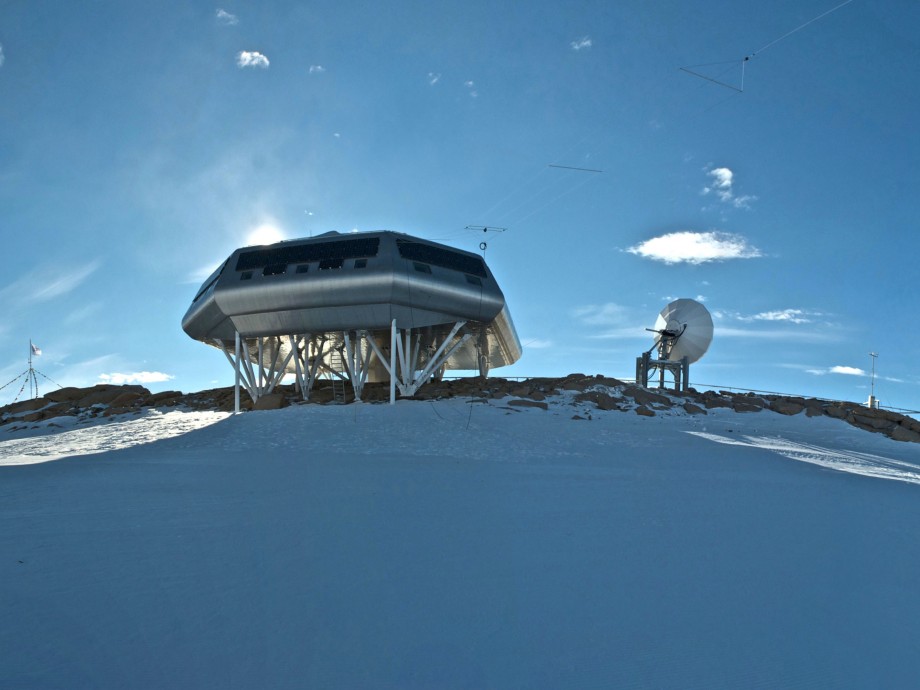
You could park your rovers beneath it. You could also have ramps or lifts to get down to the ground level from above. Of course it would have to be more rounded than this one.
The habitats could also be at slightly different layers and if you had a greenhouse, it could be at the top, center, a few meters above everyone else. The solar panels and solar collectors would be much higher on five or ten meter posts to avoid local relief, so they would not be affected.
Often it's as much of a problem to keep a space habitat cool as to keep it warm. The ISS has large heat rejecting panels, six of them, each able to reject at least 11.8 kilowatts of excess heat from the ISS. (See also "Explore the Space Station" with the radiators labeled)
This is another advantage of the lunar poles is that it's really easy to design heat radiators. You just need to set the radiators flat on the ground, and then the sun will only ever catch them edge on. They are already in the optimum position for heat rejection, with no need for the radiators to move. (See page 584 of this paper).
It's harder to do this at lower latitudes. One approach is to use heat pumps to increase the temperature to the point where the heat can radiate easily even in the lunar day. Or the heat rejection radiators can be shaded so that they remain cool. Or you can use a combination of both approaches.
The easiest way to grow plants for food in space is to use soilless gardening with hydroponic solutions or with aeroponics where plants are grown with roots suspended in a fine mist (uses much less water).
This leads to huge savings in the precious area you need to grow crops. You don't need an acre of farmland per person as you do for conventional agriculture (4000 square meters approximately). In the BIOS-3 experiments, the Russians showed that you can grow all your food with only 30 square meters of growing area per person. The crops were grown on a culture conveyor with 2 to 10 plantings of different ages simultaneously. They grew wheat, sedge-nut, beet, carrots, and other crops, ten crops in total. With those 30 square meters per person, they produced 95% of the daily requirement for oxygen, water, food and everything else (by weight). The remaining 5% consisted of animal products, salt for the humans, nutrients for plants and personal hygiene supplies. They could produce 45% of the food and nearly all the oxygen and water with only 13 square meters.
For details see Sending humans to Mars for flyby or orbital missions - comparison of biologically closed systems with ISS type mechanical recycling (also relevant to long duration lunar missions). So early stages of agriculture on the Moon are sure to use more intensive methods such as this.
Soil based gardening can also be used with the methods of biointensive mini gardening. By using good gardening practices and by careful choice of crops you can grow all the food for one person in 4,000 square feet, about 372 square meters, or less than a tenth of an acre. That's intermediate between conventional agriculture and the conveyor belt type system of BIOS-3.

Grow biointensive - sustainable mini farming - this method needs only 372 square meters of growing area per person.
We can get an idea of how efficient these methods are by working out the total land area needed to feed the world on a vegetarian diet by all the methods. With a million square meters to a square kilometer, then we just need to multiply the numbers by 7,500 to get the area in square kilometers needed to feed a population of 7.5 billion. We get
By comparison, the Sahara desert is 9.2 million km². With the BIOS-3 system, we would need only 2.5% of the Sahara desert to feed the world and provide 95% of all that they need to survive. The total land area of the Earth is 148 million km². But of course much of that is desert, mountains, ice etc, some is uncultivated and animals require more land area than plants.
The surface area of the Moon is 38 million square kilometers. Indeed, a medium sized lunar crater 535 km across has sufficient land area to feed the whole world using the BIOS-3 system if you had the materials to cover it with greenhouses and enough air and water to produce growing conditions inside all those greenhouses. Mare Imbrium with a diameter of 1146 km has enough surface area to feed the world four times over.
Early experiments involving adding lunar material to hydroponic solutions suggested that the lunar soil was very fertile indeed as the plant growth was enhanced.
However later research suggested that the reason for this was a deficiency of trace elements in the hydroponics solutions used and that the plants were equally stimulated by some terrestrial soils.
A recent experiment using lunar soil simulants instead of the lunar regolith itself, and growing the plants in them directly found that the soil was not particularly good for plants, and that Mars simulants were better. However the Mars simulant contained trace amounts of organics and also held water better than the lunar simulant. Also heavy metals are an issue for Mars soil (they could not eat the results of their experiments because of the possibility of heavy metal concentration) as also is the case for the Moon.
None of this simulates the situation of gardening on the Moon or Mars using the soil itself as that would involve composting the residues of the first generation plants with micro-organisms to make a good top soil. You can't really expect plants to grow well directly in ground up rock without topsoil. Even after a single cycle of composting the residues, the result could be much more fertile.
Experiments with material from Apollo 16 showed that cabbage seedlings accumulated high concentrations of aluminium. Other experiments by Kozyrovska et al show that marigolds grown in terrestrial anorthosite accumulated heavy metals such as zinc, iron, nickel and chromium (lunar anorthosite forms the light areas on the Moon).
However when the marigolds were grown in a community of microorganisms in a model plant microcosm, this protected the marigolds against toxic doses of the heavy metals and also helped deliver essential nutrients to the plants.

Marigold flowers (tagetes patula) photo by Dori - when grown in terrestrial anorthosite (a type of mineral common on the moon) they accumulated heavy metals. However when grown with a community of microorganisms, this protected them against the heavy metals and helped to deliver essential nutrients to the plants.
Kozyrovska et al write:
"Our idea was to use the lunar soil for the pioneer plant growth and to convert the resulting plant biomass into so called protosoil, utilizing an optimized consortium of microorganisms."
Their experiments were promising. See Bioaugmentation in growing plants for lunar bases. The toxic heavy metals seem to be a surmountable issue. Another approach suggested by Haisong Liu et al. is to supply soil, and even seedlings, from Earth to get the process off to a quick start.
I'd like to suggest another idea here. Since hydroponics work well in the BIOS-3 experiments, one could also start by growing the first generation of plants hydroponically. Then you could use the plant residues to inoculate the lunar soil with organic material along with beneficial bacteria.
Also after whatever method is used for the first areas of good top soil on the Moon, the soil itself can then be used to inoculate larger areas of lunar soil with some of the top soil created earlier. The same methods could of course also be used on Mars, and Mars also has heavy metals in its soil. So in this comparison the two come out roughly equal.
Wherever we grow our plants, we just possibly might grow the tastiest chocolate in the universe.
We can only see a few meters into the lunar caves from the surface, so we don’t know how far they extend, especially since the regions near the pits are probably partly filled in with debris as well. But they could be huge; potentially they can be large enough to fit in a large city, the size of Philadelphia, with space to spare
Lava tube caves on the Moon could be stable up to five kilometers wide in the lower gravity. The black silhouette here shows the city of Philadelphia superimposed in one of these suggested tubes. We know there are rills on Mars this wide and can see cave entrances into them on the surface, in photographs taken from orbit, but we can't see far into them so don't know how large the caves are yet. These huge lava tube caves may have been detected indirectly though, through gravitational anomalies in the Grail spacecraft measurements: Scientists May Have Spotted Buried Lava Tubes on the Moon - see also Grail data points to possible lava tubes on the moon.
Such huge caves are only possible because of the low lunar gravity, as they would collapse on Earth. Similar caves on Earth are far smaller as would be any similar caves on Mars. We don't know for sure if such large caves do exist, but it does have many cave entrances photographed from orbit, which proves that at the least, it has caves with entrances similar in size to Earth cave entrances. Then the extensive systems of rills and the Grail data are suggestive of larger caves to be discovered.
Some of the possible lava tube gravitational signatures are over 100 kilometers long and several kilometers wide. If the Moon does indeed have caves 100 km long and kilometers wide, that's similar in size to the O'Neil cylinder space habitat with a land area of several hundred square miles (the O'Neil cylinder consists of a pair of cylinders, each 20 miles long and 4 miles in diameter, with total land area 500 square miles).
Each such cave could house several million people. This may be a long shot, but isn't it amazing, to think that the Moon could have caves as vast as this, similar in size to an O'Neil cylinder, and we simply wouldn't know yet?
The Lacus Mortis area has possible volcanic cinder cones, as well as the more common shield volcano features, rilles, and a partially collapsed cave entrance with a gentle slope leading into it. This is the destination for the Astrobiotics mission in 2014.
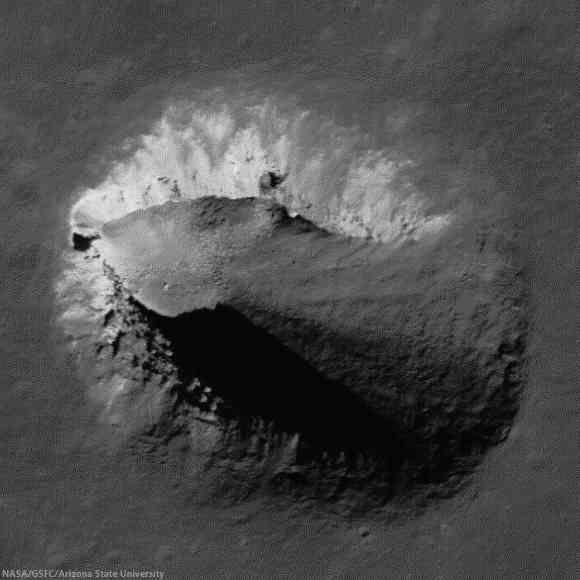
Partially collapsed "skylight" in the Lacus Mortis region of the Moon. Photos of the Lacus Mortis pit from various angles were used to build a 3D model of the pit, assuming that it is a cave entrance.
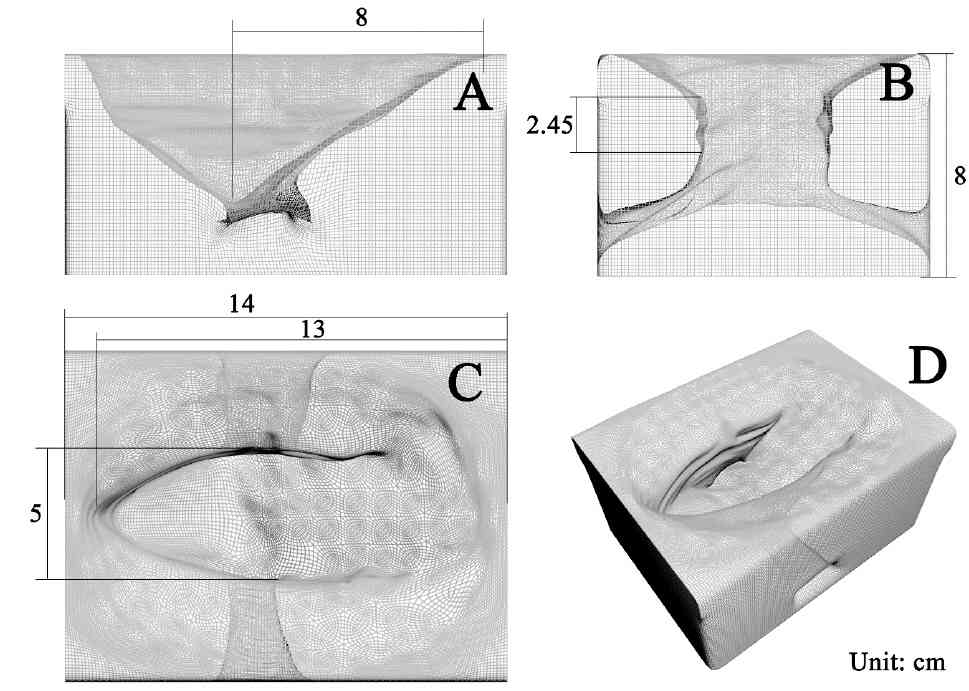
3D model shown from various angles. The cave was assumed to be oval shaped as a result of fill by debris form the collapse. It may be a shallow slope down into a lava tube type cave shown at bottom right. If it's a lava tube cave, it should widen out to a circular cross section further from the entrance.
Another interesting pit is the Marius Hills pit entrance, original destination for the astrobiotics lander now due to land on the Moon some time in 2017:

The "skylight" on Marius hills (see page 7) was the original objective for the astrobiotics Skylight mission as envisioned in 2013 - it may be an entrance to a much larger lunar cave as it is located on a lunar rille. It's about 40 meters deep The crispness of the landform suggests the collapse happened less than a billion years ago, and the lack of any raised rim or eject suggests it formed through collapse, not through a meteorite impact.

This image shows an oblique view. It's viewed from an angle of 45 degrees, and the light from the sun is at an angle of 34 degrees from the vertical. As a result they were able to confirm that the area of the floor illuminated in this image continues at least twelve meters under the overhang. Papers here, and here .
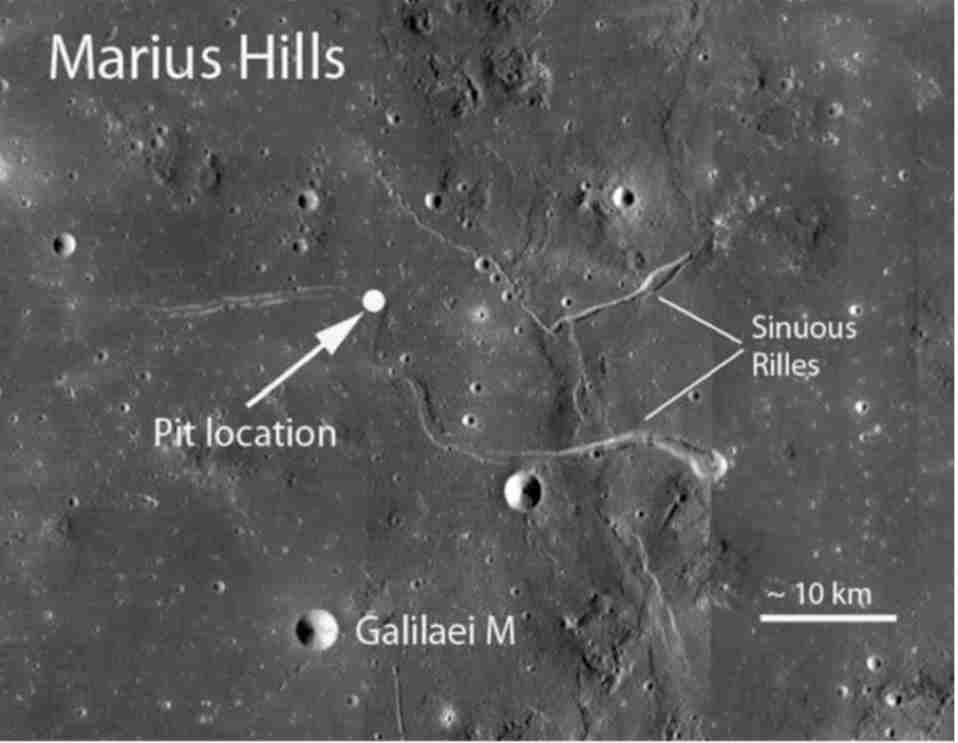
This shows the location of the Marius pit along a lunar rille. Image from page 5 of Exploration of Planetary Skylights and Tunnels
Another "honorable mention" goes to the region of King crater, which is of special interest for its remarkable natural bridge.
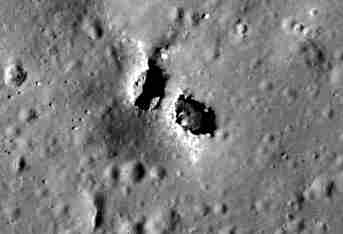
Lunar natural bridge feature King Y, probably caused by a double collapse. It's about 7 meters in width and a 20 meters walk to cross it.
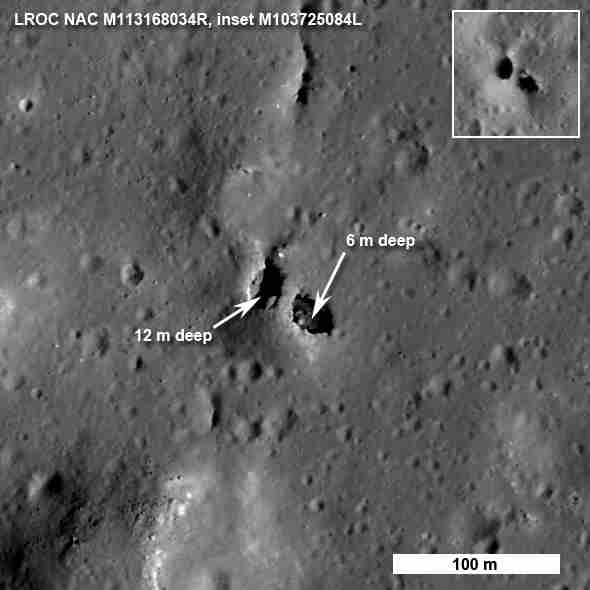
The lunar caves may also have unusual minerals that formed as the lava that created the cave slowly cooled and differentiated.
The NASA PERISCOPE project, currently a phase II concept study, could potentially give us a way to see into lunar caves from orbit using femtosecond laser photography which lets you "see around corners" to parts of the cave that were never within the line of sight of the orbiter.
We may may get our first views into the interior of a lunar cave from ground level some time in 2017, with the Japanese Hayuto Lunar X prize contender Moonraker, which will explore the Lacus Mortis pit "skylight" and then lower its two wheeled rover Tetris into the pit . For details of this mission, see Robotic missions to the Moon, already planned, or near future, from 2017 onwards.
So, another place we can set up a base is in a lunar cave. See for instance, Technologies Enabling Exploration of Skylights, Lava Tubes and Caves (from 2011). Advantages of the caves include:
Everything else is great, but the long 14 day lunar night is an issue, unless the cave happens to be right at the poles of the Moon close to the peaks of eternal light - or we dig a huge artificial cave there. However it is easier to cope with a 14 day lunar night than you might think.
It's also possible to deal with the lunar night by reducing the temperature of the plants from 24 °C in the lunar day to 2.5-3 °C in the lunar night (which helps maintain plant vitality during darkness). This was tested in an experiment by the Russians for BIOS-3. Of the ten crops tested, most were able to cope with this regime. The ones that couldn't cope were tomatoes, sedge nuts, and cucumbers. Wheat, barley, peas, turnips, dill, carrots, beet and radish were all able to survive a simulated repeated 14 day lunar night. The edible crops were reduced 30-50%. The most promising ones were carrots (73.5% yield), Beet (yield actually increased to 122%), turnip (57%), dill (72%), and radish (61.5% yield). See table 3 here (I've converted the figures to percentages).
So if you use that approach you'd need up to double the growing area, or around 60 square meters (probably a fair bit less depending on the mix of crops), but would be able to use natural sunlight during the lunar day, so would not need to supply light to the crops during the lunar night at all.

"Wheat plants of various ages showing the "conveyor" approach that was used in the Bios experiments, Young wheat plants are in the foreground, with more mature plants toward the back." Photo from here
In the BIOS-3 experiments they found that Wheat, barley, peas, turnips, dill, carrots, beet and radish were all able to survive a simulated repeated 14 day lunar night and produce reasonable crops of 50 - 70% of the crops achieved with full sunlight. The trick was to reduce the temperature from 24 °C in the lunar day to 2.5-3 °C in the lunar night (which helps maintain plant vitality during darkness)
You could also have a mixed regime, supplying light during the lunar night only to the plants that require it, such as tomatoes, cucumbers, etc, perhaps also extending it to the plants that most benefit from light during the lunar night (for instance, on those figures, the radishes and turnips would benefit most).
We will surely just bring air from Earth to start with, since it's only a small amount of the launch mass, only 0.26% in the case of the atmosphere in the ISS (not including stored nitrogen). For details, see the Nitrogen section below. But later on, if we have thousands or even millions living on the Moon, perhaps we might want to fill the entirety of a large cave with air. A cubic kilometer of air weighs 1.225 million tons, which is a lot of nitrogen to find somehow. Could we source it on the Moon? This is for a fair way into the future of course, but let's try to get a rough estimate of whether it is possible.
Let's try a cave 250 meters in diameter, and 100 km long, a medium sized lunar cave (if the Moon does have caves as large as the Grail data and modeling suggests), but huge for Earth. That's 4.9 cubic kilometers of air, so 6 million tons of atmosphere using our 1.225 million tons per cubic kilometer figure (1.225*PI*(0.25/2)^2*100).
That much nitrogen could be sourced on the Moon, using lunar railways to truck it from the poles, if they do have and 600 million tons of volatiles, and 6% nitrogen for a total of 25 million tons of nitrogen. Typical heavy trains on Earth can carry 20,000 tons upwards. So if we had their like on the Moon that would be 300 train trips to fill the cave using volatiles from the poles.
You could also fill the cave pressurized to a tenth of Earth normal, which is enough to grow crops and for humans to walk around using only an oxygen mask, and then have pressurized habitats and greenhouses and parks within it at Earth normal pressure. If you do it that way, you need 600,000 tons of atmosphere for our cave 250 meters in diameter and 100 kilometers long, requiring about 30 trips of a heavy goods vehicle to truck the volatiles from the lunar poles to the cave.
Also, we can do another calculation based on the 225,000 km² needed to feed the population of the Earth on a basically vegetarian diet with the BIOS-3 system. If that area was covered with greenhouses, typical height say 2 meters, that's 550 cubic kilometers which at a mass of 1.225 million tons per cubic kilometer is around 674 million tons. If we pressurized the greenhouses at a tenth of Earth normal, that would be 67.4 million tons. There'd be enough water too, if we use aeroponics. So, if there are 25 million tons of nitrogen at the poles, the Moon may have enough by way of volatiles to fill greenhouses sufficient to feed 2.78 billion people or 37% of the Earth's population using the BIOS-3 system with greenhouses pressurized to a tenth of Earth normal - that's 9 kg of nitrogen per person.
That doesn't include the carbon dioxide for growing food. As we will see in CO2 on the Moon, if you supply enough carbon dioxide to bring the first crop to maturity without astronauts there (so you don't have to feed them), you need about 40 kg of CO2 per astronaut for the first crop, assuming it takes 40 days for the crop to reach maturity. After that, carbon dioxide becomes a nuisance gas to be removed if you need to import food.
If there are twelve million tons of carbon dioxide at the poles, that's enough for 300 million people on the Moon.
However this might not even be needed at all. If you are sending astronauts to the Moon anyway, and have to send habitats for them, you can surely manage to find the extra 40 kilograms per person for the carbon dioxide and what's more the extra 9 kg of nitrogen per person, or 90 kg if you pressurize the greenhouses to Earth normal. Each person would need at most twice their own weight in volatiles even with all the greenhouses pressurized to Earth normal.
So I don't think that need to provide an atmosphere is a deal breaker for colonization.
Of course I'm not suggesting we colonize the Moon with nearly three billion people, but it does show that the Moon has a fair bit of potential for gardening just using indigenous resources.
So, yes, we could fill some of the medium sized caves in their entirety in this way (depending on what we find by way of volatiles there).
However, eventually if we had millions living on the Moon and wished to fill all the lunar caves with nitrogen and oxygen, and if some are as large as 5 km diameter and 100 km long, then you have the same problem as you have with an O'Neil cylinder, that in such a large space, the mass of the atmosphere dominates, and nitrogen is in short supply in the inner solar system, apart from on Earth and Venus.
For a cave as large as that, 5 km across and 100 km long, you would need 1.225*PI*2^2*100 million tons = 1.54 billion tons of volatiles, most of that nitrogen. Perhaps you could get it from comets, but they have only around 0.5% NH3 or so (hard to estimate). Perhaps it can be exported from Earth if transport costs go down hugely? Or perhaps you would build domed cities and air filled tunnels on the floors of the caves much as you would do it on the surface, and keep them in vacuum conditions. The reason for building in caves then would be for the protection from cosmic radiation, and micrometeorites and more stable thermal environment.
Anyway - that's for the distant future. It's clear we are not going to run out of volatiles on the Moon any time soon, so long as the volatiles are indeed abundant and easy to mine and transport.
Lights would be needed in the caves or anywhere on the Moon except the poles, during the long 14 day lunar nights. They would be needed on the poles too, for a few days of the year. But they would also be needed for plants on Mars, during the dust storms, which block out 99% of the sunlight, often for weeks on end.
This used to be a major issue, because the lights for growing plants would consume a lot of the power of a space habitat with a greenhouse. But it's not a big issue any more. This is something that has changed a lot recently with the invention of LED lights optimized to produce only the wavelengths of light needed for crops. You need about 100 watts of supplied power for lighting for one square meter. That's 3 kW per person for 30 square meters. However you only need it for 12 hours a day for 14 days. That makes it a total of 504 kWh of storage needed per person to provide lighting for the lunar night.
One way or another you need a way to deal with the periods of darkness. For a detailed working out of power available and requirements for early stages of a lunar polar base (with Shackleton crater at the south pole as an example site for the base), including methods of transmission of the power, and storage on the Moon, see Power System Concepts for the Lunar Outpost.
The 500 kWh per colonist for growing plants during the lunar night corresponds to 750 kg of regenerative fuel cells per colonist. If you can use hydrogen electrolyzed from water during the day, it's more like 17 kg of hydrogen storage per colonist to last them through the lunar night, though that doesn't include the mass needed to store the hydrogen, separate it and recombine it. The ISS and Hubble both use nickel hydride batteries. A new type of battery of this type under development stores 140 kWh per kilogram, so if those were available, you would need about 3.5 kg of batteries per colonist.
This level of power is also just within the range you can supply continuously using standard RTGs - the radioisotope thermoelectric generators - as used for Curiosity, New Horizons, Cassini and many other deep space missions, though it does require a fair number of them. The 3 kWh peak power for plants during the day could be be supplied using 100 kg of plutonium 238 (at 3 watts per kg) or about 150 kg of Americium 241 per colonist. Each colonist has lunar night power requirements for growing crops equivalent to five Cassini spacecraft.
If we start with a lunar colony, as for the ESA village, then in the early days, for the first temporary visits to a polar colony on the Moon, astronauts could avoid the local lunar "winter" and could still be there most of an Earth year. Later you could put panels on several of the lunar peaks of almost eternal sunlight. You could use cables to transmit the power over a short range, and then microwaves or lasers for longer distances. Then the only periods without any solar power would be during the rare total lunar eclipses, requiring only hours of storage rather than days. In that way you would sort out the details of long term storage through the lunar night later on after you already have a fair bit of experience of living in the Moon.
For more on all this, see Power during the night in Case for Moon First,
The Moon is an ideal place to make solar panels, with a hard vacuum, abundant silicon, and the surface regolith can be turned to glass using microwaves as easily as you boil a kettle full of water (because of the pure iron imbedded throughout the regolith in the form of nanophase iron). You could have a solar panel paving robots that travel over the surface making solar panels on the surface using little more than the indigenous resources.
As metal refining takes off on the Moon, you could use HVDC for long distance transmission as is often done on Earth, and eventually have strips of solar panels all the way around the Moon - first at high latitudes and then at the equator too. Since solar panels can be made with indigenous resources and don't have to be shipped from Earth, and the solar panel construction can be automated, with plenty of real estate to cover with the panels, that leaves open the possibility that the Moon could export solar power to Earth in the future.
For more on this, see:
I'm not urging that we colonize either Mars or the Moon, especially not right away. Rather I would say that we are still at an early exploration stage like the first Antarctic explorers. The explorers need crops and gardens too, especially if they need to stay there for any length of time. But they aren't there to grow crops, and set up home, there's a difference.
Going into space is not an optimal way to create large habitable areas for humans in our solar system at present, as much of Earth is uninhabited. Of course some desert areas are of great ecological interest but there are plenty of places where the desert is not of especial interest, and where colonization would be beneficial.
These deserts on Earth are far easier to colonize than anywhere in space. And what's more, we can use similar techniques, set up enclosures in the desert that are far more habitable than the surrounding desert. We are actually doing this already in a small way, with the salt water greenhouses, so I think you can say that not only should we do it, but we already are. This is an Australian desert project. The sea water is used to make water through the sunlight in the desert, and cool down the greenhouses.
These ideas could be used to reverse desertification in the Sahara desert and other deserts. This is how it works:
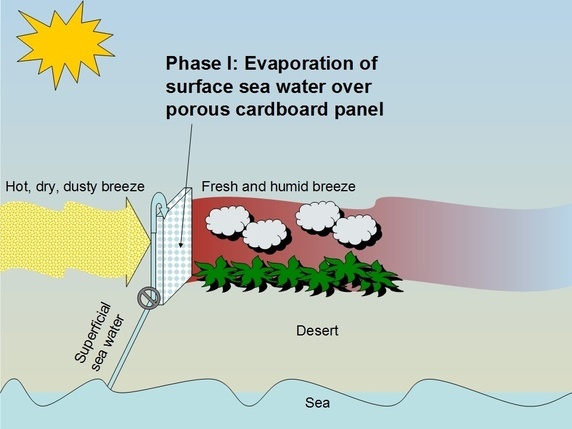
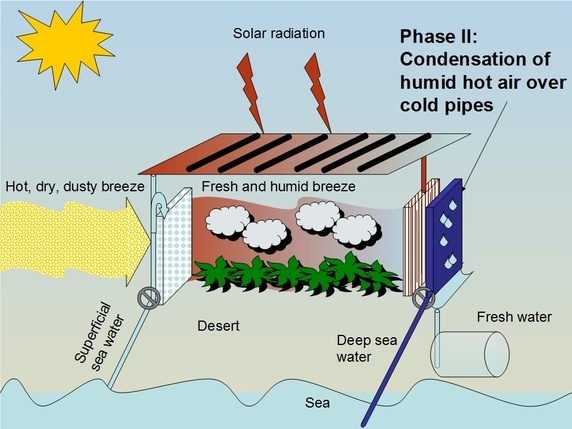
Diagrams by Raffa be from wikipedia
It not only lets you grow crops in the greenhouses - it can also help make the surrounding areas more habitable, so you’d get trees and crops growing in an area around the greenhouses as well. Doesn’t extract anything from desert aquifers, rather, it adds to them.
Sundrop farms have a large area set out for greenhouses like this now, in the middle of a desert, so this is taking off in a big way in Australia. Early days yet though.
This video just shows the greenhouses, and when they go inside in the video there is nothing growing there yet, not sure why, maybe it is a new installation, but it shows how it’s quite big in Australia.
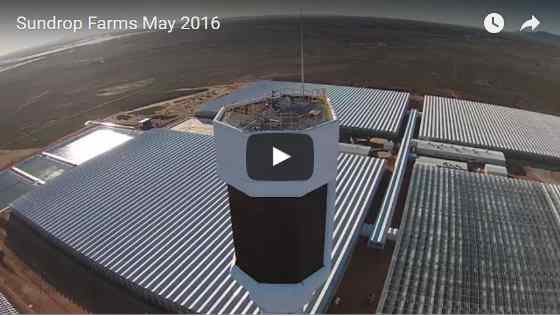
There are many countries working on reversing desertification Israel does a lot of reversing of desertification.
One of the worst areas of encroaching desertification is the southern edge of the Sahara desert. The first priority there is to stop the spreading desertification - then to reverse it. Many African countries are collaborating in the Great Green Wall project to plant a forest along the southern edge of the desert.
Then, there is a similar project underway there now to the Australian Sundrop farms, using seawater greenhouses.
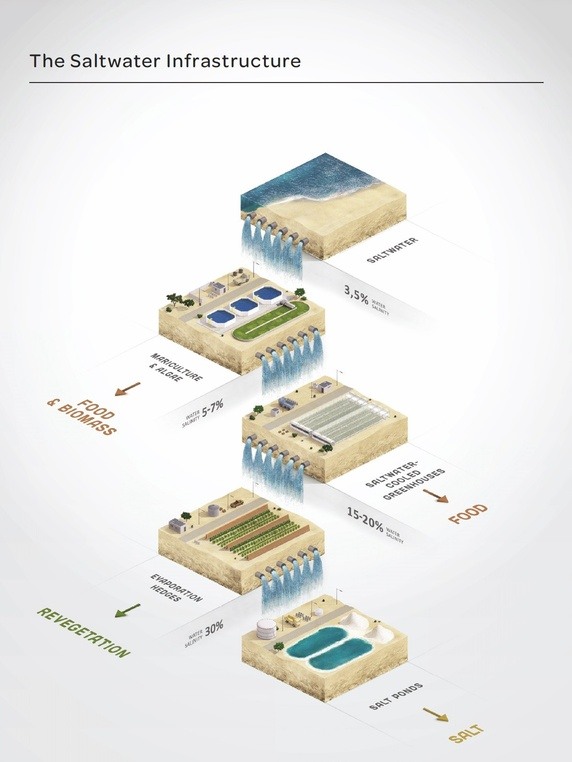
Technologies - Sahara Forest Project
This gives far more food and living space for the same amount of cost, compared with the billions of dollars to set up a few people in a space habitat. It's also far far easier to build a greenhouse in a desert on a planet with abundant sea water, and breathable air, than to do it on Mars. And as we just saw, with the BIOS-3 system, we would need only 2.5% of the Sahara desert to feed the world. So if we grew plants on Earth in as small an area as we could do for space habitats, we could feed the entire world easily with minimal impact, at least on the mainly vegetarian diet we would need for space colonies.
If we fill all the deserts, or you just don't have a handy desert in your country that's suitable for building on, you can build on the sea, This is still far easier than building in space. That's exactly what this couple did in Canada.
Off the Grid on a Homemade Island moored in the sea off the coast of Vancouver island in Canada. They estimate that the floating structure weighs 500 tons and everything was constructed using a handsaw and hammer without use of power tools.
Imagine how hard it would have been for them to do this on the Moon or on Mars, with a vacuum or near vacuum, having to generate oxygen, scrub the air of noxious gases, somehow get hold of $2 million spacesuits, just to get outside of their door, protect themselves from the cosmic radiation and solar storms, and micrometeorites, somehow hold in the pressure of ten tons of atmosphere per square meter, never mind the difficulty of somehow getting everything there. They wouldn't be able to do it with a handsaw and hammer, for sure.
And actually, there is an idea of floating sea cities, a similar idea to the desert projects, but now just floating in the sea. This is at a much earlier stage, more of a paper project at present. Still it is very similar to the Mars or Moon colony ideas, but much easier to do and floating on the sea.
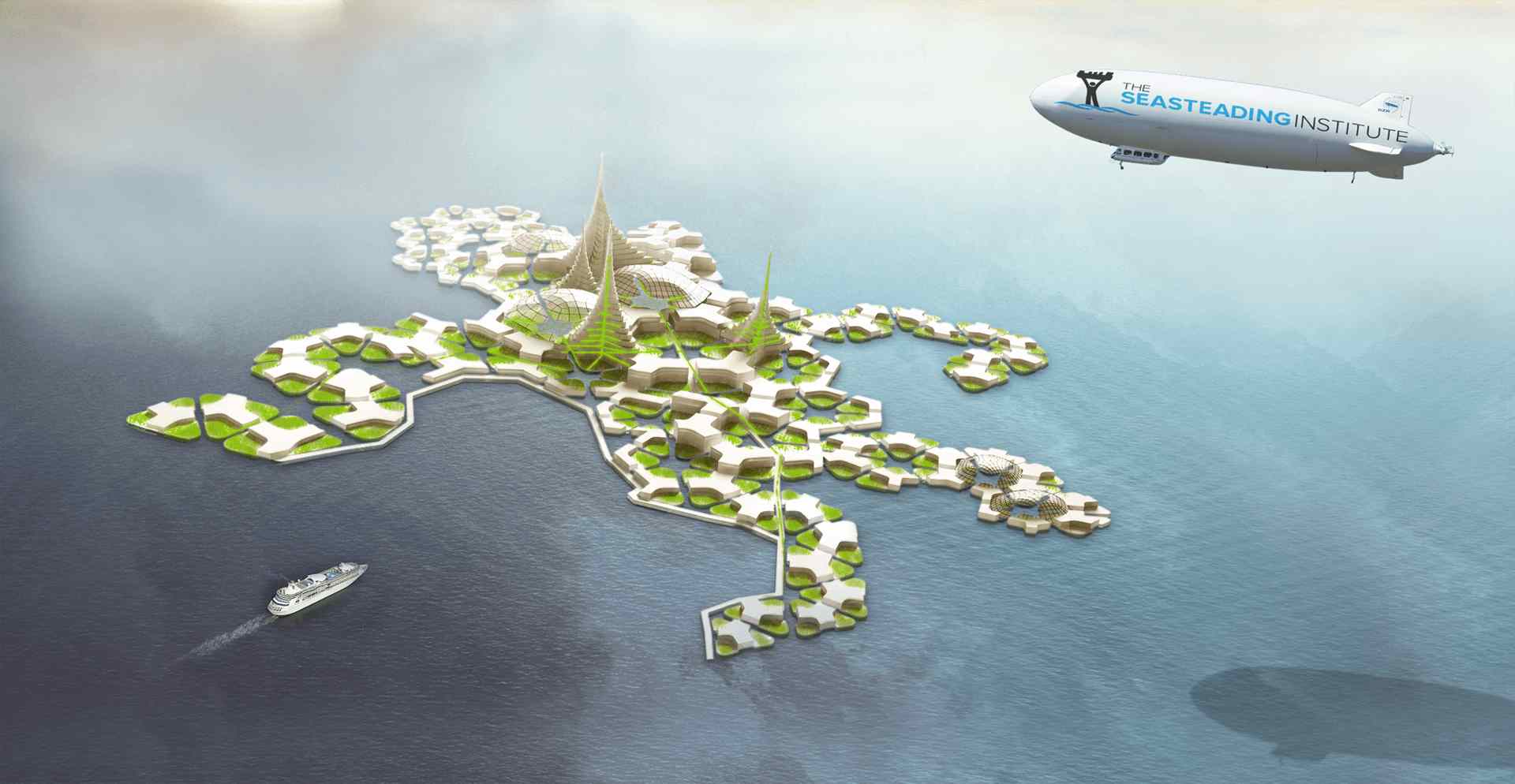
The Seasteading Institute | Opening humanity's next frontier
We could have sea cities covering much of the seas if we really need more space for people to live. If self sustaining colonies are indeed possible on the Moon and on Mars, as experiments so far seem to suggest, they would certainly be possible and much easier to construct, floating in the sea. If the 3D printing technology works for space habitats, to make them self sustaining with minimal imports, think how much better they will work on Earth!
By a sea colony here, I mean one that only uses the sea water and the air, with a few imports from Earth - as that would be the equivalent of a Mars habitat. There'd be no need for fishing or anything else, just air, and sea water, and the materials to build the original city, and some imports, and if advocates are right about Mars colonies, there would be little by way of those too.
Four fifths of the surface of our planet is ocean, so if we could live on the sea, in more or less self contained habitats, as with the ideas for Mars, that's be like finding four new planets to live on.
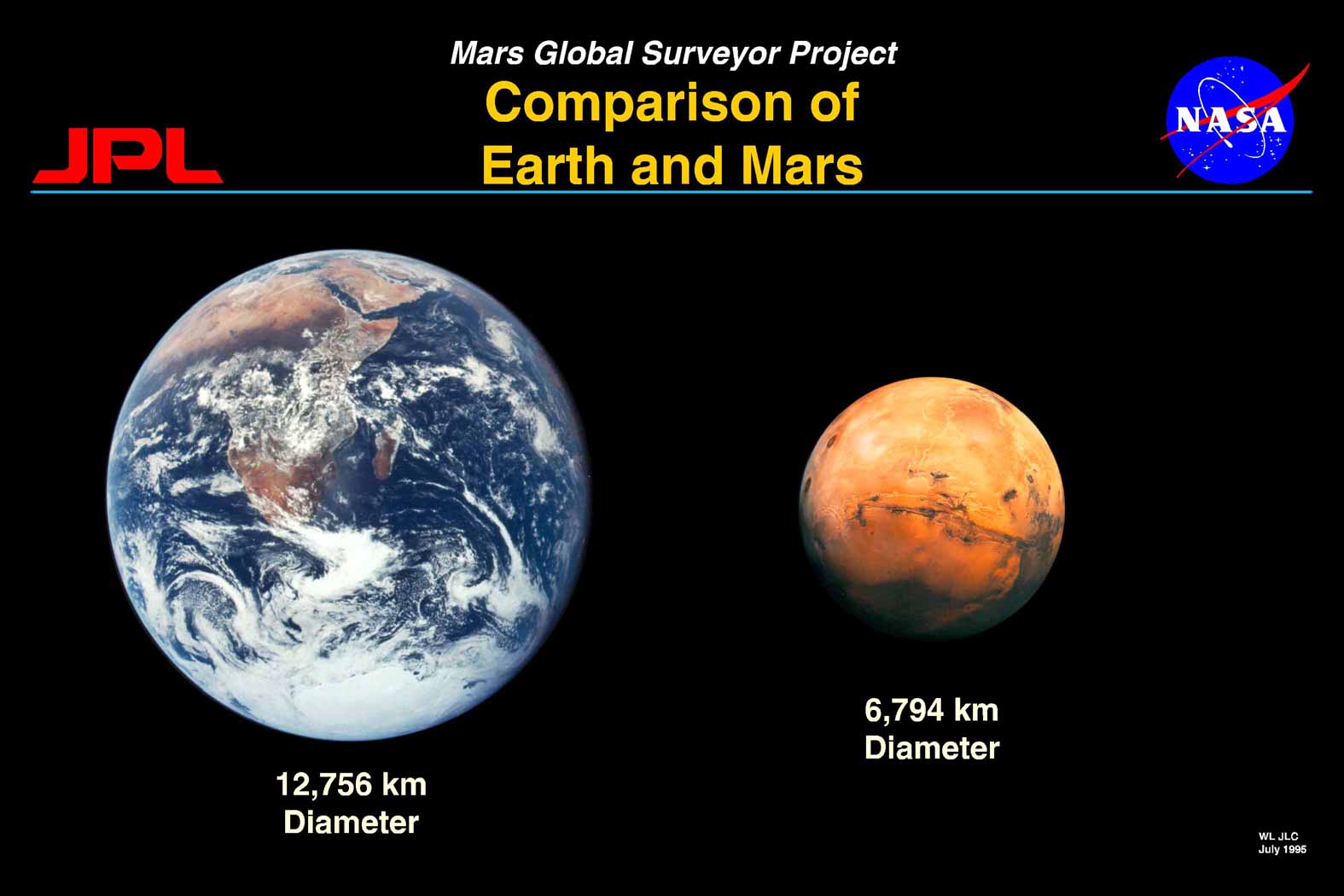
The land area of Mars is roughly the same as the land area of Earth. Four fifths of Earth is ocean, so if we colonized the oceans with floating sea cities, that's the equivalent of four new planets, each the size of Mars, and each far easier and far less expensive to colonize than Mars. Image credit JPL.
From the calculations in the section Fertility of lunar and Mars soil then you need 225,000 square kilometers to feed 7.5 billion people. That's by growing all their own crops - on a mainly vegan diet such as they would have to have in space colonies, using hydroponics and aquaponics and a culture conveyor with many stages of the crop growing simultaneously.
So then, i f we populated our oceans with similar population density to the land, those four times the population of Earth would need about 900,000 square kilometers. The surface area of the Pacific is 165.2 million km². So, that's 0.5% of the surface area of the Pacific as the amount of land you need for those four "ocean worlds" to grow all their own food using space colony type technology, if available on Earth rather than in space. Here of course, it would be much simpler, lower cost and lower tech and easier to maintain, to do this on Earth.
So in summary, if you used the efficient methods proposed for Mars colonists on Earth, to grow crops, you could feed four times the population of Earth from 0.5% of the surface area of the Pacific. That's actually the aim of the seasteading project too. See their section 5. Sustainability and ecology
"After the concept design is finished, the next challenge is to find the appropriate adaptation strategy – a strategy that creates a safe and livable urban environment on the sea, while minimizing impact on the ecosystems and making efficient use of the available resources. In this section, we explain the Blue Revolution concept and apply it to the seasteading concept"
They explain it in detail there, With its use of aquaponics and aeroponics, it resembles ideas for space habitats.
In a floating sea city like that, you would be in a far better situation than you could ever be on Mars or the Moon. The air is breathable, with no need to generate oxygen or to scrub the air of harmful gases. The Earth as a global system does that for you, just open your windows or make sure you have a bit of ventilation in your homes. There is no need for several meters thickness of cosmic radiation protection. You don’t need to wear spacesuits to go outside to repair the habitat, and there is no need to hold the breathable air in against tons per square meter of outwards pressure. It is hard to beat that.
A sea city would have minimal impact on sea life if done in the same way as for a space colony, growing all their own food inside the habitats. Perhaps this could be one outcome of space settlement, that by learning how to live in space, with such a high priority on efficient recycling, we can also learn to live on Earth as well, with minimal impact. Perhaps both approaches will influence each other.
I think there is a case for sending humans into space, I think the Moon is the obvious first destination. Things we can do include
Note, I don't include Helium 3 in this list. It's a fuel for a technology that doesn't exist yet, some think will never be developed, and most decisive in my view, covering a given area of the Moon with solar panels would generate as much energy in seven years as you'd get from extracting all the Helium 3 from that region to a depth of three meters. So solar power from the Moon seems more viable than Helium 3 extraction as a business case, though Helium 3 would be a useful byproduct of mining operations on the Moon. For more on this see Helium 3 in Case for Moon First.
Many of these ventures would include gardening, growing their own crops, and some would lead to longer term settlement for many years, and possibly eventually colonization. But colonization for its own sake is not currently a good reason in my view, simply because it is so much easier to live on Earth.
Our Earth makes everything so easy for us, compared with space colonies. Perhaps one thing they might do is help us to appreciate quite how valuable and wonderful our Earth is, and how rare, as we look back at the beautiful Earth from the Moon or further afield.
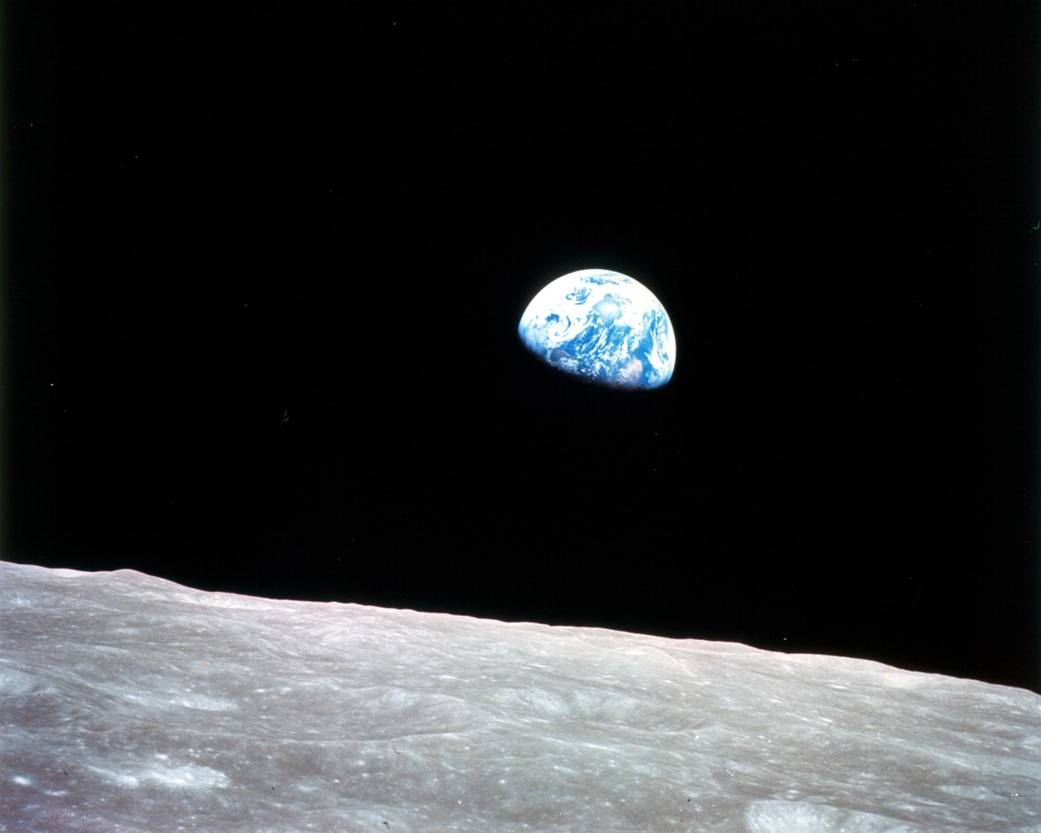
Earth rise over the Moon as photographed from Apollo 8, first mission to orbit the Moon, on Christmas Eve, Dec. 24, 1968
As Carl Sagan in Pale Blue Dot
"The Earth is the only world known, so far, to harbor life. There is nowhere else, at least in the near future, to which our species could migrate. Visit, yes. Settle, not yet. Like it or not, for the moment, the Earth is where we make our stand."
As for the idea we have to go to Mars to go multiplanetary, no, I don’t think we need to do that at all. I think that a rush to send humans to Mars would
Also there is plenty of space to feed our growing population, if we make more efficient use of the land we have already. There's no need to go into space. Our population growth is leveling off, towards a population of perhaps ten billion by the middle to the end of the century.
We have already reached peak child, and most areas of the world now have fertility levels at or below replacement, and feature a slowly growing, steady or declining population. Our world population continues to grow only because with better health world wide, people on average live longer each year.
The middle of the range projections have the Earth's population trending towards 11 billion by 2100 while lower projections have it level off at ten billion or even start to decline towards the end of the century.

So whatever happens, we aren't headed for Malthusian type exponential growth because we have reached peak child already. In the graph above, the red dotted lines show the upper and lower limits for the 95% prediction interval. The blue lines are for +- 0.5 children per couple average. You can look up the data here, the graphs page for the UN population division.
Though we may not reach peak population this century, most parts of the world have a good chance of stabilizing before then, especially the more developed countries. The least developed countries are the ones that would get most population growth. The most rapid growth is in Africa in the projections. You can see a break down for each region of the world here,

Older figures from 2014. Most of the population growth is in Africa by the end of the century by these figures, with everywhere else leveling off by then, the least developed countries are the ones that grow most rapidly, so that's a reflection of the situation in Africa
So, things are actually looking brighter than one might think. Which isn't to say it will be easy, but there is no reason why we have to ruin ecosystems on Earth.
I think we can benefit Earth by moving some heavy industry into space, but there's no real reason why we can't have a sustainable human population here, and we don't have to export our population into space to keep going. It is just as well, since an exponential growth could never keep going indefinitely.
Within 18,000 years of doubling the population every century, so multiplying the population by a thousand every thousand years, you'd need all the matter in the entire observable universe to make colonists. Taking it to an absurd limit for an upper bound, even if they reduce the mass of each colonist to a single atom, that just extends it to 28,000 years, and if they double every thousand years instead of every century, with single atom colonists, it's 280,000 years. So obviously exponential growth has to stop well before then - even with warp drive if such was possible.
Without warp drive then we run out of mass to make humans much more quickly, well within 11,000 years of doubling every century and within 110,000 years of doubling every thousand years. Calculation indented and coloured purple.
Without a warp drive, then the mass density of space in the vicinity of our solar system is 0.18 to 0.21 solar masses per cubic parsec (calculation by John Bahcall), which works out to roughly one solar mass every 165 cubic light years (a parsec is 34.7 cubic light years). We would need to convert a sun's mass into humans after less than 7,000 years of doubling every century (the mass of the sun is equivalent to around 5*10^19 humans at 5 kg per human).
After 11,000 years of traveling at the speed of light we would have access to = 33.8 billion solar masses, and multiplying the mass of humans by 1000 every 1000 years we would require a trillion solar masses at that point. So without warp drive we run out of matter just to make humans well within 11,000 years. Here I've also ignored the limits on thickness of the galactic disk.
So it is very unlikely that if we meet an extra terrestrial, that they will be in a phase of exponential growth and one way or another we also have to find a way to be able to survive without exponential growth, so we have to find a way to stabilize our population, bring the birth rate to below replacement. Luckily, it seems this happens naturally as countries develop economically and with better health and education.
For more on this: Why ET Populations Can't Continue To Expand For More Than A Few Millennia
This section has material from my Quora answer to Shouldn't we focus on colonizing Antarctica and the Sahara before colonizing Mars? as well as several sections from my Case For Moon First
Mars colonization advocates often contrast Mars with the Moon. The Moon may be described as being as uninteresting for human colonization as a lump of concrete. But actually it turns out that the Moon is very rich in resources. We need a "Case for the Moon" here like Robert Zubrin's "Case for Mars".
Moon advocates perhaps don't hit the news as much as the Mars advocates but there are many of them, and they are just as enthusiastic about their vision as the Mars advocates. Paul Spudis is one, with his most recent book, The Value of the Moon: How to Explore, Live, and Prosper in Space Using the Moon's Resources. Another is Dennis Wingo, CEO of Skycorp, and author of Moonrush, see his recent paper, and appearance on the Space Show. Others include Madhu Thangavelu, David Schrunk, and other authors and contributors to The Moon: Resources, Future Development and Settlement. See also David Schrunk's paper Planet Moon Philosophy , and their appearance on The Space Show.
It was also the policy of the US too during the Bush administration, with his Vision for Space Exploration program. And the ESA and Russia are strongly behind the idea of sending humans to the Moon first.
So, let's look at some of the suggested lunar resources for this Moon first approach.
The Moon doesn't have a CO2 atmosphere, but it has dry ice at the poles. It has an estimated at least 600 million metric tons of ice (based on the mini SAR and lunar prospector data, indirectly detected through radar), and possibly much more. If the proportions are the same as for the LCROSS impact measurements, 2.12% of that may be CO2, so if those figures are correct (which needs more confirmation), that could be more than twelve million metric tons of CO2 in the form of dry ice.
That's plenty, but we might not even need it. It is only a trace gas in our atmosphere, less than 0.04%. And, this may surprise you, but actually, feces is nearly all water. About 1 kg of carbon dioxide is exhaled every day, compared to only 30 grams (0.03 kg) of dry weight in feces.
Plants don't need a constant supply of carbon dioxide from outside of the habitat. Indeed, if you grow enough plants for food, then they get all they need to make the plant matter and the oxygen from the carbon dioxide you breathe out, and a small amount from the feces which can be burnt or composted.
With each crop, to close the cycle, the plants also produce almost exactly the amount of oxygen that humans need to breathe, indeed that's the main advantage of growing your food, that it saves on the 0.84 kg of oxygen you need to supply every day. Oxygen supply is the main issue here, and after that, food.
If you have to import some of your food, as has always been the case so far, then an excess of carbon dioxide builds up, and you have to remove because it is dangerous to humans long term at concentrations of above one or two percent in the atmosphere.
The first crop cycle, for, say, 40 days (it took 39 days for dwarf wheat to reach maturity in an experiment on the ISS in zero g) does need a net input of CO2 to the plants for them to grow. But this will be provided by the astronauts just breathing it out, so if you supply them with food for the first month, then they will then provide enough carbon dioxide for the next crop cycle onwards.
Or if you use robots to set up the greenhouse before the astronauts arrive and bring the first crop to maturity ready for them to eat, then you need to supply that 1 kg a day of CO2 per astronaut for one month. So that's 40 kg per astronaut.
You could take carbon out of the atmosphere in the habitat if you store and accumulate the plant wastes. Typically half the crop is plant wastes and if you stored all the plant wastes, yes, you'd need a constant input of CO2. However that would lock up valuable oxygen into the plant wastes and remove carbon from the system as well, so it's not too likely that you would do that.
If you burn plant wastes too as is the most likely thing to do in a space colony, or compost them, then you have a closed system, and any imported food will mean an excess of carbon in the system which will build up in the atmosphere rather rapidly. This was the main thing that threatened the lives of the Apollo 13 crew, they had plenty of oxygen but had to rig up a way to scrub the carbon dioxide to survive.
On the ISS it used to be vented into space. Nowadays they react it with the hydrogen got from splitting water to generate oxygen, in the Sabatier reaction This converts the carbon of the carbon dioxide to methane which is then vented into space. That's still not a closed system as it depends on constant input of water and food to provide the carbon and hydrogen that's lost to space in the methane.
The ISS's half kilogram for 0.04% (see next section) would then correspond to just half a day's worth of wastes for one person. If you suppose similar amount of atmosphere to the ISS, and six people, importing all their own food, the carbon dioxide would build up at a rate of about half a percent a day, so would over 1% within two days, and reach 10% within 20 days, a level which leads to convulsions, coma and death.
If they import half their food, and don't scrub the carbon dioxide they die within 40 days, but probably much sooner. If they import a quarter of their food, with no carbon dioxide scrubbing, they die within 80 days.
That's based on this paper which says concentrations >10% may cause convulsions, coma and death. That's for short term exposure, so with continuous exposure with gradually increasing concentrations, they would probably die well before then. Levels of up to 3% however can be tolerated for more than a month without any adverse effects (see table 2 page 66b of this paper).
No space habitat to date has had to import CO2, and until you have near perfect recycling it won't be needed. Once you are able to grow all your own food, then you may need a tiny amount, but the more perfect the recycling, the less you need. If you had perfect recycling, you'd only need as much as is necessary to get the plants started. Usually half of the plants grown for crops consist of plant wastes, but that also doesn't really change anything. The CO2 you get from burning the wastes or composting it, added to the CO2 breathed out by humans, is almost exactly the amount the plants need to grow the next generation of crops.
So, it's not too likely that you will have a shortage of CO2 in space.
One way or another, if you import food, you will have an excess of carbon in the system which has to be scrubbed and got rid of somehow, usually as carbon dioxide or methane. While if you manage a nearly biologically closed system, you need hardly any materials supplied from outside to keep it going, just need to deal with leaks. The water in urine, sweat and grey water can be recycled, something that is already done in the ISS. For techy details: upgrades to the ISS water recovery systems. The feces can be dealt with also, without need to build a sewage plant in space, for instance oxidized at high temperatures 400 C and high pressures using supercritical water.
It's true that in the carbon cycle on Earth, volcanoes recycle carbon dioxide, which was originally taken out of the atmosphere millions of years ago, however not by us eating plants, or plants just growing and decaying as that returns roughly the same amount to the atmosphere as was taken from it. It is taken out through steady build up of plant residues, for instance peat, coal and oil, and through build up of limestone and chalk in the oceans and through organics falling into the ocean from algae growing on the surface. Most of our CO2 is stored in carbonates such as limestone, or as organics in the oily shales, and that's what gets subducted and then returned to the atmosphere in volcanoes. It's a much slower process.
If we ever attempted to terraform Mars or the Moon or anywhere else long term, we would need to have some other way to return the limestone and chalk and other carbonates to the atmosphere, as it doesn't have continental drift to subduct them and cycle them around through volcanoes. However this is not a concern for space habitats in the near future - they aren't going to be troubled by the effects of a build up of oil rich shales, limestone and chalk.
For more about all this see my Could Astronauts Get All Their Oxygen From Algae Or Plants? And Their Food Also?
Moon has nitrogen too, in the form of ammonia at the poles. If it is correct that there are 600 million tons or more in the form of ice up to 2 meters thick, with 6% ammonia, then there may be 25 million tons of nitrogen there .
We need nitrogen as a buffer gas in the atmosphere to protect us from oxygen toxicity.
There is another way to avoid oxygen toxicity, and that is, to use oxygen at low pressures, as they do for spacesuits. Spacesuit gloves are stiff and difficult to use and full Earth pressure would make them much harder to use. Apollo also used a pure oxygen atmosphere even after the fire of Apollo 1, as a simpler system, but you have to take care to use materials that won't burn easily. Since Apollo all space flights have used mixed oxygen / nitrogen for habitats and pure oxygen only for spacesuits. So, lunar habitats will surely do the same.
We don't have to keep resupplying nitrogen to a space habitat because it is a one off amount of mass (plants use nitrogen but it's part of a nitrogen cycle so could be returned to the atmosphere using denitrifying bacteria, and anyway compared to carbon, it is a small amount of the total mass of the plant). So how much mass do we need to provide?
Well, ignoring reserves of nitrogen, we can work out how much is needed for the habitat air itself. The pressurized volume of the ISS is 32,333 cubic feet or around 915.5686 cubic meters. At 1.225 kg / m3, at Earth sea level pressure which is what they use, it's 1.122 tons of air. So that's less than a ton of nitrogen, and of the total mass of the ISS, 419.725 tons, only 0.27% is atmosphere. As for CO2, at 400 ppm, that much air would contain a negligible half a kilogram (0.04% of 1.122 tons)
So, it's useful to be able to get your nitrogen and oxygen in situ, but it's not a deal breaker if you have to get it from Earth if you have decent closed system recycling.
It's the same for any size of habitat, for city domes too, the atmosphere is small fraction of the total mass, not including regolith shielding, just the unshielded habitat mass.
For a large habitat such as the Stanford Torus then the atmosphere is a higher percentage of the total mass, but that's because it has less structural mass needed, because the surface area (heaviest part) goes up only as the square when the volume goes up as the cube.
For the Stanford Torus, the structural mass is 150,000 tons, atmosphere 44,000 tons, for 10,000 people. Per person that's 15 tons of structural mass and 4.4 tons of atmosphere, not counting the regolith shielding (which they planned to send from the Moon using bulldozers and a mass driver)..
For the ISS, with 6 people, 419.725 tons, that's about 70 tons per person of which 0.187 tons is atmosphere That's a fair bit of atmosphere. There are more efficient ideas for the Stanford Torus, the Vademecium design which has a flatter torus so reducing the amount of mass for atmosphere. However, the reduction in structural mass compared to the ISS more than compensates.
The situation is the same for most large space habitats. The larger it is, the less structural mass per person but the more atmosphere per person if it is similar in shape to a smaller habitat. Venus cloud colonies are different, they have much lower mass requirements per person similar to an airship, and in principle, they can get all of their atmosphere from the Venus atmosphere too.
Nitrogen doesn't seem likely to be a major issue in the early stages at least. It may be more of an issue if we wish to fill an entire lunar cave with nitrogen, more on that below: Can we fill lunar caves with air.
We have pretty good evidence now of ice at the poles, in permanently shadowed craters, thought to be relatively pure and at least a couple of meters thick according to radar data from a NASA instrument flying on India's Chandrayaan-1 lunar orbiter.
It's not a direct detection however, so there is still room for skepticism about it, as rough material would have the same radar signature as radar transparent ice. But craters that are rough when new, are rough both inside and outside the crater rim. While these signatures are found only inside the craters and not outside the rims, which they interpret as meaning that they are caused by ice. The temperatures are also right for ice.
If it is ice, it could be "fluffy ice".
"We do not know the physical characteristics of this ice—solid, dense ice, or “fairy castle”—snow-like ice would have similar radar properties. In possible support of the latter, the low radar albedo and lower than typical CPR values for nonanomalous terrain near the polar craters are 0.2–0.3, somewhat lower than normal for the nonpolar highlands terrain of the Moon and are suggesting the presence of a low density, “fluffy” surface."
(page 13 of Evidence for water ice on the moon: Results for anomalous polar)
In either case, it is not just a little ice; if this is what they detected, there's estimated to be at least 600 million metric tons of this, and possibly much more.
It also contains other volatiles. We know for sure that there is some ice on the Moon, by the LCROSS impact experiment. Relative to H2O at 100% they found H2S at 16.75%, NH3 at 6.03% SO2 at 3.19%, C2H4 at 3.12%, CO2 at 2.17%.
So, if the rest of the ice at the poles has a similar constitution to the impact site that's a lot of nitrogen (in the ammonia) and CO2 on the Moon at the poles.
The green circles here surround craters at the lunar north pole thought to have layers of ice, with an estimated total of at least 600 million metric tons of water.
(0 degrees longitude at bottom)
On the other hand, caution is needed as this is not direct detection. The LEND results (searching for hydrogen through reduced emissions of neutrons of a particular type) are particularly puzzling, as there is almost no resemblance between their map and the miniSAR map.

LEND map - in this picture blue is reduced neutron emission and shows likely locations of hydrogen. 0 degrees longitude is at the top.
They did detect hydrogen, but puzzlingly, it was not correlated with the permanently shadowed regions - there was some hydrogen in permanently shadowed regions, and some also in illuminated regions. A recent paper suggests that ice mixed in the regolith in illuminated regions may be ancient ice that survived a minor shift of the lunar axis. According to one hypothesis, this may be ancient deposits from over three billion years ago before volcanic activity, which changed the polar axis slightly by shifting material.
A new LEND mission has been proposed involving low passes over the poles at altitudes as low as a few kilometers, for higher resolution results.
The Moon may also have ice at lower latitudes too, as there are permanently shaded regions up to 58 degrees from the poles (only 32 degrees from the equator). Though these regions are too warm to have ice on the surface, there may be ice there underground. See Ice may lurk in shadows beyond Moon's poles (Nature, 2012).
At any rate, the Moon does seem to have resources of ice at the poles (though memorably, Patrick Moore in one of the last Sky at Night programs that he did said that he'd believe there is ice at the poles when someone brought him a glass of water from the Moon). More research is needed to find out how much there is and where it is.
Some scientists - particularly Arlin Crotts, think it may have ice several meters below the surface over the entire planet, and that it may have volatile resources deep down. There are signs that suggest it is still geologically active, and one possibility is that the activity may be due to volatiles deep down escaping to the surface. For more on this, see Geologically active moon
Critics often say that the Moon is undifferentiated and doesn't have any processes to concentrate ores. Although the Moon doesn't have any liquid water so all the processes involving concentration of resources through water erosion won't work, it still has many processes that can concentrate ores. Including:
The Moon has many valuable ores for metals. For instance, the highland regions (probably the original crust of the Moon) consists mainly of Anorthite (a form of feldspar, formula CaAl2Si2O8) which is 20% Aluminium, compared with 25% Aluminium for Bauxite on Earth. So aluminium ores are abundant on the Moon, indeed orders of magnitude more abundant than they are in typical asteroids, but it does require a lot of energy to extract the aluminium from the ore. Either a nuclear power plant or large areas of solar panels. Crawford, in his "Lunar Resources: a Review", says this about aluminium on the Moon:
"Aluminium (Al) is another potentially useful metal, with a concentration in lunar highland regoliths (typically10-18 wt%) that is orders of magnitude higher than occurs in likely asteroidal sources (i.e. ~1 wt% in carbonaceous and ordinary chondtites, and <0.01 wt% in iron meteorites; . It follows that, as for Ti, the Moon may become the preferred source for Al in cis-lunar space. Extraction of Al will require breaking down anorthitic plagioclase (CaAl2Si2O8), which is ubiquitous in the lunar highlands, but this will be energy intensive (e.g. via magma electrolysis or carbothermal reduction; Alternative, possibly less energy intensive, processes include the fluoridation process proposed by Landis , acid digestion of regolith to produce pure oxides followed by reduction of Al2O3 (Duke et al.), or a variant of the molten salt electrochemical process described by Schwandt et al."
Mining this for the aluminium would create calcium as a byproduct, which is useful as a conductor in vacuum conditions, a better conductor than copper weight for weight - you need half the mass for the same amount of electricity. (Copper does better than calcium on a per volume basis because it is 5.8 times denser, it is also of course much more practical in an atmosphere because calcium reacts vigorously with air, but that's not a problem for conductors that operate in a lunar vacuum, and in space applications the reduced mass may be an advantage).
"Calcium metal is not used as a conductor on Earth simply because calcium burns spontaneously when it comes in contact with oxygen (much like the pure magnesium metal in camera flashbulbs). But in vacuum environments in space, calcium becomes attractive.
"Calcium is a better electrical conductor than both aluminum and copper. Calcium's conductivity also holds up better against heating. A couple of figures mining engineer David Kuck pulled out of the scientific literature: "At [20C, 68F], calcium will conduct 16.7% more electricity than aluminum, and at [100C, 212F] it will conduct 21.6% more electricity through one centimeter length and one gram mass of the respective metal." Compared to copper, calcium will conduct two and a half times as much electricity at 20C, 68F, and 297% as much at 100C, 212F.
"Like copper, calcium metal is easy to work with. It is easily shaped and molded, machined, extruded into wire, pressed, and hammered.
"As would be expected of a highland element, calcium is lightweight, roughly half the density of aluminum. However, calcium is not a good construction material because it is not strong. Calcium also sublimes (evaporates) slowly in vacuum, so it may be necessary to coat calcium parts to prevent the calcium from slowly coating other important surfaces like mirrors. In fact, calcium is sometimes used to deoxidize some metal surfaces. Calcium doesn't melt until 845C (1553F).
"Utilization of lunar materials will see the introduction of industrial applications of calcium metal in space."
From the section on Mining the Moon in Permanent - by Mark Evan Prado, a physicist in the Washington, D.C., region working for the Pentagon in advanced planning in the space program.
The Moon is deficient in copper, at least on the basis of what is known so far, but as well as calcium, aluminium is a good conductor.
The LCROSS experiment found silver (a superb conductor) and mercury at the impact site, but the concentration is not known, except that it is far higher than the levels in the Apollo samples, and is probably in a layer below the surface, as the signal was delayed. See LCROSS mission may have struck silver on the moon.
It has abundant iron - in addition to ores (which would need a lot of power to extract), it actually has free iron metal
It's in powder form already, and naturally alloyed with nickel and cobalt. The blebs, or "nanophase iron" are found inside impact glass particles, so would be hard to extract. The rest though is made up of tiny particles of pure iron, so the obvious thing to try to do is to separate them out using powerful magnets. They are rather small though, most are less than a micron in diameter which could be a challenge. If we can separate them out, we can get five kilograms of iron, 300 grams of nickel and about half a gram of platinum, gold etc. (platinum group metals) in every cubic meter of regolith - as pure metal what's more. (This summarizes part of section 5, Metals from Crawford)
He bases that on a paper from 1980 by Morris and particularly its conclusion, which uses a model to interpret the data. Taylor and Meeks in the section Agglutinitic Glass versus Grain Size and Maturity (page 133) in their paper suggest that perhaps most of the iron is in nanophase form, mixed up with the glass and hard to extract.
However we don't need to speculate any more as Jayashree Sridhar et al of the NASA Johnson Space Center have done the experiment using actual samples of lunar regolith. See Extraction of meteoritic metals from lunar regolith, and they succeeded! The nanophase iron was a problem but they were able to work around it by varying the experimental setup. By varying on the size of particle they ground it down to, the strength of the magnets and details of the technique they could extract over 80% of the meteoritic iron in some of the tests. They conclude:
"Experimental results indicate promise for the extraction of meteoritic metals from lunar regolith. However, more work is needed to refine the technique and understand more about the variables that affected our results."
The iron is valuable for steel, and is also a conductor, though not nearly as good as Aluminium or Calcium. It would be useful for some applications such as electric railroads on Mars, and is a conductor easy to access in the early stages.
Also nickel and iron are useful for making nickel / iron batteries. These could be useful for making batteries on the Moon with in situ resources, for instance to help last through the lunar night.
"Iron-nickel batteries are very rugged. Their lifetimes which can exceed 20 years are not affected by heat, cold or deep cycling. They are not easily damaged by rapid discharging or over-charging. On the downside, they have poor performance at low temperatures but they can be kept warm with insulation (e.g. simple regolith) and thermal wadis. Also, they only have a charge to discharge efficiency of 65% and will self discharge at the rate of 20% to 40% per month. Despite these shortcomings, they might be the Moon-made power storage systems of choice due to their simplicity and the availability of their component materials on the Moon. Moreover, these materials are among the easiest of materials to produce on the Moon."
See Electrical Energy Storage Using Only Lunar Materials.
Then, you also have titanium. This is especially interesting as it is rare in asteroids. Apollo 17 samples are 20% high purity Ilmenite, a Titanium ore which is found in the lunar mare. And better than that, the Lunar Reconnaissance Orbiter, with its spectral mapping of the Moon, discovered deposits that are up to 10% titanium, more than ten times higher than titanium ores on Earth. (Phys.org report, NASA image). Titanium is an industrially desirable metal, stronger per unit weight than Aluminium (though it is a poor conductor).
Titanium is also widely used in medicine for hip replacements, dental implants, etc., as "one of the few metals human bone can grow around firmly", see also this new titanium / gold alloy four times tougher than titanium
Titanium is especially useful for medical applications because it
"Therefore, in the context of a future space economy, the Moon may have a significant advantage over asteroids as a source of Ti. The fact that oxygen is also produced as a result of Ti production from ilmenite could make combined Ti/O2 production one of the more economically attractive future industries on the Moon.
For more on this, see major lunar minerals. And for an in depth study, read Crawford's review.
So, yes, there are plenty of metals on the Moon, but it might take a lot of power to extract them, apart from the iron, if that can be separated out using magnets.
And that's mainly based on the Apollo results which explored a small region of the lunar surface which has been found to be in some ways unrepresentative. The Moon may have many other surprises in store. Many ores on Earth would not be detected from orbit, and it seems the Moon has a fairly complex geology as well.
As an example of one way the Moon could surprise us - Earth is often hit by iron meteorites, so the Moon should be also. The main question is, how Dennis Wingo has hypothesized in his Moonrush book, that the Moon may also have valuable platinum group metals which could be mined, the result of the impacts of these iron meteorites.
Taking this further, there's a hypothesis by Wieczorek et al that magnetic anomalies on the Moon around the south pole Aitken basin may be from the remains of the metal core of a large 110 km diameter differentiated asteroid that hit the Moon to form the basin. If so, they could be useful sources for platinum, gold, etc.
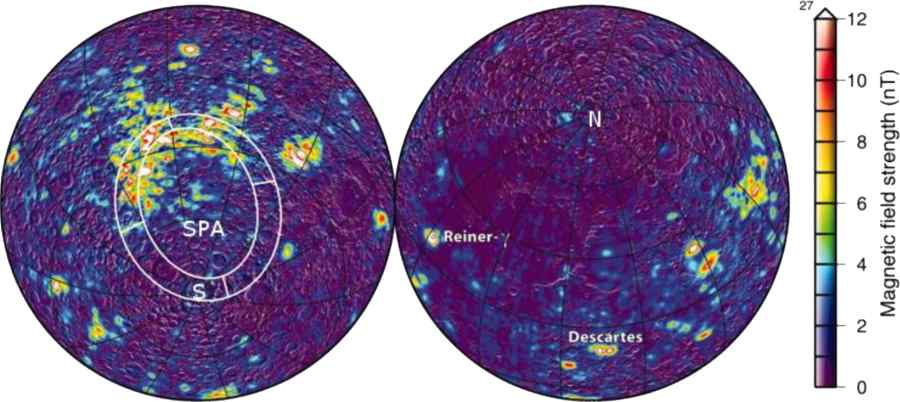
From Wieczorek et al, the North and South poles are marked N and S. Notice the magnetic anomalies clustered around part of the rim of the South Pole Aitken Basin. This is thought to be the result of an impact by a 110 km diameter asteroid. Wieczorek et al hypothesize that the magnetic anomalies trace out the remains of the metal core of this asteroid. If so these could be rich ores, including iron, nickel, also platinum and other platinum group metals (gold, rhodium etc). See page 16 of Crawford's Lunar Resources: A Review
Platinum is a particularly useful metal. It is heavy, soft, malleable as gold and silver, easy to draw into wires, very unreactive, and has a high melting point. Out of gold, silver, platinum and copper, platinum is the densest and the hardest and the least reactive (the others are somewhat better in terms of electrical and thermal conductivity, and malleability, but it's not too bad at those either). So, it's not just useful for catalytic converters, fuel cells, dental fillings and jewelry. We'd probably use it a fair bit in other ways too if it didn't cost so much.
The platinum group metals might be valuable enough to return to Earth from the Moon, just as suggested for the asteroids, especially if there is water to split and use as fuel available on the Moon or once they set up a mass driver on the Moo
Of course, you can't just take the current market value of platinum, multiply by the amount of platinum available in a large meteorite - or on the Moon if Wingo and Wieczorek et al are right - and conclude that you'd get trillions of dollars by returning all that platinum to Earth and selling it here. You need to fulfill a need or eventually nobody will buy it. If it's just to replace copper, for instance, in wires, it wouldn't be worth returning unless you could reduce the transport cost back to Earth right down. Dennis Wingo suggested in Moonrush that it could be worth exporting it to Earth for use for fuel cells, as an application that could be high value and yet need a lot of platinum.
The gold could be useful too, on the Moon at least. You don't normally think of gold as more decorative than useful but it is used a fair bit in electronics Also combined with the abundant titanium on the Moon you get Ti3Au, an alloy with 70% less wear, four times the hardness and increased biocompatibility compared with pure titanium (and twice as hard as titanium / silver and titanium copper alloys). It's also 70% less wear than titanium, lower friction and four times harder with a hardness of 800 HV in the Vickers hardness test. Density about the same as steel.
(density of titanium: 4.43 g/cc. using the atomic masses of gold and titanium, multiplying by (196.96657+3*47.867)/(4*47.867)*4.43 = 7.88 approx. By comparison, density of steel is 7.75 g / cc).
The paper focuses on its medical applications, you can alloy titanium with copper or silver, which are twice as hard as pure titanium, but this is four times as hard. It's also 70% more resistant to wear which will make it last longer and lead to less debris. And has excellent biocompatibility properties. But I wonder if it might also have lunar applications, with the hardness especially and resistance to wear.
Probably only the platinum group metals would be worth returning to Earth, since it's going to be easier to mine the Near Earth Asteroids, especially the ones that consist almost entirely of pure metal. However, whether or not they are useful for Earth, they are well worth using on the lunar surface once you have industry there.
The Moon has some advantages over Mars indeed for metals, such as the pure nanophase iron mixed in with the regolith, which can only exist in oxidized form on Mars except for rare metal meteorites. Also, it's unlikely it will be commercially worthwhile to return metals from Mars while there are definite possibilities of returning metals from the Moon. See Exporting materials from the Moon for future suggested low cost methods for export from the Moon. For discussion of whether anything physical could be worth the expense of export from Mars, see Commercial value for Mars
This is a beneficial side effect of all the micrometeorite impacts on the Moon (which you don't get so much on Mars with its thin atmosphere, just enough to filter out micrometeorites). The Moon's "soil" or regolith contains large quantities of glass, created during the impacts. It also has free iron, as we saw, at half of one percent of the soil, in tiny micro beads of iron (nanophase iron) which concentrate the microwave energy. Again, you don't have this on Mars.
As a result, it is really fast to melt the regolith using microwaves. It took only 30 seconds to melt small lunar sample at 250 watts (typical of a domestic microwave). You can melt the soil to glass as easily as you can boil water using the microwave in your kitchen. See lunar lawnmower. This only works with genuine lunar soil and not the simulants. We have nothing analogous to lunar soil on Earth, as Larry Taylor, principle author of this paper found: Microwave Sintering of Lunar Soil: Properties, Theory, and Practice. He says the microstructure of the genuine lunar regolith, with nanophase iron beads scattered throughout, would be almost impossible to simulate.
His idea (see Products from Microwave Processing of Lunar Soil on page 194 of the paper) is to run a "lunar lawnmower" over the soil with two rows of magnetrons (such as generate microwaves in a microwave cooker). The first row would sinter it to a depth of half a meter using microwaves. Then the second row completely melts the top 3-5 cm of the soil, which then crystallizes to glass. As it does this, it will heat up and release most of the solar wind particles notably hydrogen, helium, carbon and nitrogen. So it could also capture these assets as it goes along, including the Helium 3, if this turns out to be of economic value.
See also The Lunar Dust Problem: From Liability to Asset. This could also be useful, for instance, for a solar panel paving robot to make solar panels, and other applications.
Then, there's Behrokh Khoshnevis' idea for making a landing pad on the Moon using tiles made of lunar glass in situ. The idea is to make the surface into lots of tiles by injecting a material that can't be sintered easily using microwaves into the soil first to outline the edges of the tiles, then use microwaves to melt the soil in between.
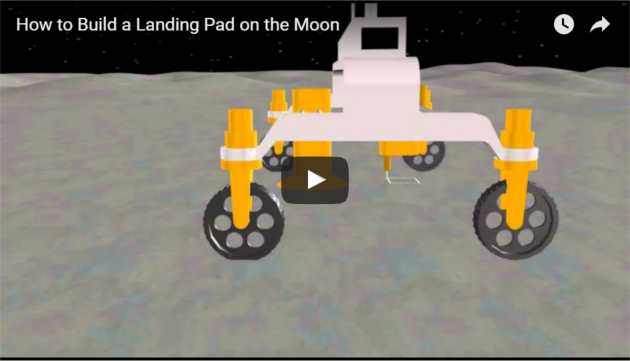
This would make a tiled flat surface for supply vessels to land on. It would also help with the problem of lunar dust by removing dust from the landing area. You can read the details here. He used lunar regolith simulant, so presumably by Larry Taylor's results, it would work even better with genuine lunar samples.
Once you have glass, it might not be such a big step to make photovoltaic cells on the Moon. And here the Moon has one big advantage, the high grade vacuum so you could use vacuum deposition to make the cells in situ. To start with you'd make the cells themselves from materials sent from Earth, later on mine them on the Moon.
This was first tested in the Wake Shield Facility exploiting the increased levels of vacuum in the wake of the Space Shuttle. They were able to grow very pure thin film materials, so demonstrating a path to easy production of solar cells in high vacuum conditions in space, for instance on the Moon.
This is a report from the Center for Advanced Materials at the University of Houston, suggesting the possibility of an autonomous solar powered lunar photovoltaic cell production rover
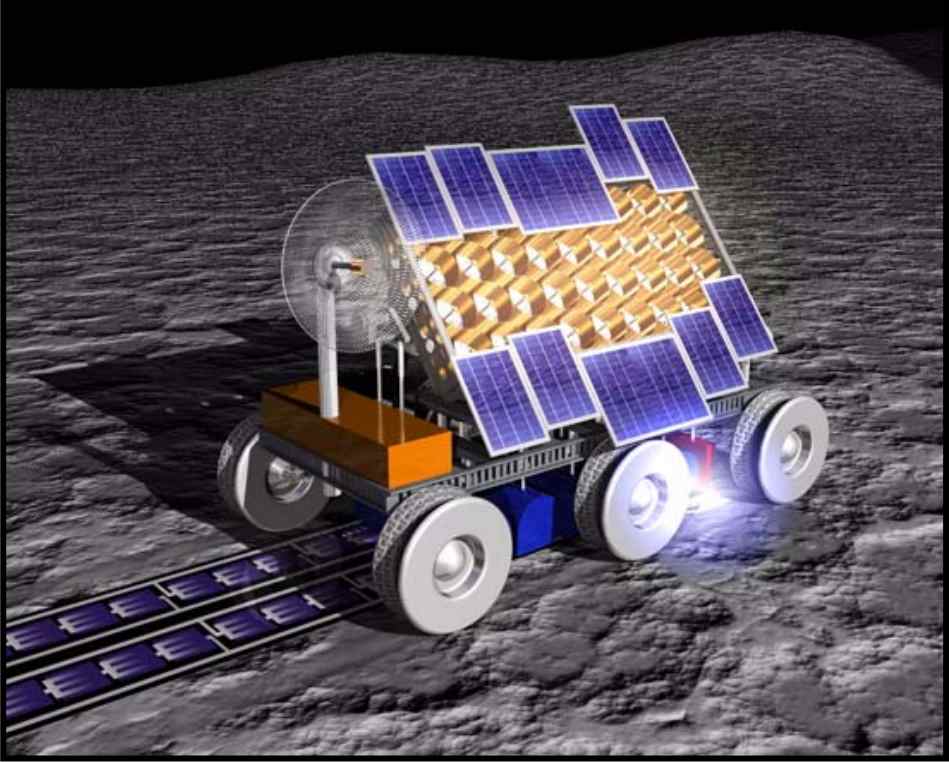
It would use silicon extracted from lunar materials to make the cells themselves. Of the various methods you could use, magma electrolysis may be best. He uses low efficiency silicon cells which are vacuum deposited on glass, something that is not easy to do on Earth but would be possible in the ultra high vacuum conditions on the Moon. Techy details of this suggestion are here.
It would require transporting a small mass to the Moon in the form of the rover which then over several years of driving could build a 1 MW facility on the Moon.
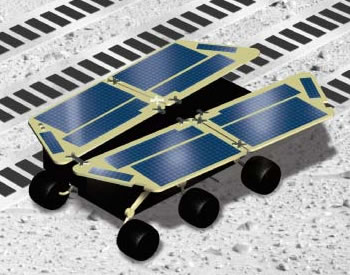
Idea for a robot to drive over the surface of the Moon leaving solar panels in its wake wherever it goes, using only indigenous lunar materials to make the panels. The panels would be only 1% efficient, but given that there is no shortage of real estate on the Moon, that might not matter. It might be more important to make the panels in situ without any imports from Earth than to make them highly efficient
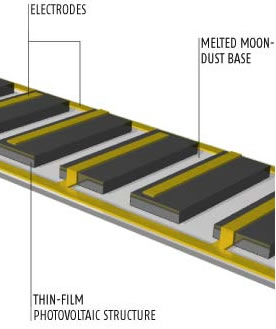
Structure of the panels
For making glass on the Moon see the section above: Lunar glass
The basalt itself is a natural resource. If reasonably pure and consistent in composition, it's ideal for making basalt fibre, which is like glass wool, but much better in some ways. The regolith consists mainly of powdered basalt. So might well be ideal for making basalt fibre. See:
I should mention this, since the topic is brought up so often in discussions of lunar settlement. However I don't see this as a major plus point for the Moon at present.
The Moon is a source for helium 3, deposited in the regolith by the solar wind, and some say that helium 3 will be of value for fusion power in the future because it is not radioactive and doesn't produce radioactive waste products. If so, small amounts of helium 3 from the Moon could be worth a lot on Earth and be a useful commodity to export. Apollo 17's Harrison Schmidt is a keen advocate of helium 3 mining on at a reasonable rate at a reasonable rate the Moon.
However, we don't yet have fusion power plants at all, and one able to use helium 3 is a tougher challenge. Frank Close wrote an article in 2007 describing this idea as "moonshine" saying it wouldn't work anyway. Frank Close says that in a deuterium - helium 3 tokamak, at normal temperatures for a tokamak, the deuterium helium 3 reaction proceeds so slowly that the deuterium would instead fuse with itself producing tritium and then fuse with the tritium (the original article is here, but it's behind a paywall). For a critical discussion see also the Space Review article The helium-3 incantation
See also Mining the Moon by Mark Williams Pontin. If you can use much higher temperatures, six times the temperature at the centre of the sun by some calculations, the helium 3 will fuse at a reasonable rate, but these are temperatures way beyond what is practical in a tokamak at present. The reason such high temperatures are needed for a tokamak is because the plasma is in thermal equilibrium and has a maxwellian distribution which means that to achieve a few particles at very high temperatures you have to heat up a lot of particles to lower temperatures to fill up the maxwellian distribution so that just a few will react. This is potentially feasible for the lower temperatures of DT but not feasible for the higher temperatures of 3He3He.
However if you use electrostatic confinement, a bit like a spherical cathode ray tube with the fusion happening at the center where the negatively charged "virtual cathode" is, then the particles are all at the same high energy and the result is much more feasible with lower power requirements. This is the approach of Gerald Kulcinsky who achieves helium 3 fusion in a reactor 10 cm in diameter. However though it does produce power, it produces only one milliwatt of power for each kW of power input so is a long way from break even at present.
Gerald Kulcinski who has developed a small demonstration electrostatic 3He3He reactor 10 cm in diameter. It is far from break-even at present, producing 1 milliwatt of power output for each kilowatt of input. See A fascinating hour with Gerald Kulcinski
Perhaps this line of development will come to something. Perhaps one way or another we will achieve helium 3 fusion as the enthusiasts for helium 3 mining on the Moon hope. However it is early days yet, and we can't yet depend on this based on a future technology that doesn't exist yet.
However even if we do achieve helium 3 fusion, it might not be such a game changer for the lunar economy as you might think. Crawford says (page 25) that to supply all of our energy from Helium 3 would mean mining 5000 square kilometers a year on the Moon, which seems ambitious (and would mean the whole Moon would only last 200 years). So, even if we develop Helium 3 based fusion, and it turns out to be a valuable export, it's probably not going to be a major part of the energy mix.
Even more telling, he also calculates that covering a given area of the Moon with solar panels would generate as much energy in 7 years as you'd get from extracting all the Helium 3 from that region to a depth of three meters.
Also - there are many other ideas being developed for nuclear fusion, such as laser fusion, and the polywell which has the same advantage that no significant radiation is produced when it uses fusion of boron and hydrogen. I think it is far too soon to know whether or not the helium 3 on the Moon will be an asset in the future when we achieve nuclear fusion power. For a summary, see ESA: Helium-3 mining on the lunar surface.
This doesn't mean that there is no point in helium 3 mining however. As Crawford suggests (page 26), Helium 3 is useful for other things, not just for fusion power. It's used for cryogenics, neutron detection, and MRI scanners, amongst other applications, so some Helium 3 from the Moon could be a valuable export right away, even if it doesn't scale up to the huge quantities you'd need for Helium 3 based power generation on Earth. You'd get it automatically as a byproduct while extracting the more abundant volatiles from the solar wind in the regolith, so it might well be a useful side-line to help support lunar manufacturing economically as part of the mix along with everything else.
The Moon has some uranium, which is a bit of a surprise for such a heavy element, but when bound with oxygen it is rather lighter and can occur in the lunar crust as on Earth. It is especially rich in Thorium, in the lunar Mare. This is useful as a fuel for nuclear fission reactors, which have to be designed to burn thorium instead of uranium to use it. It's not likely to be worth returning to Earth as thorium is abundant here. But it could be very useful in space, at some point in the future.
Nuclear power stations built on the Moon wouldn't have the same pollution hazards and hazardous waste issues as stations on the Earth. Perhaps this may be a way to power space colonies, and interplanetary ships fueled from the Moon, so avoiding the need to launch nuclear power plants from Earth to orbit.
Thorium is a tracer for KREEP - potassium, phosphorus and rare earth elements. Also associated with chlorine, fluorine, sodium, uranium, thorium, and zirconium, so KREEP ores could be sources for all those elements on the Moon.
When the Moon cooled down from the original molten state, then olivine and pyroxene crystals form first, and sink to the bottom of the magma ocean (both made of iron and/or magnesium plus silicon and oxygen). Meanwhile anorthite also forms (made of calcium, aluminum, silicon, and oxygen), which is less dense and floats to the top (forming the lunar highlands). Some of the other elements like nickel are able to squeeze into the crystal lattice and get removed at the same time. But the larger elements can't, and are left in liquid state. They are last to solidify and form the KREEP deposits. It forms in between the olivine and pyroxene deep down, and the floating anorthite on top and may have been liquid for a long time.
For some reason, not fully understood, then KREEP deposits on the surface of the Moon are concentrated on the near side of the Moon near the Imbrium basin, with a small amount also in a separate concentration on the far side. The Imbrium impactor probably excavated the KREEP deposits on the near side. But it's puzzling that the much larger Aitken basin didn't lead to large deposits on the far side. Perhaps for some reason KREEP is concentrated on the near side of the Moon. For more about this see The Moon is a KREEPy place by the planetary geologist Emily Lakdwalla which I summarized here.
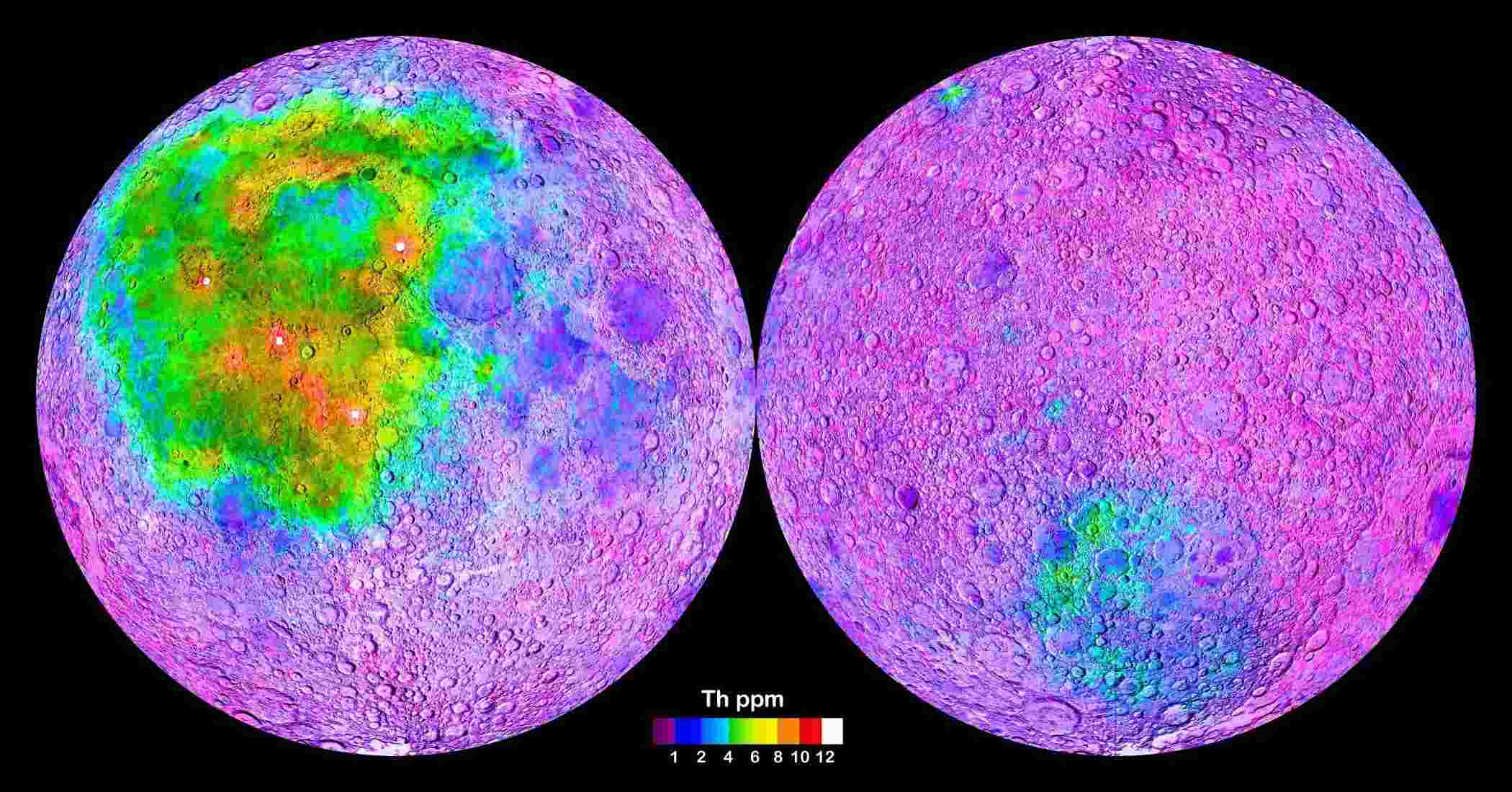
The abundances of rare earth elements on the Moon are much less than rare earth ores on Earth, and despite the name, they aren't very rare here on Earth. So it's not likely that they'll be worth returning. However the most concentrated spots - the ones marked white in this figure - haven't been sampled on the surface and the spatial resolution is low, tens of kilometers. So it's possible we'll find more concentrated ores on the Moon.
It's a similar situation for uranium and thorium. The abundances on the Moon from this map are too low to count even as a low grade ore on Earth. But with such low resolution, there could be richer ore deposits when we look at it closely. (Here I'm summarizing what Crawford says about lunar KREEP ores in his survey, see section 7, Rare earth elements and following)
The vacuum of the Moon is also actually an asset, so much so that we might need to take special precautions to preserve it.
"It seems absurd to expect that the lunar vacuum could be lost by small-scale operations on the moon. However, high-vacuum and ultra-high vacuum is needed for many industrial processes, some of which may be accomplished on the moon. Some processes which require vacuum and thus would be simpler to manufacture or use on the moon include vacuum tubes, semiconductor manufacture, solar cell manufacture, and particle accelerators."
Degradation of the Lunar Vacuum by a Moon Base - Geoffrey A. Landis
The carbon dioxide atmosphere of Mars is so thin it counts as a laboratory vacuum, you would need a pressurized spacesuit or you'd die quickly because the water lining your lungs would boil. But it's not thin enough to be a useful vacuum. And as we've seen, carbon dioxide is not needed as an input for greenhouses - in a closed system it just circulates around to food and back again. The Moon would seem to have the advantage here, too.
We've just mentioned the idea of using a lunar mass driver. This is a 1970s artist's concept drawing of the idea, the large area of solar cells to the left powers it.
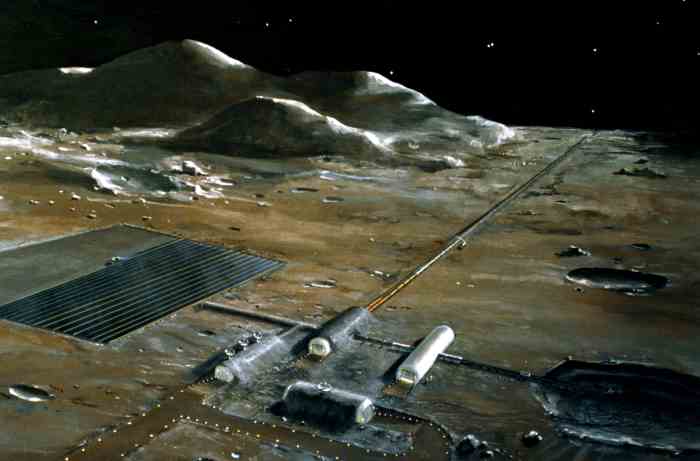
However, unless it can be constructed largely using in situ materials, then there is a lot of material to send up to the Moon to construct it. This is a 2010 study that (making various assumptions) suggested that a lunar mass driver would have a long payback time. The more frequently you can send the payloads, the shorter payback time. You might want to do regenerative breaking to recover as much of the energy as possible from the launch vehicle. Some ideas for mass drivers on lunarpedia.
Then, there's the possibility of generating fuel using the ice at the lunar poles. With 600 million metric tons at least, if those figures are correct, then it seems that we could make fuel without significantly impacting on the amount of ice there.
There are other ideas also for exporting materials from the Moon, such as the lunar space elevator. which was promoted in a successful kickstarter by the Liftport group. Though we don't yet have the technology to build a space elevator on Earth, we could in principle build one on the Moon. It would extend from the surface through the Earth Lunar L1 point,
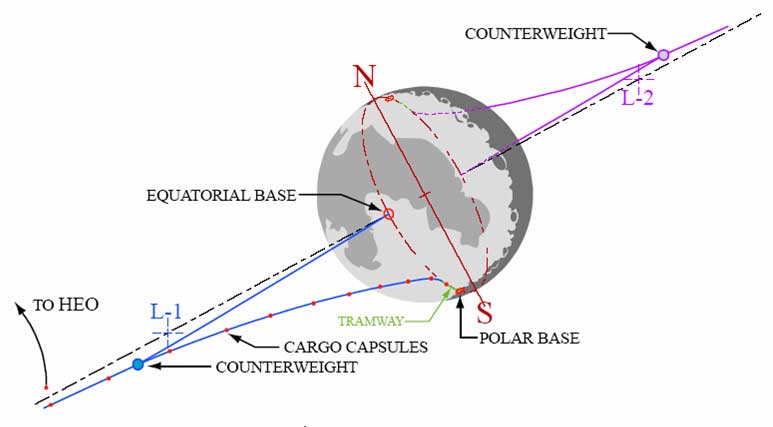
There are different design ideas, but one proposal in 2011 was for an 11,000 kg tether made of Zylon HM fiber which would be 264,000 km long, transport microrovers to the lunar surface, and return 10 kg at a time from the lunar surface, so that is a mass to payload ratio of 1,100 to 1. For techy details see LADDER.
For more background information about lunar tethers, see. "Lunar Space Elevators for Cislunar Space Development Phase I Final Technical Report"
Another ingenious idea, and one with a much lower structure to payload ratio than a lunar elevator is Robert Hoyt's Cislunar tether transport system. More details: CISLUNAR TETHER TRANSPORT SYSTEM
It uses momentum exchange tethers. This shows the idea for Earth - a rotating tether that could pick a payload from a suborbital spacecraft up from the upper atmosphere, and boost it into LEO. If the tether rotates at exactly the right spin rate, then it can be stationary relative to Earth when in the upper atmosphere, closest to Earth in the tether spin - and spinning at just the right speed to boost the payload to LEO at the upper part of the spin. This is too hard to do at present. But it could capture a payload from a suborbital spacecraft moving at Mach 12, and boost it to orbit.
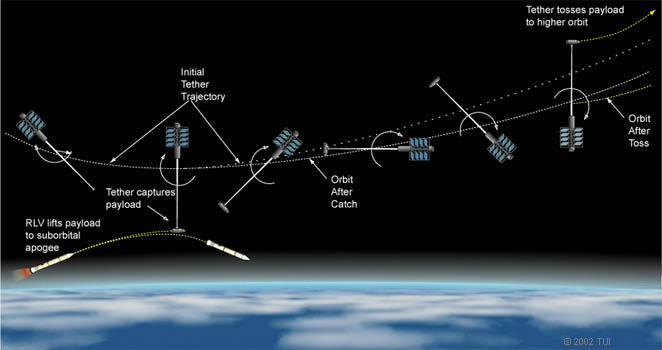
Well this gets especially interesting if you do it on the Moon. Robert Hoyt designed a cislunar transport system which looks like this:
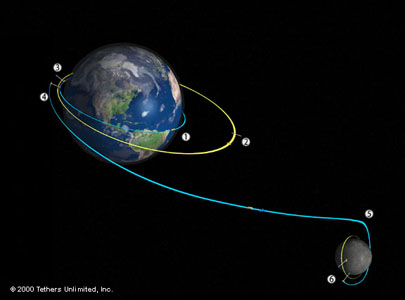
"The Cislunar Tether Transport System. (1) A payload is launched into a LEO holding orbit; (2) A Tether Boost Facility in elliptical, equatorial Earth orbit picks up the payload (3) and tosses it (4) into a lunar transfer trajectory. When it nears the Moon, (5), a Lunavator Tether (6) captures it and delivers it to the lunar surface."
At the Moon end of the transport system, the tether can be stationary relative to the Moon's surface when closest to the Moon. There are many complications to the idea - that's just the outline of how it works. For details see his Cislunar tether transport system.
His summary reads:
"We have developed a preliminary design for a 80 km long Earth-orbit tether boost facility capable of picking payloads up from LEO and injecting them into a minimal-energy lunar transfer orbit. Using currently available tether materials, this facility would require a mass 10.5 times the mass of the payloads it can handle. After boosting a payload, the facility can use electrodynamic propulsion to reboost its orbit, enabling the system to repeatedly send payloads to the Moon without requiring propellant or return traffic. When the payload reaches the Moon, it will be caught and transferred to the surface by a 200 km long lunar tether. This tether facility will have the capability to reposition a significant portion of its “ballast” mass along the length of the tether, enabling it to catch the payload from a low-energy transfer trajectory and then “spin-up” so that it can deliver the payload to the Moon with zero velocity relative to the surface. This lunar tether facility would require a total mass of less than 17 times the payload mass. Both equatorial and polar lunar orbits are feasible for the Lunavator™"
The interesting thing about this is that it needs almost no fuel!
"By balancing the flow of mass to and from the Moon, the orbital momentum and energy of the system can be conserved, eliminating the need to expend large quantities of propellant to move the payloads back and forth"
That works because the LEO is lower in the gravitational well. So whenever you send material from the Moon to Earth, the system actually gains energy, a bit like a ball rolling down a hill.
One of the strong points in this design is the low mass to payload ratio of 10.5 to 1 for the tether in LEO and 17 to 1 for the tether in lunar orbit.
Agreed, if you want to go to Mars and it's your only destination you are interested in for humans outside of Earth, and for a short visit only, then perhaps it wouldn't make sense to set up all that infrastructure to mine lunar water, or lunavators, or lunar elevators or to build mass drivers, just for a single mission to Mars with humans, or even several missions perhaps.
But if you are visiting the Moon because it is interesting in its own right, then the fuel on the Moon could then easily become a key towards opening the rest of the solar system to easier spaceflight, as well as supplying fuel and water to LEO as well. And the other ideas may be useful also, especially if it turns out that the Moon is a useful source for water for space. Ideas like the lunavator might even make it economical to return materials from the Moon such as nickel, cobalt, etc., quite low value, but in large quantities.
Hoyt's cislunar tether or the propellants made on the Moon can return materials to LEO. That's great for materials that need to be supplied to LEO such as propellant and water, but what about exports to Earth itself?
To return materials to Earth, you have to target the Earth's atmosphere and to hit it slowly enough so that the materials you mine don't burn up in the atmosphere. You might do aerobraking first to reduce speed, and then over a period of time, skimming the atmosphere, lower the orbit to make the landing gentler.
When you are ready, then actually landing the materials on Earth is relatively easy. To make sure there is no risk of damage to Earth, if the parachute or aeroshell fails to deploy, make sure you send the materials in small amounts, small enough to burn up in the atmosphere in its entirety without the aeroshell - and equip each one with an aeroshell and parachute.
Conventional aeroshells are likely to be too complex to create on-site at least at the early stages of development, and too heavy and so too costly to export from Earth. But there's an alternative here, the ballute, an inflatable balloon that works like an aeroshell.
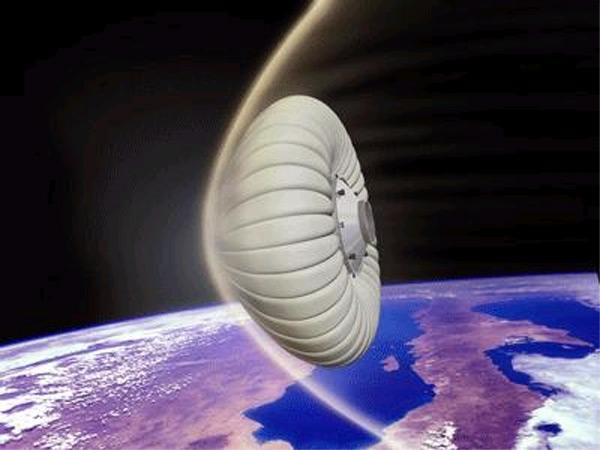
See the New Scientist article Inflatable cushions to act as spacecraft heat shields, and this article Profitably Exploiting Near-Earth Object Resources
It's lightweight, so you could make them on Earth and then send them up to the facility for returning to Earth.
Space mining would probably start with mining of water for use in LEO and other spacecraft missions - because of the high cost of supply of materials to orbit, making it far easier for the mining to turn a profit and pay for itself. But later, funded by the sale of water to space agencies, it could then move on to mining metals and other resources useful for Earth itself.
For those who worry that lunar exports might deplete the Moon of its volatiles, then mining the lunar volatiles for fuel is only needed for perhaps a few decades, or until we find an easy way to access other sources in the asteroid belt or find easy ways to lift water from Earth. If we get easy transport to orbit at dollars per ton (e.g. orbital airships, space elevators, or Earth based mass drivers), then the Earth would take over from the Moon and asteroids at that point for any materials abundant on Earth such as water, or air.
I think there's a good chance that eventually it will be as easy to get into space as to fly to another continent. If it costs a similar amount to transport of materials to space, or across the Atlantic, then it would surely be economical to send Earth water and air into orbit and would compete with sources in space. I think there's a good chance this will happen long term, perhaps on timescales of decades, and very likely on the centuries timescale. And of course there's no risk of Earth running out of water or air as a result of exporting the comparatively tiny quantities that would be needed in space. See my Projects To Get To Space As Easily As We Cross Oceans - A Billion Flights A Year Perhaps - Will We Be Ready?
Meanwhile, if there are hundreds of millions of tons of lunar volatiles, they should last until then, and will be a useful source of income for lunar development. That's enough water so that even if you had a million people on the Moon, you could have a full lane of an Olympic swimming pool's worth of water for each one from the local resources, and only a tiny amount of that would be exported for fuel.
Less delta v is needed to get water and other materials from Near Earth Asteroids to Earth, some have a delta v of less than 1 km / second. Though the ones that have the least delta v are the ones with orbital period closest to Earth which means that the times when they are most easily accessible from Earth come around less often, and close flybys might be a decade or more apart.
The Moon scores here in the early days because it is always easy to get to. Then, if the lunavator idea worked for the Moon, then you could get materials back to Earth with almost no extra fuel needed, so that could make the Moon even more attractive than an asteroid.
There are similar ideas for asteroids also, this time the idea to harness the spin of an asteroid to send materials to Earth using a tether that is attached to it and spins at the same rate as the asteroid itself. For the basic idea, see Asteroid Slingshot Express - Tether-based Sample Return.
In the long term future, perhaps the Moon would be most useful for materials that are rare in most asteroids but common on the Moon, such as Aluminium and Titanium. Both lunar and asteroid mining has the potential to move some of our industry into space, and help reduce the impact of mining on the Earth.
This contains material from the section Moon Science Surprises from Case for Moon First.
We are at the same stage here as the very first Antarctica explorers, setting foot on a continent sized land mass that we know little about first hand. Indeed, far larger than Antarctica; the Moon is as large as Russia, the USA and China put together.
The ice at the poles of the Moon could be the "Record keepers of the early solar system" as Greg Delory put it.Then there is more ice offset from the north and south pole. As mentioned already, this may be ancient deposits from over three billion years ago before the volcanic activity, which changed the polar axis slightly by shifting material.
Then there are ancient regolith layers covered with lava which preserve a record of surface lunar conditions and solar activity over billions of years.
There are other surfaces on the Moon recently formed with few craters - changed by some activity, perhaps emissions of gas, in the very recent geological past Some think it may still have ice, deep down, or even trapped water, from a layer of water rich material that might have accumulated on the early Moon at the same time our oceans formed soon after the original impact of the Mars sized protoplanet with early Earth - Water on the Moon, Yvonne Pendleton, page 3.
We don't yet know the age of the ancient South Pole - Aitken basin, a huge 2,500 km diameter crater which extends over the far side, the "oldest, deepest and largest basin recognized" on the Moon. Just a few samples of rocks returned from it would establish this.
The Moon might also be of interest for evolution and exobiology. That's because meteorites from Earth must hit the Moon in large numbers, after the largest impacts on Earth such as the dinosaur extinction Chicxulub event, (perhaps a million fragments around a cm in size, in that case). Though there is no atmosphere, the gravity is so low that meteorites from Earth can hit the surface at quite slow speeds (comparatively). This has lead to many ideas in the literature of ways that organics from life on Earth or other sources of interest to biology may be there for us to discover. We can only find out for sure by exploring the Moon on the surface:
When you consider the meteorites and the regolith, the Moon must be a treasure trove of proto Earth secrets, and of solar system secrets too. It would start with ejecta from the early Earth as it cooled down after the impact that formed the Moon, Venus too if its atmosphere back then was thin enough for an asteroid impact to eject material with escape velocity, and Mars for sure. Also material from comets, and asteroids, nearly every major thing of note that happened in the inner solar system probably left a record there. The record should also include ejecta from every major impact on Earth, right up to perhaps fragments of ammonites from the Chicxulub impact which must have showered the Moon with large numbers of meteorites.
The Apollo samples were recently re-analysed and the composition of amino acids suggests some extraterrestrial sources, The analysis was a tricky one due to contaminants from Earth in the form of rocket fuel, organics taken to the Moon by the astronauts, and organics introduced while handling them on Earth, which suggests we need to take care to avoid this sort of thing as we explore the Moon.
So, another thing we can do on the Moon is to find out how much organic contamination accompanies human explorations. E.g. before we send humans to Phobos or Deimos or wherever they go next, we'd better know what humans will do to a celestial body when they set up a settlement there. Especially if the aim is to study ice deposits in craters and such like. Organic Measurements on the Lunar Surface: Planned and Unplanned Experiments
The far side is the best place to build radio telescopes anywhere near to Earth.
There are challenges as well of course. If observing during the lunar night (so least interference from the Sun) then it's both cold and without solar power. Either you use RTGs or power storage for the lunar night.
The Moon is also good for optical telescopes. See Lunar Telescope Facility Final Design Report (MIT, 2007)
Artist's impression of a large liquid mirror infrared telescope on the Moon, passively cooled near the lunar poles. By a useful coincidence, a slowly spinning liquid in a gravitational field naturally forms an optically perfect parabolic shaped mirror. Because there is no atmosphere, the optics would be better than for a liquid mirror telescope on Earth, indeed it would be diffraction limited (i.e. the best that is theoretically possible).
These telescopes are so simple to build and lightweight that it should be feasible to build a 4-8 meter liquid mirror telescope soon after a lunar base is established, and larger mirrors later on, with 100 meter telescopes well within reach. Other advantages for the Moon include low shipping mass, ease of assembly, and low maintenance.
A lunar infrared liquid mirror telescope would have a mirror like this
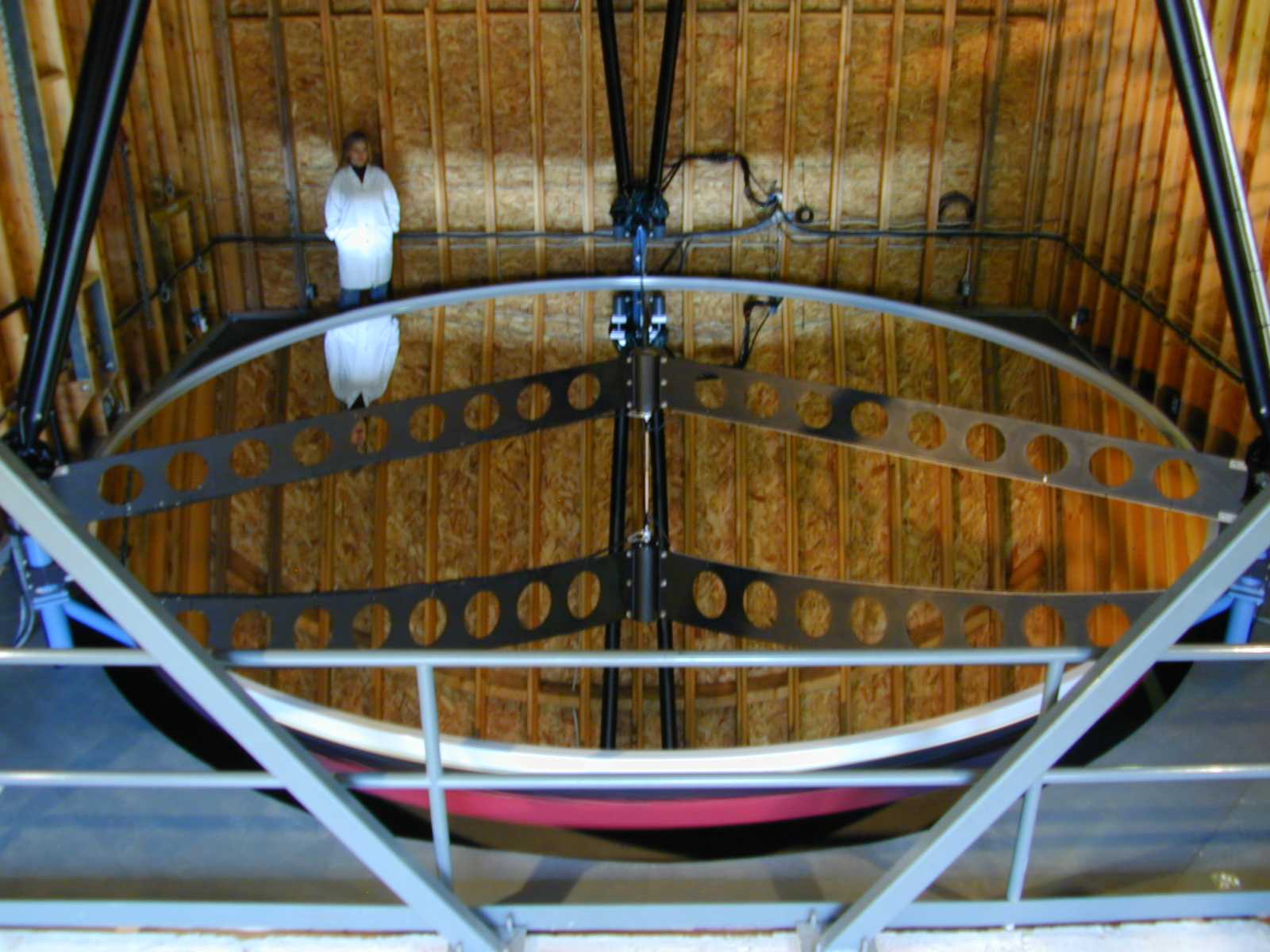
which keeps its natural perfect parabolic shape through rotating the disk slowly. The photo shows the six meter diameter Large Zenith Telescope in Canada. On the Moon, this mirror would be made of ionic fluids (salts in a liquid state) rather than mercury, due to their very low vapour pressure which would let them work in the vacuum conditions of the Moon.
If the telescope is anywhere except at the poles, it will scan a circular strip around the sky. Also because the Moon's axis wobbles with a period of 18.6 years, it actually sees a fair bit more than that circular strip. Most of the lunar libration we see from Earth is due to changes in viewing geometry because of the Moons irregular orbit, it's slant relative to the Earth's equator, the varying distance from the Moon etc.
Shows how the Moon librates as seen from the Earth. Most of this is due to changes in the viewing geometry as seen from Earth.
However, there is also a small variation due to actual motion of the Moon's axis. The Moon's axis precesses, and traces out a circle in the sky of radius 1.5 degrees every 18.6 years. That's quite a lot in astronomy - the Moon as seen from Earth spans only half a degree, so if we can use this unit of the Moon's apparent diameter as seen from Earth- we can see three Moon's worth above of sky above and below the track of the telescope depending on the position in that 18.6 year cycle.
(Earth does have a subtle effect also - nutation - it's precession period is 26,000 years but the the position of its axis varies by an extra half a degree over that same 18.6 year time period as the Moon, enough to be useful for liquid telescopes here as well.)
That's also why the peaks of sunlight at the poles have periods of darkness, but only for a few days of the year. This is actually an advantage for polar infrared telescopes on the Moon. For more details, see Liquid Mirror Telescopes on the Moon (NASA news, 2008). A liquid mirror infrared telescope on the Moon 20 meters in diameter could detect objects a hundred times fainter than the ones visible to the planned James Web Space Telescope. All the materials for a 20 meter telescope would amount to only a few tons, a single load on a heavy boost rocket. A hundred meter diameter telescope could detect objects a thousand times fainter than for the James Webb. Though not steerable, this would be especially useful for detecting faint red shift galaxies from the early universe, and supernovae from these early times, .
The dust can be dealt with, for instance by making a region around the telescope into glass, which is easy to do on the Moon as use of a microwave turns the regolith into glass as easily as you boil a kettle. Unlike Mars, there are no dust storms to deal with. Just electrostatic elevation of the dust. See Lunar Glass.
Another big surprise recently is that the Moon was recently geologically active, over the timescale of millions rather than billions of years. It might even be active today.
First there are the lobate scarps, fault lines that cut across small craters on the Moon. Small craters tend to be geologically young as they get obliterated by later craters. So these faults are thought to be young, possibly as young as a few hundred million years.
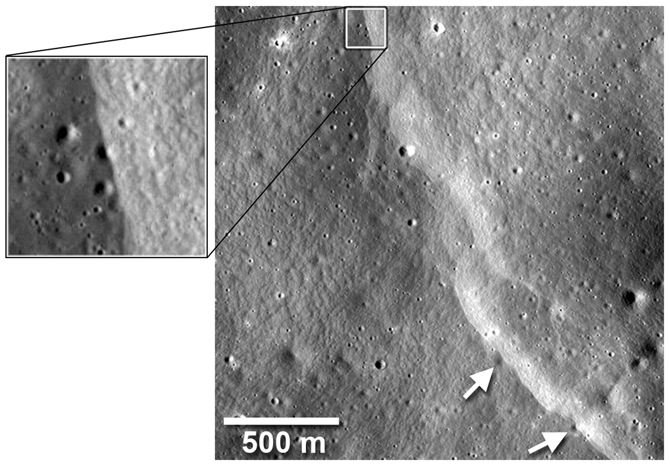
The Apollo seismometers recorded moon quakes, and though most are probably due to impacts, tides, and day / night temperature changes on the Moon, it leaves the possibility open that perhaps the Moon is still active today. These scarps may be a sign of it.
See NASA's LRO Reveals 'Incredible Shrinking Moon'
Then, they also found graben - trenches formed when the crust pulls apart. And these are as young as 50 million years old. That is so young that it suggests the Moon is still active.
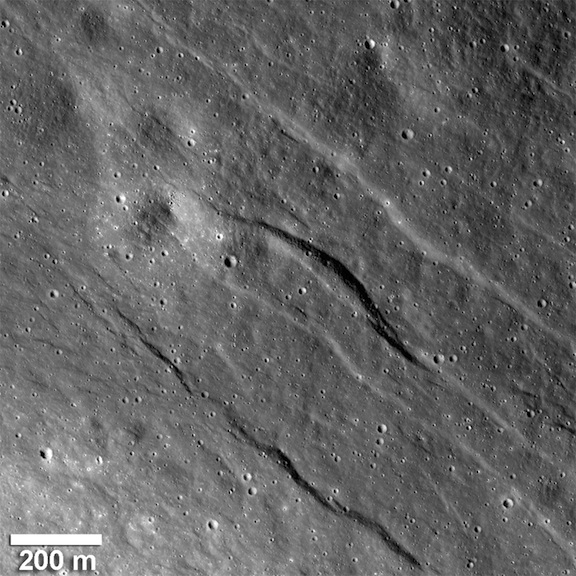
Graben on far side of the Moon found by Lunar Reconnaissance Orbiter
This was a big surprise as the lobate scarps suggested that the Moon was shrinking. So how can it be expanding as well?
Then, there's this strange feature on the Moon, unlike most of the terrain there, the Ina depression.
%20mid%20res.jpg)
Ina depression as imaged by LRO. It's 2.9×1.9 km and 64 m deep. Higher resolution available here. It is one of four similar features around the Imbrium basin.
First discovered by Apollo 15 in 1971, it's now known to be one of many such. They are small features, less than 500 meters across, and seem to be widespread on the near side of the Moon. Some may be as young as 100 million years old. Some of the younger features may be as young as 50 million years old. This means you can't rule out the possibility of future eruptions.
The LRO team found 70 "Irregular Mare Patches" (IMPs) from 100 meters to 5 km in diameter. To find out more, see Volcanoes erupted on the Moon within the past 100 million years which also has a link to the full Nature article which you can read through their article sharing initiative.
Whatever it is, it seems to be geologically recent, as there are few really small craters, and larger features have sharp edges and haven't been degraded. This suggests an age of only millions, rather than billions of years. It's spectra shows it to be bluer than the surrounding terrain (slightly) - a spectral signature consistent with freshly exposed Mare materials. Schultz et al interpret it as mare exposed by a sudden outgassing from the interior blowing away more than 12 meters thickness of overlying an regolith or pyrolastic material (rubble like in texture, result of fountaining lava in the past).
The Moon's surface layers are not just depleted in water compared to Earth, it's also depleted in the more volatile metals potassium and sodium too (by comparison with the less volatile zinc). One recent idea is that when two protoplanets collided to form the early Earth, and the debris condensed to form the Moon, volatile rich layers may have condensed first, then dry layers accumulated on top of them (links also to the original Nature paper) . That paper is mainly used to explain why the surface layers are so dry. They weren't able to determine if the interior would have volatiles in it, but it's possible.
So, it's not necessarily as dry all the way to the center as it is on the surface. Perhaps it has water and other volatiles deep down. If so, these outgassing ideas may be easier to accept.
Then you have the Transient Lunar Phenomena. Moon observers over the years have often noticed short term brightening of the Moon's surface, especially in the Aristarchus plateau. A small bright patch will appear, then disappear, just a bit too slowly to be just a flash from an impact on the Moon. Our eyes are very good at picking up such things, but also easily fooled. So it's a controversial observation. But they may be the result of outgassing, again, if they are real.
So anyway, Arlin Crotts of Columbia University noticed a correlation of the TLPs with sites where argon and radon gas is detected. This can't come from the solar wind and must be outgassing from below the surface. The usual explanation is that it's the result of slow leaks from radioactive decay from below the surface. He thinks that there may also be explosive outbursts of gas which may lead to the TLPs.
He developed these ideas in a series of papers called "Lunar outgassing, transient phenomena, and the return to the Moon", where he also suggests that the Moon may have ice some meters below the surface replenished from below
In the third paper he proposes using ground penetrating radar in orbit around the Moon to search for subsurface ice. He also suggests various ways to monitor the Moon from orbit searching for outflowing gas as well as attempting to observe the TLPs directly.
Then there's this curious phenomenon, the Lunar Swirls. The most prominent of these is Reiner Gamma which is visible in a backyard telescope, but becomes much more impressive with high magnifications.
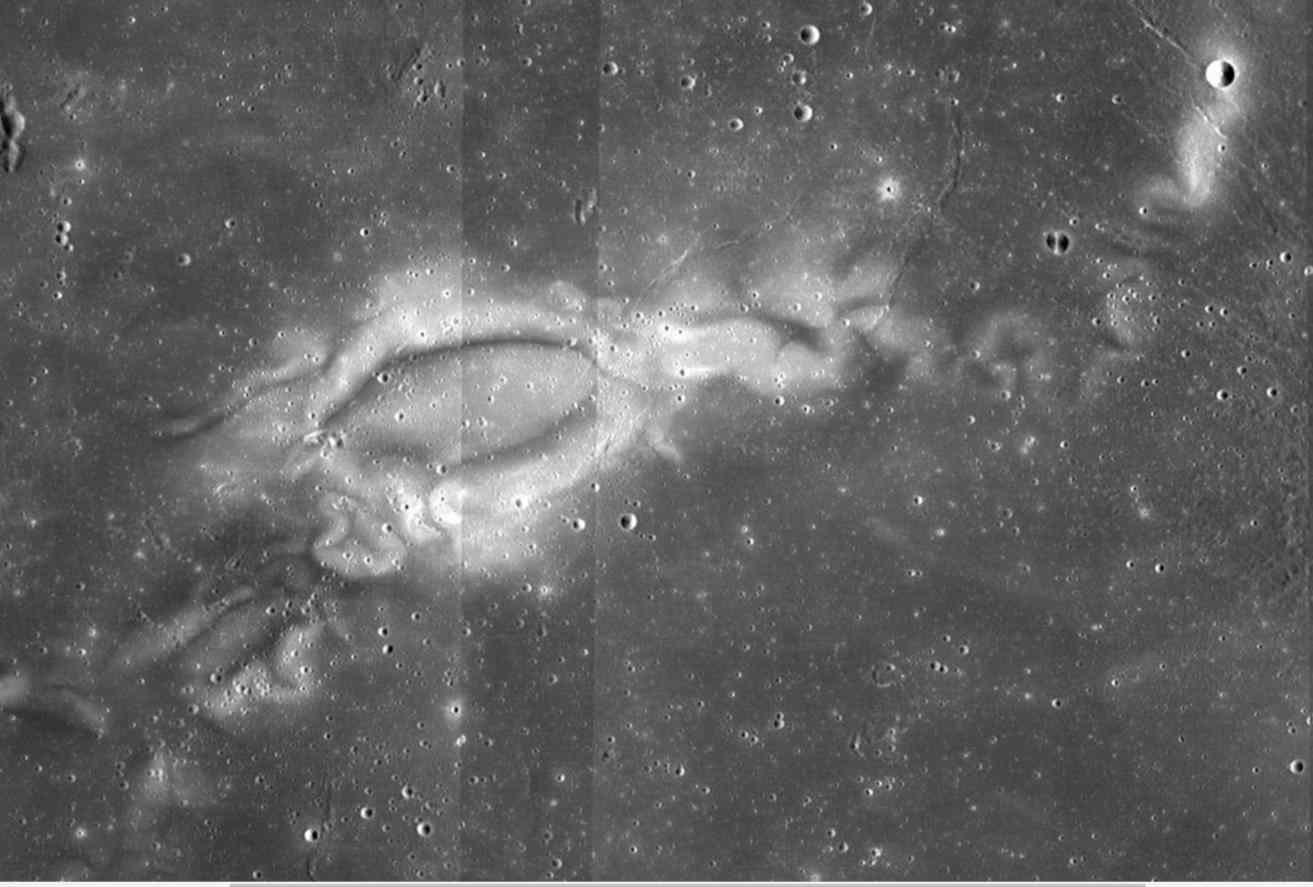
Lunar swirls in Reiner Gamma. The swirls are always associated with magnetic anomalies (a discovery made serendipitously in 1972 using two small satellites released into lunar orbit by Apollo 14 and Apollo 15 to study the Moon's magnetotail), and this is one of the strongest magnetic anomalies on the Moon. Though not all magnetic anomalies have swirls.
The light coloured swirls in these photographs are not associated with any geological feature but seem to be laid on top of the surface, and they don't seem to have any noticeable thickness or have any effect on the topography.
Whatever they are, they are intriguing and who doesn't love a mystery? Some of the magnetic anomalies on the Moon might also be tracers of iron nickel / platinum asteroid impacts, if so do the swirls tell us anything about them? Or are they something else, nothing to do with any metal asteroid impacts (e.g. for the comet hypothesis)?
On top of that you also have the unexpected. What I've described so far are things we can expect, or know to search for and investigate, on basis of what we know so far. But usually we get surprises when we explore new places in the solar system. And though in some ways the Moon is well understood, in other ways it is barely explored at all on the surface, never mind below the surface. It wasn't that long ago that ice on the Moon was a big surprise to many astronomers. It may have many other surprises in store too. We have spent hardly any time exploring the Moon so far, with only one expedition with a geologist on it. Imagine if we had given up on Antarctica as "done" after the first few expeditions that succeeded in landing a human on the continent?
This is material from the sections in Case for Moon First from Commercial value for Mars onwards. It was also published in Forbes Magazine as "Is There A Fortune To Be Made On Mars?".
The debate about going back to the Moon focuses on the commercial value of the Moon, for exports to LEO, to Earth or to other locations in outer space, see The Moon is resource rich. But what about Mars, does it have any commercial value for exports to Earth or anywhere else? This is relevant whether or not we send humans to the Mars surface, so let's forget about planetary protection issues for this section. If there is anything of great commercial value on Mars then either
Elon Musk has said several times that he doesn't think there will be anything material from Mars that would be worth transporting back to Earth.
"I don't think it's going to be economical to mine things on Mars and then transport them back to Earth because the transport costs would overwhelm the value of whatever you mined, but there will likely be a lot of mining on Mars that's useful for a Mars base, but it's unlikely to be transferred back to Earth. I think the economic exchange between a Mars base and Earth would be mostly in the form of intellectual property"
Elon Musk interview on the future of energy and transport - and more quotes like this from him.
Robert Zubrin covers this in more detail:
"Another alternative is that Mars could pay for itself by transporting back ideas. Just as the labor shortage prevalent in colonial and 19th century America drove the creation of Yankee Ingenuity's flood of inventions, so the conditions of extreme labor shortage combined with a technological culture and the unacceptability of impractical legislative constraints against innovation will tend to drive Martian ingenuity to produce wave after wave of invention in energy production, automation and robotics, biotechnology, and other areas. These inventions, licensed on Earth, could finance Mars even as they revolutionize and advance terrestrial living standards as forcefully as 19th Century American invention changed Europe and ultimately the rest of the world as well."
Elon Musk is skeptical about space mining generally thinking it probably won't be possible to export from the asteroids -
"I'm not convinced there's a case for taking something, say, platinum, that is found in an asteroid and bringing it back to Earth."
Of course many think that this will be possible. Myself I just don't know, I've heard the arguments on both sides and remain on the fence here.
Anyway Elon Musk doesn't go into any more detail about the case for or against material exports. Robert Zubrin however has discussed this in a paper "The Economic Viability of Mars Colonization " in the Journal of the British Interplanetary Society from 1995, and later on in the Interplanetary Commerce section of Case for Mars. He first outlines the need for exports to make a Mars colony viable:
"A frequent objection raised against scenarios for the human settlement and terraforming of Mars is that while such projects may be technologically feasible, there is no possible way that they can be paid for. On the surface, the arguments given supporting this position appear to many to be cogent, in that Mars is distant, difficult to access, possesses a hostile environment and has no apparent resources of economic value to export. These arguments appear to be ironclad, yet it must be pointed out that they were also presented in the past as convincing reasons for the utter impracticality of the European settlement of North America and Australia."
..."While the Exploration and Base building phases can and probably must be carried out on the basis of outright government funding, during the Settlement phase economics comes to the fore. That is, while a Mars base of even a few hundred people can potentially be supported out of pocket by governmental expenditures, a Martian society of hundreds of thousands clearly cannot be. To be viable, a real Martian civilization must be either completely autarchic (very unlikely until the far future) or be able to produce some kind of export that allows it to pay for the imports it requires."
..."Mars is the best target for colonization in the solar system because it has by far the greatest potential for self-sufficiency. Nevertheless, even with optimistic extrapolation of robotic manufacturing techniques, Mars will not have the division of labor required to make it fully self-sufficient until its population numbers in the millions. It will thus for a long time be necessary, and forever desirable, for Mars to be able to pay for import of specialized manufactured goods from Earth. These goods can be fairly limited in mass, as only small portions (by weight) of even very high-tech goods are actually complex. Nevertheless, these smaller sophisticated items will have to be paid for, and their cost will be greatly increased by the high costs of Earth-launch and interplanetary transport. What can Mars possibly export back to Earth in return?"
(emphasis mine)
So according to his ideas, the Mars colony is supported on the basis of outright government funding for the early stages of exploration and base building. He thinks that in these early stages you need something over and above ISRU (In Situ Resource Uitilization) for a commercial case unless the base is autarchic - a word which usually refers to individual liberty and governing oneself - but in this context I think he must mean, producing everything it needs, independent of Earth.
So it is rather similar to Elon Musk's idea except that in Elon Musk’s vision, the settlement is supported by private funding from Earth in the early stages rather than government funding.
Zubrin then discusses the possibility of ores on Mars, and we'll come back to this later in this section:
..."Mars may have concentrated mineral ores, with much greater concentrations of ores of precious metals readily available than is currently the case on Earth due to the fact that the terrestrial ores have been heavily scavenged by humans for the past 5000 years. It has been shown that if concentrated supplies of metals of equal or greater value than silver (i.e. silver, germanium, hafnium, lanthanum, cerium, rhenium, samarium, gallium, gadolinium, gold, palladium, iridium, rubidium, platinum, rhodium, europium, etc.) were available on Mars, they could potentially be transported back to Earth at high profit by using reusable Mars-surface based single stage to orbit vehicles to deliver the cargoes to Mars orbit, and then transporting them back to Earth using either cheap expendable chemical stages manufactured on Mars or reusable cycling solar sail powered interplanetary spacecraft. The existence of such Martian precious metal ores, however, is still hypothetical."
In his section on Interplanetary Commerce in “Case for Mars” page 239 and following he also suggests deuterium as an export. I'll look at that below, between the section on geological products and the section on fuel exports.
He then goes on to suggest that Mars may play a crucial role for supply of ores and other exports to the asteroid belt once we have humans living there. He suggests Phobos and Deimos may also be valuable as a staging post on the way to the asteroid belt. Which may be true, but that's a rather later stage. I'm interested here in the earlier stages before we have large numbers of humans in the asteroid belt.
Do correct me if anyone knows of any other papers with detailed discussions of possible exports from Mars. That's all I've been able to find so far.
However it is discussed a fair bit online in places like Reddit, and the various Mars forums and spaceflight forums, and enthusiasts have suggested many other ways that they think a Mars colony could become profitable. So what I present here is based on that, as well as some thoughts of my own.
So, let's look at this a bit more closely, is there anything physical that could be worth exporting, (apart from the science value of the search for life and the information returned). Also is there anything worth exporting at a reasonably early stage such as the first few decades of a human exploration of Mars either on the surface or telerobotically from orbit?
However, the price would go down quickly as we get more samples from Mars of the order of tons of material. You'd only return as much as was needed for the scientific research you need to do due to the high price of return of material from Mars.
Also, individuals might want to buy Mars rocks at high prices, but only for as long as they are rare. This would be like supporting a lunar mission by returning and selling Moon rocks. The first few rocks could be valuable to collectors, and if they were issued with a certificate of authenticity as the first rocks to be returned from Mars or the Moon maybe the first few rocks would retain their value. But longer term, how many people would want to buy into something of continually reducing value?
You'd think they must be rare or we would have spotted them on the surface. There's no sign at all of outcrops of oil shale. But on the other hand - cosmic radiation is very damaging. Would there be anything left of a surface oil shale deposit after billions of years?
It's an exponential process so you get very rapid reductions. Every 650 million years you get a 1000 fold reduction in the concentrations of small organic molecules such as amino acids on the surface because of cosmic radiation. So that's a million fold reduction every 1.3 billion years.
Cosmic radiation has little effect over time periods of years, decades, centuries or millennia. But over time periods of hundreds of millions of years the effects are huge. After 1.3 billion years, a thousand tons of amino acids gets reduced to a kilogram, with the rest converted mainly to gases like carbon dioxide, water vapour, methane and ammonia. After 2.6 billion years it's down to a microgram (millionth of a gram) and after 3.9 billion years you are down to less than a picogram (a millionth of a microgram) of your original thousand tons deposit.
So, I don't think absence of these deposits on the surface, at least ones easy to see from satellites, really shows that they don't exist below the surface. There could be millions of tons of organics from past life ten meters below the surface, and our rovers so far would probably not spot a thing. The organics of course also have to be there in the first place (surely likely to be patchy, in some places more than in others) and buried quickly - if it took several hundred million years to bury them, much of the organics would be gone also.
Oil itself is surely not worth the trouble of mining to return to Earth. But if there was some unique biological product on Mars that we don't have on Earth - which you could mine to find there, maybe that could be worth returning to Earth.
Mars could potentially be competitive with Earth for export of food for use on spacecraft and other space colonies due to the much lower launch cost, provided that the costs of growing the crops on Mars are also comparable to Earth's (quite a big if in the early stages).
But what about greenhouses in space? It would also have to compete with those. This would require it to be much easier to build a greenhouse on the surface than in space. Since it's a near vacuum and also has such huge diurnal swings in temperature, I'm not sure that it has much by way of advantages over, say, Phobos or Deimos, or indeed the Moon which has much less delta v than Mars. Even for export to Mars orbit, it could be as economical or more so to export from the Moon for foodstuffs that can keep for months long transport journeys. See Greenhouse construction - comparison of the Moon and Mars in Case for Moon First.
It could be more economical to export from Mars to Mars orbit rather than from the Moon perhaps for food that can spoil quickly, though this is not a net export from the Mars system. Another thought, if the natural Mars gravity was an advantage, and for some reason, easier to use than artificial gravity, perhaps it could be worthwhile.
It could also be worth doing if conditions on Mars let you produce unusual food or decorative plants more easily. As an example, it could be worth doing, if you can grow rare flowers on Mars that are very expensive to grow elsewhere, or similarly unusual and tasty rare new food stuffs that grow best on Mars for some reason, perhaps genetically designed for Mars conditions. This is related to the next topic:
Continuing to
Products you could export could include
For this to work there must be some reason they can't be grown on Earth
This case might also be another reason to be really careful not to contaminate Mars with Earth life, so that you can continue to grow the native Mars life there without interference from Earth life to make unique products that can only be produced easily from the native Mars life.
However, even if you can't grow the products safely on Earth, at some point you'd have the capability to grow them in Stanford Torus type habitats, biologically isolated from Earth and designed to mimic Mars conditions. Still, by the time that's feasible, export costs from Mars could go down at the same time that prices of such habitats go down, so keeping Mars competitive with them.
This does seem a potential early export that may continue to be commercially viable for quite some time, maybe even indefinitely. But it depends entirely on what we find as we search for life on Mars and also on how easy or safe it is to grow them on Earth, the Moon or elsewhere.
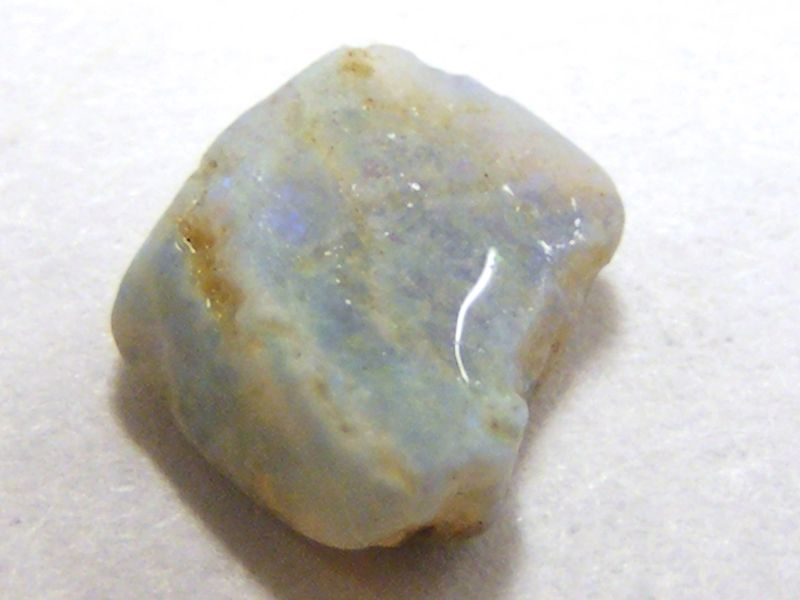
Raw opal found in Andamooka South Australia - photo credit CR Peters
Mars is different from asteroids or the Moon here, so it could have unique deposits. It's the only place we know of with deposits formed in ancient seas billions of years ago and its past and present climate is unique too. It might have unique minerals of decorative value.
What about:
Remember, that
So, in short, it has to be competitive with platinum, gold etc. mined elsewhere in the solar system, and you have to bear in mind that the prices you can get from Earth will surely go down, or else your exports are limited to keep the prices artificially high. On the other hand if the material you are mining is very valuable, and launch costs are low, perhaps the margin due to cost of export from Mars doesn't make such a big difference. E.g. suppose the launch costs a few hundred million dollars but you are returning tons of material, worth billions of dollars, perhaps it doesn't matter so much that a few percent of your product's price is due to transport. Maybe other elements of the price such as mining are somewhat less expensive than they are for asteroids?
However for this to work, there has to be a reason why other elements of the cost of mining are low. Asteroids and the Moon have the advantages of:
It seems unlikely that the thin Mars atmosphere would help much with mining operations. Would the Mars gravity help, or be a hindrance? And the large temperature swings from day to night, could they help in any way to make it easier to mine materials?
Just to make this clear, this is not Elon Musk's idea. As we saw, he thinks the colony would pay for itself in the early stages mainly through sale of intellectual property rights to the Earth. And Robert Zubrin, as we saw, thinks it will be paid for in early stages through government funding. But it's a topic that gets discussed in the online forums. So let's have a look at it.
If you get colonists who pay in advance for their flight out to Mars - and they use the Mars Colonial Transporter - a 100 people at a time, if SpaceX succeed in producing that spaceship - then the spacecraft has to come back to Earth after every run to transport colonists to Mars, and would be able to take exports with it, which is essentially free transport. So there would be a multiplier effect there of the original passage fee.
However unless the products are already worth returning for one of the other reasons, then at most they could get back their original passage fee by selling the material. Otherwise you'd have a case for sending empty colonial transporter ships to Mars just to return the products.
So, you'd get exports, yes, for as long as the colony continues to expand rapidly. However, that's not a business case in the long term, as it's not going to be sustainable, as a way of supporting a colony there. Even if they can get their money for the flight back from the goods returned from Mars, they then have to support themselves on Mars indefinitely, not just pay for the flight out. And with increasing numbers of colonists on Mars, you'd need exponentially increasing numbers of colonists going out there to support them with the passage fees. If you get increasing numbers of spaceships sent there to send them their supplies, again you need to pay for that somehow.
So, I don't think relying on the nearly empty transporter as it returns to Earth as a way to support the colony is likely to work long term. It works only as long as you have exponentially increasing numbers of colonists going to Mars and nobody coming back or few people coming back.
After the initial romance of being “the first settlers on Mars” is over, would there be such huge demand to retire to Mars with not so much by way of home comforts as Earth and far away from their friends, relatives and children? Many older people take a lot of interest in their younger relatives and might not want to retire to Mars on their own and leave them behind on Earth.
Also, presumably the idea is that they can pay for the colony because they won't live long when they get there. But it doesn't work like that. If you have survived, say, to 65, your total life expectancy is much higher than for someone who has only survived to 20, because everyone who died before 65 are removed from the population at that point. Quote from here:
That's an average, so many of the population will live more than 20 years after they reach their 65th birthday.
It continues like that. The life expectancy of an 85 year old woman isn't 1.6 years, it's 7 years. T he life expectancy of a 90 year old woman, if they live that long, is still 5 years. Then on top of that, they have to be healthy enough to get to Mars, so it would be biased towards healthier old people. Those figures are from the US social services life expectancy calculator.
Even if you only accept 90 year olds, you'll want super fit 90 year olds which mean they will probably live for more than five years, maybe a decade or more, especially with improvements in medicine.
So, we have to expect retired people to live for decades after they retire. They need more hospital care, and nursing than the general population. They may also get Alzheimer's, and are less strong, on average (some may be super fit of course, for their age, but still they are not quite as strong as a 20 year old, athletes "retire" at a young age). How could that work?
I can’t see the retirees migrating from Earth paying for their own requirements for the rest of their life. And if it is a mix of older and younger people, even more so, I can't see the retirees paying for the requirements of all the younger people for the rest of their life.
This again becomes a case where you would need exponentially increasing numbers of immigrants needed to pay for the colony, and exponential growth can’t continue for long. Of course retirees would have a place to play in a colony that can support itself financially, as in any society. Just saying that the one off sum of money that retirees pay to go to a space colony can't be used as an income to support it. It's just the same as for younger folk, they need some way to continue to support themselves once there. So we need to keep looking.
This is one of the main points in the International Commerce section in Case for Mars, and is also often mentioned in discussions, so I should go into it in some detail.
So first, let's look at the data on deuterium abundances in our solar system. Curiosity measured a deuterium to hydrogen ratio five times greater on Mars than in the Earth oceans, probably due to the loss of hydrogen from the upper atmosphere of Mars over billions of years. See Heavy hydrogen excess hints at Martian vapour loss. This is for near surface ice. The Mars meteorite studies also suggest another reservoir of water below the surface with a lower ratio of two to three times that for Earth’s oceans which probably comes from an earlier phase of Mars history. Meteoritic evidence for a previously unrecognized hydrogen reservoir on Mars.
Deuterium occurs naturally on Earth in water as 1 in 6,400 hydrogen atoms or 1 part in 3,200 by weight. On Mars it is one deuterium for every 1,284 hydrogen's. Though Mars has a higher deuterium to hydrogen ratio than Earth, it’s not the most abundant source of it in the solar system. Rather, Earth’s abundance is if anything rather low, compared with many sources although high compared to the concentrations in the Sun and Jupiter and hydrogen from the solar wind. The solar wind hydrogen trapped in the lunar regolith also has a very low deuterium concentration.
Venus has the highest deuterium / hydrogen ratio recorded in our solar system of 120 times Earth’s and so 24 times that on Mars in its atmosphere. Implications of the high DH ratio for the sources of water in Venus' atmosphere.
Most meteorites that hit Earth have close to terrestrial abundances of deuterium but some have very high levels. This meteorite has 13 times the abundance of Earth’s oceans, so more than twice the abundance for Mars (many types of rock contain hydrogen and so you can measure their deuterium concentrations, this is a chondrite meteorite ).
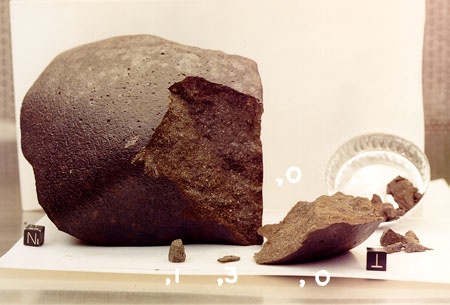
Antarctic Meteorite Lab Photo of Sample WSG 95300 - details about it here - the deuterium measurements for this meteorite are here: Deuterium enrichments in chondritic macromolecular material—Implications for the origin and evolution of organics, water and asteroids
(see table 2, the δD there is measured in parts per thousand relative to terrestrial abundances, so for instance δD +1000 for double terrestrial values)
Jupiter family comets have higher deuterium abundances than Earth, perhaps around three times terrestrial abundances as for Comet 67p from the Rosetta mission, though there is some question here about whether comet outgassing may somehow concentrate the deuterium and lead to over estimates of the abundances.
So is Mars the best extraterrestrial source for deuterium? And is it worth importing from space at all?
Currently the main use of deuterium is as a moderator in a nuclear reactor. You have the choice of enriching the uranium, and using ordinary water, which is the method used currently in many reactors, or of using ordinary unenriched uranium and heavy water, as is used in heavy water reactors such as the ones developed by India. That works because heavy water slows down neutrons without capturing them so permitting a chain reaction with a lower concentration of radioactive Uranium than light water which captures many of the neutrons.
However his quoted price of $10,000 per kilogram for deuterium seems a bit high. You can get 99.96% pure deuterium oxide for $1,000 per kg from Cambridge Isotopes. (Deuterium Oxide 100%) You can get 99% pure deuterium oxide for $721 per kg (Deuterium oxide 99%) Unless he’s referring to the price for pure deuterium separated from the oxygen?
99% pure deuterium oxide is sufficiently pure for the production of plutonium from uranium. Because of this application, the technology to produce heavy water is tightly regulated and the deuterium produced in a plant is tracked carefully. (For an example of how this is done, see "Selection of a safeguards approach for the Arroyito heavy water production plant" )
He says that the price of deuterium would go up if we develop deuterium / tritium fusion. I don’t really see that, since the main cost comes from extraction and there is no shortage of water to extract it from. Would a higher demand not just lead to us building more deuterium extraction plants, and a search for methods to reduce the costs using larger scale production facilities, for economies of scale, and other methods of generating it, which would reduce the price rather than increase it?
And what if some other form of fusion power turns out to be more efficient or have advantages over deuterium / tritium fusion? It’s a bit tricky arguing based on a technology we don’t have yet, and there are many possible ways of generating fusion power being explored at present.
He says deuterium would be a natural byproduct of electrolysis of water sourced on Mars, which would produce around one kilogram of deuterium for every six tonnes of water electrolyzed on Mars. However to do this then you have to add a deuterium / hydrogen separation stage to the hydrogen production plant. How easy is that? He doesn’t go into details of how it would work.
That 5 times enhancement over the deuterium in Earth’s oceans is still a long way from 100% concentration. It’s normally extracted by using many stages, and each time the amount of deuterium is increased. With only one atom in 1,284 consisting of deuterium you would still need to concentrate it many times over to reach 99% concentrations. For instance water electrolysis, one of the most effective methods of concentrating it, would increase the deuterium concentration 5 to 10 times each time it is used. The 5 times higher concentration on Mars would just save one stage of water electrolysis of many that would be needed. Though in practice electrolysis has such high energy costs it is best used only once for a final stage, for water that is already 50% D2O. The Argentinian plant uses methane as a feedstock because the hydrogen can be dissociated thermally from methane, much more easily than from water. Similarly for other techniques. There are many methods used to extract deuterium. Each of them requires many stages of concentration and I don’t see how an enhancement of 5 times in the feedstock would make a significant difference here.
So that then leads to the practicality of building and operating an extraction plant on Mars and providing the high power levels needed to extract the deuterium (the main reason for its high cost). If it needs vast amounts of electricity to do the separation, it’s not going to be worth doing I think. Also heavy water plants on Earth are large scale and massive structures. This is the heavy water plant in Argentina:
.jpg)
Heavy water plant near Arroyito, photograph by Frandres This plant produces most of the world’s deuterium, at a rate of 200 tons per year, and is powered by a nearby hydroelectric power station at Arroyito dam with a power output of 128 MW. (I'm not sure how much of that power output is used for the plant, do say if any of you know).
The equipment for extracting deuterium weighs 27,000 tons including the support structures and includes 250 heat exchangers, 240 pressure vessels, 90 gas compressors 13 reactors and 30 distillation columns. (Statistics from Arroyito Heavy Water Production Plant, Argentina)
Would the five times higher concentration of deuterium lead to more than a minor saving in the costs of the plant? And how would that offset all the difficulties of setting up and operating the plant with near vacuum conditions outside it, as well as transport costs for equipment that can’t be built on Mars?
Of course Mars is different in many ways and though most of them seem to be disadvantages for operating such a planet, could any of them be advantages, such major advantages that it makes it worthwhile to build and operate it on Mars? For instance, could the near vacuum of its atmosphere be made an advantage somehow? (E.g. for distillation).
On the face of it, there doesn’t seem to be a compelling commercial case for this. If there is, it needs to be spelt out in more detail.
Details here come from Heavy Water: A Manufacturers’ Guide for the Hydrogen Century and Future Trends in Heavy Water Production (1983) - has details of the Argentina plant. and heavy water.
Some of the internet discussions talk about this as a business case. The main issue I see with supplying fuel from the Mars surface is, would it compete with fuel generated on Deimos or indeed on the Moon for astronauts in orbit around Mars? Also, is methane valuable enough as a fuel in space, to make it worthwhile to export hydrogen to the Mars surface to convert into methane and return to orbit, or to split the hydrogen from water on Mars and use it to make methane?
That leads to the next idea:
This is the premise of the Deimos Water Company outlined by David Kuck. The delta v back to Earth is much less than from the Mars surface, and you can produce your own fuel for the journey. It would have to compete with volatiles on the Moon if those exist and are easy to mine. I think it's hard to judge this at present as we don't know what the volatiles are like on the Moon. We know they exist but don't know how abundant they are locally, or how easy or hard they are to extract. And so far we don't yet know for sure if there are any volatiles on Deimos, although spectroscopically it resembles a type of asteroid that often has them.
Supposing Deimos and the Moon have volatiles equally easy to extract, then the Deimos volatiles would still be favourable for use on Deimos and Phobos and for export to the Mars surface. They would also be favourable for delivery to Mars orbits such as Mars capture orbit at a delta v of 0.57 km / sec from Deimos. So, it would make a lot of sense for a base on Deimos to supply fuel to the Mars system. But that's not a commercial case for colonization. As Zubrin says - you need something over and above ISRU for a commercial case for exports you sell to pay for the things you can't produce there.
So we need to look into whether this can be competitive with the Moon for supply to the Earth Moon system. For the Moon to LEO the delta v is 5.7 km / second, and a bit more if supplied from polar regions - while it's 4.87 km / sec for Deimos to LEO which would seem to favour Deimos. However that does not take account of Hoyt's cislunar tether transport which could make the delta v for supply from the Moon to LEO almost zero.
So, in summary, there do seem to be a number of potential exports from Mars even at quite an early stage, although this is mainly based on internet discussions with not much actually published on the topic in peer reviewed journals. But they all depend on future discoveries so we won't know if this is possible until we know more about Mars. A few of the potential exports, involving exobiology, might require us to keep Earth microbes out of Mars.
There may also be exports from Deimos, but that depends on how easy it is to extract the volatiles, and if the lunar volatiles are as easy to extract as the ones from Deimos, then it might be hard to put a business case for export from Deimos to the Earth / Moon system, though it may be very useful for volatiles for spacecraft in orbit around Mars, on its moons or on its surface. As for exports to the asteroid belt, the chances are that they will find a way to mine their own volatiles out there, so it seems an unlikely case to me for the special case of volatiles.
Here I'm using the delta v figures from Hop David's cartoon delta v map.
Here are some of the online discussions I looked at. Of course they are not always 100% accurate. This is just enthusiasts discussing the topic, some more knowledgeable than others, and it may also contain a fair bit of nonsense in some of the discussions, so you have to filter and look up details to see if what they say is correct. Anyway if you are interested in doing that, see for instance:
Wikipedia also has a page on Space Trade, though there isn't much in it yet. Then there's Robert Zubrin's paper, already mentioned, and the Interplanetary Commerce section of Case for Mars.
That's about it, do let me know if you have more sources!
As we saw, Elon Musk and Robert Zubrin both are skeptical about any possibility of material exports from Mars, at least in the early stages (though Zubrin thinks there might be a case for deuterium exports), and both think that a space colony could pay for imports solely through licensing of intellectual property to Earth. Robert Zubrin draws the analogy with the "Yankee Ingenuity's flood of inventions" which he says was due to a situation of acute labour shortage in the US in a technological culture, which would be paralleled on Mars. But how would that work in practice?
First, for US readers, I'd like to point out that this whole idea is based on a US perspective on inventions. I'm from the UK and we also talk about our country as the source of a flood of inventions, frequently. Here is an example.
"We're a nation of inventors, from the worldwide web to the electric vacuum cleaner - here's a rundown of our most influential innovations", intro to a list of the 50 greatest British Inventions from the UK in the Radio Times.
And putting aside national pride, which all countries have, surely for such a small country, we have indeed made many inventions here. We don't have the same narrative that it was due to a labour shortage, nor do we think of the US that way either. I'm not talking about historians here, but ordinary folk. Robert Zubrin's quote was the first I heard of this idea, which I assume from the way he put it, must be quite commonly accepted in the US. We just think that we are a nation of inventors, and leave it at that. We don't try to explain why.
At any rate if it's true of the US, surely it can't explain why we have so many inventions from the UK as we've never had a significant labour shortage. Indeed the opposite, here technology put many skilled people out of work leading to uprisings by working people during the industrial revolution followed by military repression

The leader of the Luddites - self employed weavers who feared getting put out of work by the newly introduced weaving technology of the late eighteenth and early nineteenth century, and replaced by less skilled workers. They destroyed industrial equipment in protest. Later on agricultural workers joined in, destroying threshing machines. The UK government responded by military action against them, executions, deportation, and they made destroying industrial machinery a capital offence. The US narrative that invention was the result of a labour shortage just doesn’t work when applied to UK inventions. It was almost the opposite, inventions caused a labour shortage here, at least of skilled workers
Let’s look at some of the metrics that measure the talent and creativity of a country. The rankings vary from year to year, but in 2015,
When you combine all these measures, the US comes second with only Australia ranked higher. So it doesn’t seem that being inventive is the most important attribute when it comes to becoming a leading technological nation. It is one of several factors. Availability of education, tolerance and openness to ideas also has a lot to do with it as well as the numbers of people in the creative classes in society. See list of the most creative countries and then for the detailed stats, Global Creativity Index.
Perhaps there is some correlation with labour shortage, for instance, Japan, second in the list of inventiveness by patent applications, is top in the list of countries facing acute skill shortages - but which way does it go? Does innovation lead to skills shortages or vice versa? The whole question is a complex one. Here is a survey of the literature from 2005 from the Department of Trade and Industry in the UK which looks at some of the drivers of innovation. The focus is more on trying to find ways to fill the gaps in skill shortages, and ways to encourage workers to get involved in innovation since innovation often comes from the less skilled workers - it also looks at different styles of innovation - the radical creativity that we may be most familiar with and incremental accumulation with a slow and steady pace of innovation.
I think it is hard to say for sure whether space colonies would be more innovative than countries on Earth on the basis of this information.
Also, the space colonists would be using many inventions from Earth, so surely they would have to pay many royalties in the other direction back to Earth? How could it be possible to set up a system where the Earth has to pay royalties to Mars and not vice versa?
And then - how also could it work, even if a space colonists did turn out to be much more inventive than Earth? The only people who would be able to earn foreign currency for imports to Mars would be the ones who make these inventions. But it's not enough to be inventors. They have to make their inventions into paying inventions also. And highly profitable inventions too, to pay for such items as spacesuits.
It’s best to think of spacesuits as more like mini spaceships than the suits of science fiction stories and movies, which are depicted as not much more complicated than wetsuits with aqualungs. They have to be pressurized to hold in atmosphere at a pressure of tons per square meter when surrounded by a vacuum, yet also flexible too with many joints, also able to withstand minute micrometeorites hitting at kilometers per second, and to keep the astronaut cool because the vacuum of space is a good insulator, like a vacuum flask. This makes them far more complex than any diving equipment.
A typical NASA spacesuit would probably cost about $2 million dollars to build from scratch - that’s as a recurring item, not including the initial design costs. It requires about 5,000 hours of work and would take someone who had all the necessary skills about two and a half years to build, given supply of all the parts and materials needed. I get those details from Space suit evolution (NASA). It’s possible that this could change with future designs. But that’s the current situation, and for the foreseeable near future.
I'm an inventor, and I have invented dozens of things (mainly games and software ideas) but I only earn dollars per day from them, and many have never been published in any form (attempted to publish some of them with no success).
Similarly I've written many original articles, but again, though I earn a bit from the kindle booklets, it's only a dollar or two a day, at present anyway. And that's not at all unusual. For instance I have many composer friends, but it is rare for them to earn a living entirely from composing.
As for composers, artists, writers, or other creative people, earning amounts that would let them buy multimillion dollar spacesuits for all their friends, and ship them to a space colony - well forget about it, unless the next Harry Potter is written on Mars. Even then, J. K. Rowling’s estimated wealth is 1 billion - enough to buy spacesuits for 500 people. She earns 23 million a year, enough to pay for 11.5 spacesuits a year. You’d need a lot of J. K. Rowling’s to support a large Mars colony.
Amongst all my friends and relatives here in UK, another country with a high proportion of inventors, then yes many of them are indeed innovative and creative and inventors in spirit. But I can't think of many that make a living from their inventions, especially just as intellectual property rights. It's the same also for software programmers - most independent shareware developers that I know, often authors of very inventive software, do it part time, and couldn't earn enough from it to support themselves or their families.
Only a few of all the people who invent things go on to make millions of dollars from their inventions, enough to pay for spacesuits and the like for all their friends and colleagues if they so wished. Even Elon Musk came close to bankruptcy once, in his worst year.
"We were running on fumes at that point," Musk says. "We had virtually no money... a fourth failure would have been absolutely game over. Done." Elon Musk in an interview with Scott Pelley, March 30 2014.
So there is a measure of luck there as well. SpaceX would not be here today if his fourth test flight had gone wrong.
So, if you had a million colonists, I don't think we can expect to have a million Elon Musk's. You might be lucky to have one. I think it is fair to say he is at least a one in a million success story. And however brilliant he is, would he earn enough just through intellectual property rights on Earth, managed remotely from, say, Mars, to pay for all the imports needed for a colony of a million people? Even a billion dollars a year of earnings is only $1000 per person which wouldn't get you far importing expensive components from Earth to Mars.
There's also the question of how that would work in practice. Is it going to be a communal system or even communist (in the good sense) where the inventor's earnings are used equally to support everyone? If so, where is the incentive for the inventor to not just invent, but to go to all the work to get their invention into production, or for entrepreneurs to join in with them? Or is it the case that the inventors who are successful are the only ones who earn anything in Earth currencies, and so are the only ones who can afford to import goods, and they then sell them on to the other colonists at any price they care to set in the local Mars currency? And what’s to stop them from emigrating to Earth once they become financially successful, especially since most of their earnings would accrue on Earth and the on the spot business decisions would be made on Earth, and the meetings with investors and manufacturers etc. would also be done there?
I'm not expert in politics or economics. I may well be missing something here. But it seems on the face of it to be quite a problematical way to support a colony. I'm interested in any thoughts on this - do say in comments on the Science20 articles or the kindle booklets pages or here.
On the face of it, at least, this seems a major advantage of the Moon, that you'd have many different revenue streams to pay for imports, at least potentially.
I haven't listed exports of Helium 3 for fusion here. Although it gets a lot of publicity, it's based on technology we don't have, and some experts think we will never have. Also, Crawford calculates (page 25) that manufacturing a square meter of solar panels on the lunar surface - which you can do by melting the indigenous silicon and using the high grade lunar vacuum to form panels in situ - would create as much power through solar power in seven years as you'd get from mining the same region for Helium 3 to a depth of three meters.
So, if mining for helium 3 is viable, this suggests that beaming solar power from the Moon back to Earth or to spacecraft in LEO would also be viable and a better business case than Helium 3. It may however be a useful byproduct of other mining operations on the Moon, for cryogenics, neutron detection, and MRI scanners, and possibly for fusion in the future. For details, see Helium 3 .
Of those, only the first, intellectual property, applies to Mars, at least in the early stages.
That is of course, apart from the ideas mentioned in the previous section, but they are none of them things we can count on right away, and some may depend on keeping Earth microbes out of Mars.
Also, if Mars geology could lead to unique gems such as the possible Mars opals of the previous section, then what about the Moon? Might it also have unique exports that can only form in the lunar conditions? For instance, could there be lunar gems?
Surprising discovery in 2008 - the near side of the Moon has large deposits of relatively pure chromite spinel, which is a gemstone on Earth. This was discovered from orbit. The moon rocks have small amounts of spinel mixed up in them, but this was a much stronger signal. Could the Moon have spinel gemstones? As with the Mars gems, if they exist, they probably wouldn't be worth the cost of returning to Earth unless they have something distinctive about them due to formation in lunar conditions.
Or might there be anything else unique to lunar geology that we might prize back on Earth?
For a profitable colony, I think the main thing in the very long term is how easy it is to maintain habitats and equipment in the years and decades into the future. If habitats have to be replaced every few decades (as for the ISS), and spacesuits similarly, the long term costs are going to be very high even if the startup costs are reduced.
As an example, the ISS cost €100 billion so over $110 billion, see How much does it cost? with a design life of about three decades (though it may be extended), and normal maximum number of inhabitants six. That makes the cost about 600 million a year or so per inhabitant with most of that due to the limited design life of the ISS.
The projected cost for the Stanford Torus was over $200 billion in 1975 US dollars for ten thousand inhabitants. That’s around a trillion dollars in 2016 dollars (Inflation Calculator), or a hundred million dollars per inhabitant.
If we can find a way to pay for a habitat as a one off cost, for instance through government funding, private funding, or it pays for itself commercially (the Stanford Torus was going to be paid for by exports of solar power from space to Earth), then the main issue after that is how to maintain it.
If the habitats costs a few hundred thousand dollars a year per inhabitant, then still, only the very rich could live there even after the build costs are paid off, and no matter how much the initial build costs are reduced, unless its exports are very valuable.
Then, if you can build the same habitats on Earth, for instance in a desert or floating on the sea, with no cost for its breathable atmosphere or cosmic radiation, solar flare and micrometeorite shielding, the exports from space have to be very valuable to make the space colonies competitive.
If you can reduce the maintenance cost to say hundreds of dollars per year per person then space does have some advantages over Earth, with no storms or earthquakes (depending where you build), no weathering from rain, wind, etc. Then a “home in space” might become a viable long term prospect.
On the downside you have micrometeorites, cosmic radiation, need for spacesuits etc. Can the cost of those really be reduced so much, or the exports from space be so valuable, that they compete with costs of maintenance due to weathering of buildings on Earth?
In this way, an easy to maintain colony will need exports mainly to pay for luxuries, while a hard to maintain colony will need many high value exports just to survive.
The three things here of most importance I think are:
1. An envelope that is low maintenance to preserve the habitat - to keep in air, and protect against any external hazards such as cosmic radiation, solar flares and micrometeorites.
2. A closed system biosphere inside - we need this for any long term space habitat as the logistic requirements and expenses are just too high otherwise. The variation in maintenance costs here would be mainly due to variations in how you supply light and heat to the habitat, and whether you get leaks of gases, water, and other materials that need to be replenished from time to time.
3. Maintenance and resupply of equipment for essential needs, for instance space suits, environment control, solar cells
For 2, I know a lot is made of the CO2 atmosphere for Mars but you don’t actually need much by way of in situ resource utilization. For instance if it is a reasonably closed system, you don’t need constant supply of water, CO2, or nitrogen. You just need to be able to top up any losses that there may be in the system. Plants don’t need a constant supply of CO2 to grow, they get the CO2 from the exhaled air of the astronauts. The astronauts in turn get their food and oxygen from the plants. In a biologically closed system those numbers all add up. If you produce enough food from plants, you automatically produce enough oxygen too and the astronauts eating that food produces enough CO2 for the plants to use in their next growth cycle, as the Russians proved in practice with their BIOS-3 experiments.
The costs can be reduced if you have a single envelope enclosing a large area, for instance a domed city or a cave or a Stanford Torus or O’Neil Colony style spinning space habitat. That’s because it requires less mass per volume to enclose a larger volume (area of envelope goes up as the square of the radius and the volume enclosed as the cube). So the launch mass and cost per inhabitant of maintenance for the envelope will be much lower for a larger colony.
The Stanford Torus design has 20 tons per colonist, or five colonists for every hundred tons of structural mass, excluding the radiation shielding. The ISS weighs 400 tons for up to 6 astronauts typically. As a Stanford Torus habitat, that much mass could support 20 colonists,s, and later designs are more efficient per colonist, for instance flattened torus or multiple levels inside the torus.
Apart from the radiation shielding, there isn't much difference between the Stanford Torus and other habitats on the surface of a moon or planet. The radiation shielding for the Stanford Torus would be supplied by mass drivers fed by bulldozers on the Moon, so doesn't need to be launched from Earth.
See also Using the Moon to build habitats in free space
The Moon scores over just about anywhere else for the early stages, because of the lunar caves - at least, if they are as large as the Grail data suggests. See Lunar caves. They may be up to kilometers in diameter and over 100 km long. That’s as much internal area as an O’Neil colony.
Somewhat smaller ones, of up to a few hundred meters across would be preferable because the mass of the atmosphere becomes significant for larger ones. If it is easy to convert them into a low maintenance envelope for the habitat, turning interior walls to glass perhaps, the maintenance costs might go right down. They would protect from cosmic radiation, solar flares, micrometeorites and hold in the atmosphere against the vacuum of space.
You might wonder about power requirements to produce food on the Moon with the 14 day lunar night. Robert Zubrin uses figures of 4 MW per acre for artificial sunlight in his Case for Mars (page 237) or about a kilowatt per square meter.
However the power requirements per habitant are far less than you might think as with efficient hydroponics, you only need 30 square meters per person, to provide 95% of their food and oxygen, from the BIOS-3 experiments. Also those figures for the power requirements to illuminate the crops must be for the older halogen lights. Modern LEDs are far more efficient and can be optimized to emit only the frequencies of light that are most useful for plant growth. The result is that you only need 100 watts per square meter or about a tenth of the figures in Case for Mars.
When you combine those lower power requirements per square meter with the small growing area needed per inhabitant from the BIOS-3 experiments, that makes it only 3 kilowatts per inhabitant, which you’d need for 12 hours a day. On the Moon you’d only need it during the lunar night (in the caves, you can use solar collectors on the surface and light pipes during the lunar day). That's 12 hours a day for the lunar night of 14 earth days, so 504 kWh in total. That’s a power level that could be supplied using solar cells during the lunar day then power storage such as fuel cells or batteries for the lunar night.
Alternatively you can lower the temperatures of the crops during the lunar night from 24 °C to 2.5-3 °C (which helps maintain plant vitality during darkness) and leave them in darkness, which results in edible crop yields reduced by 30 - 50%. So that would require up to double the growing area, or around 60 square meters per astronaut, and no need to supply extra illumination during the lunar night.
For more on this see the sections in Case for Moon First:
For need for artificial gravity in the lunar caves, see:
However if you want to reduce maintenance to an absolute minimum in space habitats, well there is one other place that has far lower maintenance costs even than a lunar cave. It also has greatly reduced initial costs for the habitats as they are very low mass. It’s a surprising one to most of you perhaps. That’s Venus cloud colonies. So I’ll briefly mention those too.
Venus, just above the cloud top level, is in some ways the most habitable region in our solar system outside of Earth. The temperature and pressure there is the same as for Earth. There’s abundant sunlight, and clear skies. The atmosphere above you provides the mass equivalent of ten meters of water, shielding you from cosmic radiation and solar flares, also from micrometeorites - they are not an issue at all. Solar flares will cause large scale magnetic effects because Venus has no magnetic field to shield from them - but this is only an issue if you have kilometers long conductive cables - which are not likely to be needed.
Earth’s atmosphere is a lifting gas in the dense CO2 of Venus’ atmosphere. And just as with a weather balloon or airship - the pressure is the same inside and outside the envelope. So an airship could be filled with Earth pressure atmosphere with just a thin envelope to hold it in. Even if it is damaged, the air would leak out only slowly and the Venus acid filled atmosphere would also percolate in slowly too. Unlike any other space habitat, it would not be an emergency that you have to respond to in seconds, but something you could repair over a timescale of minutes or hours or even longer.
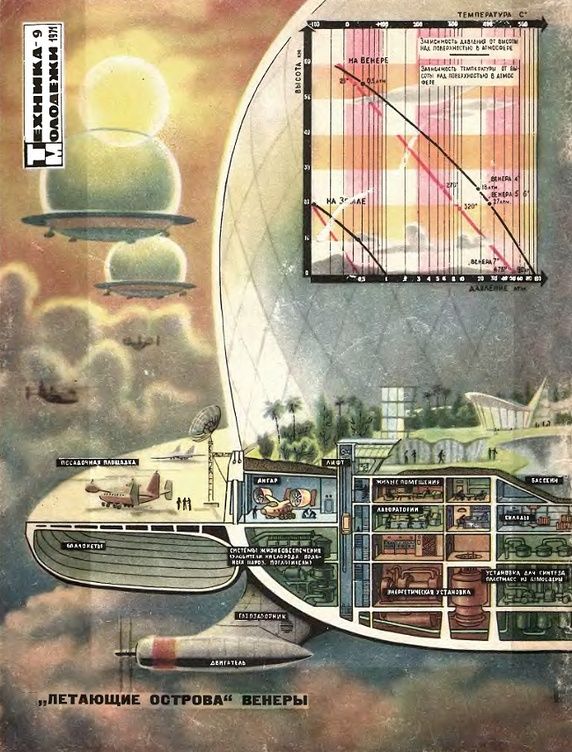
Russian idea for a cloud colony in the upper atmosphere of Venus, proposed in 1970s. This illustration is from Aerostatical Manned Platforms in the Venus atmosphere - Technica Molodezhi TM - 9 1971
This makes the Venus atmosphere the place offworld with the lowest maintenance costs of anywhere, I think. Also its atmosphere has all the main chemicals for life. It has carbon, oxygen, hydrogen, nitrogen and sulfur in abundance. The concentrated sulfuric acid is a source of water (it dissociates naturally into water and SO2 in the Venus sulfuric acid cycle). You can make plastics, and you can grow trees and other plants. You could even build new habitats using mainly wood and plastics and some thin layer to protect against sulfuric acid and UV light. To protect suits, airships, cloud colonies etc. from the acid involves covering them with an acid resistant coating, such as teflon (suggested here on the basis of tests simulating Venus atmosphere conditions).
Instead of $2 million spacesuits, you have acid resistant suits, which eventually you’d make locally, and aqualung style air breathers. This is a major saving since spacesuits are so complicated, and components for them when they fail would be a large budget item in any space colony I think.
Venus also has gravity levels identical to Earth, so if full Earth gravity turns out to be best for human health, this is easily achieved in the Venus cloud colonies.
Its long day may seem a disadvantage, as its solar day is a very long 116.75 Earth days. However the upper atmosphere super rotates once every four Earth days in a steady jet-stream like flow which gives the cloud colonies a two Earth day “night” and a two day “day” which is much more acceptable.
The cloud colonies also score at an early stage because you can launch a much larger habitat to the cloud colonies for far less mass per inhabitant. Or much more living space for the same mass sent to Venus. This would be an inflatable habitat like the Bigelow Aerospace idea - but one that is as lightweight as an airship.
Much of this will seem unfamiliar and unlikely to many of my readers. The thing is that ideas for Mars have been worked out in considerable detail, by the Mars colonization enthusiasts and the Mars Society etc. We don’t have any similar advocacy group for Venus or even the Moon. So there’s a tendency to look at everything with “Mars spectacles” and see how the Mars solutions would work on Venus or the Moon. And not surprisingly you find out that the solutions devised for Mars work better on Mars than anywhere else. But once you start looking at these other places in their own right, then a different picture may emerge.
If you are interested in this idea and want to follow it up further, see my Will We Build Colonies That Float Over Venus Like Buckminster Fuller's "Cloud Nine"?
So I think at least potentially Venus cloud colonies have the lowest maintenance requirements of all and might well hit that $100s per colonist per year figure at an early stage.
Still you need to pay back the initial build costs. The Stanford Torus was projected to take 22 years to build for 10,000 colonists at a cost of around a trillion in 2016 US dollars (see Building the Colony and Making It Prosper). A Venus colony wouldn't need anything like as much mass, for instance no regolith shielding is needed, you only need thin envelopes and there is no need to contain the pressure of an Earth atmosphere against a vacuum. The engineering is simpler as well. You could probably launch it all from Earth for a similar number of colonists over a similar timescale at a much lower cost than the Stanford Torus
But you still need some motivation for doing it. Even if it costs much less, and is easier to maintain once built, how can you do it if there are no profitable exports and they can't pay back the build costs? So let’s just look briefly at its commercial value for exports.
This depends a lot on how easy it is to export from Venus. That’s why I don’t see this happening in the very near future, for as long as you need massive rockets to launch from the colonies to orbit similarly to the ones needed for Earth. However JP Aerospace are working slowly and steadily on their idea for orbital airships. Even in the near vacuum of the Earth’s upper atmosphere, hydrogen and helium float in the near vacuum of oxygen and nitrogen. And that’s even more so with the denser Venus CO2 atmosphere. They accelerate using ion thrusters, slowly over several days, and meanwhile also rise higher and higher in the atmosphere. Eventually they break the speed of sound barrier - but by then they are so high it is an almost vacuum and it is not a problem.
Artist’s impression of orbital airship from JP Aerospace’s Airship to Orbit handout - this would be a very lightweight 6,000 foot airship which slowly accelerates to orbit from the upper atmospheric station using hybrid chemical and electrical propulsion over a period of several days
You need a staging post at a high level in the atmosphere for Venus or Earth where passengers and goods are transferred to a high altitude orbital airship which is much larger and lighter, designed for upper atmosphere operations. See my Projects To Get To Space As Easily As We Cross Oceans for an overview, also see their book: The Airship to Orbit Program
Note that this also applies to Mars too. Their orbital airships would be able to accelerate to orbit from the Mars surface with no need for an upper atmosphere staging post. If this is possible, then you could have both Venus and Mars as “garden planets” and Venus would score over Mars in that respect because the greenhouses would be far less substantial for a larger living area and much lower maintenance.
But the Moon also would have low cost exports because of its low delta v and because of Hoyt’s cislunar transport system which could reduce costs to almost zero (see my Exporting materials from the Moon)
Apart from this idea of a garden planet, it needs to be some product of the Venus atmosphere. Sulfuric acid is the obvious one, but not especially valuable. Might there be some really high value product? One possibility might be deuterium. As I mentioned in the discussion of Mars exports, Venus has a deuterium / hydrogen ratio 120 times Earth’s (and 24 times that of Mars) Implications of the high DH ratio for the sources of water in Venus' atmosphere. Instead of six tons of water electrolysis yielding one kilogram of deuterium, as is the case for Mars water, this would yield 24 kilograms of deuterium, or four kilograms per ton. However as for Mars, can we count on deuterium to be a valuable commodity in the future? And would the higher deuterium levels lead to more than a modest saving in the costs of extracting deuterium? Even with one atom in 54 consisting of deuterium, that’s still far from pure and would require many stages of whatever process is used. On the other hand unlike Mars, Venus does have abundant solar power, even more so than Earth, which may help. Still, as for Mars, this seems a bit of a stretch to me, unless some method is developed for making it much easier to extract deuterium quickly with minimal power requirements - but in that case costs would also be reduced hugely on Earth as well.
As for Mars, another possibility is products of indigenous life, as there is a small chance of life in the Venus clouds. There is indirect evidence in the form of asymmetrical microbe sized particles in the atmosphere and carbonyl sulfide, a clear sign of life here on Earth (though it could be created inorganically on Venus). See my: If there is Life in Venus Cloud Tops - Do we Need to Protect Earth - or Venus.
Again, as for Mars there’s the possibility of growing plants if conditions in the Venus clouds let you produce unusual food or decorative plants more easily, for instance, rare flowers on Mars that are very expensive to grow elsewhere, or similarly unusual and tasty rare new food stuffs that grow best on in the Venus clouds for some reason, perhaps genetically designed for those conditions, since the environment of the Venus clouds would be hard to replicate on Earth.
As for Mars, we have to explore Venus first.
Concept for a robotic airship called VAMP to explore Venus. It weighs only 450 kg, although its wingspan of 46 meters dwarfs the space shuttle . It would inflate while still in orbit around Venus attached to its mother ship, and then spiral down to the cloud tops in a slow motion re-entry that needs only minimal thermal protection. Incredible Technology: Inflatable Aircraft Could Cruise Venus Skies, details here Venus Atmospheric Maneuverable Platform It could explore the Venus atmosphere for years at the cloud tops, the same level that’s suggested for the Venus cloud colonies. Video discussion here.
At a later stage, we could send astronauts to explore the atmosphere using airships, then return to Earth as explored in NASA’s HAVOC concept study. See project home page. The return to orbit would be accomplished using something like the Pegasus air launched rocket. This is an internal study, so it's at an early stage at present.
NASA Study Proposes Airships, Cloud Cities for Venus Exploration. Technical details here.
Perhaps it’s possible that we might discover something of high value as we explore and study the Venus clouds. However, we can’t count on it at present.
I mentioned earlier that Robert Zubrin talked about the Mars system as a base to support asteroid miners in the more distant future. He thinks that Deimos and Phobos might be especially useful here. So, let’s just look at this for the more distant future. Intuitively, Mars is closer to the asteroid belt so you’d think, surely it’s the best place to support asteroid miners? However, the situation is not as clear as you might think.
First, asteroid mining is likely to start with NEOs - we get many asteroids that do close flybys of Earth, Venus or Mars, some with orbital periods close to the Earth or Venus year. The ones that do low delta v flybys of Earth seem the most likely ones for early mining operations after the Moon. We have dozens of large NEOs to mine first, kilometers in diameter. It’s not likely we’ll exhaust those any time soon, and this also has the extra benefit that we are removing asteroids that have the potential to hit Earth at some point in the maybe distant future. For NEOs ranked in various ways including commercial value, see astrorank.
We can also mine the Moon for asteroid resources - the Moon has been hit by many asteroids in the past, so whatever materials you have in asteroids are probably also on the Moon or in it. It's mainly a question of how accessible those materials are. There's some evidence suggesting that the Moon may have rich surface deposits of platinum (and so also of other metals) from the metallic core of the 100 km asteroid that created the Aitken basin as well as other iron rich asteroids and other asteroids of other compositions in the past (see Metals). The Apollo missions only explored a small part of the Moon and a few spots within that region and didn't travel far from their landing sites. Also they did nowhere near to a thorough survey of the places they did visit. They just didn't have the time for that, and only had a geologist there for the last mission. As for later investigations, you can only do so much with the few orbital missions we've had since then.
Then, when we do have humans in the asteroid belt, it's a lot of delta v to go from one asteroid to another and going via Mars doesn't help except on rare occasions. Most of the time, it will take much more delta v to get to an asteroid via Mars than a direct route, and the same is true for travel to / from Earth. Mars is only useful when you have an energy efficient trajectory that takes you from Mars to the asteroid, for instance via Hohmann transfer.
However, Geoffrey Landis has made a rather surprising observation here in his Colonization of Venus. See Accessibility of Asteroids from Venus in this paper. Even though Venus is closer to the Sun than Earth, because of Venus's faster orbit, the flight time to Ceres or Vesta is actually less from Venus than from Earth or Mars via Hohmann transfer. So Venus actually has advantages as a main asteroid belt mining hub over Mars, a bit counterintuitively. The transfer time is less and you have more opportunities also to get there because of Venus’s shorter year of 225 days instead of Mars’s 687 days, which is three times longer. So you’d get several opportunities to visit an asteroid from Venus for every single opportunity to visit it from Mars, though of course the delta v required is greater.
Hop David suggested the idea of Asteroid Cyclers to work in the same way as a Mars cycler, to cycle materials between Earth orbit and "railroad towns" colonies in the asteroid belt where the mining goes on. The same idea could be used to cycle materials between Venus and the asteroid belt.
Hop David has also suggested that Venus, and Mars would be good places to park large asteroids for mining operations - if it's too hazardous to risk parking them in Earth orbits. The Case For Asteroids. Of course this is for asteroids that already do close flybys of those planets.
Venus cyclers, like the more famous Mars "Aldrin cyclers", can get passengers from Earth to Venus by shuttling them to large spacecraft in permanent orbits that takes them back and forth between Earth and Venus over and over. The result is a somewhat shorter journey time than for Mars cyclers, and you can travel to Venus frequently, every 1..6 years instead of more than 2 years between visits. See his Case for Venus. If this happened, the cloud colonies could be useful for supplies to the asteroid miners, in return for supply of metals and other asteroid derived resources to the colonies.
So - though Mars might well be a useful staging post later on if we have a lot of people in the asteroid belt - the case is not as clear cut as you might think, and Venus might be as useful as Mars, even for supplies to the asteroid belt, depending on your priorities and the exact future situation. In the shorter term it might well be useful for mining asteroids that do close flybys of Venus, captured into Venus orbit temporarily for the purposes of mining.
So in short my conclusion is that the Moon is far superior over Mars in this respect and I am skeptical of the idea that a Mars colony could pay for itself via intellectual property. I just don’t see why the flow of intellectual property of commercial value has to be from Mars to Earth rather than vice versa or most likely both ways and I don’t find Robert Zubrin’s labour shortage argument in favour of that at all compelling.
Also it depends on not just inventing things but having the commercial talent to spot how to make the invention financially viable and the persistence and luck to take an invention all the way through to success. Why should Mars colonists be much better at this than anyone else? I don’t get it.
By contrast, I think a Lunar base could potentially be of commercial value, mainly because it has a low escape velocity and is so close to Earth and always at the same distance - especially so if something like Hoyt’s cislunar tether transport system is in place reducing transport costs almost to zero. It is also close enough for tourism to be a major industry eventually.
Mars I think will be the province of government sponsored or philanthropic explorations for some time - like Antarctica, where the return is not financial but scientific knowledge or just interest / excitement. I think that the initial stages of lunar exploration are also likely to be supported in a similar way - but that there is some possibility there of commercial value entering into the mix as well.
And I think we should explore Mars from orbit until we have a good understanding of surface conditions and especially not introduce Earth life to the planet. We could exploit it commercially from orbit through telerobotics, but that would depend on finding something there of commercial value to export. And I think conceivably there might be commercial exports from Mars in the future. Especially if the Mars biology produces some unique valuable biological product that can’t be made anywhere else - that might be worth exporting. But there’s currently nothing we know of that could be worth the cost of export from Mars, and whether there will be in the future, only the future can tell.
Longer term, Venus cloud colonies also seem of special interest. I suggest they are the least maintenance of all offworld habitats outside of Earth, so would need less income per habitant than any other space colony, but even so, it isn’t so easy to find a commercial case for more than an Antarctic style habitat maintained because of its science value and perhaps some tourism, because of the high costs of exports to orbit. Long term, if the orbital airships work out and reduce export costs to orbit almost to zero, perhaps Venus could be a place to grow food for export with the lowest mass and least maintenance greenhouses anywhere in the solar system outside of Earth. Orbital airships would also make Mars more commercially viable too. However, orbital airships would make it easier for Earth to export to space as well so both would have to compete with Earth, and of course the Moon.
In the more distant future both Mars and Venus could become a mining hubs for the asteroids, perhaps with asteroids parked in orbit around the planets for mining. In such a future, Venus, perhaps surprisingly, has some advantages over Mars for ease of access to the asteroid belt in terms of faster journey times and more frequent opportunities for travel.
The idea is to go to the Moon first before we decide whether to go to Mars, but while researching this book I've found many advantages of the Moon suggesting it's a far better place for humans anyway.
The main advantage of Mars, as far as a colony of hundreds of thousands or a million, is the somewhat higher gravity. But we don't know if Mars gravity is okay for human health, or indeed maybe lunar gravity is just fine. Or in both cases we may need to augment the local gravity. I cover this in What about gravity - isn't that a big advantage for Mars over the Moon? and Artificial gravity on the moon to augment lunar gravity. in Case for Moon First.
The Mars surface also has some natural protection from solar storms due to its atmosphere, also Phobos's Stickney crater has advantages there too, however there's more risk for radiation on the journey to Mars or in orbit. In both cases it's possible to take precautions to prevent the worst effects. See Solar storms and radiation shielding - Moon and Mars in Case for Moon First.
This is an idea from this book by William Burroughs, which had a lot of mentions for a year or two then seems to have been forgotten.
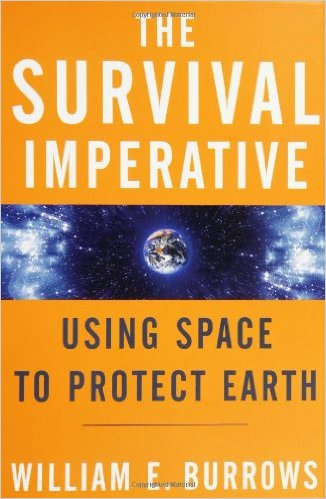
I find this suggestion much more plausible than Elon Musk's ideas of a backup on Mars. The idea is not to try to set up a colony that would survive the implausible complete destruction of Earth to the point that Mars is more habitable than Earth. Rather, it's more like a seed bank, like the Norwegian seed bank, but one on the Moon, combined with a library of human knowledge, and a small group of people who could sustain themselves there for a century or two if necessary until the time comes to return to Earth. And they could even restore humanity to Earth if they became extinct here (though this seems very implausible to me for the reason mentioned in Case for Moon First that humans with stone age technology can survive almost anywhere on Earth from the cold of the Arctic to the hottest deserts, so we are amongst the least likely species to go extinct).
So anyway - this is an idea that's much more within our reach in the near future, to set up a colony on the Moon with sufficient supplies of the things they can't make on the Moon to last them for a century or two. Together with enough "lifeboat" spaceships to return to Earth easily, spacesuits to last them out / repairs for them etc. We don't need to make it totally self sustaining, just self sustaining enough for a small community of, say a dozen or a couple of dozen people to last for a few centuries.
And - I don't actually think we will lose all our technology on Earth, I think looking at past history that even when civilizations end, the technology doesn't vanish completely. Since the iron age, the world never lost the ability to smelt iron even though many small tribes can't do it. It never lost writing after it was invented. It never lost simple maths ideas like how to count, addition etc.
As it is now, I think we will never lose the place notation, fractions (quite a late development in maths), zero, and very very unlikely to lose algebra or calculus. Only a certain percentage can differentiate or integrate, but you don't need everyone to be able to do it to have a few teachers to pass it on to the next generation.
In medicine, we won't forget anesthetic, the microbe theory of diseases, the need for surgeons to wash their hands before surgery and nurses to keep clean, or vaccination,
I don't think we'll lose the ability to build airplanes either. Or bicycles. Both are really easy to do with a small amount of technology and mainly based on knowing it is possible and if we have engineering - even if we forgot most of it, we can reinvent it quickly.

The only remaining photograph of the original Colditz Glider made by British prisoners of war using bits of wood and wiring, including bed slats and floor boards. They designed it using details from a 1939 book Aircraft Design which they found in the prison library of Colditz.
And here is a video of the flight of its modern replica (no people on board, remote controlled for safety).
So, future humans could build a glider like this just based on a single book surviving from our era on the topic plus ingenuity and understanding of technology. You don't need very advanced tools to build a successful glider.
Probably similarly, our descendants in some such post disaster Earth won't forget the principle of the jet engine, or the rocket, even though they were innovative ideas at the time. Probably they would remember what a transistor is and the idea of an integrated chip even if we lose ability to make computers. They are not likely to forget how internal combustion works, or indeed steam engines. They would surely retain the knowledge of telephones, and of radio transmission. Once you know how to do it, it's easy to generate and receive radio waves, or to build a simple electric motor or generator.
Here for instance is how to build a simple "foxhole radio". You can alternatively use a crystal such as galena in place of the pencil and razor blade, and make one of the early crystal radios. You can use anything that rectifies the alternating current from the radio waves.
This is so simple, that it's surely unlikely that we'll lose the capability to listen to radio in some crude way or another so long as there are people around who understand some of the basic concepts of how radio works and are reasonably good with their hands, and we have access to wire and other basic components.
So long as some "higher education" continues, each generation teaching ideas to the next, or some library of books remains somewhere on Earth to explain these concepts to us, these ideas will surely not be forgotten. But we could lose the organization of society. Again I think we are probably in many ways much more robust than previous societies but looking forward, what if there was some "perfect storm" of nuclear war say, followed by a super volcano eruption, then maybe a giant impact just as we are recovering?
Possible "one-two punch" for dinosaur extinction. The Chicxulub impact surely was a significant factor in the extinction of the dinosaurs. Probably the earlier supervolcanoes of the Deccan Traps helped push the dinosaurs into a situation which made them more vulnerable - this artist's impression shows the Deccan Traps. That double whammy was separated by 100,000 years.
However a recent idea is that the asteroid impact itself could have triggered volcanic eruptions from the Deccan traps.
Could some closely spaced double whammy cause problems for Earth civilization? (Credit: Zina Deretsky for the National Space Foundation)
Even then I find it implausible that there wouldn't be some pocket of technology left. For instance after a global nuclear war, if we ever came to it, then the nuclear free zones such as Australia, New Zealand etc. would surely be spared and they have the entire Pacific ocean around them.

In this diagram, blue stands for nuclear weapon free zones. In these zones, even if the territories are owned by nuclear weapon states they have agreed not to station weapons there. This makes them very unlikely to be targets in a nuclear war. As you see, apart from a few islands, pretty much the entire southern hemisphere is free of weapons. Red stands for nuclear weapons states,, orange for territories where US nuclear weapons are stationed under a sharing agreement, and yellow for none of the above, but still subject to the non proliferation treaty. After a global nuclear war, should it ever come to that most of the Southern hemisphere would probably be unscathed and retain its technology.
This for instance is the South Pacific nuclear free zone, established by the treaty of Rotaronga. No testing, stationing or use of nuclear weapons permitted anywhere in this zone.
And with technology, even with a nuclear winter, or an asteroid impact winter, surely many would survive and carry through our knowledge and libraries into the future. After all we are not like the dinosaurs. With the most primitive of tools and our intelligence we can survive many things that would kill us easily without technology. It's only because of our technology of course, but that makes a huge difference. You don't get many great apes living in the Arctic or the Sahara desert.
But still, you could imagine that if we are unlucky and encounter turbulent political and environmental conditions, that we might lose some of our most important libraries, seed collections etc. If the billions of dollars semiconductor fabrication plants stop making computer chips, many of our modern machines depend on their output and could no longer be built. We could also lose the ability to send rockets into space, maybe even lose ability to make jet engines for a while. In that future, without computers and the internet, after living in a world increasingly dependent on it, perhaps we would indeed forget some of the vast store of our present day knowledge, even if we surely wouldn't lose it all.
All that knowledge could be preserved on the Moon so then later when we restore the ability to get into space we go up there and find it. Or else, if there's a small colony there, they can educate us via radio and come back to Earth when conditions are suitable here.
With present day technology, if we lose the capability to launch rockets into space, anyone living in a lunar colony could still return to Earth. That would be easy, using its "lifeboat" spacecraft which could be permanently kept next to the colony. But this would be a one way trip as there would be no way to return to the Moon without new large booster rockets to get them back into space again, along with a dedicated space launch pad and the staff and equipment to man it.
This may well change with future developments, if so, perhaps members of a lunar colony could return to Earth, refuel, pick up supplies, do what they can to help residents here, and go back to the Moon using just their own spacecraft without dependence on Earth. But until then, they would be dependent on supplies sent to the Moon in advance, to last them as long as needed for anything they can't make in situ on the Moon.
We don't actually need a permanent presence of humans on the Moon to preserve DNA and knowledge there. Some of the lunar caves probably have an internal steady temperature of around -20 °C (see page 5 of this paper). This is similar to the −18 °C for the Svalbard Global Seed Vault and should be perfect for an off world seed bank.
Entrance to the Norwegian Svalbard seed vault, photo by Bjoertvedt. The seeds need to be kept refrigerated, which is done using locally mined coal. A similar seed vault in a lunar cave would keep the seeds at the right temperatures by passive cooling.
As for preserving our knowledge, well we could leave physical written texts on the Moon, or we could leave engraved glass or diamond, or DNA, or radiation resistant glass DVDs amongst the various suggestions.
There is a Bible on the Moon already, perhaps it would be readable in the distant future?
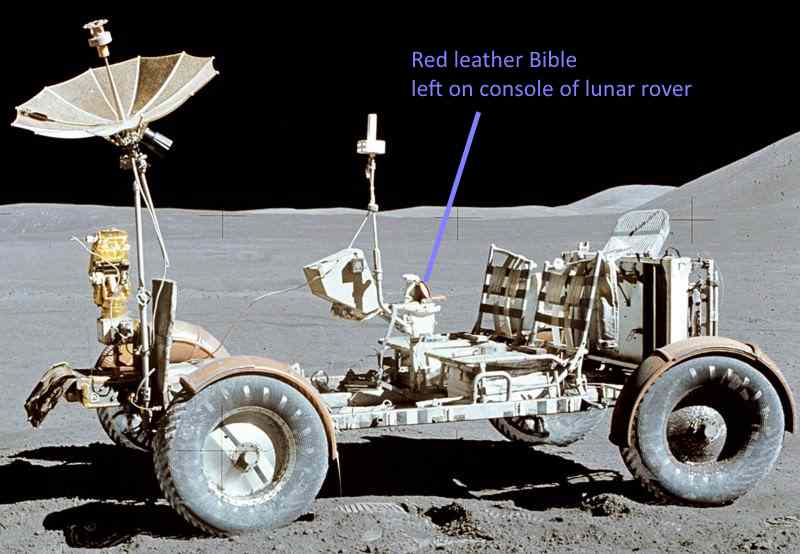
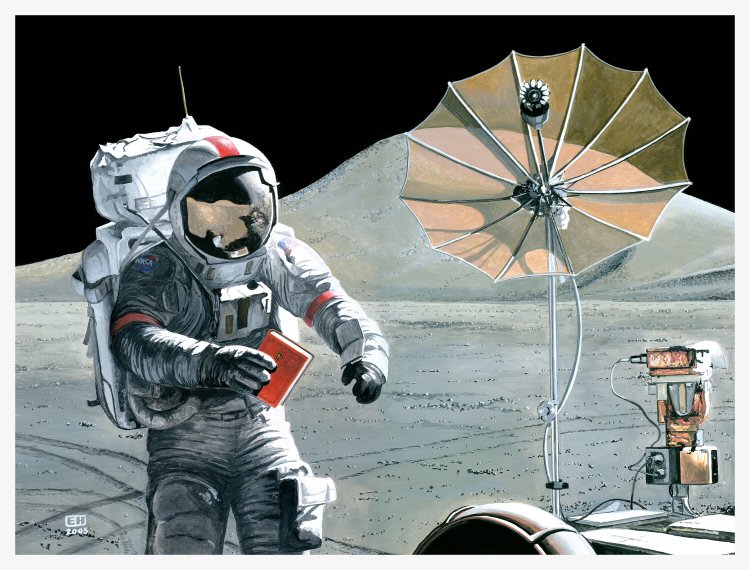
“A Moment of Reflection” painting by Ed Hengeveld depicts Apollo 15 Commander Dave Scott placing a red leather Bible on the console of the lunar rover before departing the moon.
There's a company wants to send a Torah to the Moon as a hand written scroll preserved in an airtight compartment. They asked SpaceIL to take it to the Moon but were refused, but eventually surely texts like this will be taken to the Moon. The idea is to preserve some of our most ancient texts as a project for preservation of culture. If they succeed, they would send other ancient texts later on such as the Hindu Vedas and the I Ching
Lunar Mission One have as their goal to send a spacecraft to the lunar poles to drill into the ice - and when the mission is over, to bury a capsule with both DNA from human hairs, personal messages, and a digital archive of Earth's knowledge.
Lunar mission one, artist's impression. The aim is to drill and obtain an ice core to return to Earth. But before it returns to Earth, it will put a digital archive in the hold buried deep below the surface at the lunar poles. See "A time capsule on the Moon".
The Part time scientists, one of the teams left in the Lunar X Prize challenge, as a partner with, are planning to take a disk with part of Wikipedia on it to the moon as Wikipedia to the Moon.
Back in 2004, Transorbital, a California based company was first to get permission from the US government to launch to the Moon, planned to use a decommissioned Russian ICBM for the task. They also had the idea to set up a server on the Moon for digital backup services for companies worried about security of data on the Earth after September 11. These plans don't seem to have come to anything though they did send a small satellite into orbit around Earth.
KEO is a more ambitious plan to send data into orbit in glass radiation resistant DVDs into an orbit that will decay and return the satellite to Earth 50,000 years later as a kind of a space time capsule. The idea is that everyone on Earth can store a four page message for the future. The DVD could be played on a DVD player - but of course in the future they wouldn't have our players so it includes information on how to build the player.
The KEO glass DVD is a bit like the idea of the Voyager golden record though in their case the record is in audio format like one of the old analogue records but more durable. We could send a copy of both to the Moon.
A copy of the Voyager record on display at the Udvar-Hazy Center in Washington Dulles International Airport
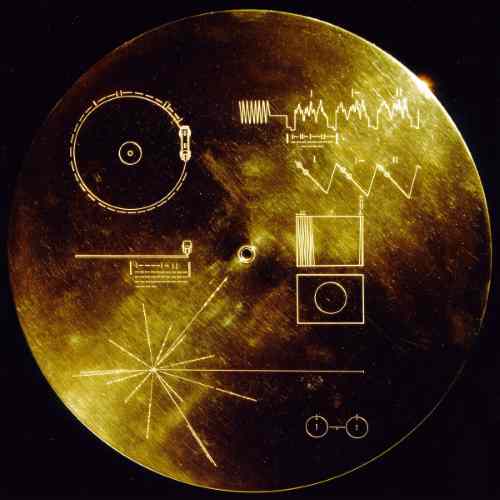
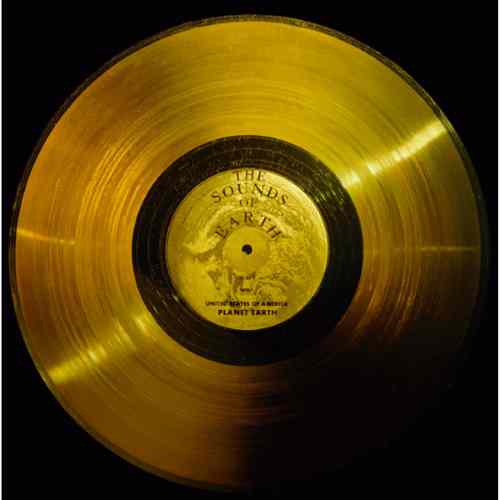
Photographs of the cover and contents, of the actual record sent on Voyager
See Contents of the Voyager Golden Record to find out what is on it.
As it gets easier to send missions to the Moon, I think it is certain that we will leave various physical and digital data repositories on the Moon. The idea of the lunar backup is a more extensive version of the same. We could build a seed vault / library / small human colony with supplies sufficient for at least a century or two on the Moon with no imports from Earth.
Examples of what it could preserve digitally include:
Physically it could preserve
And it could have human caretakers
It does have advantages over repositories on Earth, as the lunar caves provide perfect conditions for passive preservation of seeds and anything else that is best preserved in cold conditions in a geologically stable environment. The best analogue we have here might be in Antarctica, if we could arrange some backup in a cave excavated into the cold and stable conditions of some of the Antarctic mountains. Temperatures at the surface on the high Antarctic plateau seldom rise above 20 C, though they can dip down to below 60 C. So there may be places there also where you could build a passively cooled seed vault, which would cost far less than a lunar seed vault and be easier to supply. But you couldn't duplicate the lunar vacuum and very long term stability even over geological time scales. Also you would have to cope with the six months long Antarctic "night" for anything that requires solar power, while on the Moon it's a maximum of only 14 days of darkness, and less if close to the poles.
Of course, eventually, you would duplicate your lunar repositories. Especially you would have more than one copy of the most important information and materials on the Moon. You would need that as precautions in the remote chance that it gets a direct hit from an asteroid hitting the Moon. That's about the only thing that could happen there, and would be exceedingly rare, especially if it is located in a cave protected beneath the surface from most asteroids.
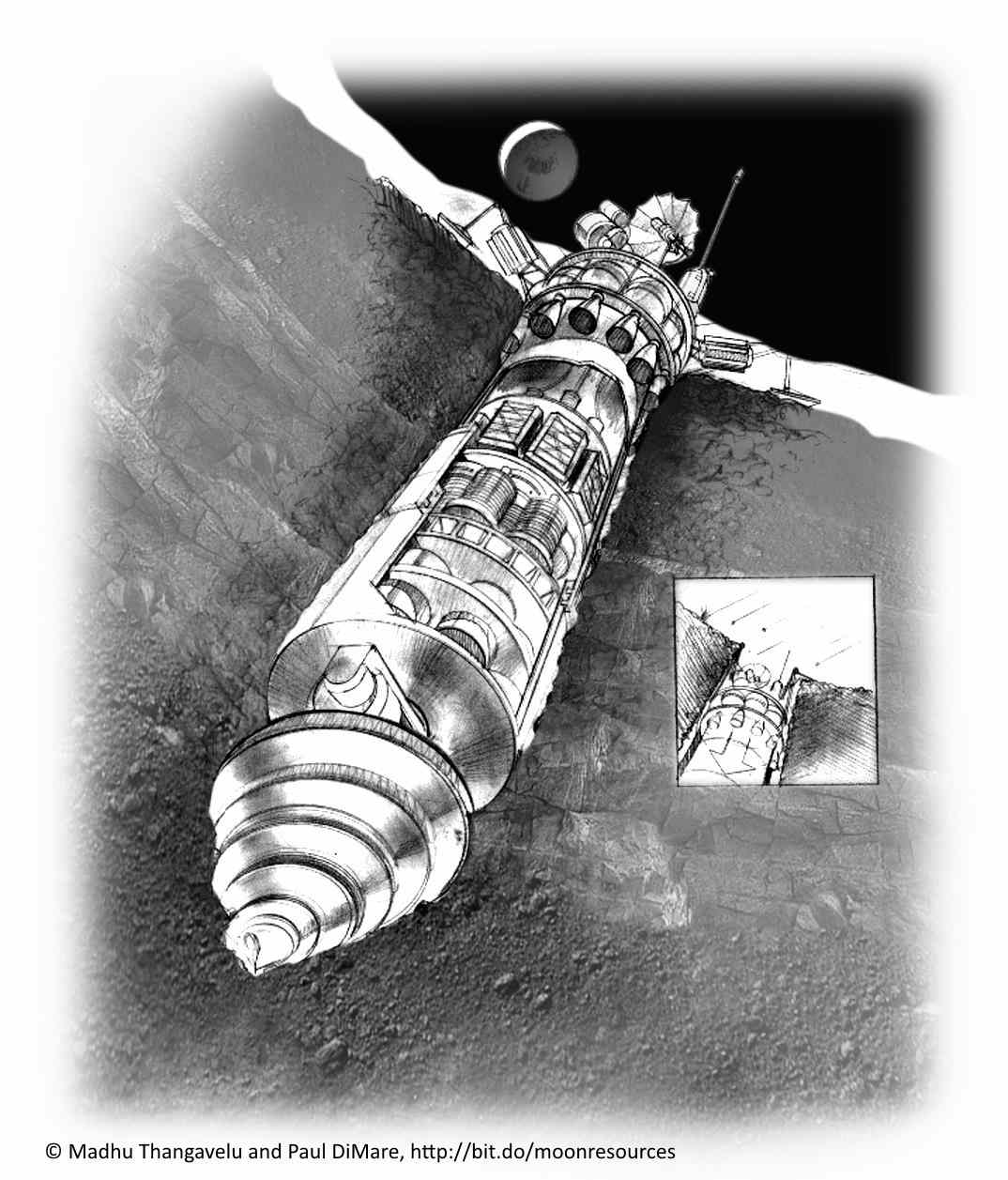
Future Humanity Archives on the Moon - Artist's impression, illustration by Madhu Thangavelu and Paul DiMare © from The Moon: Resources, Future Development and Settlement
Artist's impression of a vault on the Moon.
It's also scaleable. You can start off by just sending archives to the Moon which can't be read from Earth, but are there for future lunar visitors to discover. The next stage would be archives that you can read remotely from Earth, like the lunar server backup idea. And later, you could have a telerobotic facility on the Moon which can be controlled remotely from Earth, getting the telerobots to look up things that are stored there, even recover seeds and "post" them back to Earth. And then finally, presence of a small group of human "caretakers" normally rotating in and out every few years if they want to - but with sufficient supplies to last them out for centuries on the Moon if needed, with closed system recycling.
I'm not sure if this is really needed for a backup. Can we not do the same on Earth, as we are doing already with the likes of the Svalbard seed vault? Even set up an identical self sufficient small colony underground in Antarctica?
But it's going to happen anyway, at least in a limited way, and the passive cooling is a great advantage for seeds, which are also light things to send into space. It would also provide perfect conditions for long term preservation, for billions of years into the future, even for future civilizations on Earth. And, in my view, it seems a lot more practical than ideas of a "backup on Mars", because it is so much closer to Earth, more accessible if we ever need it, far easier for its human inhabitants to get back to Earth, and easier to communicate with via radio.
Terraforming Mars or the Moon is a far off future idea and it's surely not going to make any difference whether we start now, or a few centuries from now, if it is practical at all. A later start might mean we find better ways to do it, so that we finish sooner. But is it possible at all and should we attempt it? Surprisingly, the Moon can be terraformed too, and has some advantages over Mars in this respect, not that the Moon or Mars seems likely to be either easy to terraform, nor easy to keep terraformed.
It is not at all clear that we can terraform Mars, and if it is possible, with current technology, it's a thousands of years, or perhaps a 100,000 year long megatechnology project. There are so many questions. How sure can we be that we will continue such a project, when it is likely to cost billions of dollars a year and need support from Earth for thousands of years?
The Mars trilogy is science fiction, and the optimistic real world estimate from the Mars Society takes a thousand years to a stage where trees can grow but no animals or birds yet, and humans need aqualung like closed system breathing kits to get around. And it is based on assumptions about the amount of dry ice on Mars which are not yet confirmed, and doubts have been cast about how much dry ice still remains there.
Do we have the scientific understanding needed for it? We have never terraformed a planet, and with all our technology on Earth, we find it hard to just keep the CO2 levels on Earth from rising by tens of parts per million. Would Mars unterraform as easily as it terraformed or go to some undesirable end state. Is terraforming Mars possible at all?
What about accidental planet transformations, where lifeforms we didn't mean to introduce change the climate in unexpected ways? And Mars gets much less light than Earth, so an Earth atmosphere would not be warm enough for without planet scale thin film space mirrors to double the amount of light reaching Mars, or industrial levels of production of artificial greenhouse gases, with many nuclear power stations to supply power, and cubic kilometers of fluorite ore mined per century to make the gases.
Are we confident that this is what our descendants a thousand years from now will want us to do for them? Will they be pleased that we started the project so soon and made Mars just as they wanted it, or will they be frustrated by our failed projects, and lament the pristine Mars they would wish to be able to study and possibly transform for themselves?
The main thing is that I think at our stage, as a young technological civilization, we need to look very carefully, with open eyes, before we close off possible futures that we maybe don't understand the potential of yet. While things like creating new space habitats is opening futures rather than closing them, so I think that's the better way to go.
In terms or habitable area, space habitats have got more potential actually. The reasoning of the 1970s is still valid - that we don't need to look any further than materials from the asteroids and the Moon.
Some asteroids consist almost entirely of pure metals including iron, nickel, and heavier metals such as the industrially useful platinum, and gold (a small asteroid 452 by 1011 meters across, to take an example, was estimated to contain 90 million tons of platinum). These metals may also be capable of being extracted without physical mining using carbon monoxide at low temperatures of 50–60 °C to convert metals to gas (second half of the Mond process with no need to extract the pure metal first), and perhaps directly converted back to metal parts again from the extracted metal carbonyls in 3D printers operating at the higher temperatures of 220–250 °C.
Other asteroids have organics, volatiles, and everything that we need. The conclusions of the 1970s are still valid, that there is enough material in the asteroid belt to eventually build the equivalent of a thousand times the surface area of the Earth. So there's far more potential for settlement in the asteroid belt than there is on either Earth or Mars, measured according to the available land area. And what's more, you can choose whatever climate and even atmosphere, and gravity level that you like for the habitats.

Asteroid Resources Could Create Space Habs For Trillions; Land Area Of A Thousand Earths
Then, you can complete a Stanford torus on a timescale of decades, not thousands or hundreds of thousands of years. It's rather like terraforming, but on a very small scale, an experiment that's within our capabilities and on a timescale that we can manage.
The things we learn by doing that could help us to avoid some of the pitfalls, if we ever decide the time has come to do a much larger planet transforming project. If a Stanford Torus atmosphere goes bad, or some nasty lifeform takes it over, becomes a pest and you can't do anything, or some microbe becomes a nuisance, or if things get out of balance - you can at the worst vent the atmosphere, sterilize the soil, and start again. So it is biologically reversible. Biological mistakes can be solved. Or if there's an excess of methane, or hydrogen sulfide or some other gas in the atmosphere, well the entire atmosphere of the habitat is small enough so you can scrub the problem gas out of it.
Or if there is something fundamentally wrong with the whole design and approach, you can try a new approach with a different space habitat with a different design. If for instance some of the materials that make up your habitat react with the atmosphere in adverse ways (like the concrete in the Biosphere 2 reacting in a way that indirectly removed oxygen from the habitat), you can even build a habitat mark II using different materials. All these are things that would be very hard to impossible to fix for a planet. So it makes sense at our stage to start with the smaller biospheres of a space habitat in free space, or a city dome on the Moon, or a biosphere in lunar caves.

Trouble With Terraforming Mars

Imagined Colours Of Future Mars - What Happens If We Treat A Planet As A Giant Petri Dish?

To Terraform Mars with Present Technology - Far into Realms of Magical Thinking - Opinion Piece

Why Nukes Can't Terraform Mars - Pack Less Punch Than A Comet Collision
Our Ethical Responsibilities To Baby Terraformed Worlds - Like Parents
How Valuable is Pristine Mars for Humanity - Opinion Piece?
Longer term, some have suggested we could terraform the Moon. Surprisingly, we can - for a few thousand years. It loses its atmosphere quickly. Geoffery Landis looked into this.
See his Air Pollution on the Moon for details. His main focus there is the adverse effect of the atmosphere created as a byproduct of industry on the Moon, leading to degradation of the valuable high vacuum there. But he does briefly touch on terraforming at the end.
Then Gregory Benford, the hard science fiction writer, thinks we can terraform it, in this rather intriguing article: A Terraformed Moon Would Be an Awful Lot Like Florida.
He envisions hitting the Moon with a hundred comets the size of Halley's comet - at the same time spinning it up so it has a day of 60 hours.(I'm not sure of his calculation, it seems that the number of comets needed is more like 10,000, see below).
Presumably you would keep adding new comets to it - but if he is right that 100 comets are enough - then (assuming the atmosphere can last for, say, 10,000 years) just adding one new comet a century would keep it going - and you could do that without harm to the citizens of the Moon by breaking the comet up into tiny pieces before it impacts onto the lunar atmosphere. So what would it look like if we could terraform it? Well here is an artist's impression of a terraformed Moon.
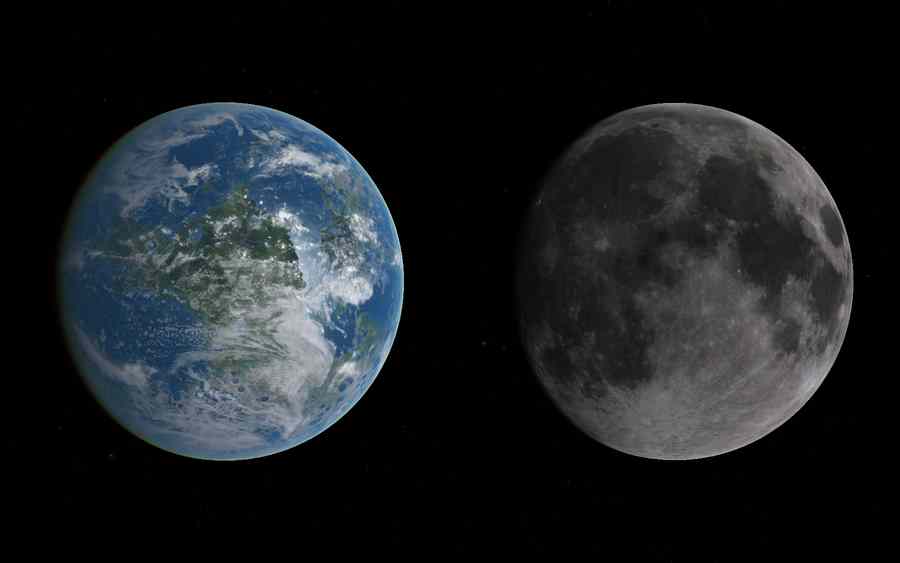
I prefer this to ideas for terraforming Mars, because there is no life on the Moon to be impacted by it. Also the Moon is close to Earth, and it is clear that it has to maintain a high technology to keep it terraformed, so if both Earth and Moon have high technology, they can work together.
Once you accept that any attempt at terraforming Mars requires megatechnology such as thin film mirrors in space the size of a planet, or hundreds of power stations making greenhouse gases, which you have to sustain indefinitely to keep it terraformed - well - the Moon isn’t that different, is it?
The Moon is at a fixed distance, and we can set up some easy way of getting back and forth with space elevators or space tether systems such as Hoyt’s cislunar tether system which allows very easy transport to and from the Earth with no fuel at all - it uses the gravity gradient from the Moon to Earth as a source of power and is powered by moving materials “downhill” from the Moon to Earth.
And use the same factories - and exchange materials from one to the other easily etc. It is similar to the idea of a very huge Stanford Torus, to terraform the Moon. It turns a lifeless though very large region into a habitable area.
With Mars, then if it can be terraformed, it's on the thousands of years timescale, with lots to go wrong. It may seem like a new earth but if you can terraform it as quickly as that, it needs mega technology to stay terraformed, and it might unterraform as quickly as it terraformed.
On Mars the plants have to work roughly three times harder than on Earth so it needs about three times as much oxygen to achieve the same partial pressure on the surface. For the Moon the plants have to work six times harder, but they get about double the levels of sunlight they get on Mars for photosynthesis.
If you work it out in detail, there is very little between them in this respect
Detailed calculation: to achieve an Earth normal 10 tons per square meter of atmosphere pressure in lunar gravity - you need 60 tons per square meter of gas in mass. The plants need to maintain 12.7 tons of oxygen per square meter (2.095*9.807/1.622) instead of the 2..095 tons per square meter of oxygen for Earth. On Mars they need to maintain 5.54 tons per square meter (2.095*9.807/3.711). So they need to create 2.29 times as much oxygen on the Moon. Earth (and so the Moon) gets 2.25 times as much sunlight as Mars. So there isn't much in it.
Let's check his Halley's comet calculation, calculation indented and I'll include all the steps in detail to make it easy to check.
With a radius of the Moon of 1737.4 km I make the surface area of the Moon 4×π×1737.42 = 37,932,328 square kms. For an Earth pressure atmosphere we need (9.807/1.622)×10 tons per square meter, or around 60 tons per square meter, and multiply also by 106 for the number of square meters per square kilometer, that's 37,932,328 × 106×60 = 2.28×1015 tons or 2.28 quadrillion tons. Halley's comet is 242.5 billion tons.
So you would need around 2.28 quadrillion/242.5 billion or 9,402 of Halley's comet.Geoffrey Landis assumes a one psi atmosphere, of pure oxygen, at the Armstrong limit so about 6.9% and works out the total mass needed as two hundred trillion tons or about 825 Halley comets..But he works that out as 50 to 100 Halley comets so must be assuming a larger mass for Halley's comet of two to four trillion tons - it's an early paper from 1990 so I think he is just using older data for Halley's comet.
So, I think Gregory Benford's 100 Halley comets probably comes from Geoffrey Landis's paper. - it means 100 comets the size of Halley but with an older figure for the mass of Halley. And both are assuming the thinnest atmosphere a human can breathe without the moisture lining their lungs boiling.
Approaching it another way, our 2.28 quadrillion tons of atmosphere for an Earth normal atmosphere corresponds to around 2.28 million cubic kilometers of ice assuming average density of 1 (there are a billion tons to a cubic kilometer of water). Or assuming a density of 0.532 tons / cubic meter (same as comet 67p) that's 4.3 million cubic kilometers
So solving for radius, then you get
π×r3×4/3 =4.3 ×106
So r = cube root(4.3×106×3/(4×π))
= 100 km approx.
So in short, it seems that you need more like 10,000 copies of Halley's comet, or you could hit the Moon with a comet of about 200 km in diameter - or larger if the density is less than 0.532, less if it is more than 0.532. If you did that, you'd have enough material for an instant atmosphere. That is if it is all potential atmosphere, but of course a lot would be water, perhaps 80% which you'd need to convert to atmosphere somehow, perhaps split the hydrogen and oxygen to create an oxygen atmosphere.
If you aim is to make a CO2 atmosphere, then assuming it is 80% water, then you'd need
= 166 km approx. Or 332 km in diameter.
If the aim is nitrogen, with 0.5% of the comet made of nitrogen, and needing 78% of the atmosphere as nitrogen, you are talking about cube root((100/0.5)×0.78×3.83×106×3/(4×π)) or 522 kim in radius, so about 1044 km in diameter. There would then be plenty of water, and carbon dioxide.
Once we can move large comets easily from the outer to the inner soar system, this could be possible selecting a large comet of a suitable composition. You'd have a lot of water as well which would be useful.
Then - for a breathable atmosphere - then you need to have a buffer gas, which on Earth is nitrogen (CO2 is poisonous to humans in large concentrations). You can have a thinner pure oxygen atmosphere with no buffer gas, but this is a fire risk (as we found out in practice with the Apollo 1 disaster), so not likely to be used for terraforming or large scale habitats, though it is used for spacesuits as it reduces the pressure inside the suit so makes them more flexible and easier to use and the fire risk can be managed in a spacesuit by using fireproof materials. It's not really feasible though to make a terraformed Moon in its entirety fire resistant.
So most of that weight needs to be nitrogen - unless you have some alternative buffer gas. Halley's comet has hardly any ammonia (NH3). As for Kuiper belt objects, their interior composition is highly varied from rocky all the way to solid ice,
The compositions of Kuiper belt objects - but I can't find much about the ammonia and nitrogen abundances inside the objects (rather than on the surface). There are some meteorites also that are rich in nitrates. But finding enough nitrogen might be a problem if that's our buffer gas, seems to me. Titan has a dense nitrogen atmosphere, and is larger than our Moon and has an Earth pressure atmosphere so it has enough nitrogen, it's just in the wrong place and inaccessible from Earth. It doesn't seem practical to transport its atmosphere to the Moon. Also, it's unique and interesting in its own right, as the only moon of its type in our solar system.
So, it seems that we depend on comets. If a comet is only 0.4% ammonia, or nitrogen etc., you need nearly 200 times as many comets for the nitrogen, so two million copies of Halley's comet. Or a comet 6.3 times larger turning our 200 km comet into a 1,260 km diameter dwarf planet.
Maybe you have to hunt around - there are lots of Kuiper belt objects, we only have discovered a tiny fraction of them and maybe one of them has lots of nitrogen? For all we know, maybe when we expand the search, maybe we find tens of thousands of nitrogen rich Kuiper belt objects the size of Halley's Comet - far too small to spot from Earth with existing telescopes? We can't really do a decent calculation here unless someone has a good idea of a source with a well known nitrogen rich composition.
If we find one, then we have to move it into the inner solar system and hit the Moon (gently) before the nitrogen rich ammonia (or more difficult, nitrogen ice) gets a chance to evaporate. If it is a large body and we move it into the inner solar system quickly, this seems feasible, without going into details of the calculation. It would be a bit like storing ice through the summer which they used to do in high latitudes before freezers and refrigerators. Or for that matter, with the level of technology we are imagining here, we could just cover the comet with a reflective layer to keep it cool for the journey.
Another problem - if you want an oxygen rich atmosphere - well the Earth had reduced iron and it took millions of years to oxidize it before we managed to get an oxygen rich atmosphere. Basically, all the reduced iron has to rust. A process that has already happened on Earth, and on Mars (it's the reason the surface is red) - but not yet on the Moon.
So - same is likely to happen on the Moon. Maybe we can speed it up but for a long time all the oxygen we create will get absorbed by the lunar crust through chemical reactions, as happened on Earth in the early stages of the Great Oxygenation Event
"The upper few kilometers of the lunar surface contain several times 1018 kg of iron(II) which in the presence of water would readily react with oxygen to form iron(III). Such an amount of iron(II) could easily absorb all of the oxygen in the Earth atmosphere.
"A large fraction of the Moons crust consists of oxides of calcium, magnesium, and iron(II), which in the presence of water would react to form hydroxides that would (partly) dissolve in the forming seas to create a poisonously alkaline fluid, with pH 10--11. If enough oxygen were available to oxidize the dissolved iron(II) hydroxides, insoluble iron(III) hydroxides would precipitate on the sea floors and shores, creating vast quantities of slightly poisonous, orange mud. Such reactions would be violent and fast in the upper part of the crust, but their rate would decrease with increasing depth. The oxidizing, hydration, and other processes would continue for ages. In the meantime oxygen and other pressures would not be stable. Most of important all: the absorption of such enormous amounts of oxygen, water, by the upper part of the crust of the Moon would make the rocks expand by perhaps as much as ten percent or more. One can wonder if such expansion would be a tranquil process. It could create strong quakes for possibly many thousands of years. "
from: An Atmosphere for the Moon
So, the upshot of all this is, the terraforming the Moon may well be possible with future technology which may not be that far away, especially with nuclear fusion or such like. But I think it may be a little harder than Greg Benford suggests in his article.
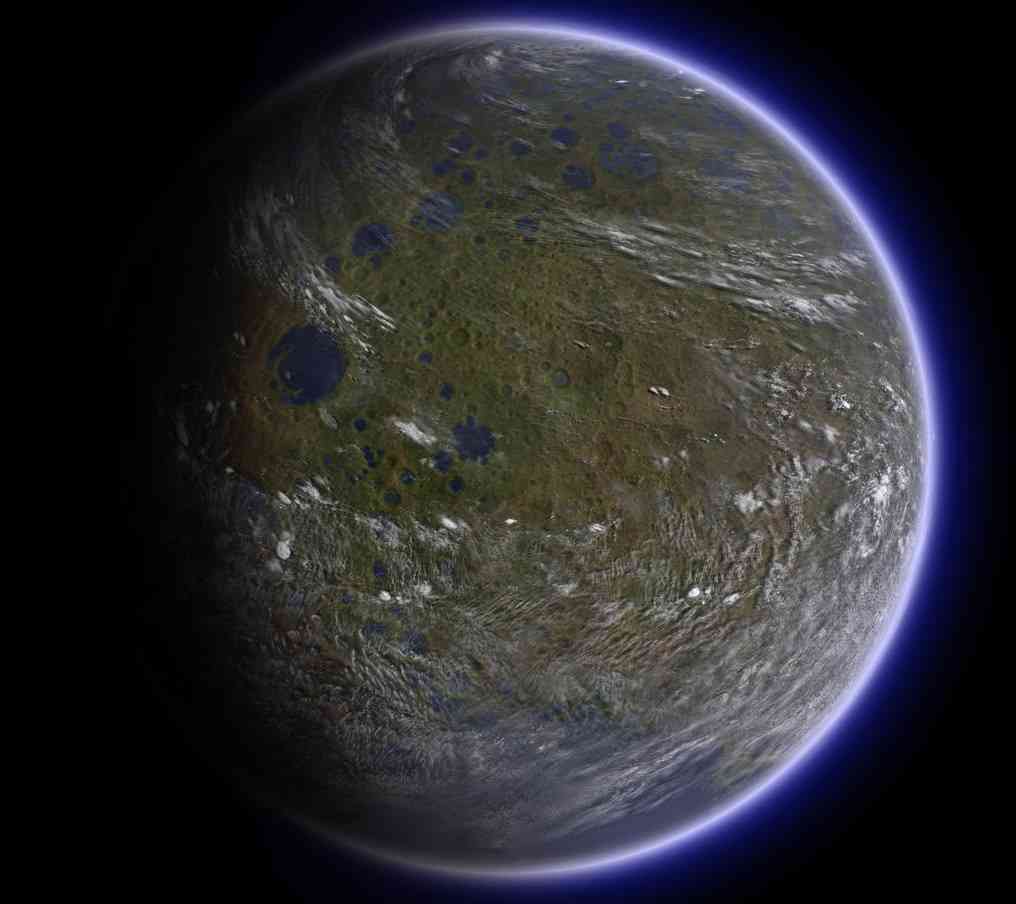
If I've got the figures right here, you need 10,000 Halley comets, or a giant comet 200 km in diameter. If you need to supply nitrogen as a buffer gas from comets with the same composition as Halley, you need two million copies of Halley's comet, or a larger dwarf planet perhaps up to 1,260 km diameter depending on how much nitrogen it has in its composition. After that, you would have many issues with reaction of the water with the dry lunar surface. And then the plants would have to work six times harder than on Earth to produce the same partial pressure of oxygen.
Do be sure to correct me if I have made any mistakes here!
Of course many of these issues would also turn up for Mars, and if you compare it with Mars it doesn't seem so bad.
Mars would need similarly huge amounts of nitrogen for instance, less per surface area but more in absolute terms.
Comparison of mass of nitrogen needed for Mars and the Moon: the Mars surface area is 144.8 km² and for the Moon, 37.9 km². To get the same atmospheric pressure, the Moon has to have 2.29 times as much mass per square meter than Mars. So the amount of mass needed for Mars is 144.8/(37.9* 2.29) so Mars needs 1.67 times the mass for the Moon. Or about 3.34 million Halley comets to supply it with nitrogen, unless it is available indigenously.
The plants have to work six times harder just as for the Moon. The atmosphere lasts longer on Mars, but it's not a permanent feature without megaengineering - it will disappear over millions of years timescales. On Mars you need to have global mirrors or greenhouse gases and still supply some volatiles with comets, for the Moon you don't need to compensate for reduced sunlight but need a constant input of volatiles.
New carbon cycles have to be set in place in both cases to return carbon to the atmosphere and these have to be based on novel principles as Earth's cycles won't work in the same way, especially the long term conversion of limestone back to CO2 as a result of subduction due to continental drift won't work on the Moon or Mars. As for the Moon, Mars also has deserts which are extremely dry and will take up much of the water if water is added to the planet (though it doesn't have the problem of oxygen reacting with the surface materials). And so on.
So - the Moon might not be so bad if you compare it to Mars, maybe you could terraform it a bit faster as a smaller object needing less total mass, and it doesn't need any supplemented sunlight or greenhouse gases. But it seems an impractically mega project even so with present day technology.
To last longer than a few thousand years, it would need constant maintenance in the form of extra volatiles from comets, which you could do safely by breaking up the comets into small chunks and sending those to hit the lunar atmosphere.But the same is true for ideas of terraforming Mars they need constant maintenance in the form of orbiting mirrors or greenhouse gases and need some resupply of volatiles as well to keep it terraformed (if it worked).
In the case of Mars constant maintenance is needed because the planet is too cold to remain habitable without orbiting mirrors or greenhouse gases, while in the cases of the Moon it is because its gravity can't hold onto its atmosphere. Mars loses its atmosphere also, but on much longer timescales.
However, it's not really that much different.
The timescales are similar too for creating the atmospheres. To create an oxygen rich atmosphere on Mars means sequestering out all the carbon assuming there is enough CO2 to make an Earth density atmosphere which most think there isn't (at most enough for 10%) and that process would take around 100,000 years using photosynthesis, as a result of which Mars would of course cool down even further without CO2 to warm it up so need more greenhouse gases or orbital mirrors.
I'm not suggesting we terraform either. I don't think we are anywhere near the stage where it makes much sense to attempt terraforming, a trillion dollars a year project that you have to commit to for thousands of years, whether it is for the Moon or for Mars or anywhere else. We find it hard to commit to a space project for a few decades and a few billion dollars a year. That's apart from planetary protection issues. And as well, we just don't know anything like enough about how ecosystems work, getting unpleasant surprises with "toy ecosystems" the size of Biosphere II, and not able to make even tiny changes to the atmosphere of Earth. If we could make a 0.01% change in the amount of CO2 in the atmosphere the global warming crisis would be over right away.
However, just as a matter of the physics. the Moon can in principle be terraformed though with many issues you'd have to sort out. But the same is true for Mars. I don't see them as that much different actually. Not with present day ideas of terraforming. We would need to understand this all in a lot more detail than we do now to see which is best, if either can be terraformed in practice. For more on this see: Terraforming and paraterraforming
Terraforming the Moon is another of those topics that doesn't seem to have a lot of attention in the academic literature. But apart from Greg Benford's article, here are forum discussions which are a good source of ideas, though of course not peer reviewed:
And then the An Atmosphere for the Moon and there's the Universe Today's HOW DO WE TERRAFORM THE MOON?
However there's another solution,
Paraterraforming means covering the surface with habitats, eventually domed cities and eventually the entire surface covered in habitats. Eventually they could merge together to make a kind of a sky to hold the atmosphere in - with lots of partitions for safety.
That needs far less atmosphere - because instead of 60 tons of mass per square meter to supply atmospheric pressure - you just have as much air as is needed to fill your greenhouses, which may have heights measured in meters. Even if the greenhouses are a hundred meters high, that's 122.5 kilograms per square meter instead of 60 tons per square meter of air, a huge saving (using density of air of 1.225 kg / m2)
Can a complex closed ecosystem work with a shallower atmosphere like that? They thought it might with Biosphere II but it proved harder than expected, still there doesn't seem to be any major reasons why not. You still have the problem also of oxygen and chemical reactions. But maybe at the same time that you enclose them from above, you can insulate them from the subsurface as well so they don't lose their oxygen through chemical reactions with the lunar soil. One way to do that would be to turn the surface into glass, though you might instead want to use bulldozers to remove a few meters depth of regolith, turn the layer below into glass then replace the regolith to use as soil. This is quite reminiscent of Biosphere II where one of the main reasons it failed was because of chemical reactions involving the concrete the habitat was made of.
This has many advantages
I can't find an illustration of a paraterraformed Moon but the same idea can be used for large asteroids and small moons too, if you can tolerate the low gravity. Here is an artist's impression of a paraterraformed Phobos by Ittiz
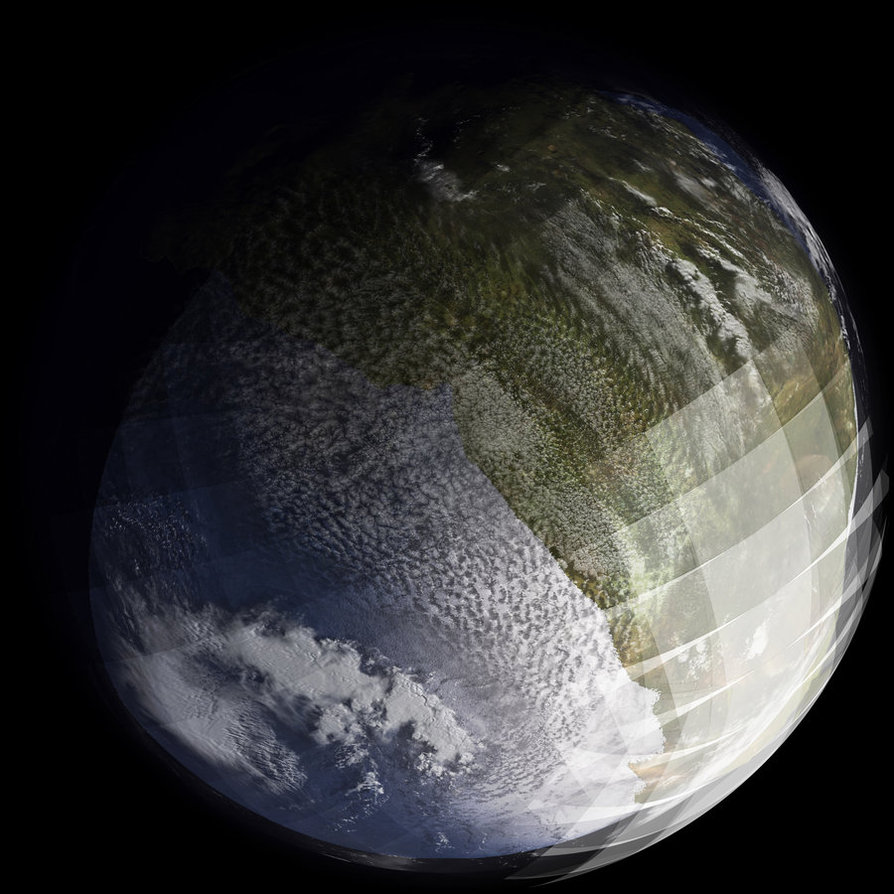
I've touched on this comparison a few times already but let's follow it through a bit further this time. We are like the first explorers to get to Antarctica.
To colonize space right now - Mars, the Moon or anywhere - is like Shackleton saying “Oh, we managed to survive a winter here, huddled under a boat and hunting seals, amazing, let’s colonize Antarctica”.

Those remaining on Elephant Island in Antarctica waving farewell to Shackleton and his five crew as he set off in the James Caird boat to find rescue in South Georgia. They managed to survive a winter in Antarctica, but they didn’t say “Oh great, let’s colonize Antarctica :) “ Ernest Shackleton and the Endurance expedition, The voyage of the James Caird, Elephant Island
(they weren’t first to overwinter, that honour goes to the Southern Cross Expedition)
Norway's most significant historic site in Antarctica Southern Cross expedition - first to over winter in Antarctica Southern Cross Expedition
Mars may look more habitable than Antarctica but that’s mainly because it is so dry. If it did have enough water, the whole planet would be covered in a thick sheet of ice. It is very very cold there, especially at night when the air gets so cold that some of it starts to freeze out as dry ice, even in equatorial regions, for many nights of the year forming the ice / CO2 frosts photographed by Viking.
Actually Antarctica is far more habitable than either Mars or the Moon. It has a breathable atmosphere to start with, it's hard to beat that, no radiation problems, and you don’t have to hold in the air in against an outwards pressure of several tons per square meter. That is why space habitats like the ISS are such massive feats of engineering, with living quarters made up of tubes with rounded ends, or spheres, or in future perhaps, donut shaped space settlements. Everything has to be contained in rounded surfaces of strong materials.
Also they usually have few or tiny windows, because it is a challenge to make a transparent pane to withstand several tons per square meter of outwards pressure. If the interior is pressurized to Earth sea level equivalent, as for the ISS, then it has nearly a ton pressing outwards on a tiny window 30 cms by 30 cms (ten tons per square meter). It's much the same on Mars also, as there's only 1% difference in the amount of outwards pressure on the walls of a habitat on the Moon and on Mars, when pressurized to Earth sea level equivalent.
Even the summit of Mount Everest is far far more habitable than Mars.

Compared to the surface of Mars, the summit of Mt .Everest is a paradise and would be a wonderful place to grow your tomatoes compared to Mars. You can almost breathe the air, with only supplemental oxygen, you don’t have to wear a spacesuit, your lungs won’t be damaged irreversibly with the water lining them boiling, you just need to warm it up and supply a bit of extra oxygen, easy peasy :). Well not really but compared to Mars it is.
If Shackleton's party had had that as their main objective, to "live off the land" they might well have succeeded for a while, killing seals and penguins for food and using their fat for fuel to keep warm, a bit like high tech Inuit. After all Shackleton's party did survive an Antarctic winter while he and five companions set off to find rescue for them in a small open boat. However with early twentieth century technology, however enthusiastic the first settlers were; soon, surely their children would decide they'd had enough, and want to come home, and not continue with the harsh difficult way of life their parents had chosen.
Instead of attempting this, the early Antarctic explorers did their exploring, and scientific study, and then came back to their warm comfortable homes at the end of each expedition. For year after year they continued to explore, built temporary bases, then more comfortable ones, and now we have many bases in Antarctica that are occupied all the year round (though with fewer people there in the Antarctic winter).
So, I think it's the same with space. First, we don't need to colonize space for the human interest. As with Antarctica, there will be plenty of interest with scientific exploration, adventure and tourism. Then, if we go into space to try to colonize right now, we will never succeed. Instead people will just get discouraged.
It is just too hard. Would you colonize a mountain plateau 30 kilometers into the atmosphere, more than three times the height of Mount Everest? At that height you'd have the same atmospheric pressure as Mars, but it would be much more hospitable in other ways. Perhaps it could be done, but why live in a place where everything is so difficult to do? Unless you have some very strong reason for living there, people just wouldn't set up home in a place like that, Not once the novelty wore off. But you'd go there for adventures, you'd have scientists studying, and so on.
There is no sign at all that we have come to an end of the science we can do in Antarctica, or that people will lose interest in going there as tourists, or going on adventures there. Yet, we are nowhere near to starting up a true colony there, and nobody has that as an objective at present.
Maybe eventually we will find a way to live in such harsh conditions as the Moon easily. Maybe we can do this with 3D printers, and biologically closed systems, living in the lunar caves, and eventually on a paraterraformed Moon. Maybe this will lead us to find a way towards a more sustainable future here on Earth as well. Still, if we achieve the ability to do this easily, the technology would still work much better on Earth than in space. You can use much the same design for your colony - except that you can drop all the cosmic radiation shielding, forget about airlocks and spacesuits, and just have windows and doors, instead, which you can walk out of, into a breathable atmosphere.
Put that habitat almost anywhere on Earth, in a desert, or floating on the sea - and that would be a far easier place to live than any space habitat. So if those self sustained habitats became possible in the future, even as a spinoff from space habitat research, I think most of them would be built on Earth rather than in space, at least to start with. Let's meet this miraculous future when it happens, if it does. Meanwhile it's not realistic to send colonists into space in the hope that 3D printers will save the day. They are likely to die waiting for the technology to be invented.
So, in this vision of the future, we have humans in space, but they aren't there to colonize. They are there rather to explore and study, and for adventure and so on, for many of the same reasons we have people in Antarctica. In the near future anyway. I think this is just being realistic; choosing a future that is within our reach rather than a rather beguiling far future science fiction fantasy that is probably centuries or even thousands of years out of reach, such as a terraformed Mars.
In this way, without that imperative that we have to colonize as quickly as possible, and turn everything into the nearest to a pale imitation of Earth as we can manage - then we can have a more open ended future. It gives us space to consider other possibilities; or at least, to look at them. For instance, in one possible future we could introduce Earth life to Mars, accidentally and irreversibly, perhaps from a crashed human occupied spaceship, creating a new geological era on Mars. But we don't have to do that. There is no need quite yet to make such an irrevocable decision for ourselves and all future civilizations on Earth.
Let's study Mars carefully from orbit first. There is no hurry, and this would be a fascinating exploration using telepresence, once we can get humans there. Maybe we will know enough in the future to make such far reaching decisions, but meanwhile, let's keep our options open for the future.
I wrote this just after I heard Elon Musk's much anticipated talk about his vision for colonization of our solar system. Many find this idea inspiring, that by technological means, we can become a multiplanetary species.
Here is the talk, in case any of you haven't seen it yet.
For a summary of the technical details he revealed in the talk, see this article on Space.com
Note, Robert Zubrin has suggested an improvement on the approach suggested by Elon Musk. See also Jason Torchinsky's Here's How To Fix The Big Problems With Elon Musk's Mars Spaceship
It is great that he wants to use his wealth for the benefit of humanity. However, I'd like to challenge the idea that this approach will make Earth safer for all of us and prevent our eventual extinction. Is this the best use of this dazzling technology, able to send 300 tons into LEO?
I'd argue for a more open ended approach. Yes, let's aim to send humans in spaceships throughout our solar system, as in his vision.
Let's also explore places we can't visit in person using telerobotics, set up bases throughout our solar system that rely on in situ resources, do manufacture in space, try all those exciting things we can do. Yes, let's do that! It was an inspiring vision that he presented there:
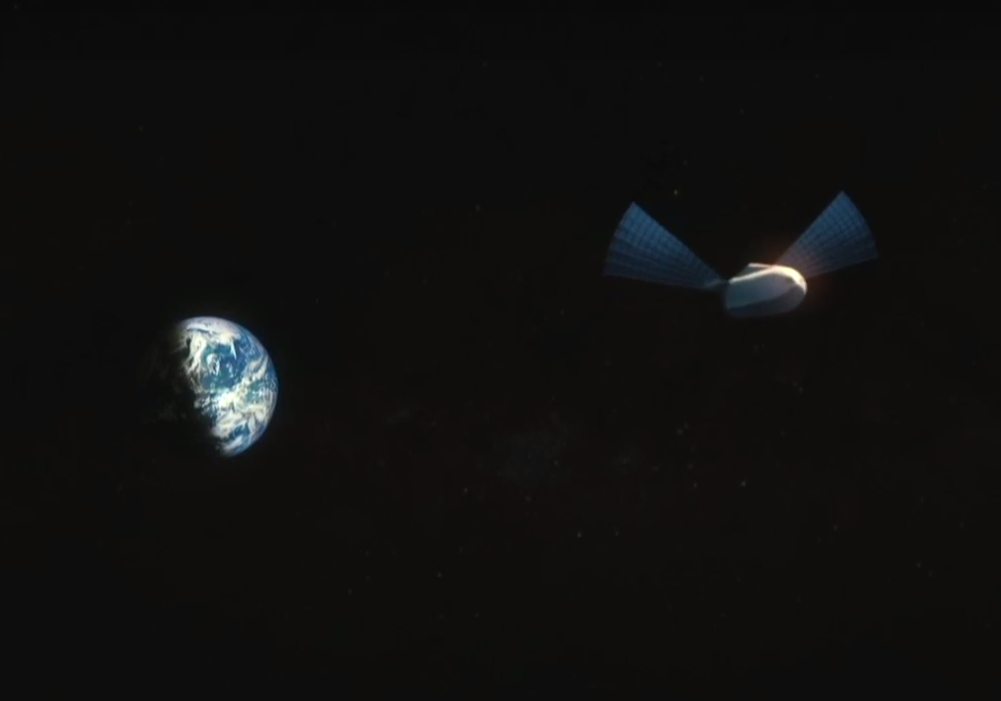
Departing Earth - screenshot from the talk
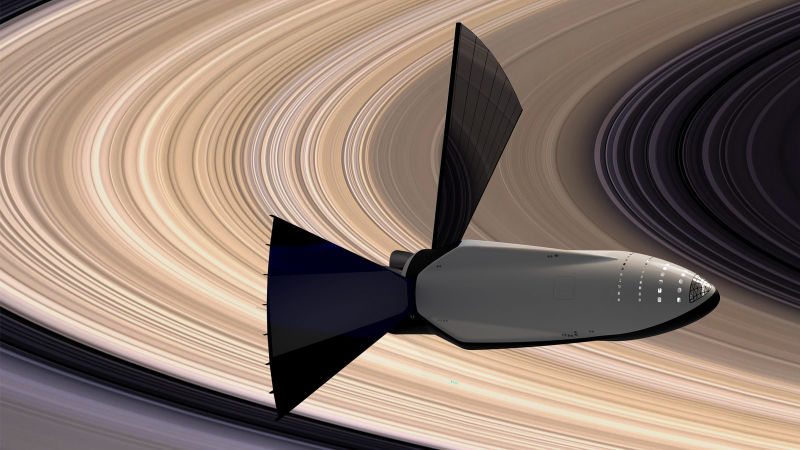
Humans exploring Saturn - from the SpaceX Flickr stream - many other images available there too. You might be surprised to see a photograph of a human piloted spaceship flying past Saturn - how would humans get there? It seems almost like something out of Star Trek. Well do listen to the talk if you haven't heard it yet. He plans refueling stations along the way. He envisions humans eventually exploring as far afield as Pluto, in person.
The Jupiter system is an obvious refueling stop for a mission to Saturn and beyond. He talked about humans landing on Europa but that doesn't make much sense for planetary protection, since Europa along with Enceladus and Mars are the three most vulnerable places in the solar system on present day knowledge. Also Europa is within the radiation belts of Jupiter, and the extreme radiation would kill humans on its surface within hours if unprotected.However, another of Jupiter's moons, Callisto, would be an excellent place in the Jupiter system to build a refueling stop.
Callisto, outermost of the larger moons of Jupiter. Callisto consists mainly of ice, so has plenty of water for refueling - and though it is thought to have a subsurface ocean, it is deep below the surface with no communication with the surface. This needs more study with a robotic mission to Callisto first, to be sure, but at present it is thought to have no planetary protection issues.
It is also outside of Jupiter's intense radiation belts and so would be safe for astronauts with only standard cosmic radiation shielding. As the outermost of the large moons of Jupiter, it's also not so deep in the gravitational well of Jupiter, so you would need less delta v to get to it.
As another moon of Jupiter, it takes the same time to get there as for Europa. New Horizons took just over a year to get from Earth to Jupiter, though of course it didn't have to stop when it got there. It left Earth with a delta v of 16.26 kilometers per second and already had solar system escape velocity when it left Earth. If you do a type II Hohmann transfer, spanning less than 180 degrees around the sun, then you can get from Earth to Jupiter in under two years as Voyager 2 did, taking one and a half years to reach Jupiter from Earth. That's a timespan well within reach if we can achieve reliable long term closed system recycling
But what about this idea that we need to become a multi-planetary species to survive long term?
I'm going to say things here that some of you will find controversial, especially if you are really sold on this multiplanetary species vision for the future of humanity, as I know many of my readers are. What I say will be especially controversial for you if you have already decided that the best possible future for humans in space is to set out to colonize Mars as fast as possible right now, as our top priority. It's an opinion piece, a statement of strong views held by the author in the hope that it may interest the reader, and stimulate debate and discussion.
In the Kardashev scale, which is one way to categorize possible future and extraterrestrial civilizations, a Type I civilization is one that has access to the equivalent of all the power available from the sun on its home planet. This map shows how far we are from becoming a type I civilization. The yellow squares show the area of solar panels needed to power the entire world with the electricity consumption projected for 2030 using solar power alone. The yellow box at bottom left shows the total area needed to the same scale as the map.
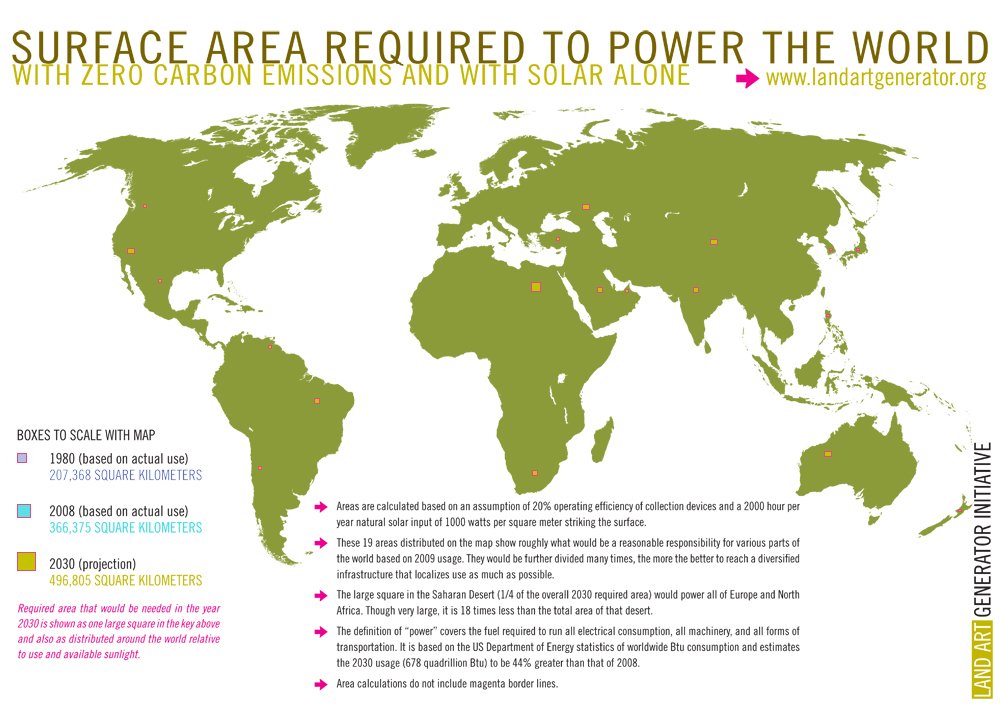
The three levels in this scale are:
Putting a few bases on the Moon, or Mars or the asteroids will not take us to a type II civilization, or even the beginnings of one. Indeed if it has the effect of diverting resources away from Earth it could delay us from getting to the type I civilization level. If rapid colonization leads to millions in space, and then to warfare in space at some later date, it could even be a major set back.
So is it worthwhile to try to become a multiplanetary species, at present, when we are still at a very early stage in technology development, not yet type I? And in a situation where there are no other planets in our solar system anything like as habitable as Earth?
First, if we can't keep our Earth in order, we are nowhere near the level of understanding needed to turn another planet into a copy of Earth. Earth is by far the easiest planet for humans to live in, in our solar system. If we can't keep Earth terraformed, in a state suitable for humans to live in, what chance do we have on Mars?
Luckily, Earth is robust. Even the worst of global warming is an issue mainly because of the speed of the change. Earth has been far hotter in the past indeed it is unusual for it to have ice at either pole, and we have ice at both poles. It's oceans have been acid before, so acid that corals can't form for millions of years, then new species evolve as the oceans become more alkali. What we are doing to Earth is nothing it hasn't seen before but the speed of change is unusual, and also we have settled in large numbers in many places that are vulnerable to climate changes and trees, plants, and species used to living in narrow temperature ranges can't move or adapt quickly. That's the main reason many species may face extinction if we don't do something about it.
To devastate Earth so much that it is as bad for humans as Mars, we would have to somehow remove all its oceans, all its water, and most of its ice, leaving just a tiny ice cap in Antarctica, much smaller than the one we have now. We'd have to remove all but 1% of its air, nearly all its oxygen and CO2. We'd have to make its land completely dry to depths of hundreds of meters in equatorial regions. We'd have to stop continental drift, get rid of its magnetic field, reduce its gravity to a third of what it is now (somehow), and move it further away from the sun so that it gets half the sunlight it does now. There is no way we are going to devastate Earth as much as this in the near future.
Our ecosystem is dependent on many particulars of the way Earth works to continue. It is balanced for a particular distance from the Sun, particular levels of sunlight, composition of the atmosphere with oxygen in it. Transfer it to Mars and it wouldn’t work; it would be far too cold, trees couldn’t survive even in the tropics, and there’s no continental drift so not enough volcanic activity to return CO2 to the atmosphere.
Current best ideas for terraforming Mars involve planet sized mirrors (if the thin film mirror weighed, say, 1 gram per square meter, that would be a ton per square kilometer so with half the surface area of Mars needed as space mirrors, you are talking about of the order of 72 million tons of mirrors to double the sunlight levels on Mars). Alternatively it involves mining it for greenhouse gases, the "easy way to do it" (at a rate of 13 cubic kilometers of fluorite mined per century on Mars and 500 half gigawatt nuclear power stations running full time to make the gases).
Then it involves diverting numerous comets, to bring more water, nitrogen and carbon dioxide to the planet and other heroic feats of mega-engineering, to get to a Mars that a thousand years from now might support trees. And that's with humans still using full cycle air breathers because carbon dioxide is poisonous to humans above 1%. To sequester all the carbon from the atmosphere into organics, to make it breathable, would take 100,000 years of photosynthesis - and that's a huge speed up compared to the millions of years it took on Earth. Meanwhile we run into problems trying to maintain a complex closed ecosystem the size of Biosphere II. The Mars trilogy is science fiction, with the facts stretched a bit as artistic license to make a good story.
Even if we put huge efforts of mega engineering into terraforming Mars, the result would still be at most a pale copy of Earth, and the best place for humans to survive in our solar system would continue to be Earth.
So, no, I don't think Mars will be easy to terraform, or that it is the sensible thing to do at this stage, or that to do so will genuinely make us multiplanetary, or advance us even towards a type I civilization (if that is a desirable goal), never mind to type II.
I think we are nowhere near at the level of wisdom and understanding to make a start as planetary ecoengineers. I've written a fair few articles about this so see also my
There have also been many failed colonizations such as the attempt of the Vikings to colonize America, and the attempt by the Scottish to colonize Panama, which was so disastrous it lead much of the lowland population of Scotland to bankruptcy, and resulted in an urgent need for unification with England to save them.

Flag of the Company of Scotland Trading to Africa and the Indies. Their "Darien Scheme"an attempt to colonize Panama, lead to the death of nearly all the colonists, and it also drained Scotland of an estimated a quarter of all its liquid assets. Scotland was saved from bankruptcy by England, in exchange for unification with England, higher taxes, and an agreement to service the English national debt.
If you focus just on the colonization attempts that succeed, you get only a partial picture, which may be over optimistic. I think it may well depend a lot on how we set about it.
Now imagine using all that megatechnology and all those resources to protect Earth and to preserve it as a habitable place for humans. It's not a comparison between an Earth where we do nothing to protect it and an Earth where we still do nothing here but attempt to set up another civilization on Mars. It's a comparison between Earth where we focus our main efforts in space for many decades into this colonization attempt, and an Earth where we use the same space technology to help and protect Earth itself, protect from asteroids, move heavy industry into space, explore other planets in ways that avoid introducing Earth microbes to them, so making new discoveries about origins of life possible or much easier, and so forth, and with scientific bases and explorers spreading through our solar system like the early Antarctic explorers, making many discoveries, but for now, focuses on what they can find and most likely not yet deciding to set up home in these desolate inhospitable places. Certainly not under any peer pressure or expectation to set up home outside Earth.
I was glad to hear Elon Musk also say in his talk that we don't face near term extinction. There is too much doomsday talk and scaring people these days with non existent threats. There are plenty of real concerns to deal with such as global warming, or indeed the real threat of impacts by smaller asteroids.
The only asteroids that can hit Earth are too small to make humans extinct. As one of the most adaptable species, with minimal technology, there's not much that can make us extinct. Even if 99% of all species on Earth went extinct, then humans with the bare minimum of technology would be amongst the survivors.
We can be as sure as can be that we won't be hit by a 100 km diameter asteroid. There hasn't been an impact that large for over three billion years from the cratering record. The Aitken basin on the Moon, the Hellas basin on Mars, the Caloris basin on Mercury, the ancient impact on Earth by a 23 mile diameter asteroid over 3.26 billion years ago, they are all over 3 billion years ago and those bodies don't have any large craters like that younger than them. Most are from around 3.8 billion years ago. In case of Earth then some craters can be erased by continental drift but we have a good record on the Moon, Mars and Mercury to fill out the picture.
We risk a 10 km asteroid but not a 100 km asteroid. Jupiter protects us, it seems.
A ten kilometer diameter asteroid like that could devastate our civilization, but Earth would remain by far the most habitable planet even after and through it. And it couldn't make an adaptable species as humans with technology extinct.
There's a tendency to look at the Chicxulub impact and say "The big scary dinosaurs went extinct, along with 75% of species on Earth, so surely we'd have a 75% chance of extinction"? But humans are omnivores and we can survive on fruit, nuts, roots, grains, insects, animals, fish, birds, shellfish. We can survive anywhere from the arctic to the Kalahari desert with minimal technology, can build boats and cultivate crops and farm animals and fish. We just need something edible somewhere on Earth and we can go there, farm it if necessary, and we would survive, some of us. Even extinction of 99% of Earth species would be zero probability of human extinction.
And meanwhile, we have the capability to detect and deflect asteroids. The astronomers know what to do. Instead of colonizing another planet, if the focus is on protecting Earth, we can map out all the asteroids that have any chance of going close to Earth - and deflect or mine away any that are a significant risk in the next few thousand years.
With only 450 million dollars, even with present day technology, no heavy boost, we can send a space telescope into orbit between Earth and Venus to find nearly all the Near Earth Asteroids that pose a possible future threat to Earth within a decade. With the kind of technology levels Elon Musk envisages, we could map out every asteroid and comet in the entire solar system of any size, and would be able to divert them, easily, decades before impact. You only need centimeters per second delta v to divert an asteroid a decade before impact, and if it does a close flyby first, only microns per second. With just a tiny fraction of the effort needed to attempt to terraform Mars or even to send a million people there, we can ensure that Earth is never in the future hit by a giant asteroid again, for the next thousands or millions of years.
We don't need to be multi planetary to do this, we don't need to be a type I civilization, we can do it already. It just needs funding. For far far less cost than a colonization attempt for Mars.
Asteroid impacts are the easiest of all to prevent if you have the funding to do it. We can predict the impact exactly, and know what you need to do to prevent it - to apply delta v well in advance to the asteroid, with various methods for doing that. For more on this, Giant Asteroid Headed Your Way? - How We Can Detect And Deflect Them
This is an argument you often see which seems convincing at first. In some past extinction events, 90% of all species have gone extinct. It's easy to think "oh dear, that means we have a 90% chance of going extinct in such an event". But no, it's not like that. Some species are far more vulnerable to extinction than others and some can, and have, survived them all. For instance Horseshoe crabs have survived and continued to evolve through all the past extinction events for the last 450 million years.
We would be bound to be one of the survivors with even minimal technology as one of the most adaptable and robust creatures on our planet. Birds, river turtles, and small mammals, survived the dinosaur extinction. We are omnivores and can survive on fruit, on roots, on shellfish from the sea shore, on mammals, birds, grow crops, can travel in boats. We just need to find something edible and sustaining for humans, somewhere in the world that has survived, and if necessary, cultivate it. There's no way those events would make us extinct.
And if the Earth was devastated at all, it would still be by far the most habitable place for humans in the solar system. In an event like that the only place it makes sense to "terraform" is Earth.
The situation is the same for a global nuclear war. Even if all our nuclear weapons were exploded and the atmosphere filled with dusts from radioactive substances, and dense clouds plunged Earth into a nuclear winter, Earth would still be vastly more habitable than Mars, and some humans would certainly survive. It would still have a breathable atmosphere for starters and it is hard to top that.
Risks such as nanotechnology, artificial life etc caused by humans could as easily originate in a space colony as anywhere, as those colonies would need the most advanced cutting edge technology just to survive. So then, in an interconnected future space economy, with fast transit and hundreds of people traveling back and forth between the colonies, the technology would be able to spread civilization wide rapidly. That some of it is in space would not make any difference there. If quarantine is the reason for safety, e.g. for microbes / synthetic life, then you can set up quarantine on Earth, a base with a six month quarantine say. If the reason is to have a backup of our knowledge, and of species, of biology, then the Moon is an excellent place to locate an informational / biological seed bank repository not just for us but for all future civilizations as well, easy of access from Earth and very stable geologically. It could have caretakers - and it could be interrogated from Earth via radio or laser if for some reason we lose space capabilities but still have those - continually beam instructions on how to use it in a beacon to Earth.
Other disasters like super volcanoes can't be prevented, not with current or foreseeable future technology. All we can do is increase the warning time. However the motivation to go multiplanetary is to prevent extinction, and a super volcano would not make us extinct. Nor would a gamma ray burst, or any of the other possible near future natural disasters. I go through them all in my article: Could Anything Make Humans Extinct In The Near Future?
Our only significant risk in the "near future" is 500 million years in the future as the sun gets hotter, and who knows what species will be alive then and what their capabilities will be. If you are talking about long term distant future risks, then you have the problem that it is unlikely that we actually know what to do that would be of use to them in that distant future. For instance, attempts to terraform Mars now might well turn it into a planet that can't be terraformed 500 million years into the future when it is needed, with all its water and dry ice converted into carbonates or the water and atmosphere dissociated and lost to space.
Or even a century from now or a few centuries from now, maybe they have space colonies throughout the asteroid belt, they find it easy to build habitats to live in, they have eliminated all possibility of asteroid impacts on Earth, ad they don't need Mars as a place to live. It might be that the thing they would find most useful then would be able to have access to Europa or Mars or Enceladus as they were before the humans messed them up. Rather than being grateful to us, they might be exasperated by our short sightedness and wish they could somehow go back in time and change our actions.
If you look at projections of the situation in 2000 onwards from the 60s and 70s, it shows how difficult it is to plan for a future even a few decades in advance. Certainly, developing the capability to transform Mars in a global way might well be useful, doing the studies, getting ready to do it if it is ever needed. But actually using that capability means making decisions based on guesses about what we think our descendants will want several generations or even a thousand years into the future or 100,000 years into the future in the case of Mars terraforming plans. That is fraught with difficulty and I doubt if we have the understanding to set in motion things like that in a way that will actually benefit our descendants a thousand years from now - much as we might want to do so.
Some of you may say - okay - maybe it is not going to make us multiplanetary in a genuine sense - but why not let them give it a go if they think they can do it?
So, first, I have no doubt about Elon Musk's intent to benefit humanity, what he says just rings so true. I admire him for this. But humans can make mistakes and nobody, however brilliant, is immune to mistakes. We have done so as a species many times, and often with the very best of intentions and on the basis of the best understanding of the experts of the day. We need to look at ideas carefully, and think about them independently, not just accept them because someone who is extremely clever, with a good heart, and with a lot of business acumen says it's what we should do.
So the problem that I think we need to consider here is that you are closing off future possibilities by introducing Earth microbes to Mars. That wouldn't be the intent of Elon Musk at all, or the colonists of course, to make native Mars life extinct, to confuse scientific exploration of Mars, and so on, but it might be an unavoidable effect. Humans themselves are no problem, but the microbes that come with us are another matter. Sadly humans can't be sterilized of our microbes.
In this way colonists just by landing on Mars in their spaceships would be making decisions, not just for themselves, but for the whole of humanity. They would be saying by their actions "We know what is the best future for Mars for us all", based on limited understanding of Mars.
The problem is that Mars, unlike the Moon, is a strongly interconnected system through its global dust storms. If there are habitats suitable for Earth life on Mars, the dust from the global dust storms can blow microbial spores into them. Then introducing Earth microbes to Mars is irreversible, like introducing rabbits to Australia.
Robert Zubrin says that this would be impossible as it would be like sharks competing with lions. However analogies can lead you far astray at times. It might instead be like non native rabbits competing with threatened wallabys, wombats, trees and plants in Australia. Researchers have found many microbes from Earth that can do just fine in habitats on Mars, able to cope with the UV light, the perchlorates, the thin atmosphere, the extreme cold at night and so on. See Candidate lifeforms for Mars
Another analogy Robert Zubrin often uses is of anthrax. He says we will be able to recognize Mars life as different from Earth life because we just need to examine the life we bring with us and since we can distinguish anthrax from other life, we'll be able to tell what is Earth life and what isn't.
But that doesn't work either. Yes, there are a few micro-organisms that we have studied in great detail. But most of the archaea, the microbes most likely to be on Mars, are so little known that 99% of them in a typical sample can't even be cultivated. This is the problem of the "microbial dark matter". They are only known from DNA fragments and we don't even know how many genuses of archaea there are, never mind have an idea of the range of species. We don't know their capabilities. When they do microbial assays of spacecraft cleaning facilities, it's just the same. 99% of what they find is DNA fragments of unknown species of archaea. Nowadays, they can sequence individual archaea cells.
So if you find a microbe on Mars, and it is DNA based, then yes, you could in principle sequence it. Then if you happen to have sequenced that same species on Earth, you could recognize that they are identical. However, even if you have a complete sequence, you can only compare Mars ones to the ones you have already sequenced on Earth. Most Earth microbes of course are not sequenced and most of the microbe species on the spacecraft would not be sequenced. It's only ones that are very important to us like anthrax are sequenced.
There are an estimated one trillion microbial species. Of those, 99.999% have not yet been identified. Only ten million species have been catalogued. Of those, only about 10,000 have ever been grown in a lab and only about 100,000 have classified sequences. So only 0.00001% of all microbial species on Earth have been sequenced to date. See Largest ever analysis of microbial data (May 2016).
So, no, if we find DNA on Mars, we won't be able to tell by some simple test if it is from Mars or from introduced Earth life. Not if it is related to us from any time since the very distant past, the first archaea, billions of years ago,.
Life can also exchange fragments through GTA (Gene Transfer Agents). This can happen even with higher organisms, the red colour of some aphids is the result of carotene which they produce due to a gene fragment that came originally from a fungus. It is something that archaea can do very readily, exchanging fragments even overnight in salty solutions.
This is an ancient mechanism so even if Mars life separated from Earth life three billion years ago, the archaea would still be able to swap gene fragments using horizontal gene transfer in that way. One of the most interesting questions would be how long ago the two separated evolutionarily and how closely connected they are, and you won't be able to answer this nearly so easily or maybe not at all.
Studying the archaea is tough. We don't want to make it tougher.
Then as well as that, our life detection experiments are searching for tiniest traces of life. They are exquisitely sensitive. Some of the experiments astrobiologists want to fly to Mars can detect a single amino acid in a sample. Such measurements will be meaningless if there is Earth life there introduced by us.
Here on Earth in attempts to study the organics in the meteorite ALH84001 and other similar ones in attempts to determine if they ever contained life, one of the biggest problems astrobiologists face is contamination by Earth life rendering most of their tests very hard to impossible. Introducing Earth life to Mars would contaminate present day habitats on Mars in this way making similar tests of those habitats ambiguous and as hard to interpret as our meteorite studies on Earth.
Then also Mars may perhaps not have any life in some of the habitats, even though habitable. This is a very interesting situation in its own right. We want to understand how planets work and what happens when you have complex organics but no life. Does it build up to some form of proto life? Do you get anything resembling cells? You do in some experiments in laboratories, depending on the conditions. This is in some ways one of the most interesting cases of all, if perhaps not so exciting for astrobiologists. Again introducing Earth life would make it impossible to find out what was going on in these habitats before the life was introduced.
And then, Earth life could make Mars life extinct, for instance if it is some early form of life, intermediate between uninhabited and inhabited. So in that case we don't even get to find it, it may be gone already before we are able to send robots to its habitat to sample it. More on that in a moment below.
Elon Musk does care about the science impact of introducing Earth microbes to Mars. Here he answers a question on this topic, in the 2015 AGU conference in San Francisco, 30 minutes into this video:
Q. "I am Jim Cole from Arizona State University. I was listening to Chris McKay, another advocate of humans to Mars, and he was talking about how if we do go to Mars and we find life either there or extinct, we should consider removing human presence so that we can allow the other life to thrive. I was wondering what your thoughts on that were. "
A. "Well it really doesn't seem that there is any life on Mars, on the surface at least, no sign of that. If we do find sign of it, for sure we need to understand what it is and try to make sure that we don't extinguish it, that's important. But I think the reality is that there isn't any life on the surface of Mars. There may be microbial life deep underground, where it is shielded from radiation and the cold. So that's a possibility but in that case I think anything we do on the surface is not going to have a big impact on the subterranean life.".
So, it's clear (as I'd expect actually), he does think it is important we don't extinguish any native Mars life. But he thinks there isn't any present day life on the surface. But is that right?
I did a survey of the scientific literature, to see what there is by way of proposed habitats and to investigate the range of views on the topic:

Are There Habitats For Life On Mars? - Salty Seeps, Clear Ice Greenhouses, Ice Fumaroles, Dune Bioreactors,... (long detailed survey article with many cites)
It's also available as a kindle booklet, and also online here with table of contents
As you see, there's an almost bewildering variety of suggestions for habitats on Mars for life. For more on this see the section on present day Mars life above.
So when will we resolve this? Well not for some time. Most of these potential habitats would be hidden from view, a few millimeters or centimeters below the surface. Some of the habitats might be quite productive, for instance methanogens in warm humid locations deep below the surface heated by geothermal processes. There might be enough life there to cause obvious effects on the atmosphere, such as the methane plumes. But as Mars changed from a warmish wet planet to a cold dry planet, any surface life would probably become more and more sparse, and have less and less effect on the atmosphere.
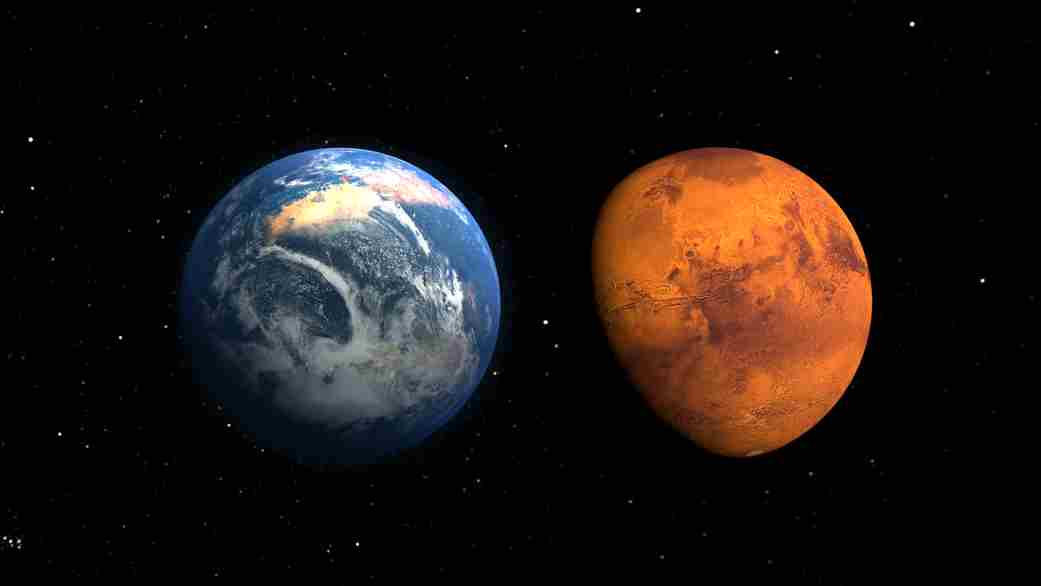
As Mars slowly changed from the warmish humid planet on the left to the dry cold planet on the right, then any surface life may have become more and more sparse, and had less and less effect. Image from NASA (Goddard space center).
So, if the life from early Mars still lingers but is sparse, it might easily have almost no effect on the atmosphere by now. The most habitable areas of Mars such as the warm seasonal flows, if we are lucky, might be about as habitable as the Antarctic dry valleys or the high Atacama dry desert. If that's the way of it, life in those few square kilometers of the Martian surface would have almost no effect on the atmosphere. Mars already has small amounts of oxygen (0.145% as measured by Curiosity). The signal of oxygen from photosynthetic life on the surface, at such low levels, would just be hidden in the noise.
Indeed, even if the entire surface of Mars is as productive of oxygen as Antarctic ice covered lakes - and even if all that oxygen ends up in the atmosphere, the signal from all of that photosynthetic life would still be lost in the noise and not noticeable in the atmosphere (I made it about 0.0002%, in a very rough calculation, by just assuming a residence time of oxygen in the Mars atmosphere of 4500 years, the same as for Earth - at any rate it would be a tiny, surely undetectable, signal).

Why Mars Surface Life May Leave No Traces In Its Atmosphere: Our Rovers May Need To Go Up Close To See It
also my Our Spacecraft Could Look Straight At an Extraterrestrial Microbe - And Not See a Thing!
For more on this see Value of a non confrontational approach and following in the book.
It is an open question in exobiology, whether Mars life would be related to Earth life or not. The theory of panspermia is just a theory and even if there is some shared life, there could also be life that is not shared. A journey of a few thousand or hundreds of thousands of years in the cold and vacuum of space is not the same as a journey of a few meters from a spacesuit (they leak air and microbes all the time) to the ground. Even if some very hardy lifeforms from Earth have got to Mars, which is not yet known, most microbes would have no chance of making that journey on a meteorite.
The problem is that the Mars surface is interconnected, with the global dust storms. So, if these habitats exist, any life brought to Mars will gradually spread to the entire planet through hardy microbial spores, protected from the UV light imbedded n cracks in the dust. Once that is started, it can't be reversed. And as Elon Musk says, human missions to Mars will be dangerous with significant chance of loss of life. One of the most dangerous times in the mission would be the landing on Mars. After a human mission crashes on the Mars surface, that would be the end of any chance of protecting Mars from Earth life, with debris, tiny fragments of the astronauts bodies, air, water, food, scattered across the surface and the spores spread in the dust.
The introduced life from Earth could easily out compete Mars life. I think the easiest example here is the example of some earlier form of life that has been made extinct on Earth but still lingers on Mars.
One good example is RNA based life, which could exist without DNA or protein. These "RNA world" cells were hypothesized for a shadow biosphere here on Earth. So far we haven't found these cells on Earth, so if this form of life existed here in the past, perhaps DNA based life made it extinct. If so, what if it still exists on Mars? It might well be vulnerable to whatever made it extinct on Earth, from introduced Earth life. See One example of what we might find on Mars is some early form of life made extinct on Earth by DNA based life
Or, it could be some completely unrelated form of life, in which case again, there is no reason particularly why it has to be invulnerable to Earth life, or indeed vice versa, maybe in the harsh Mars conditions it has evolved capabilities our life doesn't have, and Earth life could be vulnerable to it. A good example there - if it has a more efficient metabolism, or is marginally better at photosynthesis, then it could out compete Earth life, and vice versa, Earth life could out compete it. It wouldn't need much of an edge there, just a tiny edge due to Earth life's different biochemistry, and over many generations of microbial cells the Earth life would predominate. Just doubling once a month, if it has a significant advantage over Mars life, it wouldn't take long for every cell in a small habitat to be Earth life, and then if it spreads through spores in the dust, then it might not be many years before most of the habitats Mars wide are colonized by Earth life. And whether or not it happened as quickly as that, there would be no way to halt or reverse such a process once started, once you have spores in the dust and the life has spread significantly beyond its original first colonized habitat.
I'm not saying, don't go to Mars. But we can do a lot from Mars orbit. Meanwhile the Moon is the safest place to do early experiments in space settlement. It may have lunar caves up to 5 kilometers in diameter and over 100 kilometers long, according to the Grail data, already set up with radiation and regolith shielding. See Lunar caves and Lunar caves as a site for a lunar base We can also use materials, first from the Moon and NEOs, later from the asteroid belt to build colonies in space with up to a thousand times the population of Earth, see Asteroid Resources Could Create Space Habs For Trillions; Land Area Of A Thousand Earths. We have the potential of the Venus clouds as well, see my Will We Build Colonies That Float Over Venus Like Buckminster Fuller's "Cloud Nine"?
The three main places we need to hold off from landing humans on, if we care about planetary protection and the science value of the search for life in the solar system, are Mars, Europa, and Enceladus, and we also need to go cautiously with Ceres and the larger asteroids until we know if they have life or not (considered as a non negligible possibility by astrobiologists because of the water plume seen around Ceres by Hubble). All these are places we can explore by telerobotics using increasingly capable robots, also explore using robots controlled from Earth.
There is no need to send humans to these places as quickly as possible. It won't help to make us multiplanetary, but it may mean we miss out on discoveries about the origins of life, and other lifeforms. Imagine if you could learn about life on a planet or in the ocean of an icy moon around another star? Even if it was just extraterrestrial microbes or lichens, imagine how exciting that discovery would be? Well Mars, Europa and Enceladus may be like exoplanets and exomoons in our own solar system, they may be as interesting as that. We don't know until we study them close up.
It's the aspect of our exploration of the solar system that gets most interest of all from the general public I think. And if we did find an early form of life, or something significantly different, it would be the greatest discovery in biology since the discovery of evolution, or perhaps the discovery of the helical nature of DNA, of that order of importance. Who knows what implications it would have, if you think of how much of modern biology comes from those two discoveries.
If we introduce Earth microbes to them, accidentally or intentionally, this may well be irreversible. It's the irreversibility that's the issue here. If it is biologically reversible, not so much of a problem. But if irreversible, that means it would change those places for all future time, not just for us, but for our descendants and all future civilizations that arise in our solar system, they won't be able to make the discoveries they could make by studying these places as they are now, without Earth microbes introduced to them. They also won't be able to transform them in other ways if they decide they wish to introduce a different mix of microbes from the ones we brought there.
I think we just know far too little at present to make such a decision for all those future generations and civilizations and indeed for ourselves.
As for how long it would take to do a biological survey of Mars, Carl Sagan took a figure of 60 landers, 57 of those successful, and 30 orbiters, all devoted to biological exploration like Viking, as a starting point. So that's as good an estimate as any. The ability to explore from orbit would help hugely. It's just a preliminary survey, there are a dozen different types of habitat to explore, and you have an area the size of Earth's land mass, so it is like landing eight rovers on each of the seven continents on Earth. You would get a first rough idea. But you wouldn't find some rare lifeform in some unexpected location. I don't think we should say in advance what counts as a completed survey - as we would find out things as we go that would help us understand how complete it is, which we can't know in advance. But exploration from orbit by telerobotics, and sending lots of small robots to Mars would speed it up a lot. For more on this, see How many years are needed to do a biological survey of Mars?
Why the haste to land humans on the Mars surface?
In the natural course of events, Earth will remain habitable for five hundred million years. It's hard to grasp what a vast timescale that is. That's long enough for humans to evolve again from the smallest microscopic primitive multicellular creatures.
So yes we need to find somewhere else to live if we still are here half a billion years from now - or rather - whatever intelligent species is still here by then - we need to protect Earth from the Sun, or move the Earth itself. If we survive half a billion years as a technological species, that should surely not be hard for us to do. But there is no hurry to go anywhere else right now. I think we need to focus on protecting Earth, and to go into space, yes, but do so to find ways to help Earth.Carl Sagan expressed a similar sentiment in Pale Blue Dot
"The Earth is the only world known, so far, to harbor life. There is nowhere else, at least in the near future, to which our species could migrate. Visit, yes. Settle, not yet. Like it or not, for the moment, the Earth is where we make our stand
When you think about it this way, the Moon becomes a natural destination for his spacecraft. Not as a refueling stop on the way to Mars, that probably doesn't make too much sense, but a place of major interest in its own right. It is actually resource rich for instance, you can make solar cells in situ using the high grade vacuum and silicon, with a paving robot that could drive over the surface turning it into solar panels.
The 14 day lunar night is not the disadvantage you'd think when you realize it has sunlight 24/7 at the poles and no dust storms, also the high grade vacuum is an advantage for making electronics, it has volatiles at the poles, it is rich in many metals, it probably has caves kilometers in diameter and over 100 kilometers long, and it is always at the same distance from Earth. See The Moon is resource rich. There are solutions also for growing plants on the Moon with a 14 day night. See Earth length day on Mars versus advantages of close to 24/7 solar power at the lunar poles
It is also a place where we can also make first experiments in off planet settlement, close to Earth, and likely to be able to provide resources even for cities of millions of people. If the amount of water at the poles matches expectations, it's enough for a million people to have at least an entire Olympic pool swimming lane's worth of water each.
It also might have a commercial value, because of its proximity and low escape velocity, while Mars is hard to justify economically in the near future - see my article in Forbes magazine: Is there a Fortune to be made on Mars? And with the Hoyt cislunar tether system, the delta v to return materials to low Earth orbit, and to the Earth's surface, can be effectively almost zero.
His spaceship could also make a big difference for transport of goods and materials to and from the Moon as well as people. And it could help support a major tourist industry on the Moon in the near term. Surely many more people will be interested in spending a weekend or a week on the Moon than will want to go to Mars orbit for two years, never mind go there and stay.
We are likely to have a Lunar village at any rate, whatever SpaceX or NASA do, as the ESA is keen on the idea as is Russia, as well as other countries.
I think we do also need a bit of a reality check here. So far SpaceX haven't yet sent a human being into space, not even a test pilot. They have had many unmanned flights using the same rocket they will use for humans, but that's not quite the same as actually sending a human into space.
They have also had two incidents with the Falcon nine, the second leading to it blowing up while refueling, stationary on the launch site, and before the test burn of the engine - such a rare form of accident it hasn't been seen for decades. Doug Messier has an interesting opinion piece here, questioning the wisdom of bringing Silicon Valley working practices of 60-80 hour weeks, multi-tasking, and frequent hardware and software upgrades to the rocket industry. See Are SpaceX’s 60 to 80 Hour Work Weeks Really Such a Good Idea?
There's no question, they have already achieved amazing things and have reached the reliability levels needed for unmanned launches. But are they ready for manned flights? This spaceship for a hundred people is a fair way down the road yet. And what happens if the rocket blows up on the launch pad? How do they ensure that those 100 people survive such an accident safely? I'm not saying they won't do it, not at all, just a reality check and a caution that it is early days yet.
This idea of putting 100 people into one big spacecraft is bold - but if the spacecraft crashes - or its systems fail, it loses its atmosphere due to an explosion of an oxygen tank or some such - that's a hundred people who will die. And if the issue happens soon after they leave Earth, the spaceship they are in continues on its path to Mars with no possibility of return. It's not like the old days of sail. Then, you could at least breathe the air, and you could get in a lifeboat with some chance of survival, and you might find an island that you can land on. Here, you are in a boat for 100 people, but with no lifeboats, committed to a six month journey.
The essential difference here is that you can have a lifeboat on the Moon to get you back to Earth in 2 days. Many space accidents unfold over a period of days, like Apollo 13, and especially if your lifeboat is separate with its own self contained systems, and supplies to last you for a couple of days, this is plenty of time to get into the lifeboat and escape if necessary. The first thing the crew of the ISS do when there is a risk of impact with space debris is to get into the Soyuz TMAs which are always attached to the ISS ready to escape back to Earth if necessary.
This makes it far far safer than if you don't have a lifeboat. Spacecraft to Mars or other deep space missions currently can't be fitted with lifeboats with present day technology.
Examples of the sort of tragedy that could unfold, could be water contamination, or the food spoiled, or the oxygen regeneration failing slowly, or an explosion that breaches the hull, or even, amongst a hundred people, someone on board doing something stupid or going crazy and damaging the ship's systems.
You would need a lot of confidence in your rocket, the crew, and especially with the environment control system, as such have often failed. Including the 2005 oxygen generator failure and oxygen issues in 2011 on the ISS. We haven't had a major failure for over ten years, agreed. But many minor issues. Have we put all major failures behind us for good? If something like this happened, they might know already that there is nothing they can do when they leave Earth orbit, with too much delta v to get back again, and with an environment control system that can't supply them enough oxygen for the round trip or a slow build up of noxious gases (there are many such that can build up in a human occupied spacecraft and have to be scrubbed constantly), or whatever the problem is.
The problem here is that you don't know what is going to fail until it happens, and the environment control system and other spaceflight systems are immensely complex. Of course you'd have astronauts experts in repairing the systems, as was the case with Apollo 13, where Jack Swigert, on the flight as the result of a last minute change of crew, had literally "written the book" on command module malfunctions. But depending on what goes wrong, they still might not be able to fix it, especially with a fix to last for 500 days to over two years (for the first flyby missions of Mars).
I'm not saying that we have to stay close to Earth for all time, but we do need to test it closer to Earth, for similar mission durations before we send it as far as Mars orbit.
The Moon is a destination you can reach in two days. If you have an Apollo 13 type disaster, there is at least some chance of recovery from it, as for Apollo 13. Apollo started off with orbital missions around Earth, docking tests, flybys of the Moon, finally a test of all the systems with Apollo 10 going right down nearly to the surface but not landing, before they landed anyone there, and it was still a high risk mission.
In the same way we can do long duration missions on the Moon or at lunar L2 which gives you the opportunity for a mission without Earth in the sky and with no direct communication to Earth. There's plenty of motivation to do that - a mission that can survive two years without resupply would cost far less than one that needs to be resupplied on average every three months. Then, if you can send a mission there, that lasts for 2 years without resupply from Earth, and probably more than one such mission, then perhaps you are ready to set off on the first multi year deep space mission to Mars without lifeboats. It's still a major risk, but more on the lines of the risks run by the Apollo astronauts, an acceptable level of risk of the type that test pilots face.
Once we have longer duration missions,we can then go anywhere in the solar system, as explorers at least, Antarctic base type settlements, and perhaps eventually living there permanently.
There are many possible futures here, such as exploring with humans traveling throughout our solar system but not colonizing, settling places other than Mars, such as the Moon, using materials from Near Earth Objects to construct habitats for humans, doing the same with the asteroid belt, settling on Mercury, Jupiter's Callisto, the moons of Mars, the upper atmosphere of Venus, and settling on Mars but at a later date, as not our top priority right now.
The key to settlement, other than for scientific research, tourism and such like, I think is reducing the maintenance cost. But it would make this article long to go into such things here, see my section on Maintenance costs in case for Moon first.
Suppose eventually we do have self sustaining, low maintenance colonies throughout our solar system, what next? That leads us to a larger philosophical question.
Then what about the larger view. Should we set out with the aim of becoming a galactic civilization? This is a question that space colonization enthusiasts rarely ask. It is just assumed that spreading through the galaxy is good. The sooner we do it the better, according to most enthusiasts.
But, let's stop and think. Is that true? What would the consequences be?
First we do need to ask if it is possible at all. And there, I would say that yes, practically, I think we could start this in the near future on timescales of centuries, maybe less. There are many habitable planets out there. These are just the best ones we know of to date:
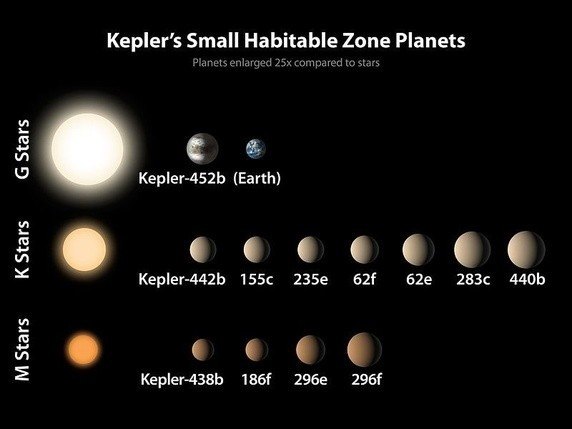
There must be many more that are not discovered yet. And of course there's the newly discovered probable planet around Alpha Centauri.
There’s a tendency to think it would be like Star Trek. But that’s a very idealized picture and even then you have the likes of the Borg in their universe. What happens a million years into their future in their timeline? What happens to the various large scale conflicts that have already happened just a few thousand years into that new era of space faring civilizations? Even the rather idealist Star Trek universe has many seeds for potentially endless chaos a few thousand or million years down the road.
But Star Trek is just the products of talented script writers’ imagination, not future casting. It makes lots of implausible assumptions. For instance, it has as its basic premise that ETs throughout our galaxy have similar exobiology and often even compatible DNA, can all eat each other’s food nearly always, and most are basically humanoid, looking more like each other even than humans look like gorillas, never mind elephants or parrots or octopuses. And all arose independently around multiple star systems at the exact same moment of time to within a few thousand years.
They have an “in house” explanation based on the ancient humanoids who billions of years ago seeded worlds throughout the galaxy and who were so advanced they could arrange for them all to evolve humanoids like themselves at the exact same moment more or less, billions of years into the future.
Right. And borders between great empires of many stars, light years apart are measured and patrolled exactly to the kilometer. And if you are threatened by an exploding star, you get out of danger by backing away by a couple of hundred thousand kilometers (less than the distance from Earth to Moon). It’s fun but it is a product of script writers, and requires a lot of suspension of disbelief if you are scientifically minded. I greatly enjoy star trek actually, am in the middle of watching the entire series of Star Trek Voyager again just now :). But it's not future casting :)
.
Ancient humanoid who in the Star Trek universe seeded many planets with life which independently evolved to humanoid lifeforms which then evolve space faring technology within a few centuries of each other 4.6 billion years later
Instead, imagine a galaxy that is filling with peaceful colonists, yes, maybe some pirates etc as in Star Trek - but let's make it so they are all originating from Earth (vastly more probable than that they arise simultaneously on multiple worlds at the same time).
Then amongst them, amongst those trillions of colonists on initially thousands and eventually tens of billions of habitable worlds of our galaxy, you will be sure to have the likes of ISIS, North Korea, Hitler, whatever present or past figures you imagine as the worst we could have. But now give them the technology we would have a million years into the future. They have the ability to make self replicating machines probably, and cyborgs, and super intelligent uplifted animals of all sorts made intelligent by DNA manipulation.
Now let them expand through the galaxy - so that they are beyond reach. Assuming we don’t get warp drive, which is just sci. fi. at present - then if some of our descendants are a thousand light years away, only a hundredth of the diameter of our galaxy, we wouldn’t know what they have done more recently than a thousand years ago.
EXPANSION OF A SOCIALLY PRIMITIVE, TECHNOLOGICALLY ADVANCED CIVILIZATION THROUGHOUT A GALAXY
We are technologically advanced, yes, at least compared with previous generations here on Earth, if surely not compared to a million years old technological civilization - but that example shows that socially we have a lot of catching up to do to be ready to use this technology on a galaxy spanning scale. I can’t see any way that such a galaxy could be anything but total chaos. This expansion of our technological civilization into a galaxy would also quickly go exponential, and favour the most aggressive and most rapidly reproducing species, the ones with most children and that reach adult hood and have their own progeny as quickly as possible, or reproduce using cloning.
The most aggressive colonists wouldn’t need to set up stable civilizations on planets even, as they would surely by then have the ability to live in the Oort clouds, with fusion power. In that future, maybe just a few centuries ahead, small groups, even just family groupings or a few friends on a whim, could just hop from one comet to another throughout the galaxy. There would be no limit to this comet hopping, as those clouds of comets mingle and probably spread most of the way to the nearest stars, probably all the way to nearby Oort clouds around other stars, and then onwards and outwards from one star to another.
They could then fill our galaxy in the not so distant future. A long time perhaps in human lifetimes, but compared to geological time, it would be just a blink of time. Probably it's already getting crowded throughout the galaxy in less than a million years. Crossing over to other galaxies is quite a challenge - but the space between galaxies is not devoid of material. There are stars in between and gas clouds also, and with the technology we’d have by then we’d probably be able to move planets with fusion mini suns, at close to the speed of light, a bit like the Puppeteers in the Larry Niven novels. There are parts of the universe disappearing beyond the speed of light horizon under its expansion, so without warp drive our expansion would have limits, but we could spread to millions of light years, eventually billions of light years in every direction. If we set it off here, without foresight and planning, that’s surely the inevitable outcome, with no possibility of stopping it once it has been underway for a few centuries.
So - in principle, yes we could fill the galaxy and much of the universe also, at least of the part closest to us.
But, if we did it as we are now we wouldn’t turn into a galaxy and universe spanning civilization.
We’d become a galaxy and universe spanning chaos of beserker robots and creatures just running amok. Not our selves necessarily, our creations, self replicating machines, uplifted lifeforms, synthetic lifeforms and so on.
I think a future like that would be the worst nightmare not just for us but for any beings in this galaxy and eventually the entire observable universe. If someone somewhere establishes a peaceful spot in the galaxy - they would never know when some horde of beings with strange ideas would suddenly appear having developed for a thousand years over a thousand light years away - and then arrive at close to the speed of light using unfamiliar technology. They would be our distant cousins, or the creations of our cousins, but that wouldn’t help. And once started, how can this ever stop?
Even if people learn to co-operate in one part of the universe - that’s only going to work in a small region, perhaps a few tens of light years in diameter. Beyond that, the chaos would just start up again or rather just continue without check.
Also you just can’t keep expanding exponentially. Surprisingly quickly, even doubling only once a century, within a eighteen thousand years, even with warp drive, you reach the limits of what is possible with the matter available in the universe. Even if your colonists become so small that each one masses less than an atom, through some unimaginable future technology, that just adds an extra ten thousand years to the length of time you can continue at that doubling rate before you run out of enough matter in the entire observable universe to make colonists.
If you don't have warp drive, then the crunch time comes much sooner, within a few millennia.
Populations don't have to expand exponentially. We have already reached peak child and the middle of the range predictions for the future see our population leveling off at about ten billion people. At the moment our population is continuing to grow only because the average life expectancy is increasing - people world wide are living longer.
So why not stop at a point where you have some reasonable control and reasonable prospects for your civilization for the future? For more on this including the calculations, see Why ET Populations Can't Continue To Expand For More Than A Few Millennia, and Why Only Very Young ET Civilizations Will Have Expanding Populations - Opinion Piece
For these reasons I think that no sensible ET would set out to colonize a galaxy. Not in an imperialist conquering way at least. If they do explore the entire galaxy it will be in some way that involves restraint and has minimal impact on it, chances are.
There’s plenty of space. We could have countless trillions of us in a single star system. There’s enough material in just the asteroid belt of our solar system for a thousand times the land area of Earth - so that is already a population of trillions living in comfort if we develop that technology.
So, I expect our galaxy to quite possibly have trillions of colonists from various ETIs, but they would keep them localized in a small region. Setting up new colonies “beyond the horizon” of your civilization's space travel capabilities without foresight about the possible effects on the galaxy would be seen like letting off a nuclear bomb in the middle of your home city. Something that no sane person, or being, would do.
I think they, and we also, should use robots instead. The robots, paradoxically, are safer for the galaxy, just because we can, ethically, make them completely safe by design. We can make self replicating machines, designed with many safety restrictions so that they can't be a nuisance to the galaxy (e.g. telomere style maximum number of generations, and a "keep alive" signal from Earth so that they stop functioning and self destruct if they no longer get it).
We evolve because our replication system has inexactness built into it, with the possibility of error. Creatures with inexact replication systems would out compete the ones that replicate exactly every time.
Self replicating robots are designed rather than evolved however, and can be designed to replicate exactly with many failsafes and no chance of error. The technology could be be tested on a small scale locally first. There are many things we could do to keep them safe. And to start with, not use replicating robots either, just lots of low mass but highly capable robots, with identical copies sent to many destinations in the nearby region of our galaxy. For more on this, see Self Replicating Robots - Safer For Galaxy (and Earth) Than Human Colonists - Is This Why ETs Didn't Colonize Earth?
I think, there is evidence that we may be wiser than the most reckless ETs possible. the ones which might destroy themselves in space wars pretty much as soon as they begin on spaceflight. Carl Sagan refers to this as "the intrinsic instability of societies devoted to an aggressive galactic imperialism".
Though we have stumbled a lot, we have made many good decisions, such as dealing with the problems of DDT and CFCs, human rights (a lot of progress though much still to do), preventing chemical and biological warfare (even in the almost all out conflicts of WWII neither side used the chemical weapons of WWI, I know there have been exceptions but most wars don’t use them).
We've developed nuclear weapons, and yet, for decades we haven't used them. Indeed Carl Sagan suggests that maybe nuclear weapons are the deciding factor here. After talking about our own efforts to deal with nuclear bombs he then goes on:
"If every civilization that invents weapons of mass destruction must deal with comparable problems, then we have an additional principle of universal applicability. Weapons of mass destruction force upon every emerging society a behavioural discontinuity: if they are not aggressive they probably would not have developed such weapons; if they do not quickly learn how to control that aggression they rapidly self destruct. Those civilizations devoted to territoriality and aggression and violent settlement of disputes do not long survive after the development of apocalyptic weapons. Long before they are able to make any significant colonization of the Milky Way, they are gone from the galactic stage. Civilizations that do not self-destruct are pre-adapted to live with other groups in mutual respect."
He goes on to say that because we have only just reached this stage then this future scenario of mutual respect may seem unlikely because of our short term perspective, and that the required changes may take a thousand years or more for us to reach maturity as a species. From Carl Sagan's "The Solipsist approach to Extraterrestrial Intelligence", 1983 .
We’ve prevented starvation with the often forgotten Green Revolution between the 1930s and the 1960s, stopped nearly all whale hunting, done lots of work to preserve species and environments etc.
If you compare our present world with what it could have been without all those initiatives - I think it gives room for optimism for the future too. And I think we’ve made an excellent start on peaceful use of space with the Outer Space Treaty.
Although it’s frustrating that we don’t have warp drives or even the Star Trek “Impulse drive”, and easy ways to build habitats in space, I actually think it helps, that space is so hostile. Hopefully by the time we figure out how to live sustainably in space habitats, we also have figured out how to do it peacefully, or reasonably so. With competition of course, but more like the Olympic Games than WWIII.
Hopefully we can become more forward looking as we continue to colonize space. Perhaps the increased resources from space can help us to become more peaceful if we can handle it right.
If so we might well eventually have a chance to explore even our entire galaxy peacefully, and without harmful consequences to ourselves and other intelligent species that may exist in our galaxy. And if we meet ETs then they also I think would be ones that have figured out how to explore the galaxy in a similarly peaceful way.
THIS IS A GREAT FILTER IN THE FUTURE - ANY EXPANSIONIST ET MUST ALSO HAVE MINIMAL IMPACT - OR ELSE - WE ARE THE FIRST SUCH, AT LEAST IN OUR GALAXY
I’m pretty sure there can’t be any aggressive exponentially expanding ET out there (such as we could become potentially) except by some amazing coincidence. That’s because unless they started on their expansion less than a million years ago, a tiny slice of the age of the galaxy, they would have occupied Earth and our solar system already, indeed, probably long before we evolved, and would have been fighting over the spoils ever since.
Any ET that managed to expand to a few star systems or to the Oort clouds, also, I think can never stop expanding, short of warp drives. That's because if there are any of their species left anywhere in the galaxy that are expansionist, they will start up again, and take over from all the others that give up. How can that ever stop? Even if they started billions of years ago, they would still be at it, I think, even if most of them retreat into Dyson spheres or whatever it is they do, the few who don't would continue to expand through the galaxy., over and over
So any "great filters" ahead of us have to operate before any ETs out there start on any major push of galactic imperialism.
I think the most likely reason is either
WILL WE BE A WEED OR A FLOWER IN THE GALAXY
The anthropologist Mary Dora Russell says:
'Anthropologists used to say that Homo sapiens was a unique and special species because we were the only ones who used tools, or who were self-aware, or had language, or passed culture to our offspring… Then we started finding out that chimps and dolphins and crows and African grey parrots and snow monkeys were making a mockery of our pretensions to uniqueness, so we’ve kind of shut up about all that in recent years.
If you want a nice reductive definition of our species, I could defend this: “Human beings are bipedal tailless primates who tell stories.”
That’s probably just as stupid as earlier definitions, but it’s catchier than my other version, which is
“Human beings are a dangerous, invasive weed species that has invented central heating, air conditioning, and food that can be stored for up to ten years, so not even a direct hit by an asteroid would likely make us extinct.”'
When nothing else matters, by Mary Dora Russell
I think that’s rather how I see the future of us in the galaxy if we just expand into it without foresight. But far worse than a weed on Earth. We’ve unnaturally made ourselves almost impossible to go extinct already by our technology, and if we expand through the universe without evolving social breakthroughs of some sort, to catch up with our technological breakthroughs, I think we’ll become the ineradicable weed of the galaxy. But harmful to ourselves as much as to everyone else, and able to create even more dangerous replicators through our technology.
It's not just us. Our galaxy may well contain many non technological species, for instance intelligent fish-like or octopus-like creatures, living in the oceans of icy moons, or ocean planets, where they have no chance to develop control of fire. Or creatures that are just not very strong, and don't have good "hands" like us for manipulation, like parrots or crows. Even an elephant would have a lot of trouble building a fire and smelting metal. Ancient civilizations, perhaps advanced in mathematics, art, poetry, music, perhaps socially very advanced, yet without technology they would be especially vulnerable to a new technological species spreading out of control like an ineradicable weed through the galaxy. Out of all the intelligent creatures on Earth, I think only humans also (and the other great apes) had a decent chance of developing technology based on fire, even with intelligence. I can't see parrots, crows, dolphins, whales, octopuses, elephants, dogs, cats, developing technology like us, with tools, fire, metal working, however clever they became and however skilled at communication. So if that's a good basis for generalizing, then the non technological civilizations universe wide may well outnumber the technological ones many to one. So, even a billions of years old civilization could still be highly vulnerable to a few centuries old civilization of technological ETs such as ourselves,
I think any sensible ET will look at that possible future for themselves and the galaxy, and find a way to become a flower of the galaxy instead of a weed that will eventually choke all the species in the galaxy, including themselves. If they can’t see a way to a future like that, then if they have any sense, they just stay at home until they can. And if they haven’t the sense to do that, I think, perhaps, that they either make themselves extinct, or they keep destroying their own spaceflight capabilities, and get nowhere, until they develop some sense.
Let’s be one of the civilizations in our galaxy and universe that flowers like a beautiful flower.
Let’s be one of the civilizations in our galaxy and universe that flowers like a beautiful flower.

(click to watch on Youtube)
Or a field of flowers

(click to watch on Youtube)
Or we might even give rise to many flowering human originated civilizations each unique in its way, and all sufficiently in harmony with our galaxy or universe not to be a nuisance to each other or other ancient civilizations in our galaxy.
See also: Robert Walker
's answer to Will humans become extinct before we can colonize other planets?You may also be interested in my Could You See Moon City Lights Or A Greenhouse From Earth? Just For Fun and What If The Moon Had Blue Skies? One Small Change To Apollo Photos
This kindle booklet is partly based on extracts from my book Case for Moon first, and there are many sections I left out in order to keep this book short.
I haven't covered artificial gravity here, see the sections in Case for Moon First:
Other sections I've left out to keep this book shorter include
And many others. If these things interest you and you want to look into it in detail, do check out my longer book Case for Moon First.
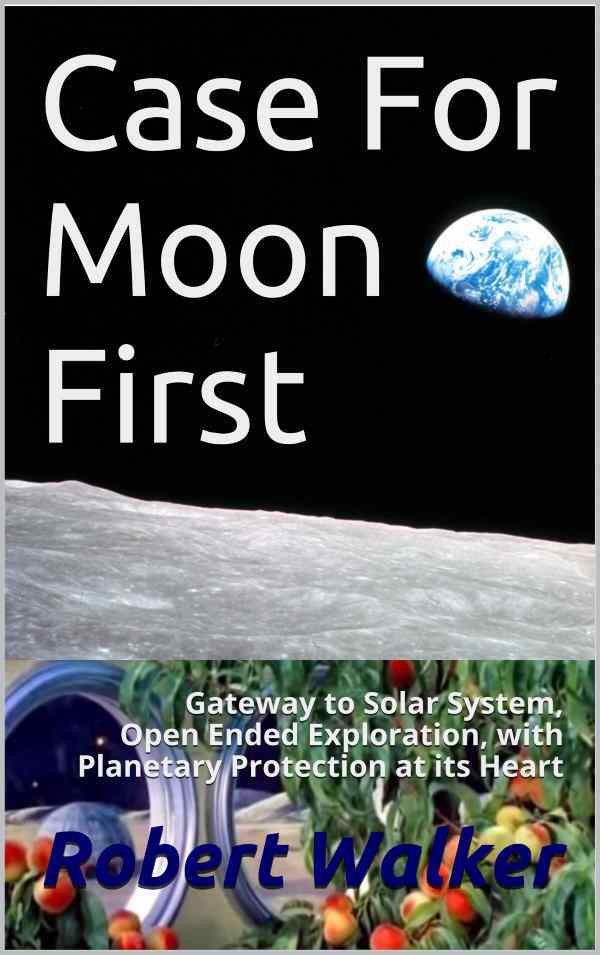
The kindle book may be useful if you want it formatted as a book, which you can read on your kindle, and also on most major smartphones, tablets and computers, using the free kindle reading app.
Moon advocates perhaps don't hit the news as much as the Mars advocates but there are many of them, and they are just as enthusiastic about their vision as the Mars advocates. Paul Spudis is one, with his most recent book, The Value of the Moon: How to Explore, Live, and Prosper in Space Using the Moon's Resources. Another is Dennis Wingo, CEO of Skycorp, and author of Moonrush, see his recent paper, and appearance on the Space Show. Others include Madhu Thangavelu, David Schrunk, and other authors and contributors to The Moon: Resources, Future Development and Settlement. See also David Schrunk's paper Planet Moon Philosophy , and their appearance on The Space Show
I've made a new facebook group which you can join to discuss this and other visions for human exploration with planetary protection and biological reversibility as core principles. Case for Moon for Humans - Open Ended with Planetary Protection at its Core
And on Science20
's posts on Science20And I have many other booklets on my kindle bookshelf